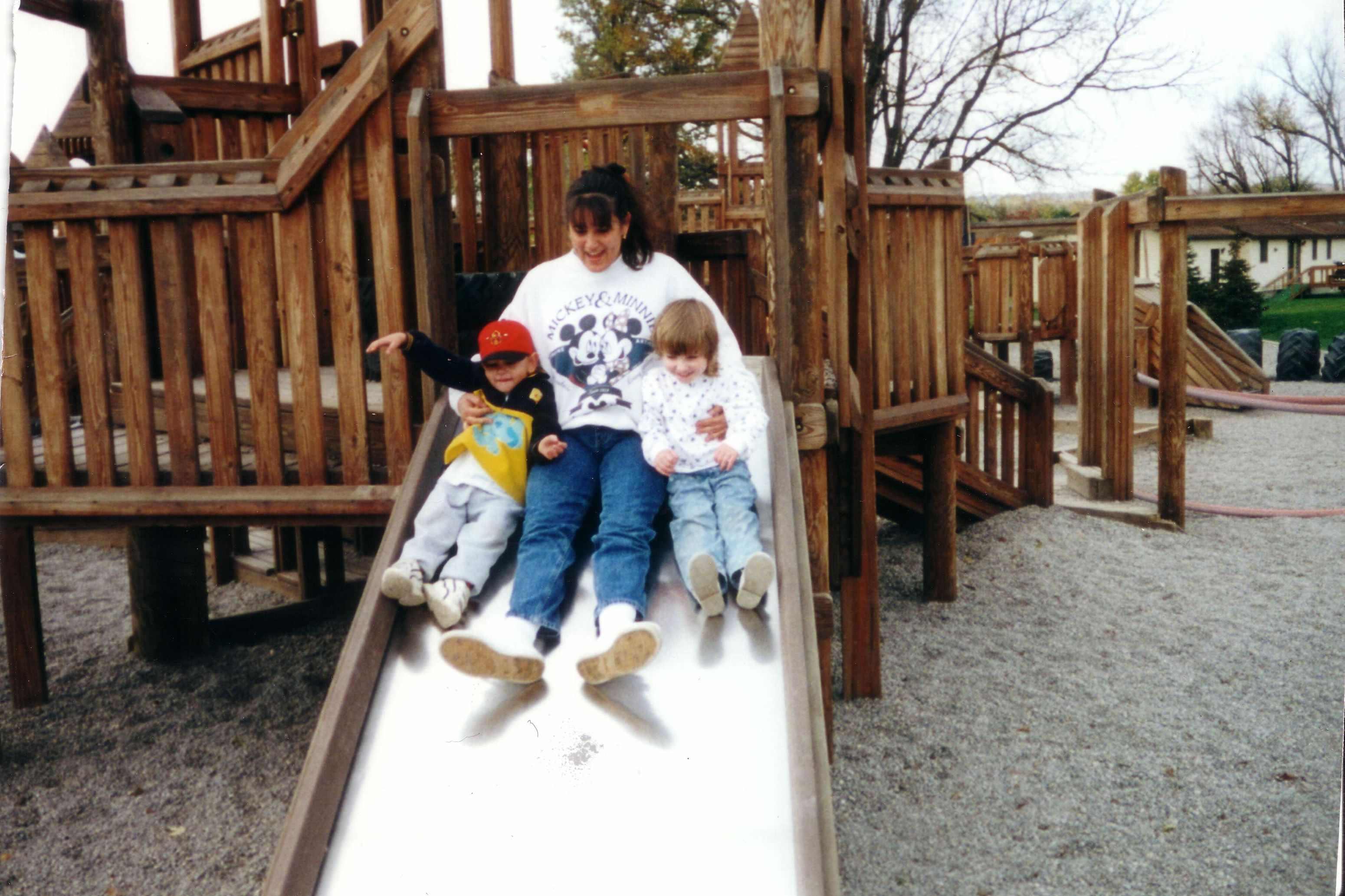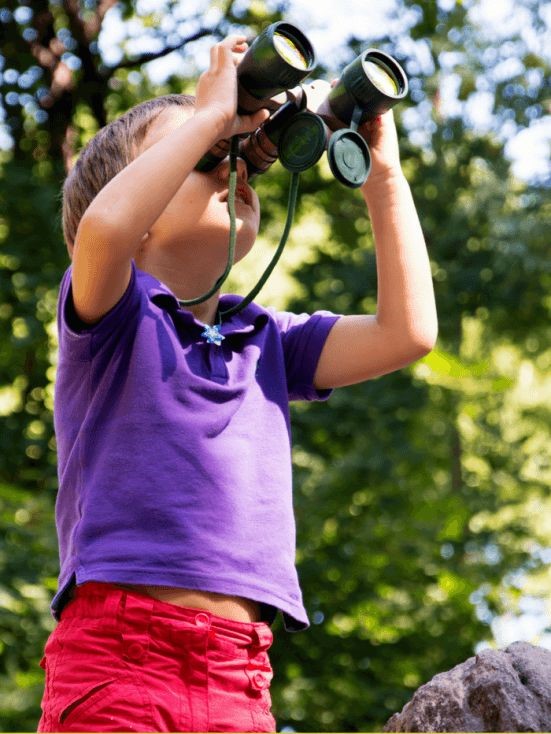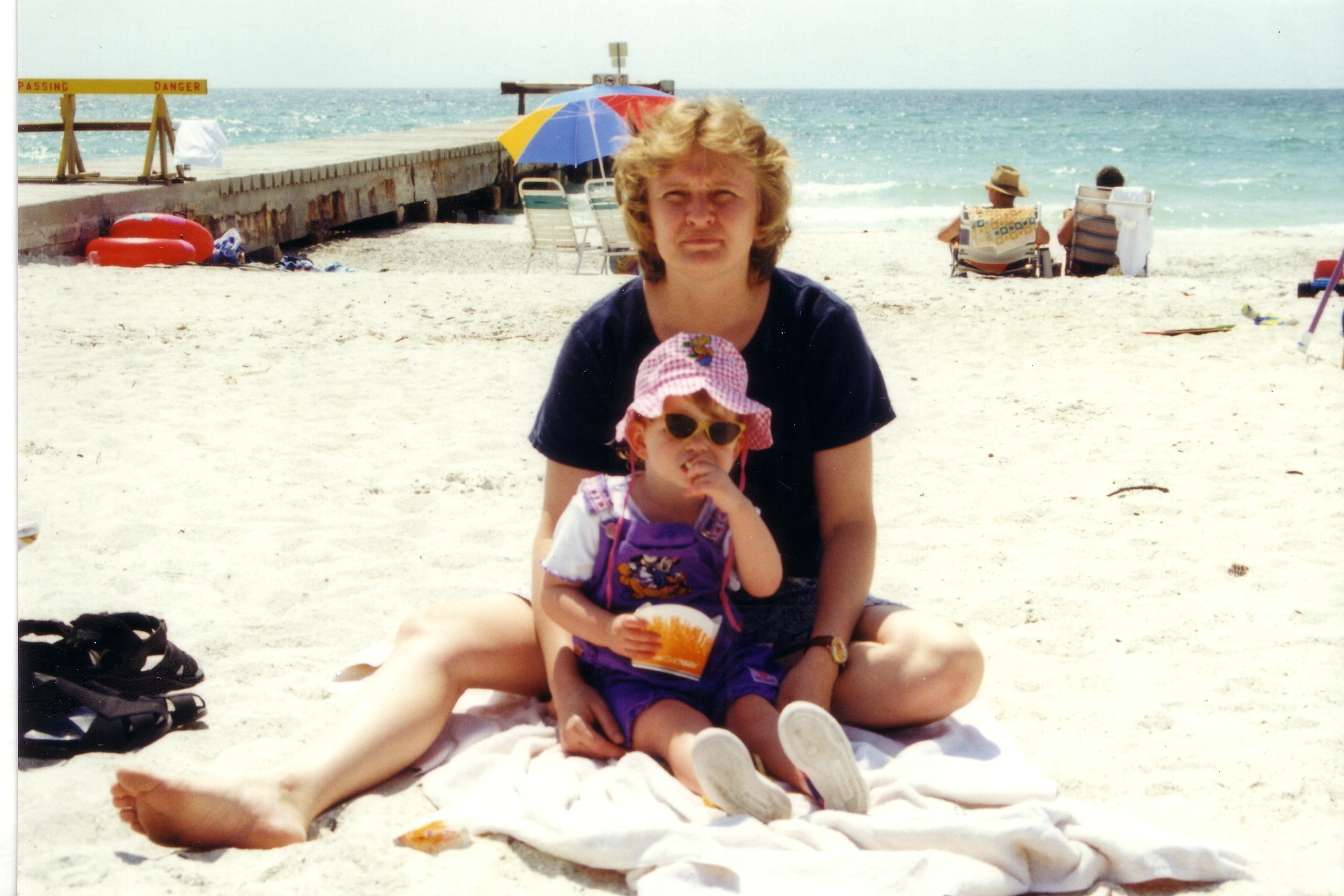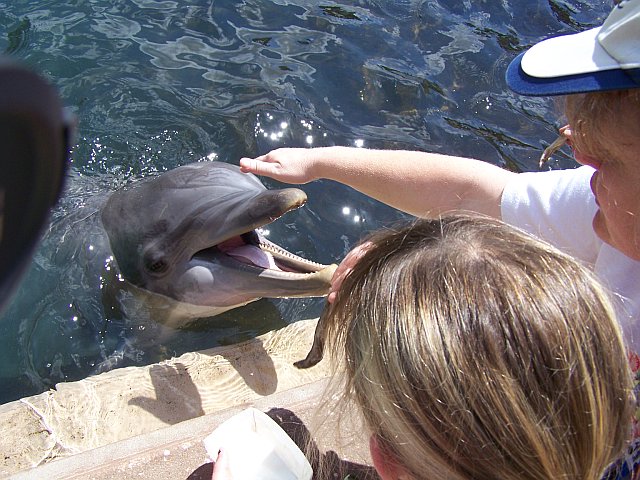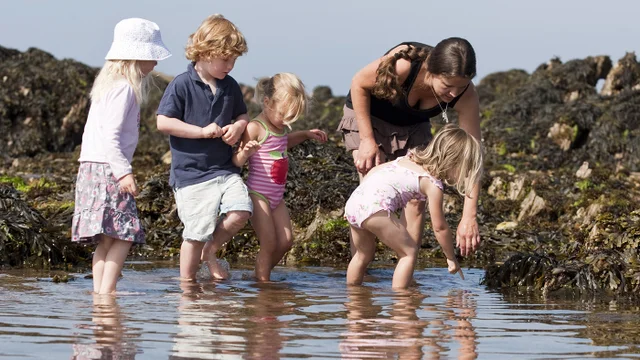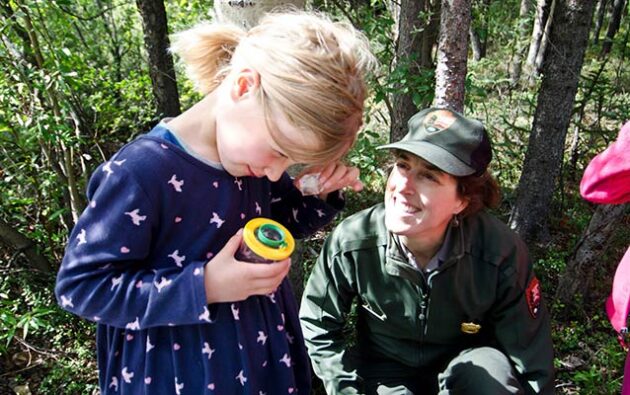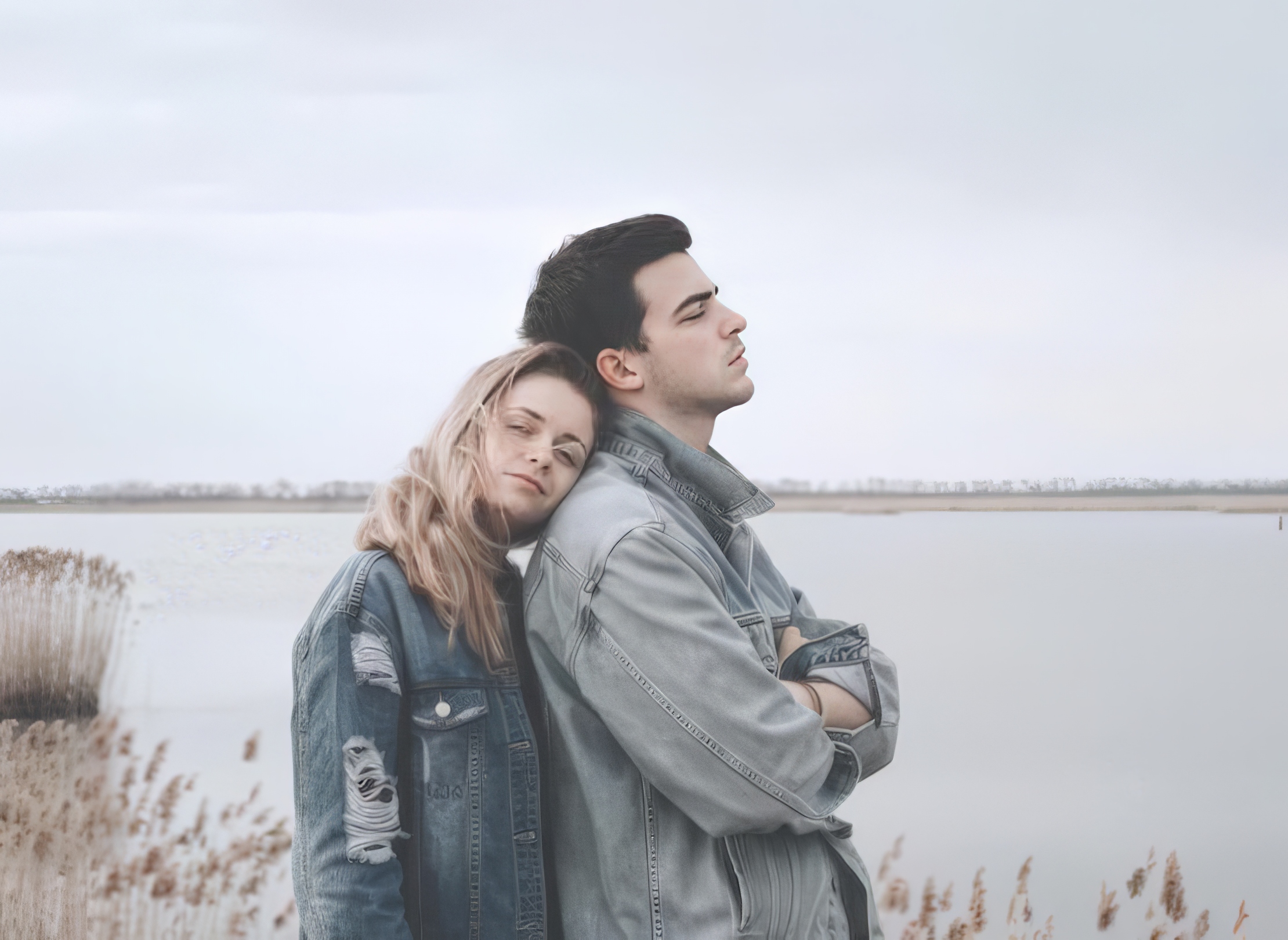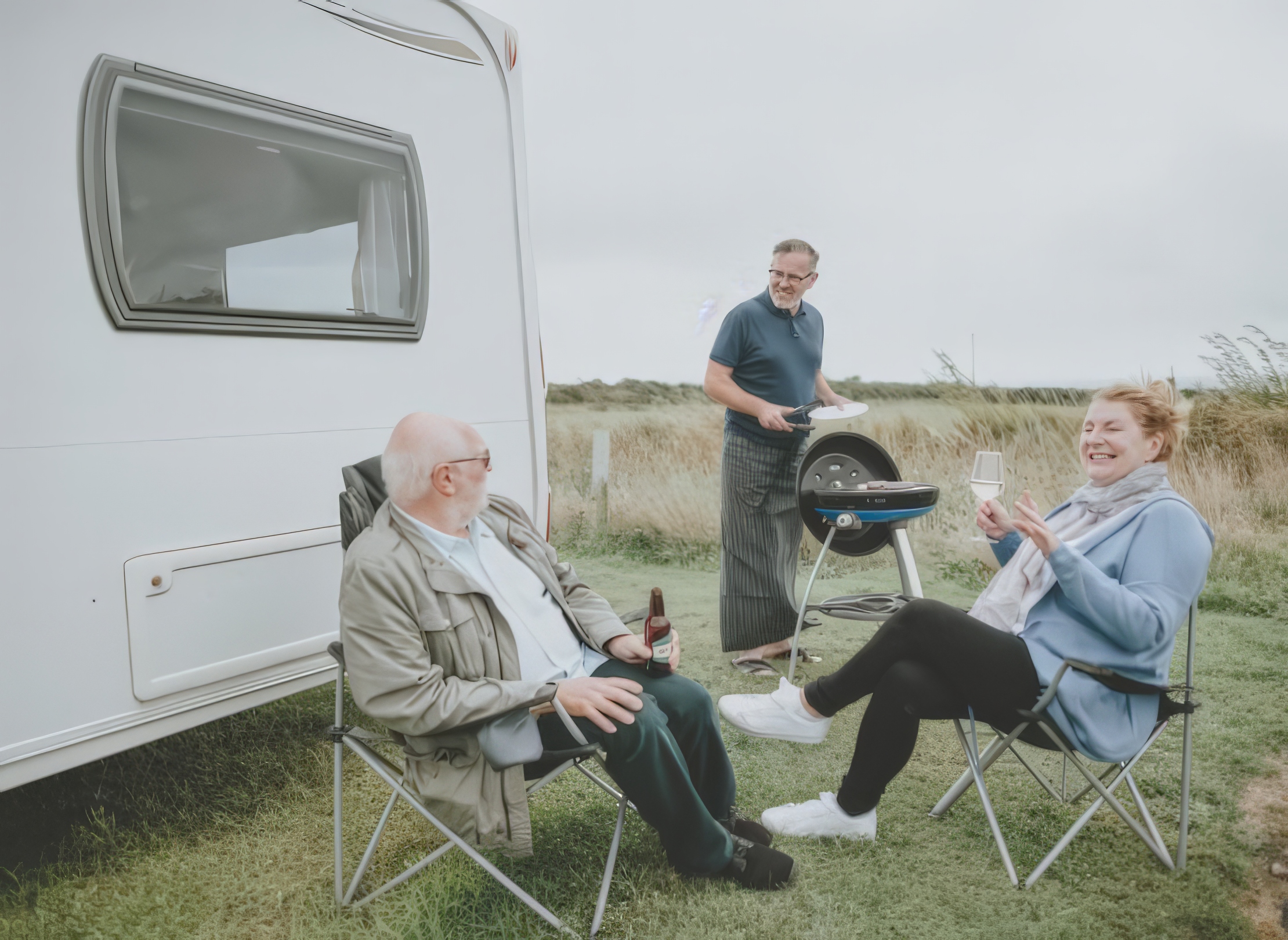
13218307041
Superscript
Nature Play
For Babies & Toddlers
Being outside is probably a totally new experience for your infant, especially if they were born this past winter or fall and haven’t been outside yet.
Don’t be afraid to let them get a little dirty! They wash up just fine.
Enjoy a walk and just talk softly to your baby
Walks are great for both parents and babies. You both need the fresh air if you’ve been cooped up in the house too long. Pop your baby in a stroller or carrier and take them out to enjoy the sights.
Make sure you point out all the things they will be seeing while outside. From houses and cars to trees and birds, your little one is taking in all of his surroundings. Even though he may not be speaking just yet, he is still understanding a lot more than you may think.
The best way for your baby to learn new vocabulary and language is to see the real world that we live in.
Here are some ideas for walks you can bring your baby on:
Go to the farmers market and point out the fruit and vegetables
Hiking trails and point out the plants and animals
A park with paths and point out other people, kids, and playgrounds
Outdoor mall or shopping center and point out people and shopping items
Walk the boardwalk and point out the ocean, sand, and birds
Trails around a lake or reservoir and point out the ducks and water
Outdoor Play
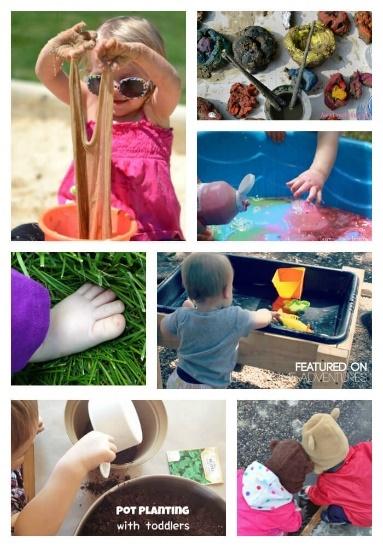
5 Ideas for Playing Outdoors with a Baby – Barefeet on the Dashboard
Bubbles With Baby Pink Oatmeal
Outdoor Sensory Play for Baby ~ The Realistic Mama
Bubbles and Color in the Play Pool ~ Learn Play Imagine
Exploring Puddles ~ Bambini Travel
Pot Planting ~ Bambine Travel
15 Ways to Play Outdoors with Babies ~ Angelique Felix
Sand Slime ~ Growing a Jeweled Rose
Information on Urban Nature
14 Outdoor Activities for Babies
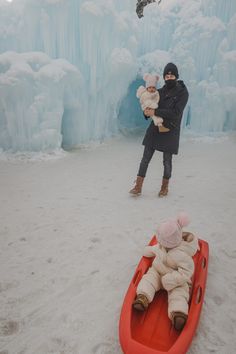
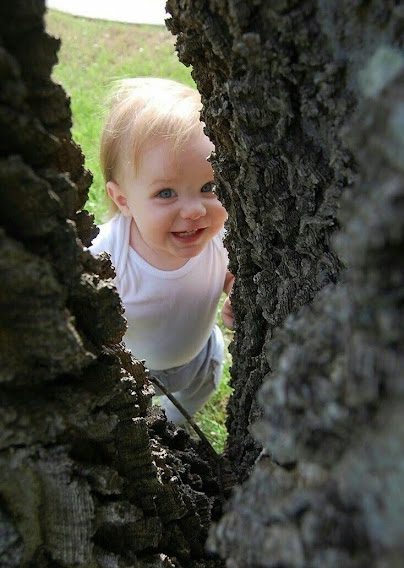
We all know the importance of getting your kids outside and into nature. The benefits of spending time in the great outdoors are not limited to children. They also extend to new parents and babies. Taking an infant on outdoor adventures may sound crazy or overwhelming, but we’re here to tell you that even small amounts of time spent outdoors will do wonders for you and your baby’s health, mood, and spirit. Today, we’re sharing why it’s so important to get your baby outside, tips for taking your baby outside and 14 simple outdoor activities for babies that a new parent will easily be able to incorporate into daily life.
{Post contains Amazon links}
Benefits to babies of being outside
There are so many wonderful benefits of being outside for babies. During the first few years of life, infants and toddlers are trying to make sense of the world as their brain synapses form at a rapid rate. These synapses are formed based on the richness of the child’s sensory environment. Spending time outside is an exciting sensory experience for babies. It gives your little one the chance to look around and learn from every sight, noise, and sound.
Infants need interesting things to look at, as well as a variety of sounds, temperatures, and smells. Research shows that being outside gives them a more meaningful sensory experience than being indoors. Imagine the difference between lying on a blanket outside watching the flickering leaves of a tree, feeling the sunshine and the breeze, hearing a dog bark nearby and smelling freshly-cut grass. Now contrast that to lying on a blanket in the house and looking up at a ceiling or mobile. The sensory experiences cannot be matched.
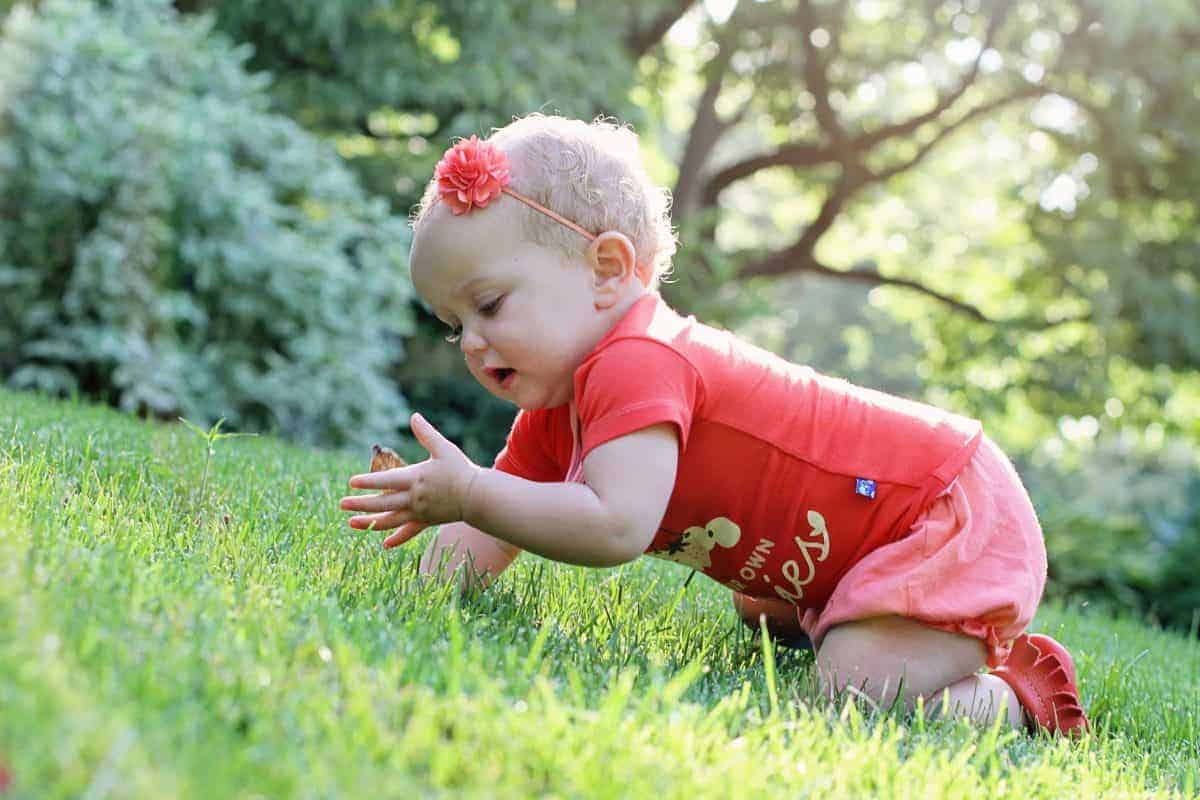
Babies that spend time outside are often healthier and sick less often. The fresh air and sunshine (Vitamin D) can do wonders for anyone’s health. Spending time outdoors also gives your baby an escape from indoor germs and bacteria. Recirculated air in closed environments and germs on commonly touched indoor items are the main causes of children getting sick. In fresh, outdoor air, babies do not have to rebreathe the germs of others, and the chance for spreading infection, viruses, and illnesses is reduced.
And if those weren’t enough to convince you to take your baby outside right away, research also shows that babies sleep better at night if they’ve had some fresh air and sunshine during the day (particularly in the afternoon). The daylight helps babies make the day/night adjustment and get on a more consistent schedule.

Tips for taking babies outside in extreme temperatures
Before you take your baby outside, here are a few things to consider to ensure a safe outdoor environment for them.
If it’s hot or sunny, consider staying in a cool shady location. Use a sunhat (we love these “Noggins” by Veyo Kids) or umbrella to block the sun’s harmful rays. Most pediatricians don’t recommend sunscreen for babies until they’re at least 6 months. After that, we recommend this brand of baby sunscreen. If you’re baby-wearing, be sure to use a baby carrier that’s breathable (we love the Solly wrap) and your baby is properly situated and isn’t overly dressed. Make sure to limit your baby’s time in the heat and exposure to sun. If it’s cold, make sure your baby is properly bundled and warm. We love these winter one-piece kickee pants quilted coverall for extra warmth in colder months or this full-body fleece from North Face.
A Bucket List for Baby’s First Summer
It is your first summer with a sweet little bundle of love. And, it is your baby’s first summer – ever. Make the most of it with memorable moments and photo-worthy fun in the sun. Here are 14 more things to add to your summertime bucket list
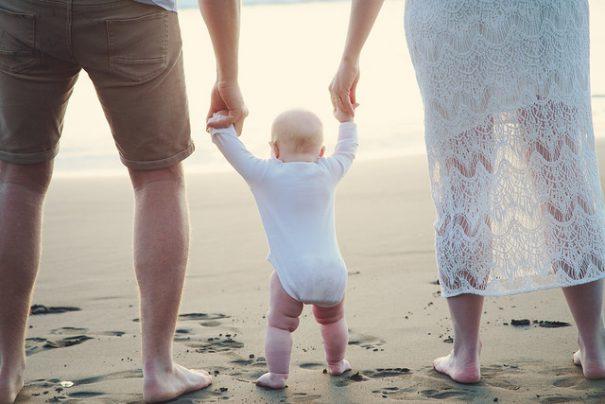
Beach Baby Walking
Taking your baby to the beach is at the top of any list of summertime fun. While you’re there, dip his toes in the water. Take advantage of the picture-perfect surroundings: draw your little one’s name in the sand and snap a shot of your wee babe with the massive ocean behind him.

Get Messy
Do not be afraid to get messy with your little explorer. She’s never squished sand between her hands before, she’s never made a mud pie and she’s never splashed to her heart’s content at a water table. Each one creates its own mess, but we promise that will be topped by the amount of delight it creates as well.
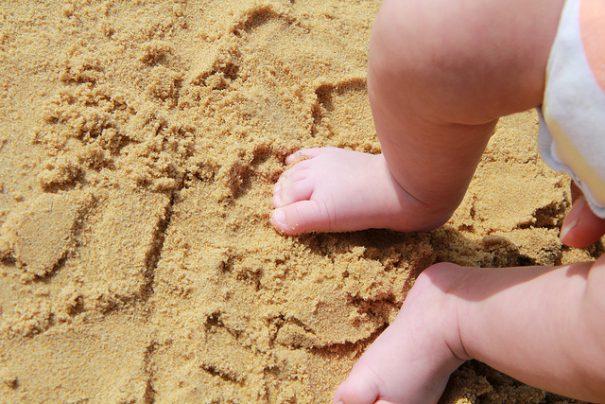
Footprint Time
Summer is the perfect time to take photos of sweet baby toes and hands before they get big. If you’re at the beach, snap a picture of your kiddo’s footprints in the sand. If you’re landlocked, dip your kiddo’s hands and feet in water, then help him make a print on warm pavement, then grab a snap a photo before it dries.
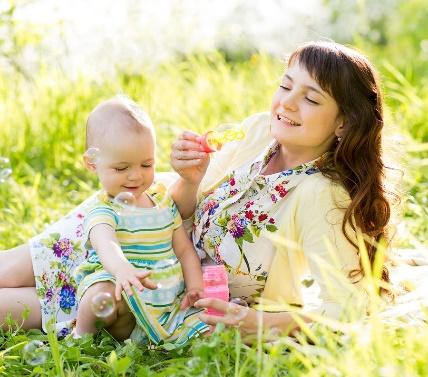
Blowing Bubbles
Spend an afternoon daydreaming and watching bubbles float on the breezes. This is a super-cheap way to mesmerize your little one, and bring on adorable, amazed expressions that make for perfect photos. It’s so easy to just keep small jars of bubbles on hand and lay out a blanket and watch them drift of. It makes an ordinary day a little special.
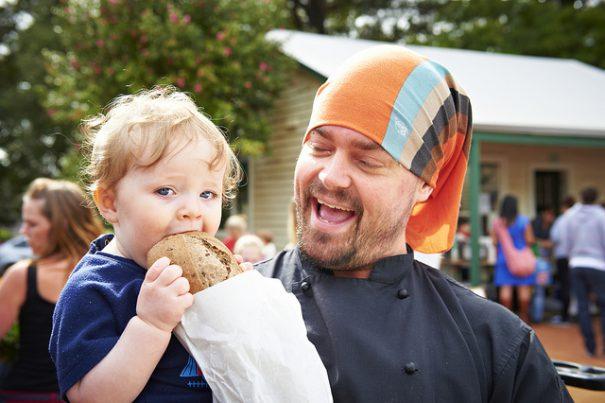
Photo: Margaret River via Flickr
Shop Together
Visit your local farmers market to pick out the freshest goodies you can find and set up a summertime feast for your new nibbler. Or, if you’re near a farm, bring the baby to a pick-your-own berries spot, where he can lounge in the shade while you grab a few bright red fruits for him to test. This site will help you find the farm nearest you.
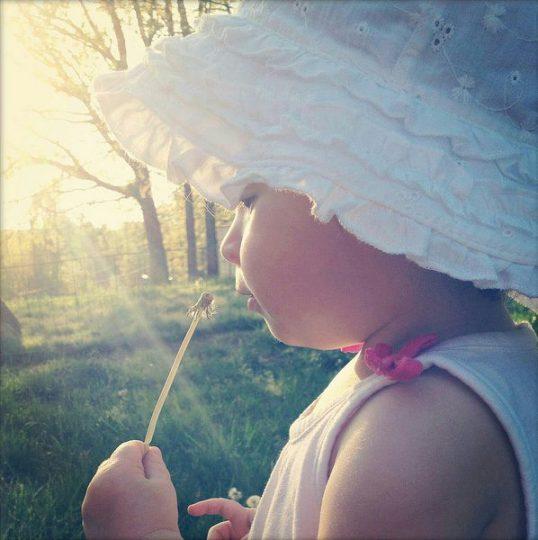
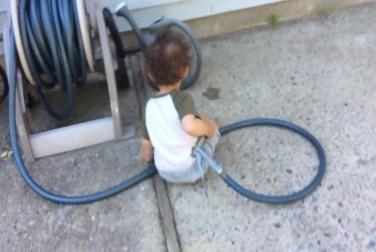
Photo: brandon v via Flickr
“Smell the Roses”
Head outside to take advantage of the chance for brain-boosting sensory fun in the sun: tickle your little one’s toes with a soft dandelion and let her feel a pinecone’s bumps. Listen to the buzz of a bumblebee. Taste a fresh smoothie. Walk and talk in a garden or two, describing the plants including every sense that you can.
Enjoy a lovely, lazy summer day. (Hope and Donavan were watering and “tending” their babysitters garden at a really young age. They did not have good aim but loved to hold the hose. Hope did not like water in her eyes, so we used sunglasses.)
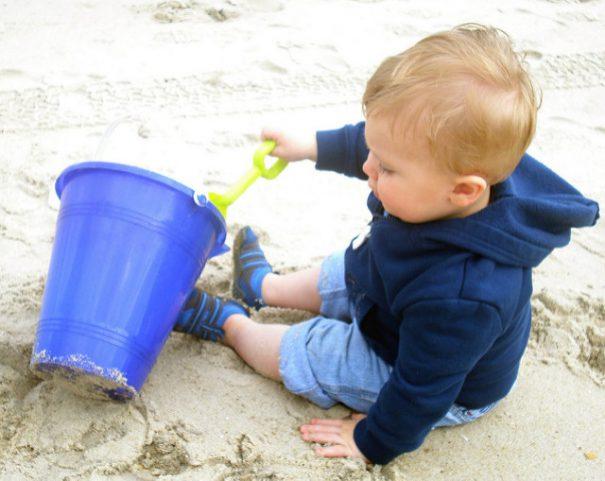
Photo: Kate Hopper via Flickr
Dig It
Pick up a shovel and a bucket and let your kiddo work on his eye-hand coordination. He can dig in the sand at the beach, scoop up some water, or shovel at the playground. Afterward, stroll by a local construction site for a little free baby-friendly entertainment show put on by diggers and cranes.
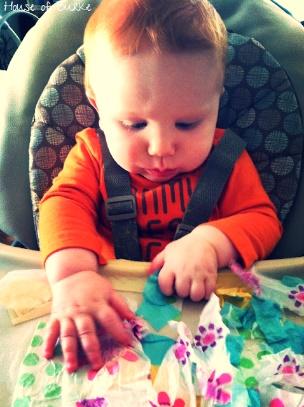
Artsy Adventures
Give your baby some finger-paint (like the non-toxic kind) and let her make her first piece of artwork. When the weather is warm, simply strip your little one down to his diaper, spread old towels outside, and put out paper and a little paint. You can whip up your own easy-peasy edible finger paint with plain yogurt and a few drops of food coloring, or follow oursimple flour recipe. Hope's first art was so simple. She loved to slap the table or tray on her highchair. So I put dabs of finger paint on a sheet of paper, index card, or paper plate and she slapped it, making spat art. She loved it.
(Using baby safe homemade paint allows you to start art so much earlier. I usually tell people. “If they can feed themselves, I can get all sorts of art out of them.” But sometimes the untamed motions they make with their hands lend themselves to making art even before that.)Alternatively, try ice painting with this how-to from Domestic Mommyhood for another funsensory playexperience. Bonus: the mess stays outside plus you’ll have the baby's first masterpiece.
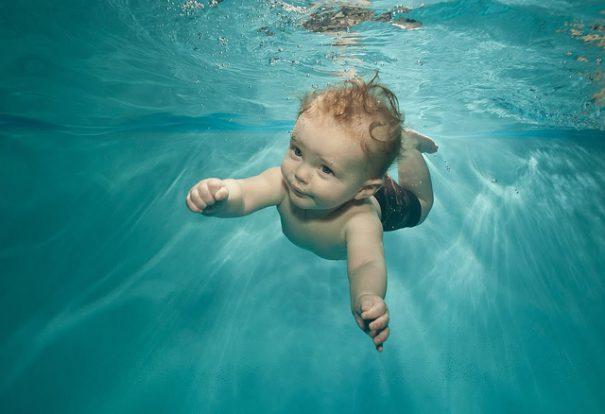
Water Baby
Pool, ocean, or bathtub: anyplace you can let your little one relax and splash, do it. Summer is the perfect time for Baby’s first swim and to sign up for a mommy-and-me swim class.

Photo: Shannon McGee via Flickr
Chill Out
When the mercury soars past 95, keep cool with indoor fun. Visit the local library to peruse their extensive selection of board books, or check out museums with stroller- and crawler-friendly programs.
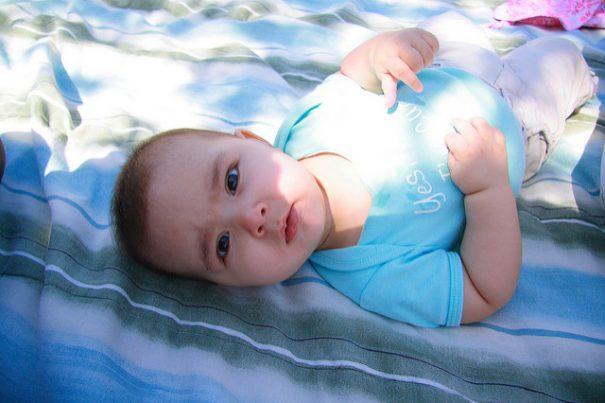
Feast Outside
Whether she’s feasting al fresco on breast milk or solid food, take that food outside for your baby’s first picnic. Afterward, spread out on your blanket for tummy time under blue skies and watch the clouds drift by before nap time.
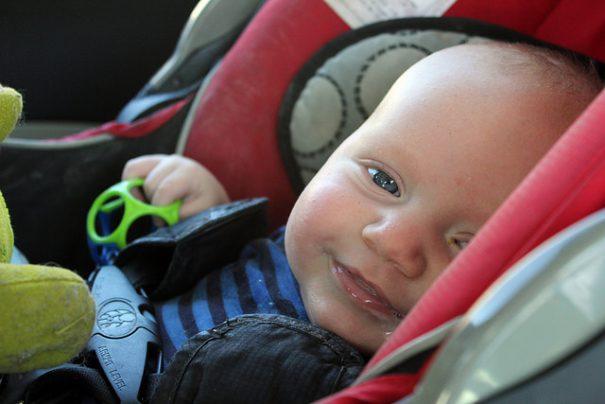
First Road Trip
Show your baby the sights by taking your first vacation together, even if it is just to the next town over. Visit a new park, stroll down unfamiliar streets and take pictures of your kiddo as you explore new surroundings together. If you’re taking a long road trip, check out this list of tips to make it a little easier on your little one – and you.
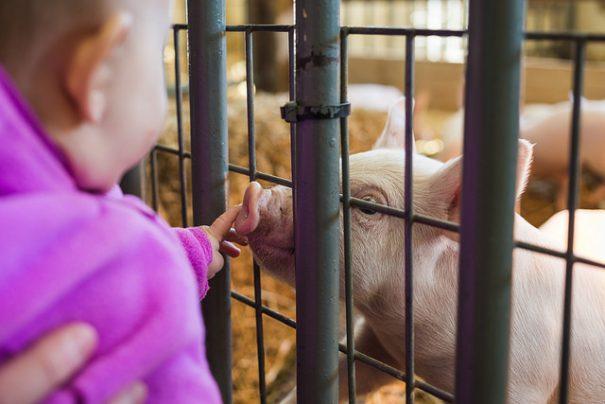
Meet-and-Greet with Animals
Visit some wildlife: at a big zoo, a local petting zoo or even the neighborhood dog park. You just might meet your baby’s new best friend. (Okay wildlife came to us in our yard. But our zoo was fabulous in Denver)
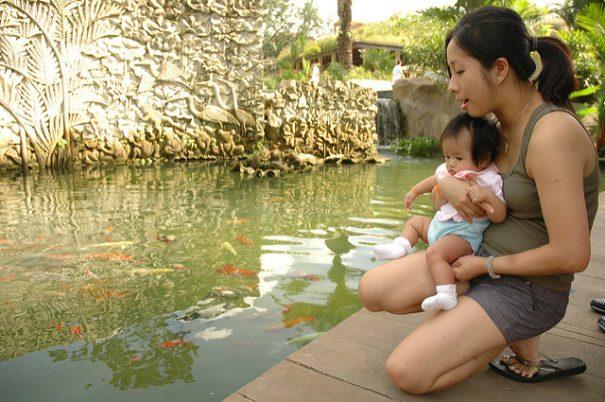
How Does Your Garden Grow
Gardens are in bloom in the summer, and a stroll through your local botanic gardens will give you a little fresh air and show your baby all-new sights and smells. They’re blooming with sensory experiences for your baby to explore while riding high in a wrap or baby carrier.
There are so many “buzzwords” when it comes to play and learning in early childhood. However, I don’t think there is just one correct way to play. You can play your own way.
One of my favorite ways to get siblings playing together is using sensory theme. Read on for my favorite sensory bases and how to make sensory theme work for siblings!

Tips and ideas for outdoor play with your baby
Outdoor Sensory play for babies simply means to involve your senses (think touch, taste, smell, etc).
The park, the beach (or sandbox), and your backyard are all packed full of possibilities for sensory play. We live in an apartment but that doesn’t stop us from using the small patch of grass that’s next to our parking lot. Babies don’t require a large space.
Here are simple tips for a nature walk or stroll:
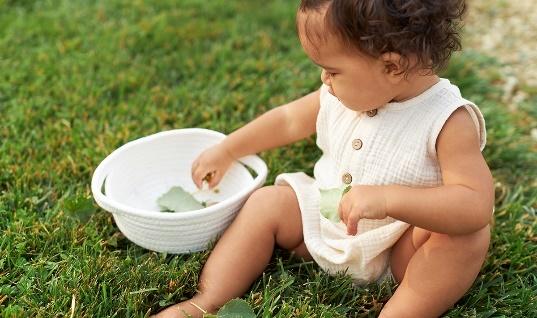
Allow your baby to get close to the ground and examine natural details—different types of grass, bark, moss, leaves, stones, pinecones, and soil may catch their attention. Collect one of each item into a container or basket.
Hunt around for some bugs! Talk about which insects crawl and which one’s fly.
Look up at the sky and tell your baby about the weather and how it makes you feel (physically and emotionally).
Trees are full of lessons—help your baby feel the texture of the trunk by placing your hand over theirs and run them along the bark and count the other trees around you together.
Practice sniffing scents of flowers, grass, fruits, or berries in a garden if you have one.
If your child likes you to take photographs or create art outside, this is a great time to have them capture some of their observations for their Adventure Journal of the critter or other pond features such as plant life or the ripples on the water’s surface.
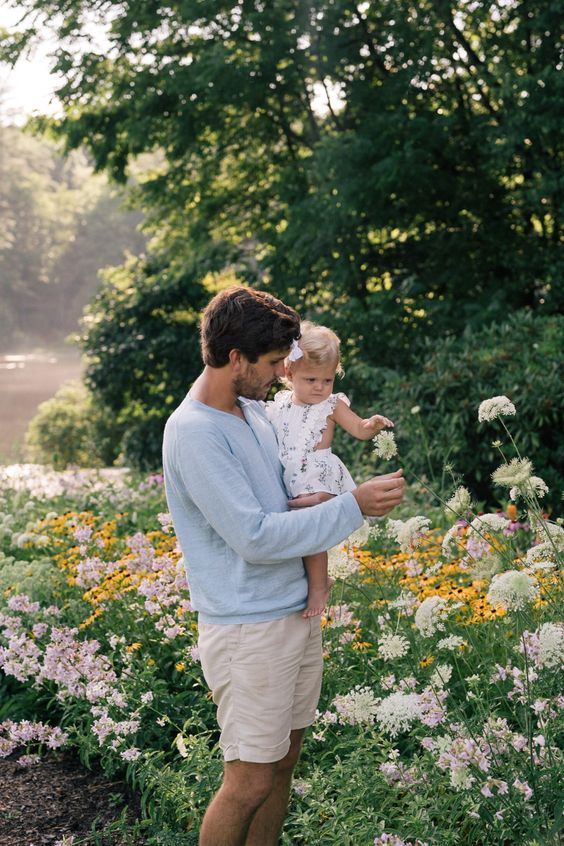
You’ve probably heard us shout from the rooftops about the amazing benefits of unstructured outdoor play for kids. And while that sounds fantastic once your kids are old enough to play by themselves, what do you do outside with a baby? Luckily, there are a variety of fun and simple outdoor activities for babies that you can do with very little prep work or planning.
Just having a few ideas of easy activities can sometimes be all the encouragement and motivation you need to give it a try! We’re here to show you just how easy* it can be to get outside with your baby. However, just remember that for babies, the actual activity is not as important as being together, being outdoors and giving your baby new experiences.
*Depending on how things are going with your little one, taking a baby outside might sound easy or incredibly overwhelming. Sometimes the simplest things can feel like too much when you have a newborn. This list of activities is not meant to stress you out or add one more thing to your to-do list. These are merely things that you are probably already doing that you can take outside to add an extra layer of sensory experience and get you some fresh air and sunshine.
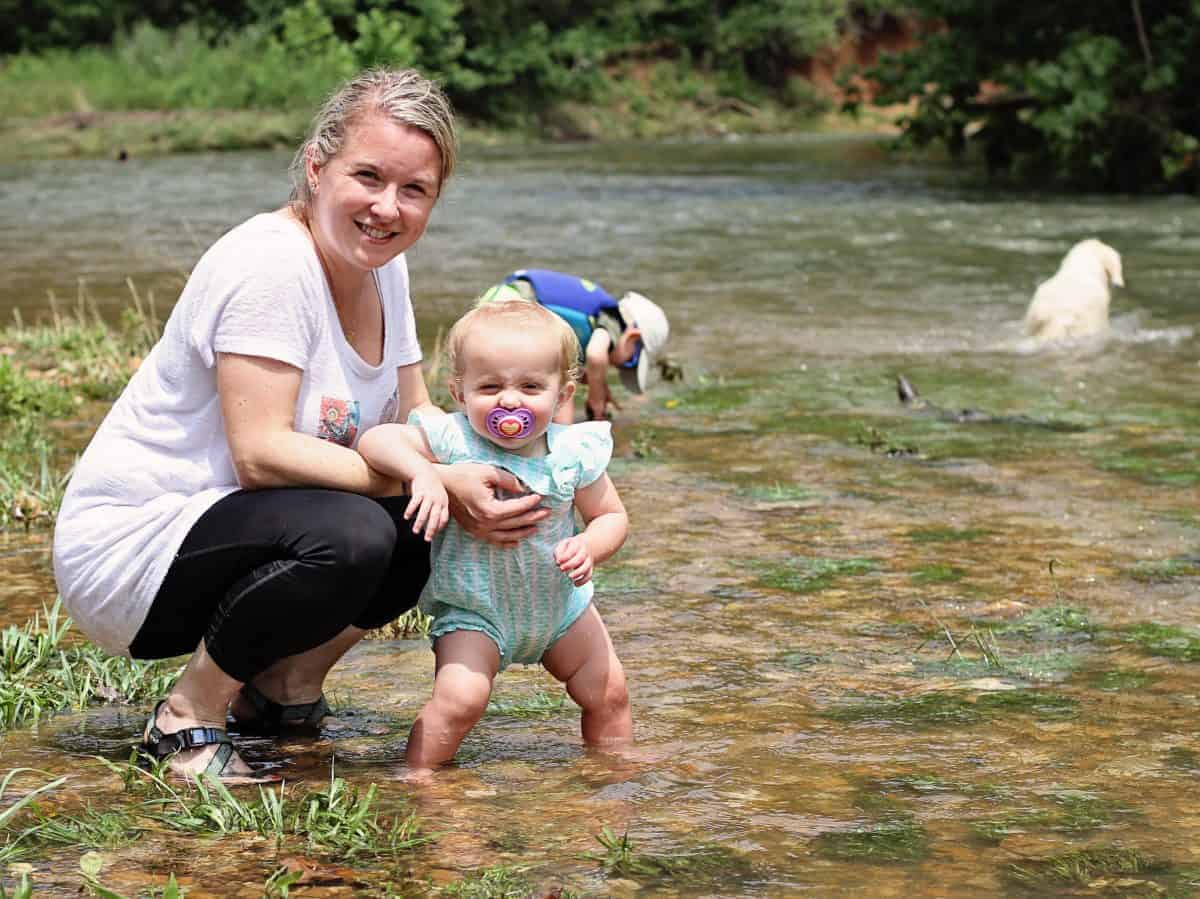
1. Take a walk
One of the simplest things you can do outside at any age, is to take your baby outside for a walk with you. Outdoor activities for babies don’t have to be complicated or need a lot of planning. Whether your little one is in the stroller, baby carrier or just in your arms, a short walk around your yard or neighborhood will do you both a world of good. Simply being outside is a wonderful way to engage baby’s senses without overstimulating them. There’s something about just being outdoors that seems to calm babies. If your little one is having a hard time, melting down, crying for no reason – go outside! This is my go-to trick when our kids were babies (and it still works with school-aged kids!). A walk outside in the fresh air is more beneficial than you’ll ever know! Trust me, try it!
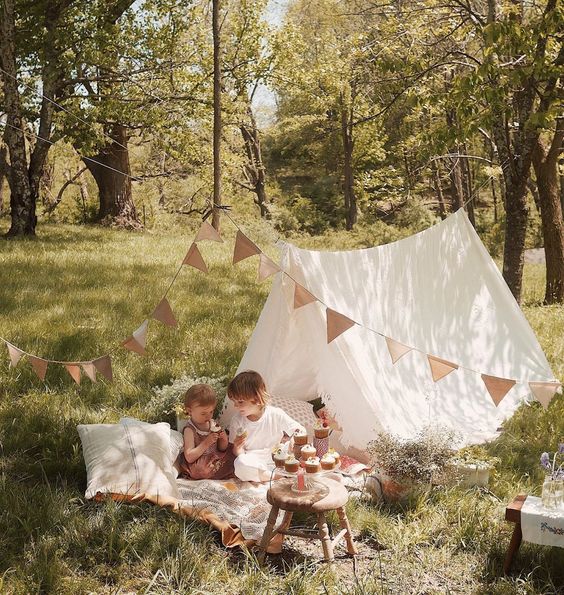
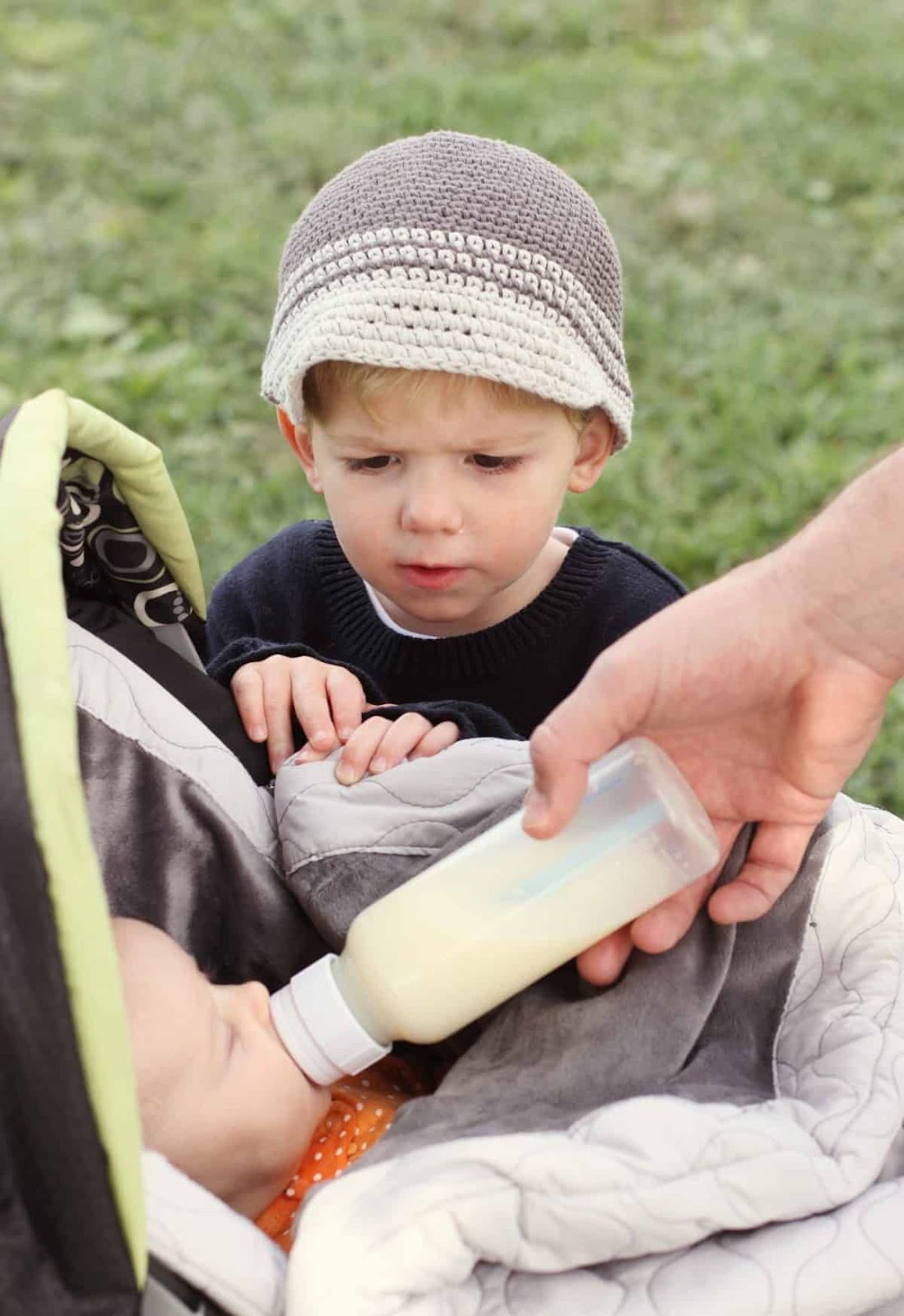
2. Eat outside
You’re already feeding your baby multiple times a day, so if possible, take a few of those feedings outdoors. If you’re a first-time mom trying to get the hang of nursing or feeding your baby, by all means, just do what you need to do to get your baby fed and stay sane. But once you get the hang of things, consider a change of scenery and feed your baby outside. Start in your backyard and move on to park benches or next to a stream once you get comfortable. Babies spend an unbelievable amount of time eating, so why not make the most of it and get some fresh air while you’re at it.
Once your baby is old enough to start purees or solids, continue to feed them outside! Move the high chair outside or set them in a Bumbo seat if they need support. Eating outside is a particularly great outdoor activity for babies because the cleanup is a breeze! No more scrubbing floors or walls when food gets spit or thrown!
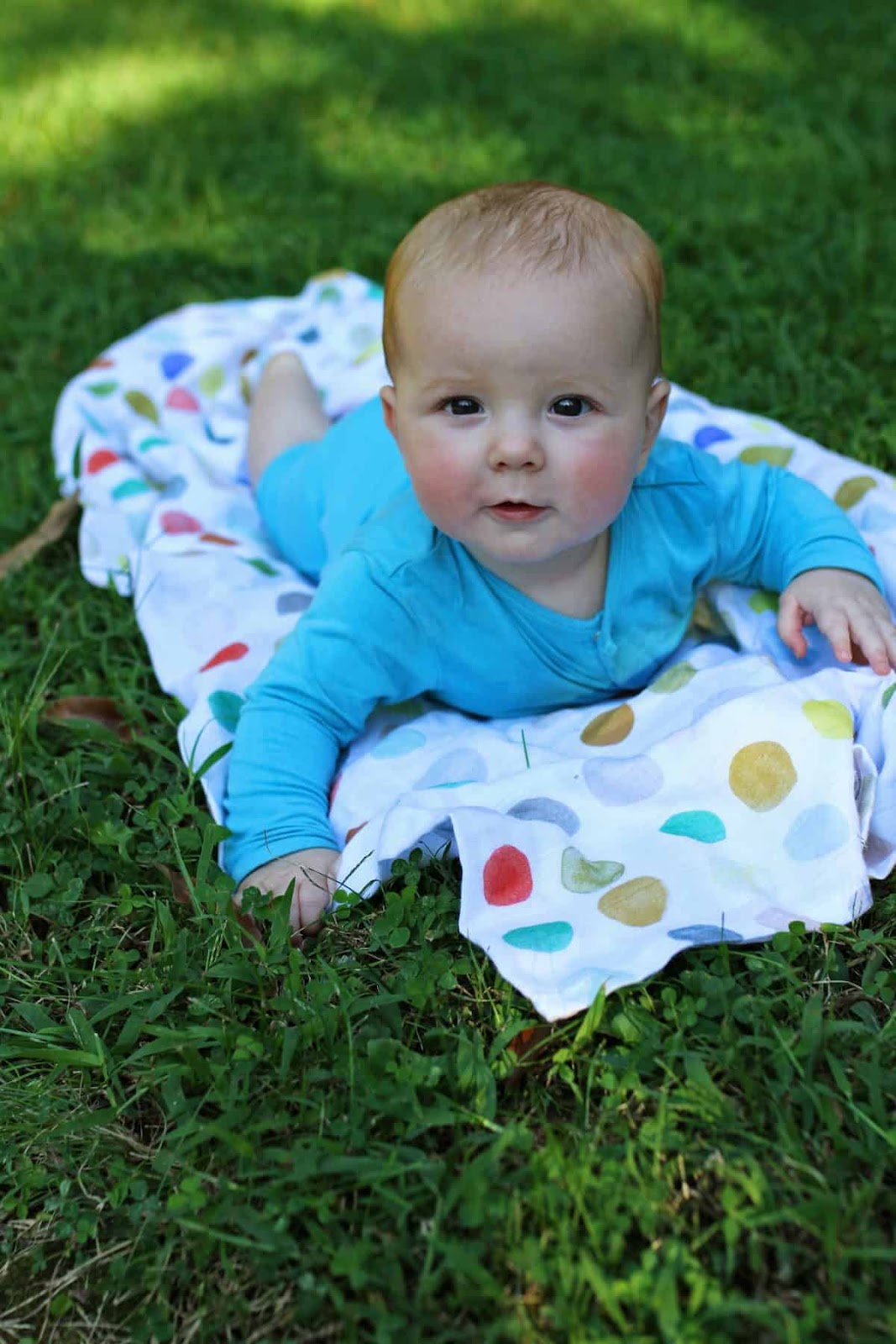
3. Tummy time
This is another activity that you’re probably already doing inside, so take it outside! Grab a blanket and some toys and move the action outdoors. Babies will love reaching for and touching new things, like grass and leaves. And when they’re finished with their tummy time, roll them on their back and let them see the sky.
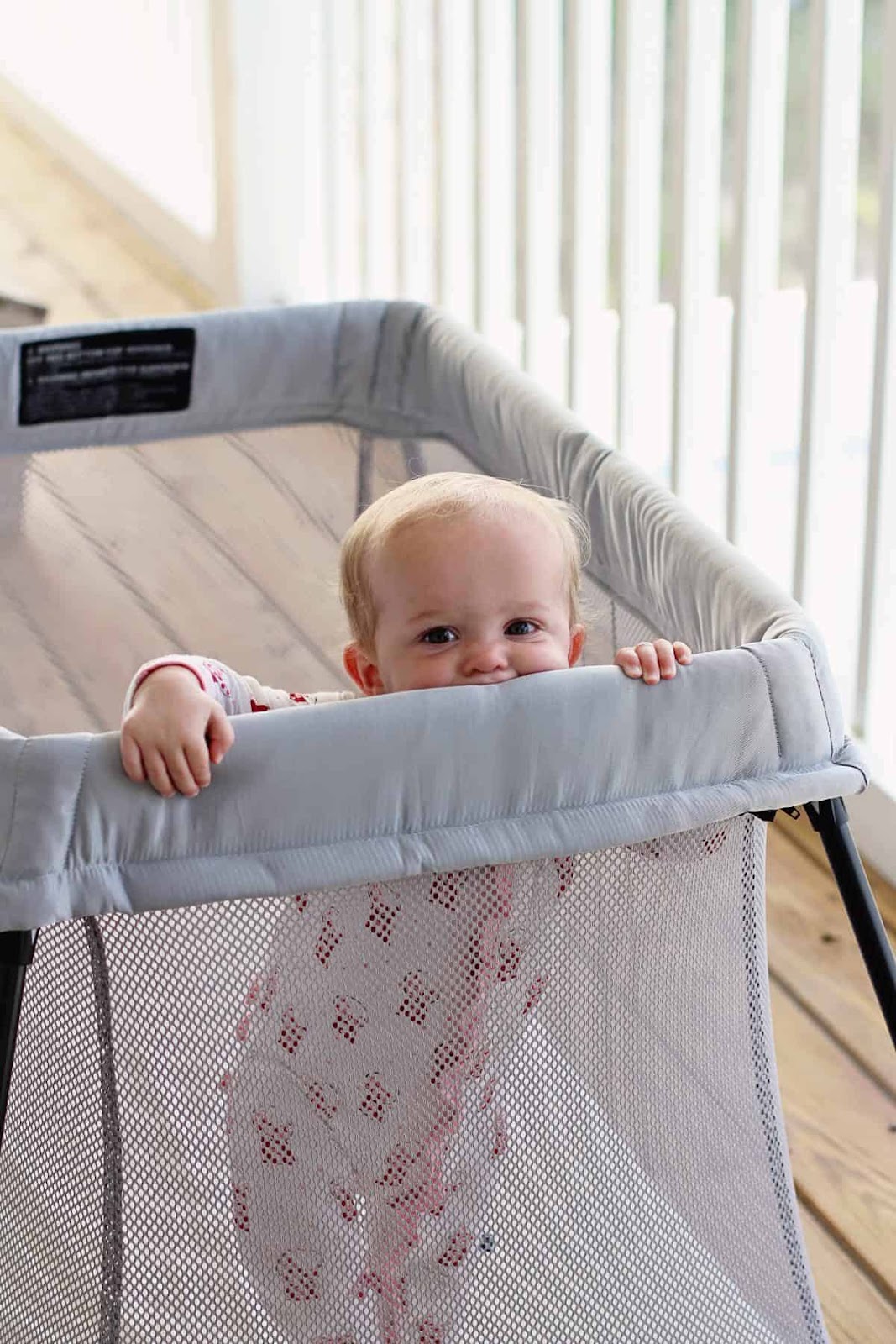
4. Take a nap
If you want your baby to truly benefit from all the wonders of being outdoors, try napping outside! Bring out a travel crip (we love this one from Baby Bjorn) or just set up a safe space on the ground for your baby to sleep. Babies in Scandinavian countries take naps in prams year-round as young as tw0-weeks old and in temperatures as low as -4F for up to three hours! Research by Marjo Tourula of the University of Oulu, Finland, shows that frigid napping not only promotes better daytime sleeping, but it also increases the duration of sleep. Other benefits, not yet borne out by research, purportedly include children being happier, more energetic, able to sleep better through the night, and capable of snoozing in any environment, even loud and bright.
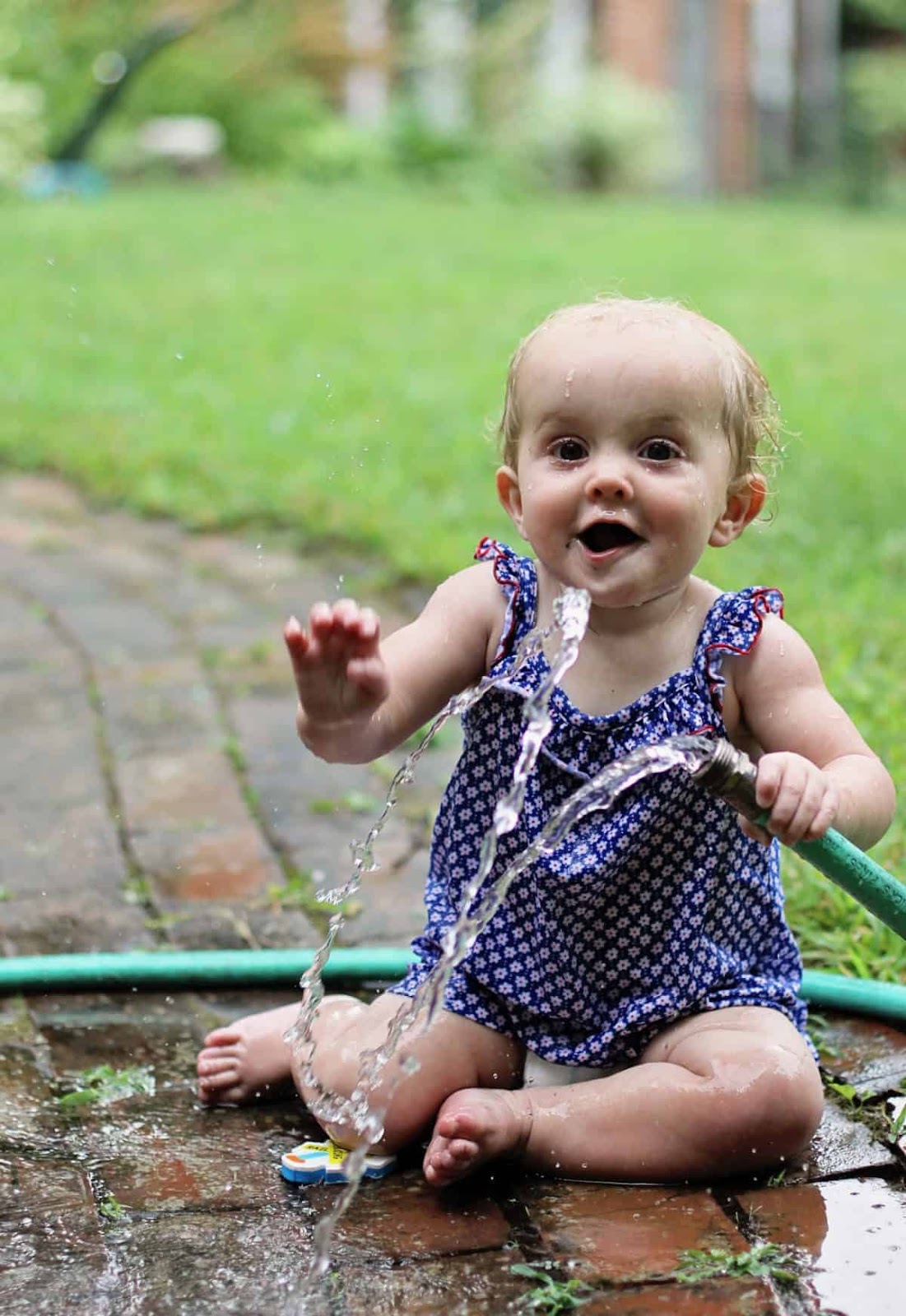
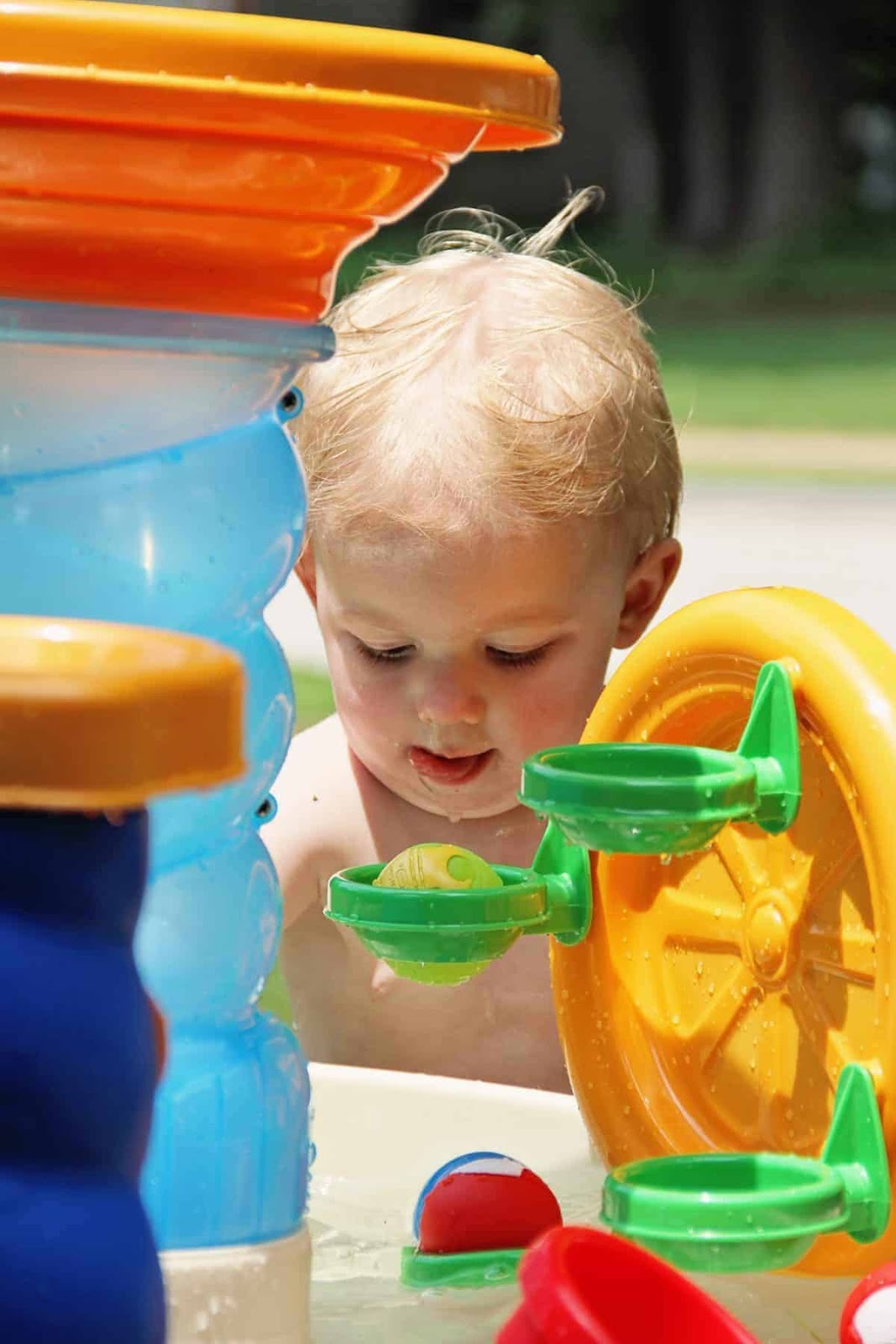
5. Water play
If your babies are anything like mine, they love water! If it’s warm outside, consider giving your baby a few bowls or trays of water to touch and splash with their hands. A baby pool filled with just a few inches of water could occupy my little ones for hours! Add measuring cups, spoons and scoops for extra fun. If your baby can stand, try a water table (we’ve had this one for years). And older babies love the novelty of the hose. There’s something about running water that absolutely fascinates them!

6. Visit a playground
Babies need time and fun places to work on developing new large motor skills, such as crawling, pulling up and climbing. Playgrounds can be perfect places for babies to experience new surfaces and textures, climbing on different levels and sliding! Plus, once your little one can sit up and has good head and neck control, try the swings! The swinging sensation is sure to bring on big smiles to your little one.
Pro tip: Consider visiting playgrounds during off-hours (school hours during the week), when there are not as many big kids around.
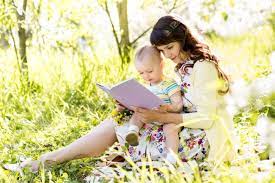
7. Read a book
Spread out a blanket under a shady tree and read your baby a few of her favorite books outside. Babies enjoy reading books anywhere, but taking them outside adds a whole new layer of fun and connection. Consider reading books that take place in nature, so you can point out natural elements (trees, grass, leaves) in the story as well as around you.

8. Nature hike
If you’re feeling a bit more ambitious than a walk around your neighborhood, consider taking your baby for a hike. Hiking is one of the easiest outdoor activities for babies and doesn’t require much beyond what you’d need for a walk or quick outing. Hikes don’t have to be long, intense or elaborate (we recommend that they’re not). Wear baby in a sling/wrap or backpack carrier (we love this Osprey backpack) and simply go for a walk in the woods, nature center or local park. Choose a hiking trail where you can interact with nature and point out all the different sights (trees, flowers) and sounds (birds, water) to your baby. The sights, sounds, and smells of nature will stimulate their senses and the motion may even lull them to sleep.
Remember to take your time and don’t overdo it.
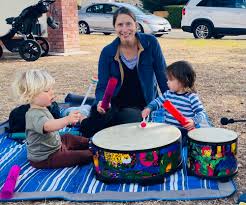
9. Jam session
Most babies are very intrigued by sound and making noise. Grab a few toy instruments and head outside for a fun music-making jam session. For instance, maracas, tambourines, keyboards and drums all make for excellent baby-friendly instruments. However, you don’t need special tools to jam out. Pots, pans, metal bowls and wooden spoons are also baby-safe and make plenty of entertaining noise.
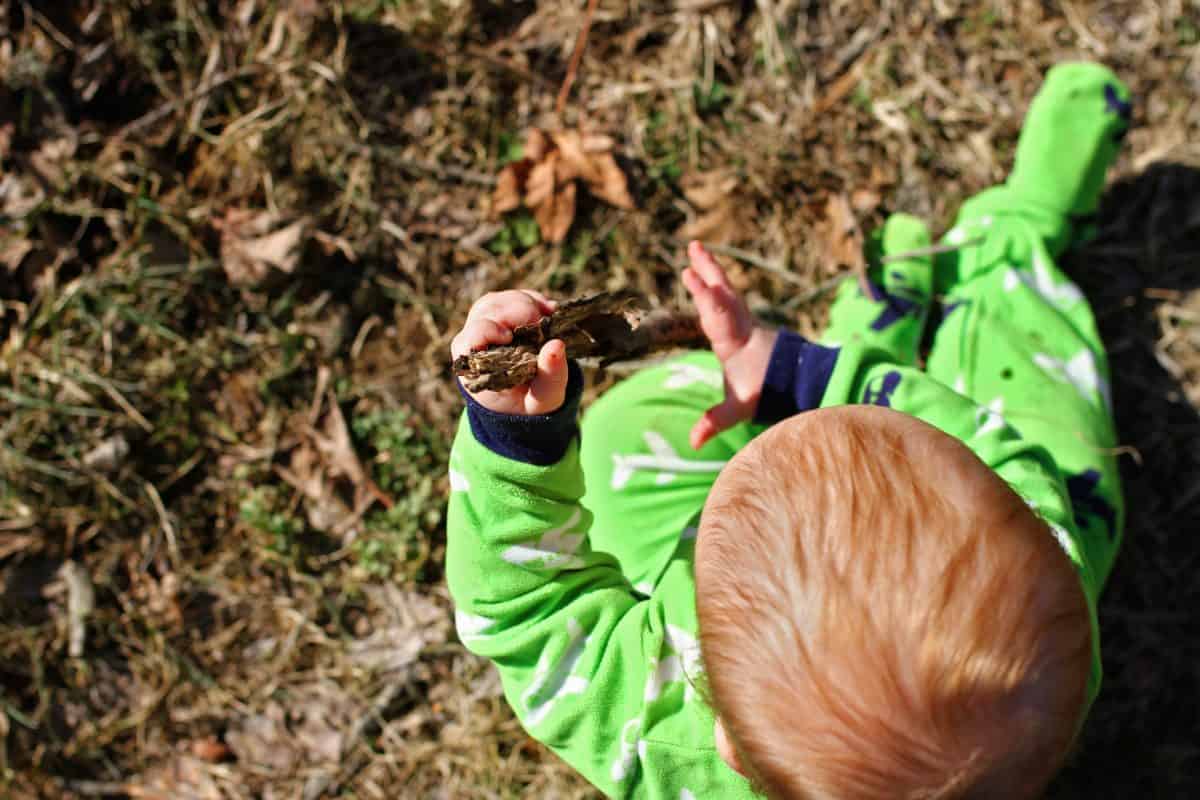
10. Sensory experience
Babies benefit greatly from new sensory experiences and the outdoors is a great place to explore. Have your baby sit on a blanket with a pinecone, a few large rocks, some sticks, etc. Encourage her to touch and explore the different textures. Let your baby feel the grass with her bare feet and touch it. Allow her to touch, feel and taste snow. Hand him dry leaves to crunch in his hands. These activities are great for babies to be able to experience sensory experiences at their own level.
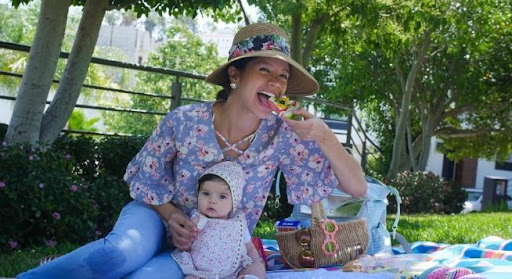
11. Observe a busy place
Once your baby is old enough to take in his surroundings and not get crazy overwhelmed by activity, take him somewhere busy to observe the sights, sounds and smells of a new place. From a safe vantage point, let your baby discover the hustle and bustle of a busy farmers market on a Saturday morning. Watch and listen to heavy equipment work at a construction site. Take your baby to your local zoo or aquarium to look around at all the animals in action (as well as the zoo of people all around). Or go to the beach to experience the sound and feel of the water, as well as the sounds of the people, seagulls and waves.

12. Play with balls and bubbles
Some of the simplest and easiest toys for little ones to play with are balls and bubbles. Take your ball game outside for new fun variations. Roll balls back and forth on a flat surface or throw them and watch them bounce. Bring out a variety of balls of different colors, textures, and sizes. Outside is the perfect place because there is plenty of space to spread out and nothing to break. Add some bubbles to an outdoor experience and watch your little one delight in the experience of touching and popping them. Bubbles are a super simple and easy outdoor activity for babies that you can do anytime and anywhere.
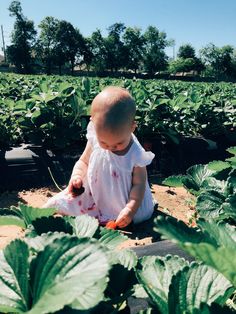
13. Garden, plants and weeds
Let your little one participate in gardening and observe you taking care of your garden. From the earliest age, my kids loved lying on a blanket outside or in a bouncer while I worked in the garden. Just spending time outside together doing things that makes the parent feel good is a great outdoor activity for any baby. Little ones can listen to the natural outdoor sounds, feel the breeze, look up at the sky and watch the birds. Or play some music and have a little dance party while you weed! Talk to your little one while you plant and explain what you’re doing and way. Of course, she won’t understand, but that’s not the point! Show her your harvest and even let her taste it (if she’s old enough).
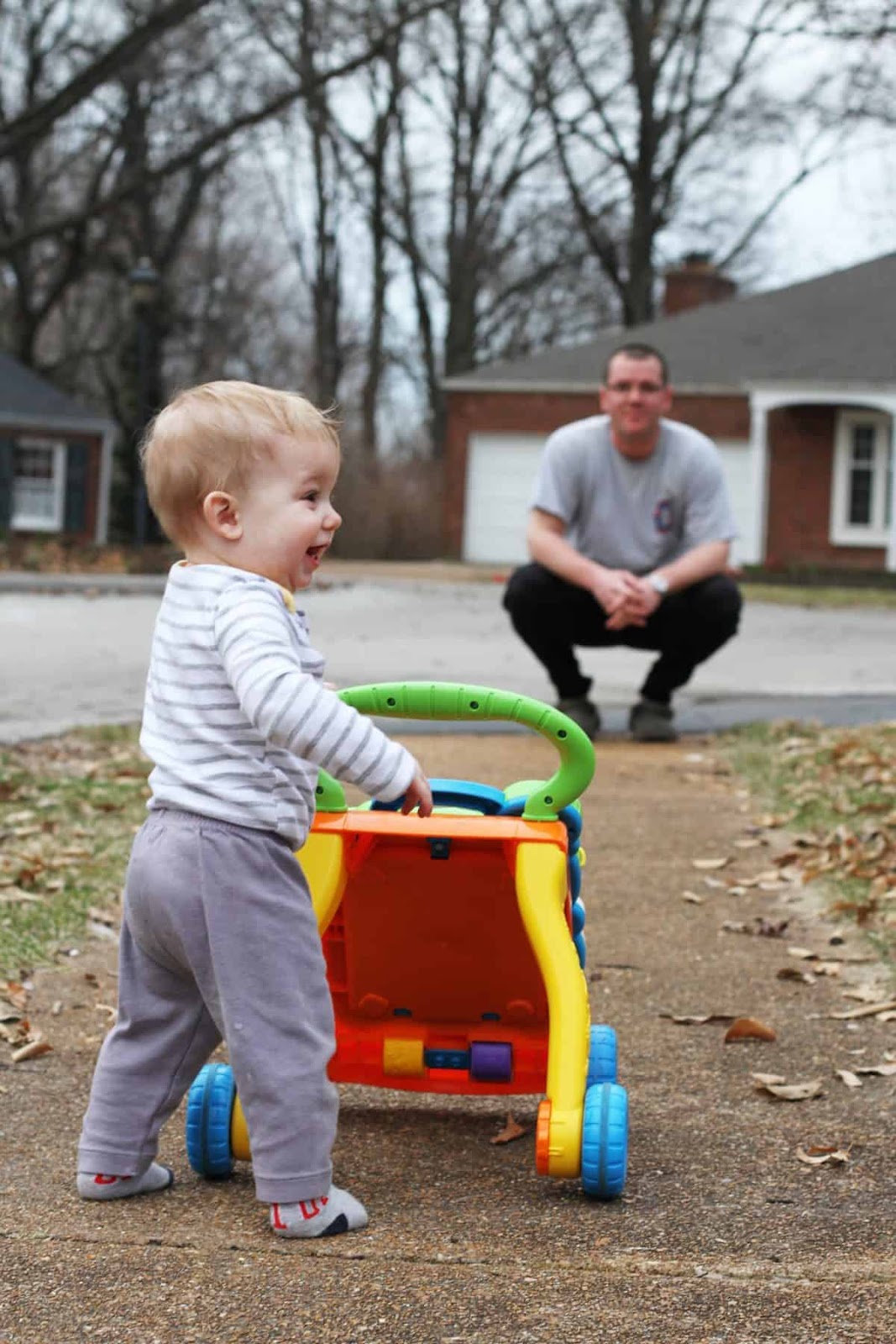
15. Practice walking
When your little one is ready to start walking, take her outside! Outdoor activities for babies don’t have to be complicated. Let them do what’s natural for them, but take it outside! Learning to walk outdoors gives her more space and fewer sharp edges. Start off in the grass, which is a nice soft surface for the inevitable trips and tumbles. Although don’t be surprised if your child becomes more interested in the grass, leaves, and sticks she finds on the ground and doesn’t get very far! Once she’s more steady on her feet, try the sidewalk or driveway. Moreover, if she needs a little assistance pulling up or balancing, walker toys move great outdoors.
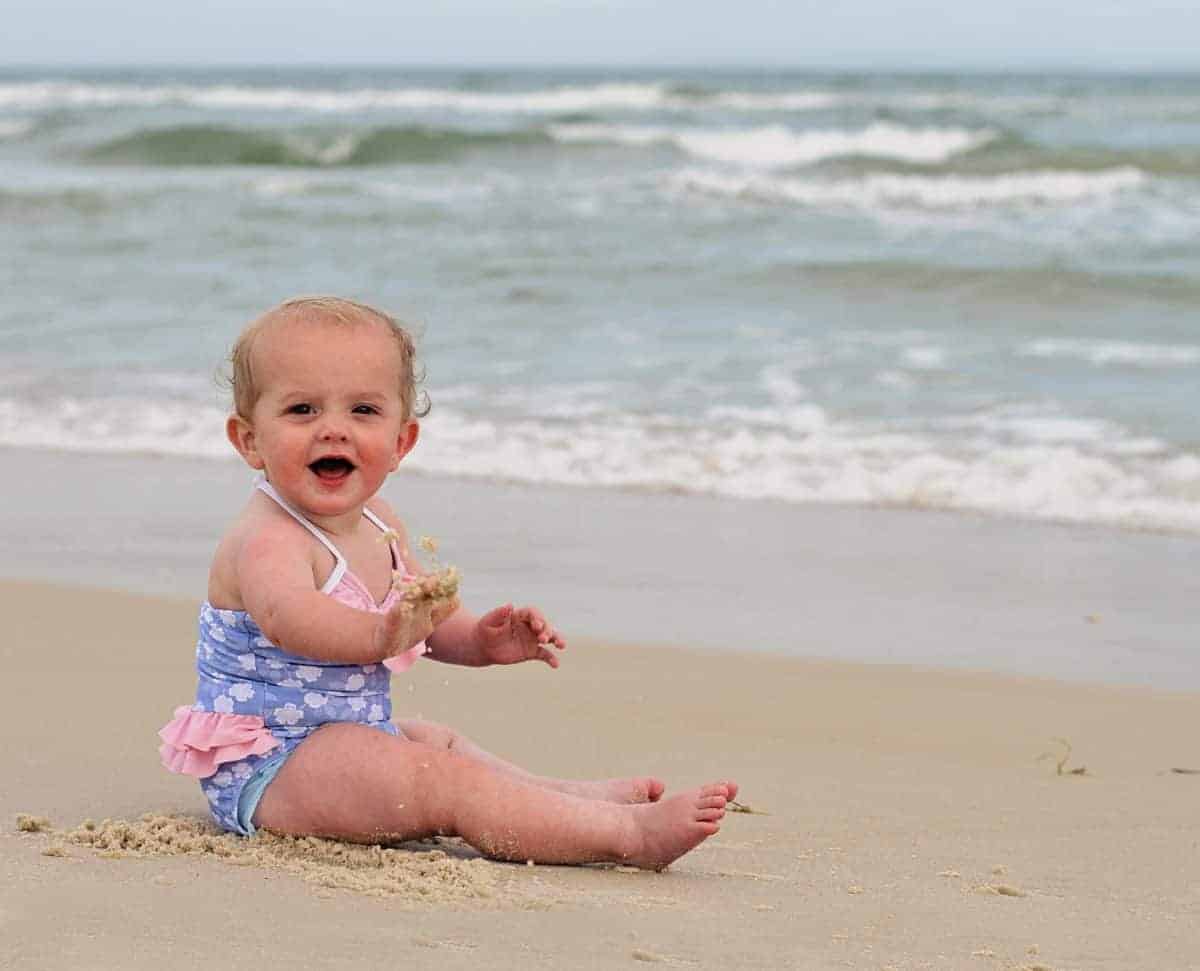
What are your favorite easy outdoor activities for babies?
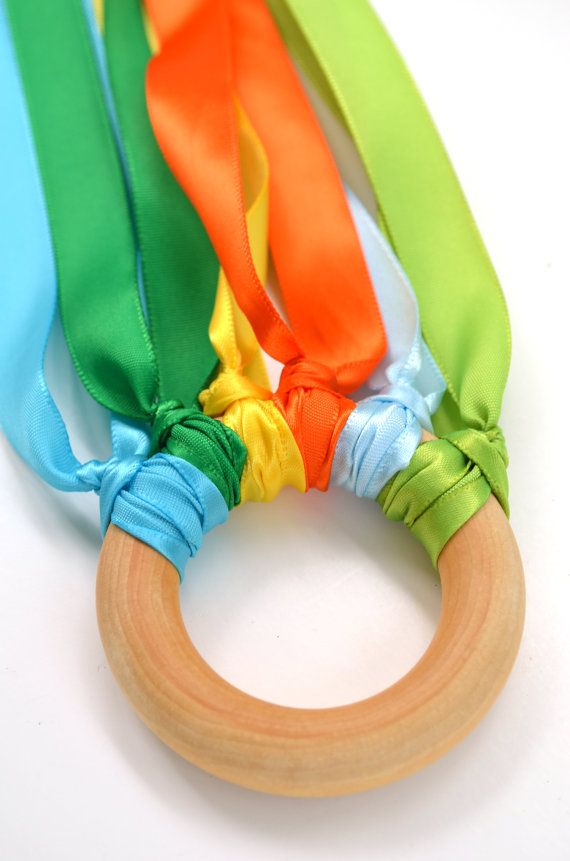
DIY Wind Direction Watcher
Hope loved a breeze to cool her down however she did not like not being able to see the wind. So I used these directions on key rings to make zipper pulls and hung some across the top of the hood on her stroller and carseat hanging so she could see the wind.
Build a wind direction watcher and you'll be able to see the wind blow!
What You'll Need:
–wooden rings or keyrings for zipper pulls
After cutting the length that we wanted, I burned the ends with a lighter to prevent them from unraveling, just singeing it enough without it turning black. (That melting is why only certain fabrics, like cotton, are recommended for children’s sleepwear.) You can also use clear nail polish to seal the ends.
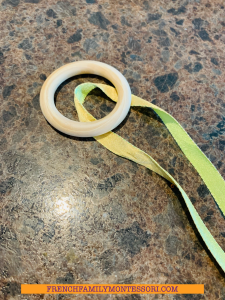
2. A simply loop tie and knot, repeated for each ribbon strand, and that’s it. I prefer the look of loop tie and knot, but you can always just knot the ribbons. I’ll add a photo that shows both variations.
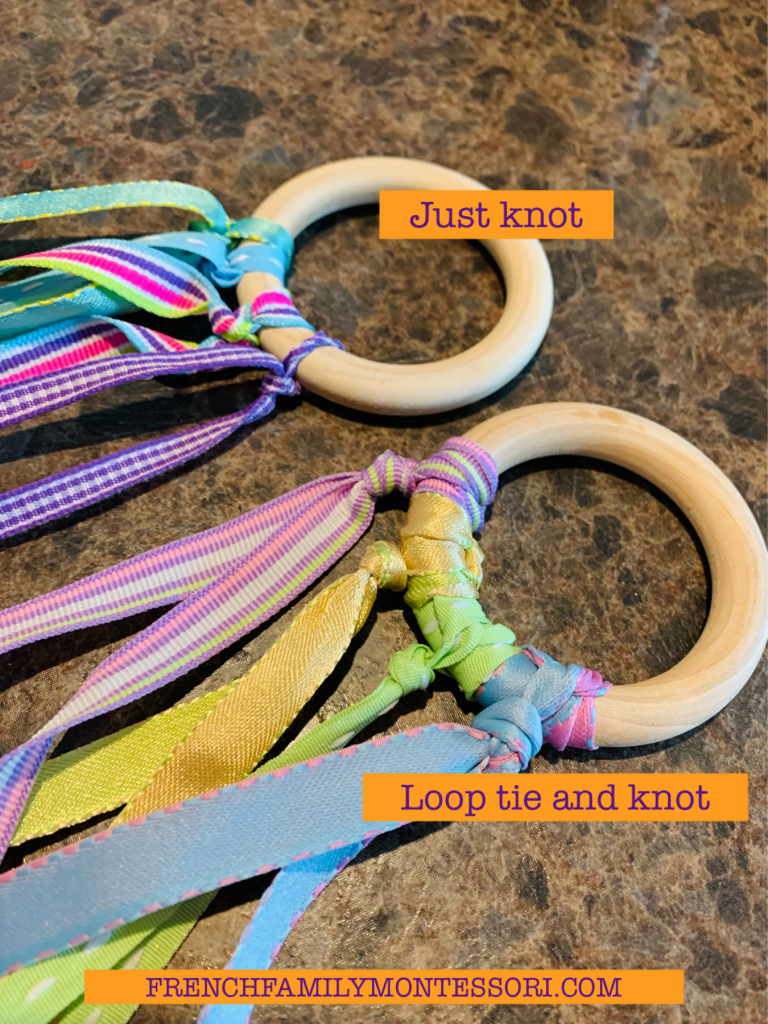
This was my first attempt at making a hand kite and I was surprised at how simple it was and how lovely they turned out.
Have you made a hand kite before? If not, I hope that you think you’ll try making one. There are so many ways to add them into your baby's sensory play time.
Explore Nature Anywhere You Are
When we imagine nature, we often think about our own part of the country. Nature is everywhere. Here are some ideas for wherever you might live, whatever the season.
At the beach: Dig down into the sand to find the water level. Look for small creatures while you dig. Look for changes in the color and texture of the sand and observe the size of the sand granules. Notice the colors in shells. Look for bird and crab tracks.
In the desert: Look for animal tracks, flowers after spring rains, and water sources. If possible, compare the dry desert to the desert after the rain.
In the woods Climb a tree. (Although children rarely climb above where they are comfortable on their own, you will sense when to draw the line, if necessary.) Swing on a vine or play seesaw with a strong branch balanced on a log. Build a fort with fallen branches.
In the snow: look for animal tracks and go on an exploration hike them with an adult.
In your backyard: Plant a garden and observe the flowers and vegetables as they grow. Watch for visitors, such as birds, insects, toads, lizards, squirrels, rabbits, or deer.
In a vacant lot: Look for weeds, seeds, and evidence of animal life like:
Scat (the technical name used by naturalists for animal droppings)
Animal tracks
Feathers
Wood that an animal has gnawed (such as a tree that has marks from a beaver’s teeth)
Holes in the ground (from a dog, a squirrel, a mole, or an armadillo)
Holes in the trees (from a woodpecker or insects)
Near water’s edge: Watch for birds and dragonflies taking off and landing or for frogs jumping in the pond. Bring a little net to dip in the water and ask your child to share her discoveries with you. Even if you don’t know what the creatures are, you can discuss what you see (legs or no legs, scales or no scales, antennae or other body parts, wing colors) and what you hear (fish splashing, insects buzzing, frogs calling).
Turn Any Walk
into a Nature Walk -Toddler
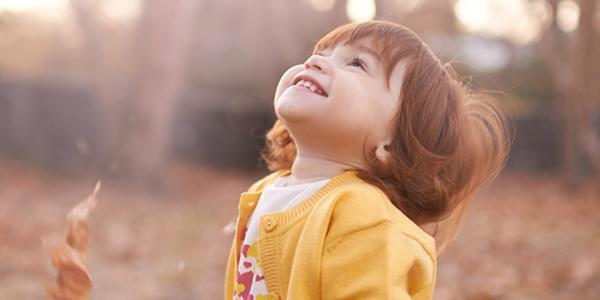
Every walk is an opportunity for children to learn about the natural world. Walking around the block with my child when he was one years old could take an hour because there was always something new to explore.
As you explore your neighborhood, yard, patio or the nature you find outside your window:
Be open to the wonder of noticing small details and new growth.
Keep the safer distance of 6 feet from others who are not in your household.
Leave electronic toys behind so children can focus on the world around them.
Bring paper and crayons so children can draw what they see if you bring your cell phone and need to take a call.
Bring a digital camera with you so children can take photos of things that interest them to share with [far off, distant] family members. And you can take other photos to print to create a scavenger hunt for children the next time you take the same walk.
Walk at different times of the day or night to increase your chances of seeing something new.
Ask, “What’s different about what you see today?” each time you and your child walk outside.
Play “I spy with my little eye” from your window and help children learn to give clues about what they spied.
Model using all five senses. You might say, “I’m seeing the big clouds,” “I’m touching the wet grass,” “I’m hearing the jets of an airplane,” or “I’m smelling the fallen pine tree needles.” It’s not safe to taste many things outdoors, but you can “taste” the air.
Carry along an inexpensive magnifying glass so children can get up close and personal with nature. Many smartphones have a magnifier app.
Make dressing for the weather part of the learning experience by singing songs about the weather as you and your child put on sunscreen, hats, or several layers of clothing. Try “You Are My Sunshine,” “It Ain’t Gonna Rain,” or “The Mitten Song”. Let your child work to figure out how to zip a zipper or put on boots just long enough so she can learn these tasks and not so long that she becomes frustrated.
Observe the weather
On the walk, or even as you look or step outside, use your magnifying glass to look closely at drops of rain hanging from a leaf or to examine the structure of snow. If it has recently rained, take a medicine dropper so your child can suck up rain from puddles and squirt it back out again. Watch where the water flows and ask, “I wonder where it will go from here?” If it is sunny, make shadows with your body or jump over the shadow of a family member. Use sidewalk chalk to draw the shapes of the clouds you see. Track the path of the sun as it appears to move across the sky—where is it in the morning and where is it at bedtime?
Animals
Use your magnifying glass to look closely at small wildlife such as non-poisonous spiders, roly-polies, worms, and any non-stinging insect that will hold still long enough. Ask your child to show you how the worm or ant moves, and join in as he wiggles or crawls. Ask your child to think about how well animals move even though their bodies are so different from our own.
Count the number of larger animals you see on your walk. Is the neighbor’s cat in the window again? Look for birds in bushes and on electric lines. Are there cows in the field, squirrels in the trees, or dogs going for a walk around the block? View birds on live “cams,” a virtual window into the natural world of birds Talk with your child about what these animals are doing.
Plants
Look closely at the different shapes, sizes, and structures of leaves and flowers (but watch out for thorns and poison ivy). Collect leaf shapes and then make rubbings of different types of leaves. To do this, put a piece of paper over a leaf resting on a hard surface, then rub or wipe the paper with a crayon held sideways to reveal the leaf’s veins and edges. Collect fallen leaves and seeds by pressing them into the sticky side of a loop of tape. Ask your child to measure how tall a plant is in relation to her body (“This bush is as tall as my knee”).
Observe changes in the life cycle of a plant. If a plant has a bud on it, ask your child to guess how many days it will take to open. Then count the days as you revisit the plant on your walks. If your children are old enough, have them record their findings in a notebook or with a digital camera.
Rocks
Use your magnifying glass to see the tiny shapes of crystals or pieces of sediment that make up the rocks in your neighborhood, including those that are used in buildings. If rocks are not part of the landscape where you usually walk, take a field trip to a local creek where you might see some naturally deposited rock. Compare sizes and colors. Try using them as chalk on other rocks or on your sidewalk.
Learn More
Check the website of your local library for access to electronic books that will help children learn more about animals, plants, and whatever else they observe. Children love to see the variety of caterpillars, birds, local mammals, and flowers in these identification books. Internet sites and apps are also great resources for identifying animals and more.
Books:
Nature’s Playground: Activities, Crafts, and Games to Encourage Children to Get Outdoors by Fiona Danks and Jo Schofield.
Take a Walk book series by Jane Kirkland includes books for elementary-age children that discuss different environments (beach, city, wetlands) and different things to observe (birds, butterflies clouds).
Bugs Are Insects by Anne Rockwell. For children kindergarten to second grade.
Seashells, Crabs, and Sea Stars by Christiane Kump Tibbitts. For children kindergarten to fourth grade.
Winter Trees by Carole Gerber. For children kindergarten to second grade.
Leaf Man by Lois Ehlert. For children ages 4 and up.
Nature Close-Up: Seeds and Seedlings by Elaine Pascoe. For children from kindergarten to eighth grade.
Websites:
California Academy of Sciences and National Geographic Society, seek by iNaturalist. https://www.inaturalist.org/pages/seek_app and teachers’ guide, https://www.inaturalist.org/pages/teacher's+guide
Cornell Lab of Ornithology, All About Birds, Bird Guide, https://www.allaboutbirds.org/guide/, and bird cams, https://www.allaboutbirds.org/cams/
Little Pine Learners, Easy nature “weaving” craft. (Wrap with string or yarn if you don’t have rubber bands.) https://littlepinelearners.com/a-simple-and-beautiful-nature-craft-to-tr...
A pre-K teacher offers ideas to integrate nature learning into the curriculum on her website, Thinking BIG, Learning Big.
Books that Inspire Nature Play and Observations
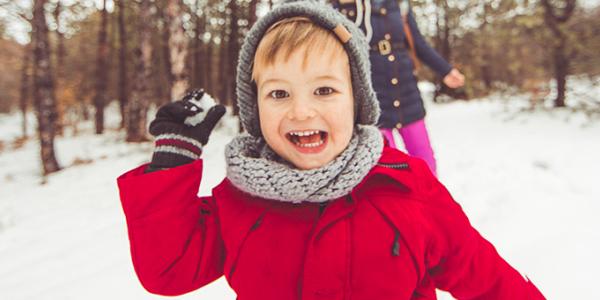
Do you want your child to love nature and care about the environment? Whether you live in an urban, suburban, or rural setting, these books and ideas will inspire you and your child to observe nature.
(Note: Many of these books can be purchased as a hardcover, paperback, or board book.)
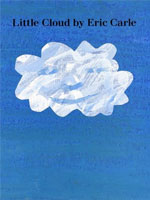
Little Cloud, by Eric Carle. 2001.
Little Cloud drifts away from his friends and turns into a lamb, a rabbit, a clown’s hat, and then a clown before joining a large rain cloud. Your child will enjoy guessing which shape the cloud will turn into next. A simple story that encourages children to lie on their backs and look at the clouds.
Available in English. Can be purchased as a hardcover, paperback, and board book.
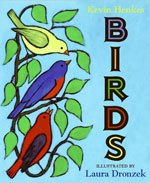
Birds, by Kevin Henkes.
Illus. by Laura Dronzek. 2009.
A young girl wonders about the birds she sees and hears outside her window. What might the sky look like if birds made colors with their tails? Where did the seven birds that were just on the telephone wire fly? A mix of facts about birds with illustrations and prose that will awaken the imagination.
Available in English. Can be purchased as a hardcover and paperback.
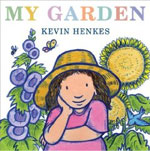
My Garden, by Kevin Henkes. 2010.
A girl gardens with her mother but in her mind,seashells and chocolate rabbits are growing in the ground. The book alternates pictures of the mother’s garden with pictures of the garden of her imagination.
Available in English. Can be purchased as a hardcover and paperback.
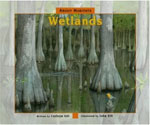
About Habitats: Wetlands, by Cathryn Sill.
Illus. by John Sill. 2008.
This book uses beautiful illustrations and words to show the types of plants and animals that live in wetlands. The author describes why these habitats are important. Also in this series: About Habitats: Deserts and About Habitats: Mountains.
Available in English. Can be purchased as a hardcover and paperback.
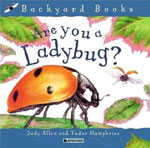
Are You a Ladybug? by Judy Allen and Tudor Humphries. 2003.
This book, part of the Backyard Books series, begins, “Are you a ladybug? If you are, your parents look like this, and they eat aphids.” The storytelling and watercolor illustrations will engage your child in learning about these fascinating creatures. Also from the Backyard Books series: Are You a Butterfly?, Are You an Ant?, and Are You a Spider?
Available in English. Can be purchased as a hardcover and paperback.
Engaging Toddlers in Nature Play

Your child is watching your every move and picking up cues based on how you interact with nature. If your aim is to instill respect and love for all things wild, try these simple activities with children ages three months to two years old:
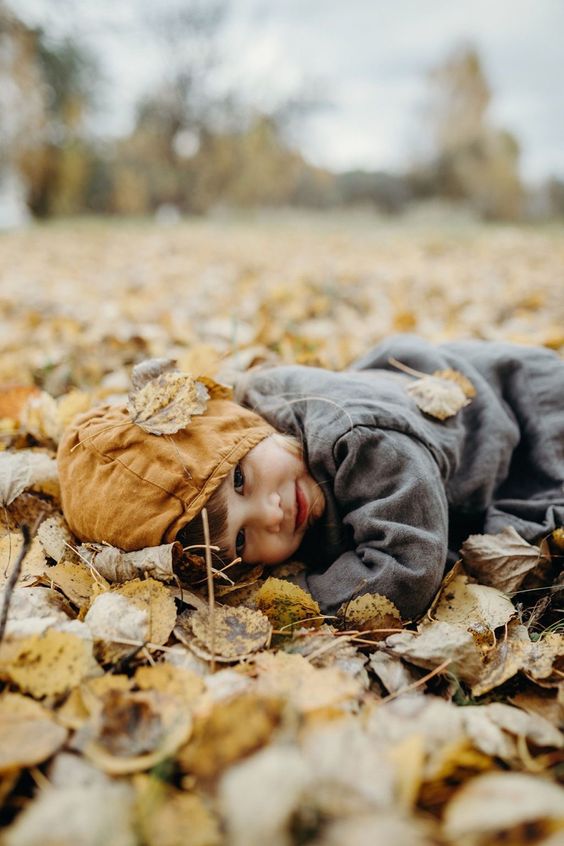
Let baby crinkle dry leaves on the ground. Crunch the leaves with baby as he enjoys the sound.
Visit shrubs and trees to allow baby to touch and grab at the green leaves. Smell the leaves with baby.
Invite baby to grab and feel soil with hands and toes.
Quietly watch birds fly overhead and squirrels pitter patter.
Listen to bird sounds and mimic them for baby: “teacher-teacher-teacher”, “peter-peter-peter”, or “caw caw”!
Visit nearby flowers. Gently touch and smell the flowers. Say color names to baby and describe how the petals or leaves feel.
Pick up twigs and seeds for baby to manipulate. Try tossing helicopter seeds to watch them spin.
Blow bubbles in the wind. Listen to the sounds of the bubbles pop on blades of grass.
Make sounds with what you find outside. Try tapping acorns, walnuts, or twigs together and invite baby to join in.
Touch tree bark and describe how it feels to baby (rough, smooth, bumpy, scratchy).
Pick up a worm, cricket, or ant and show baby how it moves in your hand. If baby is welcoming, let the tiny animal crawl in baby’s hand.
Stand your barefoot baby on soft grass or moss. Encourage baby to touch the grass or moss with fingers, too.
Play in a puddle. Stir up water with twigs, dip fingers or toes in, or float leaves in the water.
Your curious child will develop positive feelings about nature through happy, sensory associations of nature play with you. As you explore together, you are making more than memories; you are nurturing baby’s lifelong love of nature!
Common Sense Notes about Nature Play
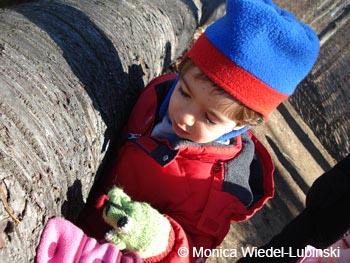
Always supervise your child! Never leave her unattended outdoors and watch closely whenever she is holding small objects. Never allow her to taste any leaves, and do not allow her to play in soil or grass where pesticides or other chemicals may have been applied.
Where Can We Explore Nature? Everywhere!

When we imagine nature, we often think about our own part of the country. Nature is everywhere. Here are some ideas for wherever you might live, whatever the season.
At the beach:
Dig down into the sand to find the water level. Look for small creatures while you dig. Look for changes in the color and texture of the sand, and observe the size of the sand granules. Notice the colors in shells. Look for bird and crab tracks.
In the desert:
Look for animal tracks, flowers after spring rains, and water sources. If possible, compare the dry desert to the desert after the rain.
In the woods-
Build a Mini Den for an animal.
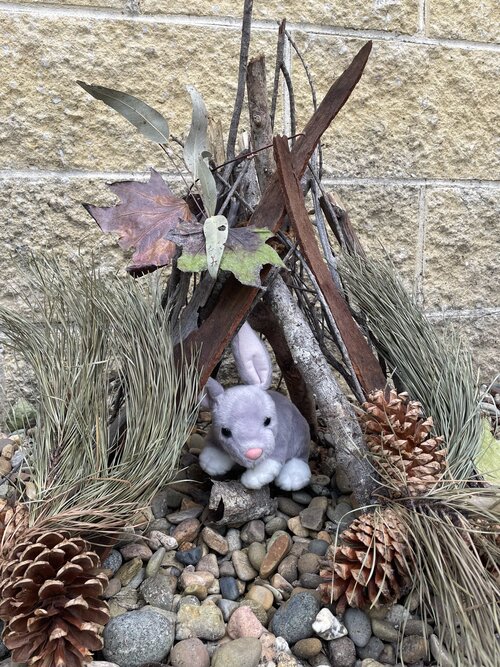
Take the time to show your tot that every tree has animals that live in it. And that every animal needs a home. Then find 3 or 5 quite sturdy sticks from the ground or natural element and lean them towards each other to make a simple tri-pod or tee pee shape. Use some string to tie the tops of the sticks. Add some lighter twiggy, leafy sticks around the outside of the structure to form the walls. Leave one section clear for the entrance like in the photo above.
In the snow:
Dress appropriately in layers, and then make snow people and snow horses. Pretend to ride the snow horse. Make a snow fort.
In your backyard:
Plant a garden and observe the flowers and vegetables as they grow. Watch for visitors, such as birds, insects, toads, lizards, squirrels, rabbits, or deer.
In a vacant lot:
Look for weeds, seeds, and evidence of animal life like:
Scat (the technical name used by naturalists for animal droppings)
Animal tracks
Feathers
Wood that an animal has gnawed (such as a tree that has marks from a beaver’s teeth)
Holes in the ground (from a dog, a squirrel, a mole, or an armadillo)
Holes in the trees (from a woodpecker or insects)
Near a pond’s edge:
Watch for birds and dragonflies taking off and landing or for frogs jumping in the pond. Bring a little net to dip in the water, and ask your child to share her discoveries with you. Even if you don’t know what the creatures are, you can discuss what you see (legs or no legs, scales or no scales, antennae or other body parts, wing colors) and what you hear (fish splashing, insects buzzing, frogs calling).
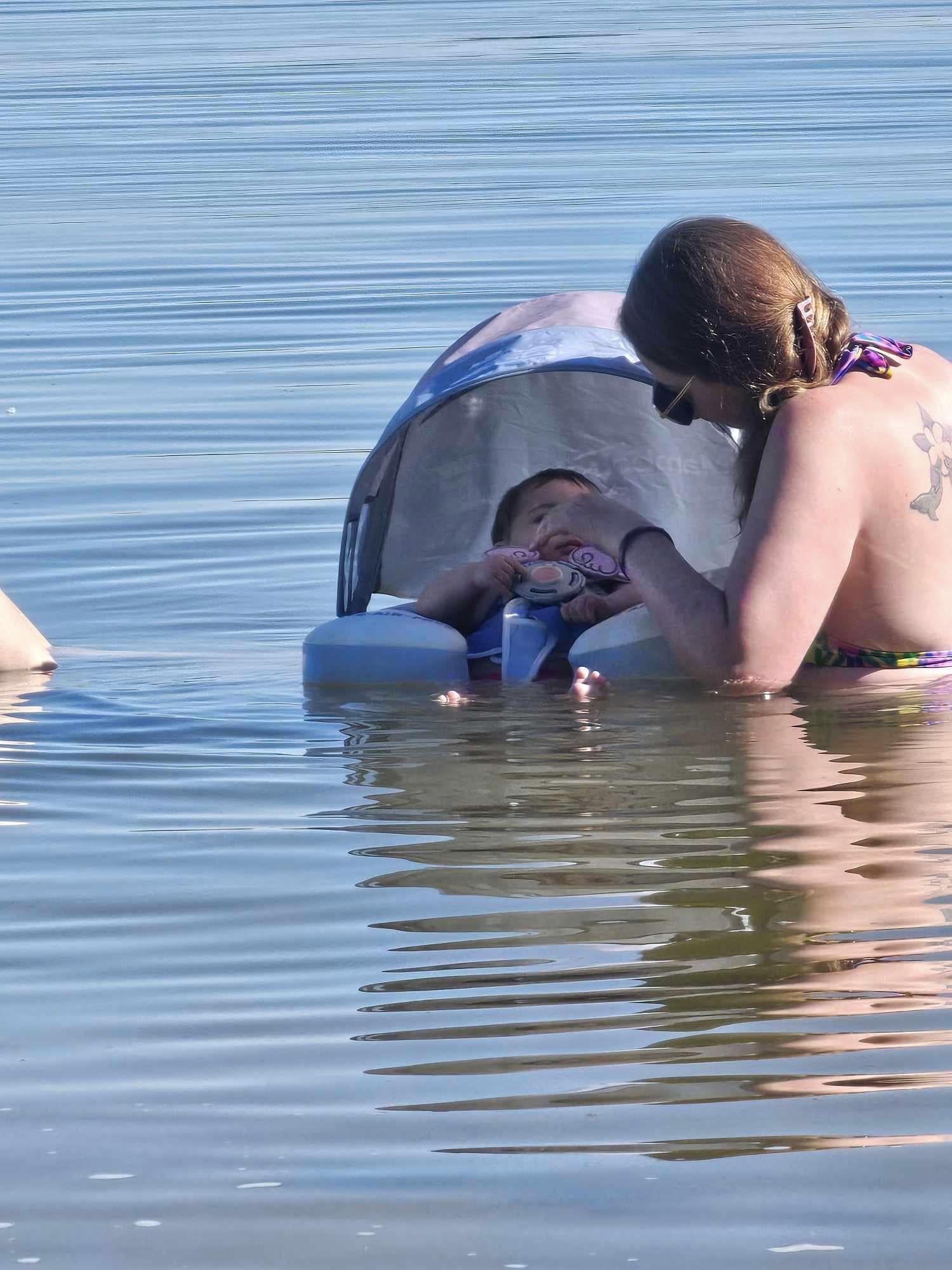
Superscript
Ways to Bring Nature Inside
Let them help be a part of the whole process of collecting and assembling and then investigating nature inside your home.
Nature Sensory Bottles
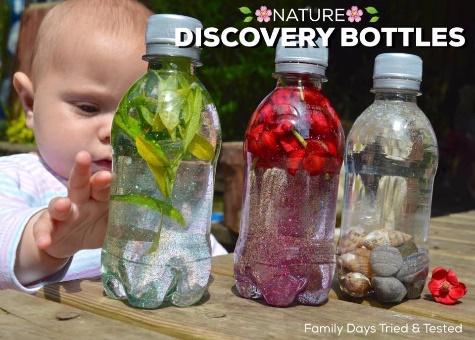
These were a real treat in our house. Simply choose which sense you’re going to activate and fill small clear jars with either flowers (sight), herbs (smell), grains (hearing) or anything that will surprise your little one! I used empty spice jars or plastic jars from Dollar Tree. The grains were a big hit as they made lovely gentle sounds, which she preferred over loud, synthetic commercial ones. I used smaller spice jars when the kids were babies. Fill bottles with water and your natural treasures and tighten the cap securely.
Simply trim the stem off a few flowers as tight as you can to the bud then run them through the laminator (or press them in a heavy book for a few days then use clear contact paper folded over the flowers. I cut all my sheets to the same size to make it easier for children to sort through. She really enjoyed studying each little bud and leaf.
The girls made theirs into a suncatcher garland& loved exploring the flowers with magnifying glasses and comparing the flowers and leaves. Beautiful right? I love spring crafts because they bring so much color into the house!
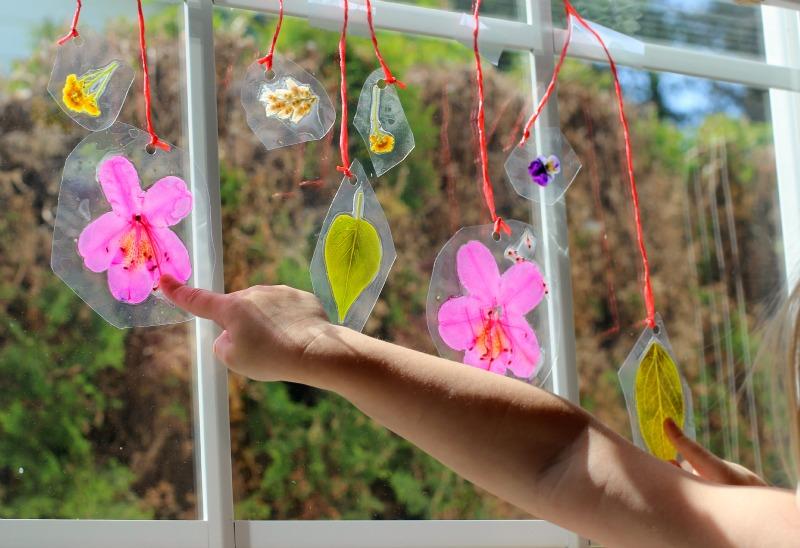
Baby Nature Blocks
Hope was a happy baby who loves simple games like that (as do most babies. Blinking lights and flashy toys are really not necessary!)
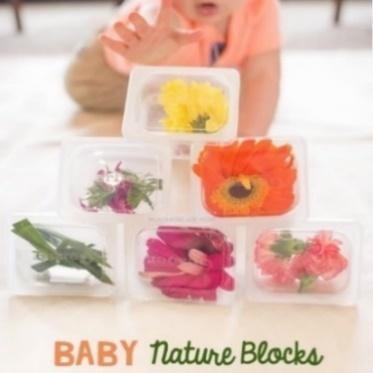
But sometimes mama just wants to get crafty and make a new toy for baby. I did that today with a grocery store bouquet of flowers and some upcycled baby food containers!
How to Make Baby Nature Blocks
First off, this is going to be the easiest toy to make! I barely need to make a “how to” section on this post. But I know how much some of you like details, so here goes:
Supplies:
Flowers (I used a grocery store bouquet) or other nature
Baby food containers (Gerber’s plastic ones work well)
After the food containers were empty and had been washed, I just placed a few flowers and leaves inside of them and snapped the lid back on. That’s it. The hardest part of this whole activity is having flowers on hand.
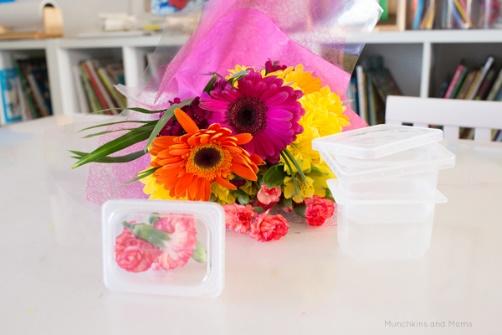
The next step was introducing them to baby. He was soooo happy! He knocked over every tower I made, threw them across his mat, investigated them from all angles, banged them together, etc.
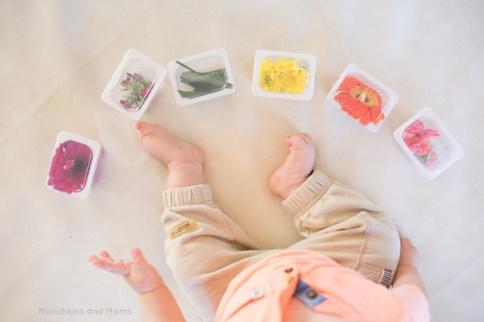
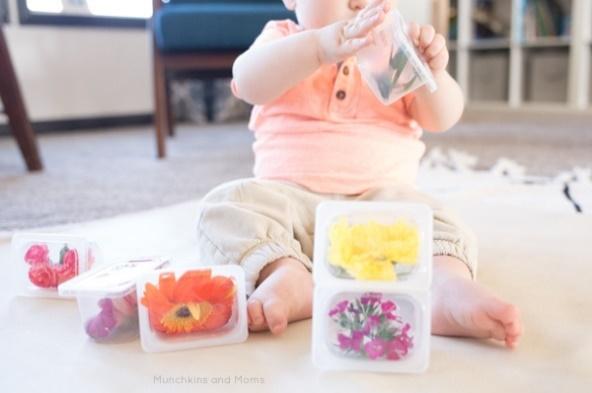
These blocks are so inviting! The way the light shone through them, the vibrant colors of the flowers, and the way the petals gently swished as he shook them made them extra intriguing for our little guy <3
I know some of you will ask how long these blocks keep for. The truth is I don’t know. We just made them yesterday, so I’ll test them out and update you all later.
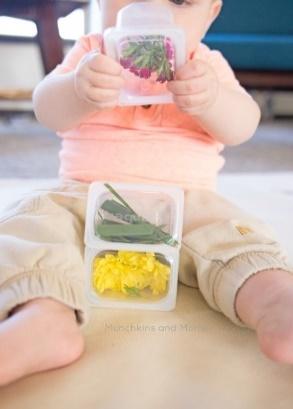
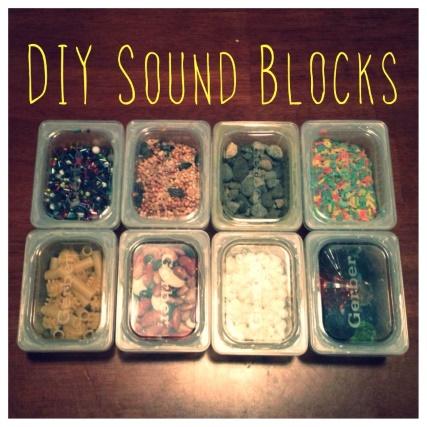
Sound blocks can be made with the same process. The eight sound blocks I made were filled with nature, rice, beans, pasta, birdseed, shells, pea gravel, beads, and colored gems. You could use any materials you have on hand though that you feel would make a neat noise when shaken. I think next I’d like to make one with bells inside!
Nature Sticky Mural
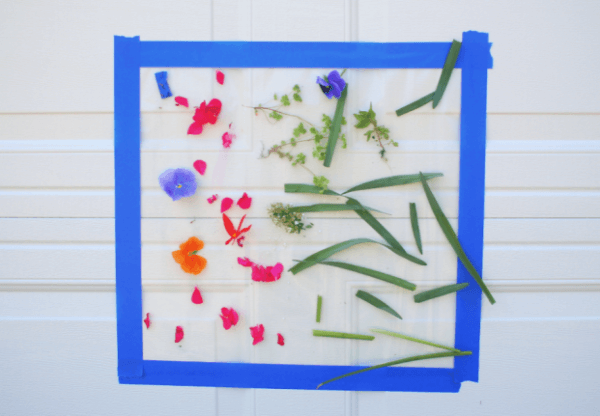
Nature is art, and you can also create your own custom art with elements from nature! I can Teach my Child has a lovely idea for an outdoor mural where toddlers can stick leaves, petals and whole flowers in any pattern of their choice. You’ll need contact paper for this activity, which you can stick to a wall or solid gate outside. Hand the children the materials and let them create art!
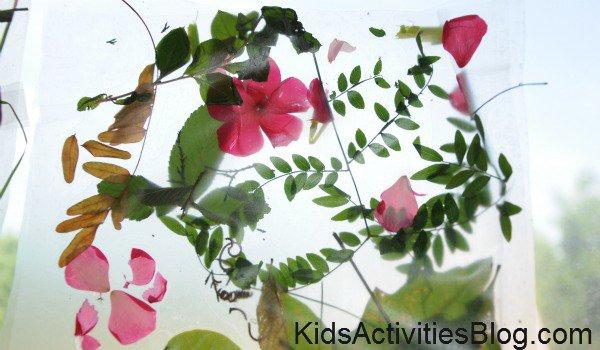
Collages are among the easiest craft projects for toddlers and preschoolers, and this one from Kids Activities Blog is no different! However, what’s special here is that you use only natural elements to make the collage! They have used contact paper to make the collage do double duty as a sun catcher, but you can just use a sheet of thick paper or card stock as well. Use fresh flowers or dried ones – they’ll all look pretty!
Nature Sensory Bag
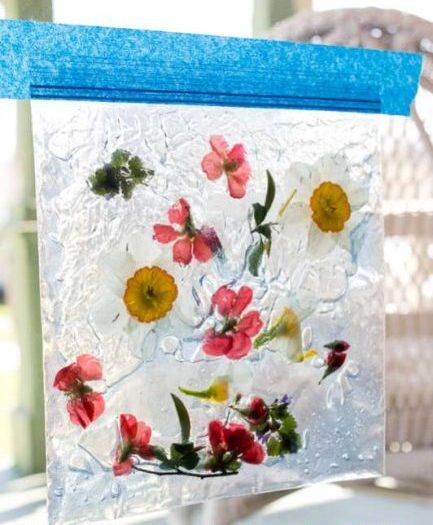
Sensory bags are a great way for babies to explore and learn to focus their attention. This sensory bag from Hands On as We Grow also doubles as a sun catcher – just stick it on window! Gather the materials by doing a scavenger hunt or a nature walk and use double bags especially if you’re dealing with over-excited toddlers or babies! You can focus on using different textures here, so it’s more fun to squish and move around!
Scent Jars
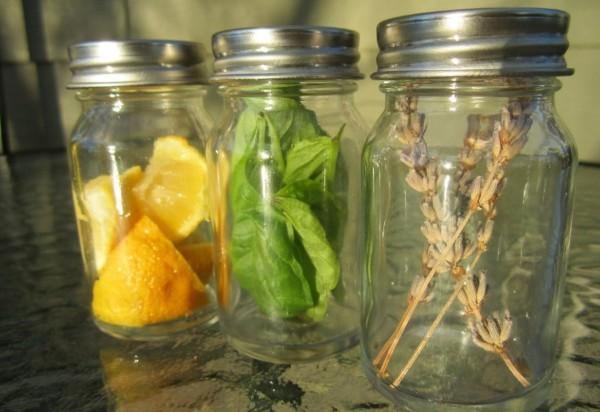
This is an excellent sensory activity for toddlers and preschoolers and helps them learn about different scents. Mamas Happy Hive has used lavender, lemon and basil, but you can use any scent of your choice. Just use clean, dry glass jars, add a piece of lime or a spring of lavender along with the associated essential oil. Hand the jars to your child and let him sniff and guess!

Sensory bottles are a great option for babies and toddlers, and we love this one from Rhythms of Play! The best part is that you can make it with things lying in and around your house. Get a transparent plastic bottle so kids can see all the components even while they’re shaking and playing with their rainstick. With the rains coming soon, let them get used to the sound of falling raindrops!
Nature Soup
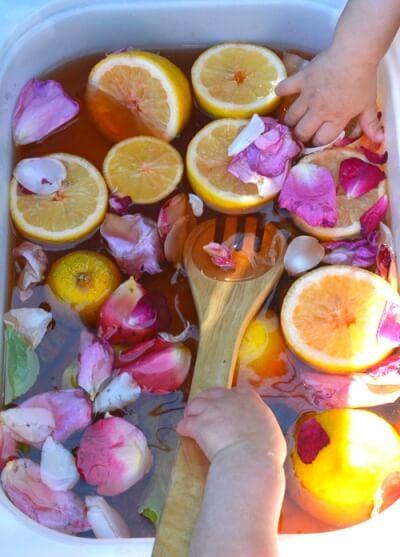
Who doesn’t love water play? We bet your little one does and that’s why she’ll love this nature soup activity from Meri Cherry! This is basically a water based sensory activity, where you create a ‘soup’ with all kinds of elements – lemons, leaves, flowers, twigs and more! Put it all into a large plastic tub with colored water, and then hand them utensils and brushes to swish everything through. Let them stir, sieve and pour to their heart’s content!
Tying Wild flower or herb bouquet
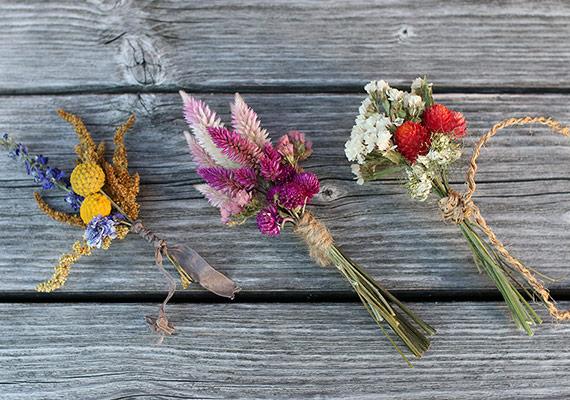
Preserving herbs and Flowers from your walks and adventures.
Hand drying, the oldest method, is also the easiest and most effective method for drying anything: leaves, flowers or herbs. Hang drying is also good for drying large quantities. You can tie and hang dry flowers in a closet, attic, dry cellar, garage, outdoor shed, or anywhere that is dry, warm and out of strong sunlight. Use for wall hangings from a stick or small branch or display in a vase.
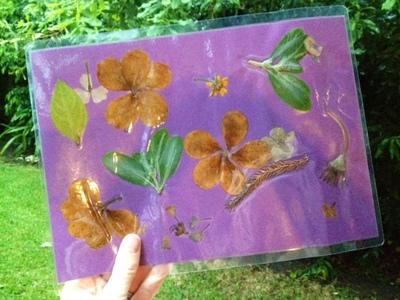
Make placemats to spread your love of nature
It could become an ideal gift for any occasion. Older children will manage this easily on their own but younger children will need help from an adult with the lamination process. It takes a week or so to dry the flowers, so you'll also need to plan to set them aside and be patient.
Simple Nature Exploration Station

Okay, so this is quite possibly the simplest activity ever, but it was thoroughly enjoyed and I was blown away with what Miss G did with it. Earlier today, as Grae was cleaning up from quiet play time, I quickly popped outside to the yard to see what sort of spring nature items I could… Read More
Fall Nature I Spy Bottle
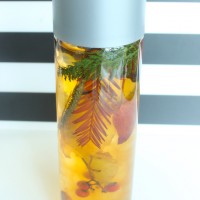
Ahhh…. Autumn. It’s something we haven’t experienced in the last couple of years, and though I certainly would mind being poolside soaking up Kuwait’s 40 degree heat currently, I’m loving seeing all of the beautiful fall colours pop up early around Vancouver this year. Of course, Gracen {my little collector of sticks, rocks, and all… Read More
Winter Nature Sensory Soup
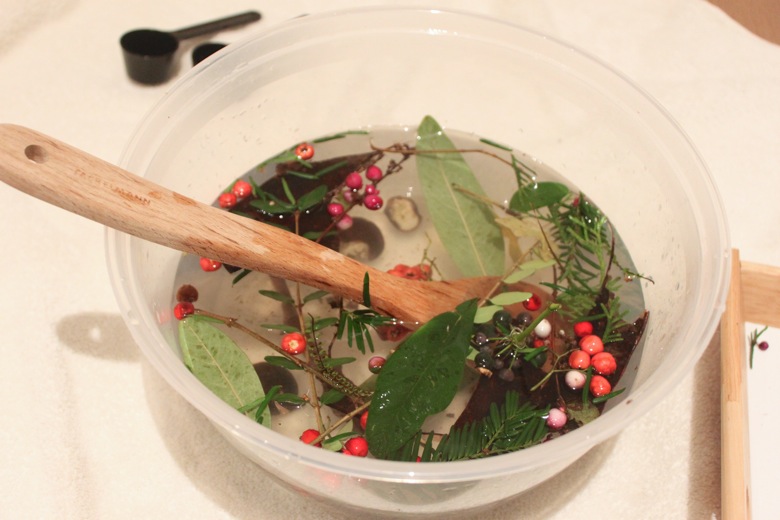
Today, while out touring around Heidelberg, Miss G and I kept our eyes peeled for pretty winter nature items. As we came across different things, we added them to reusable bag and then continued along our way. Just the fact that things like evergreen branches and winter berries can be found here is a huge… Read More
{Muffin Tin} Spring Nature Hunt For Toddlers
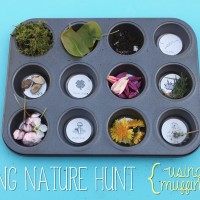
In honour of Earth Day, Miss G and I took to the streets of our neighbourhood for a little spring-themed natured hunt today. It was the perfect way to spend our afternoon…soaking in some sunshine, taking in the fresh air, and observing the nature around us a little more closely than we usually do. Beforehand,… Read More
Christmas Nature Wreath (Toddler)

For the last few days, Gracen’s been working on these sweet little nature wreaths at her creative table. It started out as a very simple painting station with a few cardboard o’s and some paint in different shades of green. When the paint was dry, I added a few other things into the mix… Glue,… Read More
Winter Nature Shelf (Toddler)
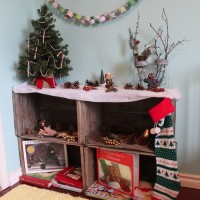
Today Gracen’s autumn nature shelf got a much needed makeover… Gone are the crunchy leaves, dried out sunflowers, mini pumpkins, new apples, and shedding cattails… And in are the bare branches, pinecones, evergreen limbs, and dried red berries. If we’re striving for accuracy, the title ‘Christmas shelf’ would probably be more appropriate at this point,… Read More
Autumn Nature Shelf (Toddler)
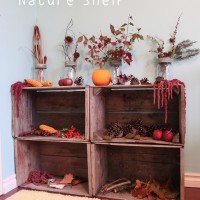
Over the course of the last week, Gracen has been very into collecting “autumn sings (things)”. At first, I thought we’d use the items to make a couple of art projects and a sensory bin (which we did), but the collection grew so quickly and became so diverse that I decided a special area to… Read More
Superscript
Hands-On Adventures for Exploration & Discovery
Getting wet and dirty is part of learning about the lake environment, too. If my children are within reaching-distance of water—any water—they are sure to get wet! It doesn’t matter the temperature or what they’re wearing. If we are going near water, I just plan on them getting soaked.
Let Your Baby Explore
When you take a baby to the lake or a river, you have to let them explore everything in nature. While the water should be the central focal point and goal of the adventure, there are many opportunities to familiarize your baby with nature before you get there.
Letting the baby feel pinecones, acorns, tree bark, leaves, and smooth river rocks are all part of the experience. Since babies are not cognizant about what they are feeling and unable to articulate it into words or ideas, they function at a more sensory level.
The fragrant smell of cedar firewood, the hickory of a barbeque, and the fragrance of flowers can all be a treat to your baby’s senses. And they will also enjoy the sounds of the rushing waters, the birds chirping, and other critters.
So, if the lake you are visiting is wading accessible, wear some water-appropriate clothes and footwear. Bring some buckets, a net, a magnifying glass, and explore a lake with kids up close if they have older babies!
What do you need to pack for a successful family day trip to the lake?
Here are the essentials, with a few tips for where to buy them (or download the printable below).
Swimsuits & rash guards
Dry change of clothes
Towels
Sunscreen
Sunglasses
Hats
Coast-guard certified life jackets (we like the Puddle Jumper for swimming but a traditional toddler life jacket with a head up float feature may be safer for boating)
Swim goggles or masks
Floats, inner tubes, & noodles
Sand toys
Snacks & food
Camera
Swim diapers (for babies & toddlers)
Bug spray
Drinks (especially bottled water)
Cooler & ice
Paper towels
Wipes
Trash bags
First aid kit
Ziploc bags (put dry items in them to protect against splashes!)
Swiss army knife
Flip flops and/or water shoes
Flashlight & batteries (this floating waterproof flashlight is an inexpensive choice)
Fishing supplies & license
Cell phone waterproof sleeve (we swear by this one for our iPhones, even while taking photos underwater!)
Cooking utensils or supplies if needed (plates, serving spoons, knife, cutting board, grill and related supplies like matches, charcoal/propane, tongs, aluminum foil)
Exploring for Wildlife
We love being outside not just because of nature’s splendor and beauty. But to get to be outside AND connect or even help animals, that’s just a win, win. They get something they need, and we have the satisfaction of doing something for them. The boys really enjoyed animal encounters that were not created for a commercial benefit. If nature bought an opportunity to them, they welcomed it. They took care of the wildlife enthusiastically until the animal was able to scamper or fly off on it’s own.
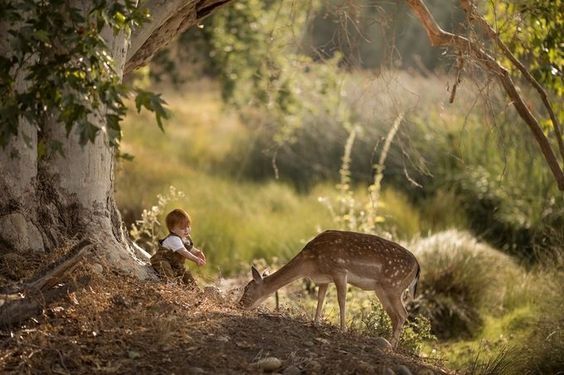
Our favorite place to encounter wildlife was in our backyard (it butted up to the edge of huge forest. Rocky Mountain National Park, Lone Duck Campground & Garden of the God’s and at the top of their list Vedauwoo Recreation Area -in Wyoming. The boys would spontaneously make the wildlife happy with a rescue, food, water, or anything they could think of to make the animals day. Then they went on with their exploring. Deer, elk, squirrels, rabbits, racoons, wolves, bears, mountain lions passed through our yard, so they were very versed in which ones were dangerous to get too close with.
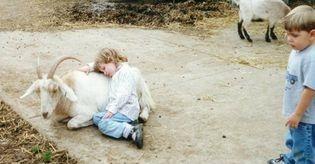
Hope and Brandon at Lollipop Farm
Hope on the other hand preferred long periods of time with animals and to make sure that felt loved. When she was little, little she noticed that not all wildlife has a mommy to take care of them. She was so upset that she cried. Then spent her entire childhood trying to make up for that. She wanted to love on every animal she would meet. I would panic a little at times. She would say “I Fine” or “He’s happy now” to calm me. It’s almost like she could feel their burdens or what they needed.
Her ability to connect with animals was astonishing. At 18 months, she lovingly cared for and invested time with an elk that she called Grandpa (They played with her big ball and Hope rewarded him with a snack), a horse named Liberty or Libby, other farm animals (including Llamas and ostriches) and the wildlife in Mt. Falcon daily, and sponsored a sick dwarf donkey at Lollipop Pop Farm in New York. Plus, all our family pets to take care of. And she had a rescued a beautiful Arabian horse when she was a tween, that she took care of. They were so cute together. She loved to brush her horse because it relaxed her horse and herself at the same time.
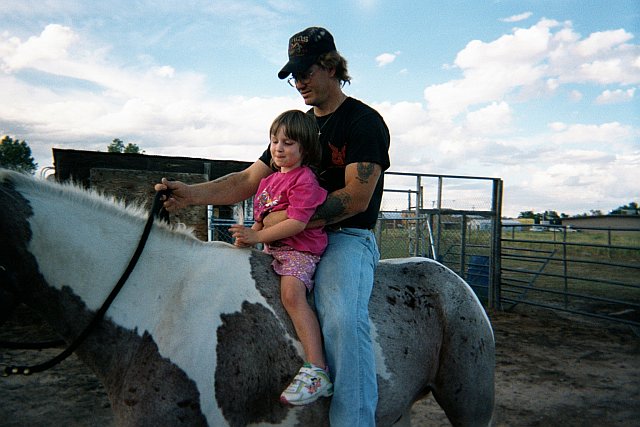
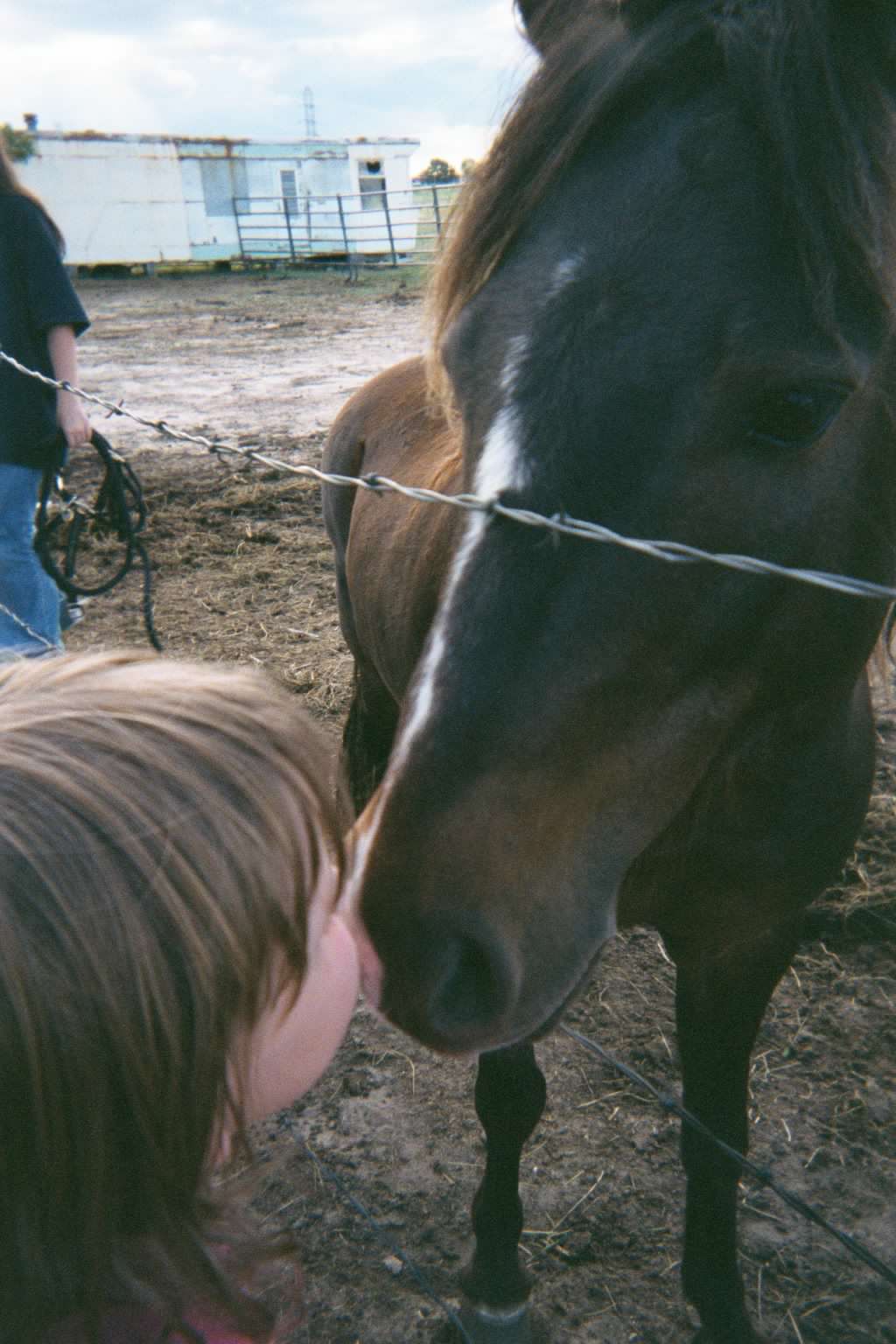
Humans and animals have always coexisted throughout millennia and our relationship with them is not something new. Although human–animal encounters are an important factor for some visitors, the encounters should be encouraged in the most natural manner possible and not in captivity.
The tourism industry has become a theater for human–animal encounters by designing and offering “new sensory experiences” with animals. Tourists are willing to travel long distances to pay to see animals in their natural habitat. In fact, the observation of wildlife is believed to be one of the main reasons for visiting those areas. And I have to admit, it is my primary objective in my plans for both day trips and vacations.
Several recreation studies show that visitors who were attracted to the park to explore the habitat (take pictures, visit a specific area, hike the trails etc.) or to see popular and big animals make time for longer encounters with wildlife. Plus, they were more twice as likely to return to the park for another chance to see the large native animals. We were like that with Denver Zoo, Brevard Zoo and Forever Florida. We had a annual pass to Seaworld in Orlando as well.
So, our lives were constantly enriched by the animal world.
There are so many wonderful opportunities to be outside and explore nature with children.
Nature walks and explorations are an ideal way to spend fun quality time together as a family and to help your children develop an appreciation for the earth, birds, mini-beasts, plants and everything else in the natural world.
Fun at the petting zoo
A trip to the petting zoo is all about “back to nature” in a child-friendly way: putting on boots, standing in the mud, smelling animals, hearing strange noises… Your baby simply loves it! How children enjoy a petting zoo depends on their age. A young baby will especially enjoy the different impressions. An already older baby will enjoy seeing the different types of animals and will stand breathlessly fixed to a spot watching the chickens milling about. Pre-toddlers love to pet guinea pigs and toddle along from one pen to the next. Toddlers will gladly lend a helping hand to the farmer – collecting eggs and frolicking with the lambs. In short: there is something for everyone at the petting zoo.
5 Great ways to Explore and Learn About Wildlife with Your Kids
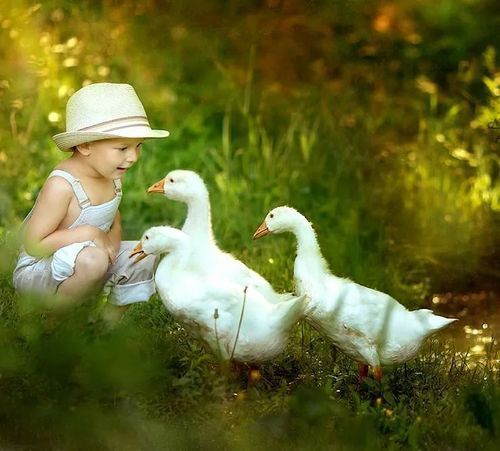
There are so many great reasons to explore wildlife with kids. As well as educating children about the behavior and biology of wild animals, it’s an easy way to encourage them to have love and compassion for other creatures.
In addition, many studies have shown that every aspect of the health and wellness of a child improves with exposure to the natural world. And of course, kids love to get hands-on with nature and wildlife, so it’s easy to see why wildlife activities for kids are so popular.
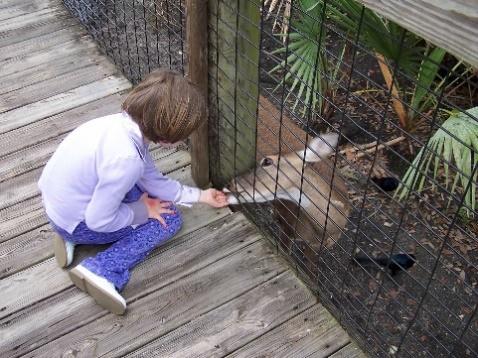
Ready to explore nature and wildlife with the kids? Here are five great ways to introduce children to the wonderful world of wildlife, and how they can respect and take care of it.
SCHEDULE IN TIME TO CONNECT WITH WILDLIFE ON YOUR VACATIONS
When planning your next family trip, consider skipping the amusement parks and beaches and heading to a family-oriented wildlife destination instead. Choose a place that offers enough opportunities to learn the dangers that animals face in the wild, and that also allows children to learn how humans can help conserve and protect their habitat.
The Sepilok Nature Reserve in Borneo is a prime example. The sanctuary is covered with dense forests and is rich in wildlife. In fact, it’s one of the few places where you can find orangutans, elephants, and rhinos in one area. Here children can get a chance to play with baby apes or go on a special adventure with their parents to view exotic species like the Sunday flying lemurs and gliding frogs. You can book wildlife experiences like this on sites such as Naturetrek.
You can even take the kids on a truly adventurous wildlife safari. Countries like South Africa, Kenya and India offer plenty of amazing safari options.
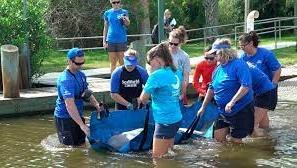
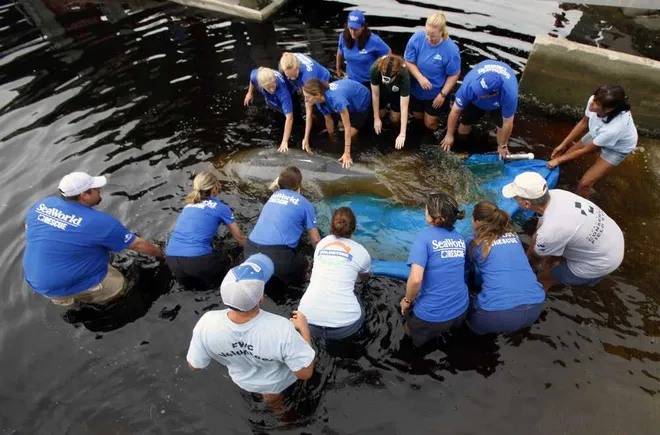
The return of our rescued manatee-Mosquito Lagoon & Rescue Care center workers
VISIT AN ANIMAL RESCUE CENTER
Our children are going to be the future ambassadors for animal conservation, so it’s important to teach them about their wellbeing. The best way to start is by taking the kids to an animal welfare center for mistreated or abandoned animals. This will help children to understand why animals are important to mankind and learn about caring for them in a loving and humane manner.
A trip to an animal welfare center is also a simple way to give children access to wildlife that they may not otherwise come into contact with.
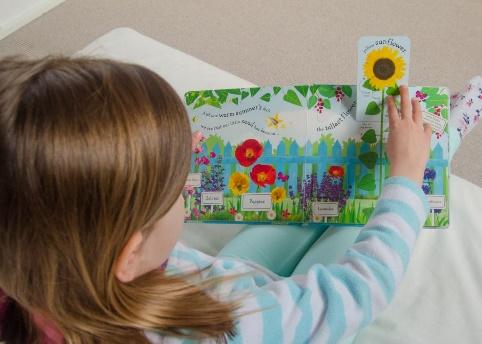
USE BOOKS AND SCREENS TO EXPLORE WILDLIFE WITH KIDS
It’s never too soon to explore wildlife with kids. Start with simple things like pointing out animals in movies or TV shows, or when you’re out and about. Tell them the names of the animals and explain what makes them so unique. This could be the sounds the animal makes, where it comes from, or what it eats.
Once your child is a little older, you can increase their knowledge about the world of wild animals through books. Fiction and non-fiction both work well here. An ultimate classic like Black Beauty, for example, will show them how to appreciate and love horses, and by association, other animals. A non-fiction nature play activity book is also a great way to help kids learn about and care for wildlife. The internet is a useful resource too. Sites like National Geographic Kids are bursting with documentaries on wild animals which are sure to keep the kids mesmerized.
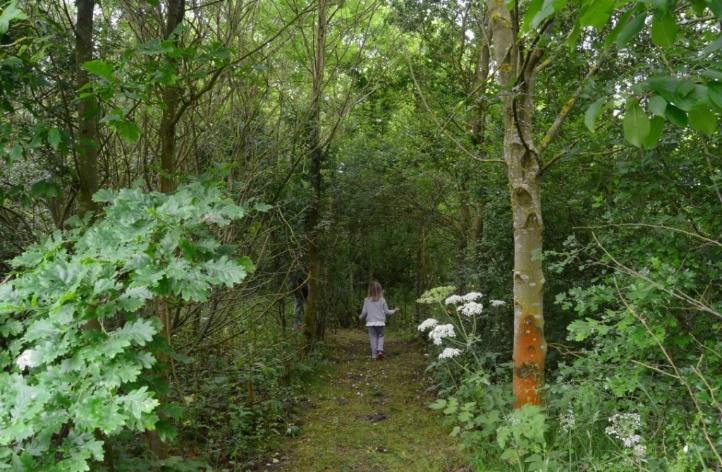
TAKE THE KIDS ON A NATURE WALK
As well as using books and visuals to teach kids about wildlife, you should definitely try to experience nature from up close. A nature walk is a simple, low-cost and accessible way to do this, and it’s a great way to burn off some energy and instill a sense of calm too.
You could visit a local park or nature reserve, hike up a hill, or stroll along a lake or river. Ask your children to bring along a book and use it to identify the animals they see, or download a free printable nature scavenger hunt. During the walk, encourage children to look out for wildlife. In my experience, nature always stimulates kids to ask lots of questions, so be prepared to do some thinking yourself! You might need to look some things up when you get home too.
Once the walk has ended, it’s nice if everyone reflects on what they saw and liked the most. This is a good prompt to get kids using their language skills, and also a fun way to find inspiration for your next wildlife adventure.
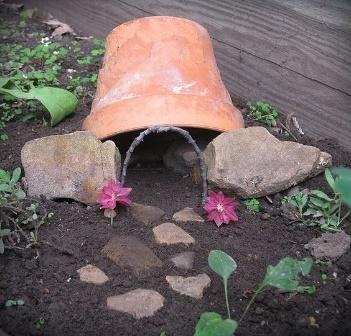
HANDS-ON ACTIVITIES FOR TODDLERS
Wildlife-themed activities are a great hands-on way to explore wildlife with kids. Here are a few fun ideas.
Study animal tracks. Show kids pictures of different animal tracks and talk about the animal that made them. Or head outside and see what tracks you can find. You could take spotter cards with you or take a photo of the tracks and look them up when you get home. A snowy day is a great time to do this as it makes it easier to spot and follow tracks, but a muddy field works well too!
Encourage children to garden for wildlife. Discuss what animals and insects visit your garden, and why. This is a great opportunity to talk about how our gardens provide a source of food for wildlife, and also to explore the concept of pollination. You might like to extend this activity by making homemade bird feeders, or installing a bird bath.
When you’re out with the kids at night, ask them to listen carefully for sounds of wild animals. This could be a chirping grasshopper, a hooting owl, or a hedgehog shuffling in the undergrowth. Note down the names of the different animals you hear and have a go at spotting them by flashlight light.
Have fun with storytelling. One of the simplest ways to captivate children about wildlife is to tell stories. Add in an outdoor setting and a campfire, and things get really exciting! You could make up a wildlife story about the animals where you live, read their favorite animal book, play wildlife-themed games, or sing some favorite songs about animals.
By helping children engage with wildlife, we can give them the opportunity to develop their understanding of and empathy with nature. As well as being a fun family activity, it’s a brilliant way to make sure that future generations do their bit to take care of our planet’s amazing wildlife.
What’s your favorite way to explore wildlife with kids?
Spending time outdoors and in nature is good for both the body and the mind. Some of our favorite activities such as walking, hiking, and biking are done outdoors and it’s a great space for unstructured creative play. Interacting with nature provides opportunities for discovery and creative thinking and supports social-emotional growth and development. Build the outdoors into your day to day – whether opting to play outside or bringing nature to you with arts and crafts.
Tips
Exploring nature together is a great way to spend time as a family, too. Older kids and younger kids can work together or can explore more independently or using age-appropriate activities.
Remember to model respect for nature and helping to instill that respect in others. Discuss responsible collecting and make sure you’re in an area where it’s permitted. Clean up any trash and be mindful of animals in their natural home.
Don’t be afraid to get dirty! Sometimes a little play with dirt, water, sand, and mud is all that’s needed. Explore different senses such as the feeling of grass under your feet, the sound of leaves crunching, or the smell after a fresh rainstorm.
Take Action
Get creative when exploring the great outdoors and use your imagination to turn the things around you just out your door, into something you take pride in protecting and helping (when needed).
ADDITIONAL RESEARCH ON BENEFITS OF TIME IN NATURE: childrenandnature.org/research.
Quest: Make a Nature Book with Photographs
Summer! My favorite time of year! It’s also that time of the year where the excitement only lasts for so long. We love being out in the sun (yes even in the summer) and one of our favorite things to do is to hike or go on nature walks!
A nature walk can be as simple as just walking around and looking at or picking up whatever the kids find interesting! You can make up stories, talk about what they found or just let them lead the way!
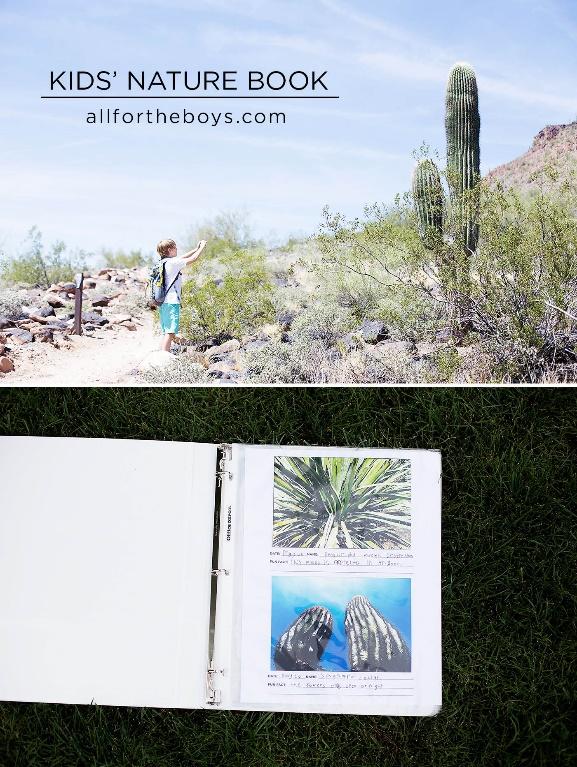
To make your own nature photo book:
Visit places with lots of animals. A zoo, aquarium, farm or wildlife rescue center are good places to start. Don’t worry about trying to capture all your images at once; it’s more fun to continue the project by visiting several different places.
Add pictures of backyard and neighborhood critters. Our animal photo book includes several backyard birds and insects. We also added animals we saw during our nature travels.
After selecting your photos, print them out. Use your own printer or a printing service. It cost us less than $4 to print out all the photos we used in our book.
Place your photos in an album. I bought a “special” photo album just for the occasion – one that’s more scrapbook than photo album. That allowed us to write in our own text, plus add pages in the future if needed. You could opt to create a digital photo book online if you prefer.
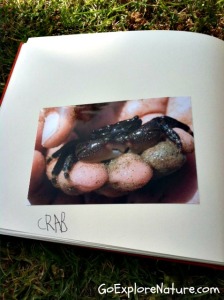
Add details as desired. This was my favorite part – capturing The Little Explorer’s early letters. He decided he only wanted to include animal names, but there’s room to add in more details later if he changes his mind. Ideas: Where we saw the animal and when, what the animal eats and an interesting fact or two.
Enjoy! Our DIY animal photo book is a current favorite for bedtime stories. The Little Explorer was so excited, he shared it will all his preschool friends, too!
To make our nature book, I let the older sisters or brothers take photos of their favorite plants and animals along the way.
After a long hike, lots of water breaks and enough fun in the sun, we headed home.
I printed off a few of the photos they took along with our nature book printables:
Superscript
Exploration & Discovery
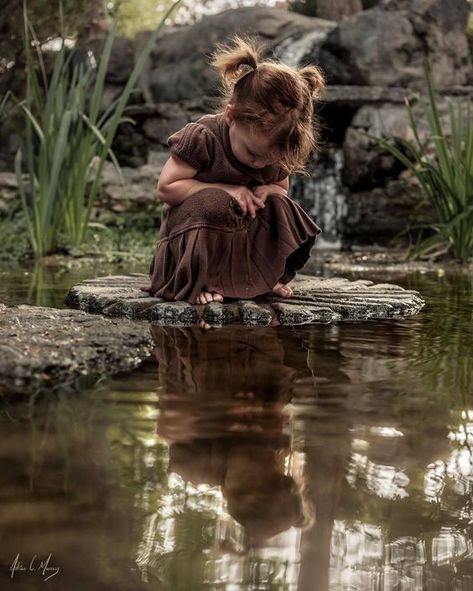
GREAT WAYS TO EXPLORE WILDLIFE WITH KIDS
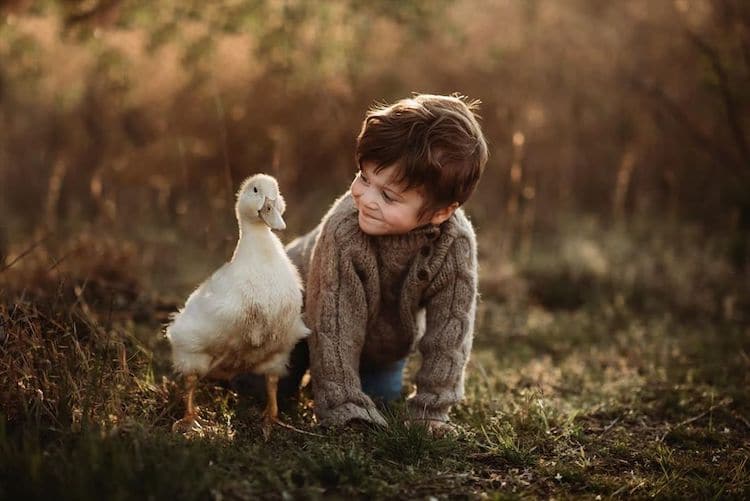
There are so many great reasons to explore wildlife with kids. As well as educating children about the behavior and biology of wild animals, it’s an easy way to encourage them to have love and compassion for other creatures.
In addition, many studies have shown that every aspect of the health and wellness of a child improves with exposure to the natural world. And of course, kids love to get hands-on with nature and wildlife, so it’s easy to see why wildlife activities for kids are so popular.
GREAT WAYS TO EXPLORE WILDLIFE WITH KIDS

Ready to explore nature and wildlife with the kids? Here are five great ways to introduce children to the wonderful world of wildlife, and how they can respect and take care of it.
SCHEDULE IN TIME TO CONNECT WITH WILDLIFE ON YOUR VACATIONS
When planning your next family trip, consider skipping the amusement parks and beaches and heading to a family-oriented wildlife destination instead. Choose a place that offers enough opportunities to learn the dangers that animals face in the wild, and that also allows children to learn how humans can help conserve and protect their habitat.
The Sepilok Nature Reserve in Borneo is a prime example. The sanctuary is covered with dense forests and is rich in wildlife. In fact, it’s one of the few places where you can find orangutans, elephants, and rhinos in one area. Here children can get a chance to play with baby apes or go on a special adventure with their parents to view exotic species like the Sunday flying lemurs and gliding frogs. You can book wildlife experiences like this on sites such as Naturetrek.
You can even take the kids on a truly adventurous wildlife safari. Countries like South Africa, Kenya and India offer plenty of amazing safari options.

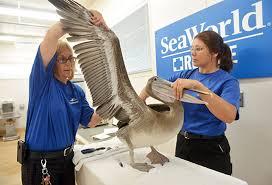
The return of our rescued manatee-Mosquito Lagoon & Rescue Care center workers
VISIT AN ANIMAL RESCUE CENTER
Our children are going to be the future ambassadors for animal conservation, so it’s important to teach them about their wellbeing. The best way to start is by taking the kids to an animal welfare center for mistreated or abandoned animals. This will help children to understand why animals are important to mankind and learn about caring for them in a loving and humane manner.
A trip to an animal welfare center is also a simple way to give children access to wildlife that they may not otherwise come into contact with.

USE BOOKS AND SCREENS TO EXPLORE WILDLIFE WITH KIDS
It’s never too soon to explore wildlife with kids. Start with simple things like pointing out animals in movies or TV shows, or when you’re out and about. Tell them the names of the animals and explain what makes them so unique. This could be the sounds the animal makes, where it comes from, or what it eats.
Once your child is a little older, you can increase their knowledge about the world of wild animals through books. Fiction and non-fiction both work well here. An ultimate classic like Black Beauty, for example, will show them how to appreciate and love horses, and by association, other animals. A non-fiction nature play activity book is also a great way to help kids learn about and care for wildlife. The internet is a useful resource too. Sites like National Geographic Kids are bursting with documentaries on wild animals which are sure to keep the kids mesmerized.

TAKE THE KIDS
ON A NATURE WALK
As well as using books and visuals to teach kids about wildlife, you should definitely try to experience nature from up close. A nature walk is a simple, low-cost and accessible way to do this, and it’s a great way to burn off some energy and instill a sense of calm too. Remember if your baby is laying down in a stroller: They only see the clouds above.
You could visit a local park or nature reserve, hike up a hill, or stroll along a lake or river. Ask your children to bring along a book and use it to identify the animals they see, or download a free printable nature scavenger hunt. During the walk, encourage children to look out for wildlife. In my experience, nature always stimulates kids to ask lots of questions, so be prepared to do some thinking yourself! You might need to look some things up when you get home too.
Once the walk has ended, it’s nice if everyone reflects on what they saw and liked the most. This is a good prompt to get kids using their language skills, and also a fun way to find inspiration for your next wildlife adventure.

HANDS-ON ACTIVITIES
FOR OLDER TODDLERS
Wildlife-themed activities are a great hands-on way to explore wildlife with kids. Here are a few fun ideas.
Study animal tracks. Show kids pictures of different animal tracks and talk about the animal that made them. Or head outside and see what tracks you can find. You could take spotter cards with you or take a photo of the tracks and look them up when you get home. A snowy day is a great time to do this as it makes it easier to spot and follow tracks, but a muddy field works well too!
Encourage children to garden for wildlife. Discuss what animals and insects visit your garden, and why. This is a great opportunity to talk about how our gardens provide a source of food for wildlife, and also to explore the concept of pollination. You might like to extend this activity by making homemade bird feeders, or installing a bird bath.
When you’re out with the kids at night, ask them to listen carefully for sounds of wild animals. This could be a chirping grasshopper, a hooting owl, or a hedgehog shuffling in the undergrowth. Note down the names of the different animals you hear and have a go at spotting them by flashlight.
Have fun with storytelling. One of the simplest ways to captivate children about wildlife is to tell stories. Add in an outdoor setting and a campfire, and things get really exciting! You could make up a wildlife story about the animals where you live, read their favorite animal book, play wildlife-themed games, or sing some favorite songs about animals.
Make a photo book TOGETHER as they encounter wildlife. It makes them feel that those experiences are important.
By helping children engage with wildlife, we can give them the opportunity to develop their understanding of and empathy with nature. As well as being a fun family activity, it’s a brilliant way to make sure that future generations do their bit to take care of our planet’s amazing wildlife.
What’s your favorite way to explore wildlife with kids?
Wildlife Activities
for Babies & Toddlers to Enjoy

It doesn’t take much to encourage a love of wildlife from a very early age with these wildlife activities for toddlers. Although the twins are not even two yet, they know a range of animal names and even the sounds they make.
Here’s how you can encourage a love of wildlife in your little monkeys, too.
1. Give your child a wildlife stuffed toy.
Babies naturally bond to stuffed toys. Mt twins love all their stuffed toys; their first bonds with wildlife were with their animal comforters.
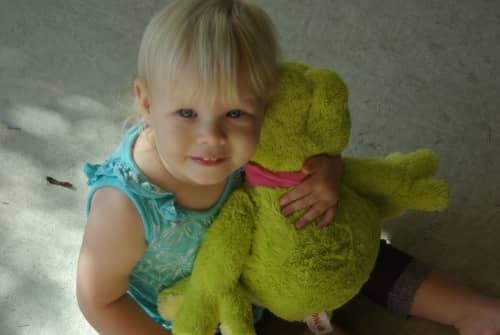
2. Sing them nursery rhymes about nature
Babies love to hear their mummy and daddy singing to them. Here’s a list of wildlife-friendly nursery rhymes to encourage some wildlife love. It comes as a free printable, too!
3. Read wildlife books.
It’s never too early to start reading to your children and there are plenty of wonderful baby and toddler-friendly wildlife books to collect.
We love Mem Fox’s Hello Baby and Time for Bed and we can’t go past John Butler’s Can You Cuddle like a Koala too. The illustrations in all three books are just beautiful and the girls love them.
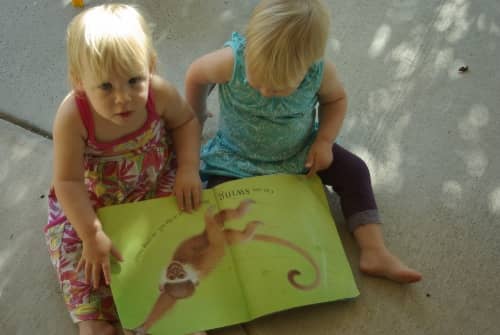
4. Sing them wildlife songs.
Here’s our top list of wildlife songs. They are taken from YouTube so there’s wonderful visuals with them.
Let your littlies enjoy a catchy beat and dance like little animals. If they love this, you can also introduce the wildlife movement dice.
5. Talk about the animals.
Name animals by pointing out the stuffed toys or the animal pictures in books. Point to the animal and say the name – they’ll soon get the picture and start saying it back to you. If you show it’s important to love animals, they will too.
6. Animal Sounds.
When your toddler has grasped some of the animal names, start to ask them what noise they make. Soon they’ll be repeating it back to you. It’s a nice follow-up activity on naming animals and it’s so adorable!
7. Get closer to the real thing.
Children from as early as 6 months old love interacting with animals. Of course, we need to be mindful that young children don’t quite understand how to interact appropriately and safely with animals and wildlife yet, so full supervision is important.
I wouldn’t avoid it though.
They will learn quickly and the joy on their faces when an animal eats from their hand, or the curiosity they ooze when they see an animal moving in a different way from them, is priceless. You don’t need to go to a zoo for this, although if you do, here’s some wonderful ways to get the most out of your visit. Go on a family outing to the beach or just look in your backyard!
This activity may be last on the list, but it’s the most important.

There you have it! Seven wonderful wildlife activities for toddlers. Get into these activities and see your child’s face light up with joy.
We don’t push the girls into loving wildlife. It’s easy to teach children about wildlife because they are naturally drawn to them. Most of the activities we do naturally in our day.
Does you child have a favorite animal stuffed toy? What wildlife nursery rhyme do they love the best?
uperscript
Wet & Wild Ponds,
Lakes and Creeks
Sensory Discovery Zones
When you take a baby to the lake or a river, you just have to let them explore everything in nature. While the water could be the central focal point and goal of the adventure, there are many opportunities to familiarize your baby with nature before you get there.
Letting the baby feel pinecones, acorns, tree bark, leaves, and smooth river rocks are all part of the experience. Since babies are not cognizant about what they are feeling and unable to articulate it into words or ideas, they function at a more sensory level.
The fragrant smell of cedar firewood, the hickory of a barbeque, and the fragrance of flowers can all be a treat to your baby’s senses. And they will also enjoy the sounds of the rushing waters, the birds chirping, and other critters.
So, if the lake you are visiting is wading accessible, wear some water-appropriate clothes and footwear. Bring some buckets, a net, a magnifying glass, and explore a lake with kids up close if they have older babies!
Babies love being outdoors and in nature, and it's so good for them! Want to get your baby into nature play, but not sure where to start? Check our list of simple and fun ideas!
Get up close to plants or point them out while walking in nature.
Talk about and touch the seeds, nuts, berries and flowers. Let babies and toddlers feel different textures with their bare hands and feet.
Stroke leaves or flowers on arms, legs and cheeks. Give babies and toddlers time to explore and focus on nature.
Look at and talk about the colours, textures, shapes and sizes.
Sit with babies to use their senses with nature; you will be close so they don’t swallow anything. Let them touch, smell and even taste sticks, grass and leaves.
Roll gumnuts or bigger seeds. Bury them in the sand to dig up again.
Float flowers, leaves and feathers in puddles or shallow water.
Use seeds, grass and leaves to mix into mud with a stick.
Point out small creatures: spider webs, dragonflies, ants, butterflies, bees. Hold some on your hand or a stick: ladybugs, caterpillars or a praying mantis.
Be brave when discovering small creatures so you can encourage curiosity and interest – not fear! Catching and releasing minibeasts shows respect and concern for nature.
Use a long stick to lift and explore underneath sticks or bark.
Let babies try nature experiences several times to get used to different textures e.g. sand, bark and sticks.
Watch and listen to the birds. Bigger birds like swans or ducks can be easier to see. Visit different waterways, like rivers, creeks and beaches. Talk about and compare what you find.
Make a birdbath for your garden to encourage the birds. Keep it simple and cheap: place a shallow terracotta plant base on a tree stump.
Let young children dry out seeds from fruit and vegetables. Plant, water them and watch them grow.
Dress in waterproof clothing and have short visits in gentle rain. Let the rain drop on hands and faces.
Hold your baby while they paddle hands and feet in muddy puddles or shallow water – good for senses and gross motor skills for strength with walking and standing.
Be fascinated and explore the reflections and shadows in water – go for a walk near a lake or creek or find some clear, shallow puddles.
Let young children wear gumboots and splash and stomp in puddles.
Ride little bikes through puddles.
Run through sprinklers (on your watering day).
Plant an edible herb and flower garden to touch, taste, look at and smell.
Watch the clouds or the shadow of the sunlight in the trees. Let toddlers chase their own shadow and compare their shadow with yours.
Boating With Babies
+ baby boating accessories
Summer is here y’all! And in Florida, we pack up our things and head to the boat ramp! Boating with babies can be a very safe and fun activity in the summer, as long as you are well prepared and follow certain safety regulations, such as always having a life vest properly sized for your babe! If you’re looking for a life vest for an infant under 30 pounds, Amazon (the place that has everything) has this one which is the most comfortable. We have a similar one, that was handed down to us but the size range is different, and we love it. I don’t consider this a tip, however, I do consider it a NECESSITY!!

1. BE PREPARED FOR BOATING WITH BABIES
As a momma, this is basically the number one tip/rule in your life regardless of where you are going. Always be prepared! I can’t stress this enough for the boat! You are basically in the middle of the water somewhere, and the last thing you want to do is have to go back to land every so often to get whatever it is that you forgot.
When I’m packing my bag/diaper bag for boating with babies, my essentials go as follows :
Diapers (duh! BRING EXTRA!!!)
Wipes (another obvious – never go anywhere without these!)
SUNSCREEN!! (an absolute necessity! Baby skin is so sensitive, this is a must!!)
Towels (my favorite are the hooded – but anything works!)
Extra onesies (I usually bring just plain white onesies, that I’m okay with getting salty and sweaty!)
Reusable swim diaper (oh my goodness- this ones the best!! So easy for a dip, especially since the smallest size disposable swim diaper is 16 pounds!)
Jelly shoes (since infants do not walk, this provides enough feet protection, with the ability to still get wet and cool when going for a dip in the water!)
Hat (keep that babe nice and shady!)
Fan (battery operated – but nice to give the babe cool relief in the heat!)
Bouncer seat (not to be used when the boat is in motion at all! We use it when we are either anchored out and not moving, or anchored up to an island and we bring it onto the island under our pop up tent!)
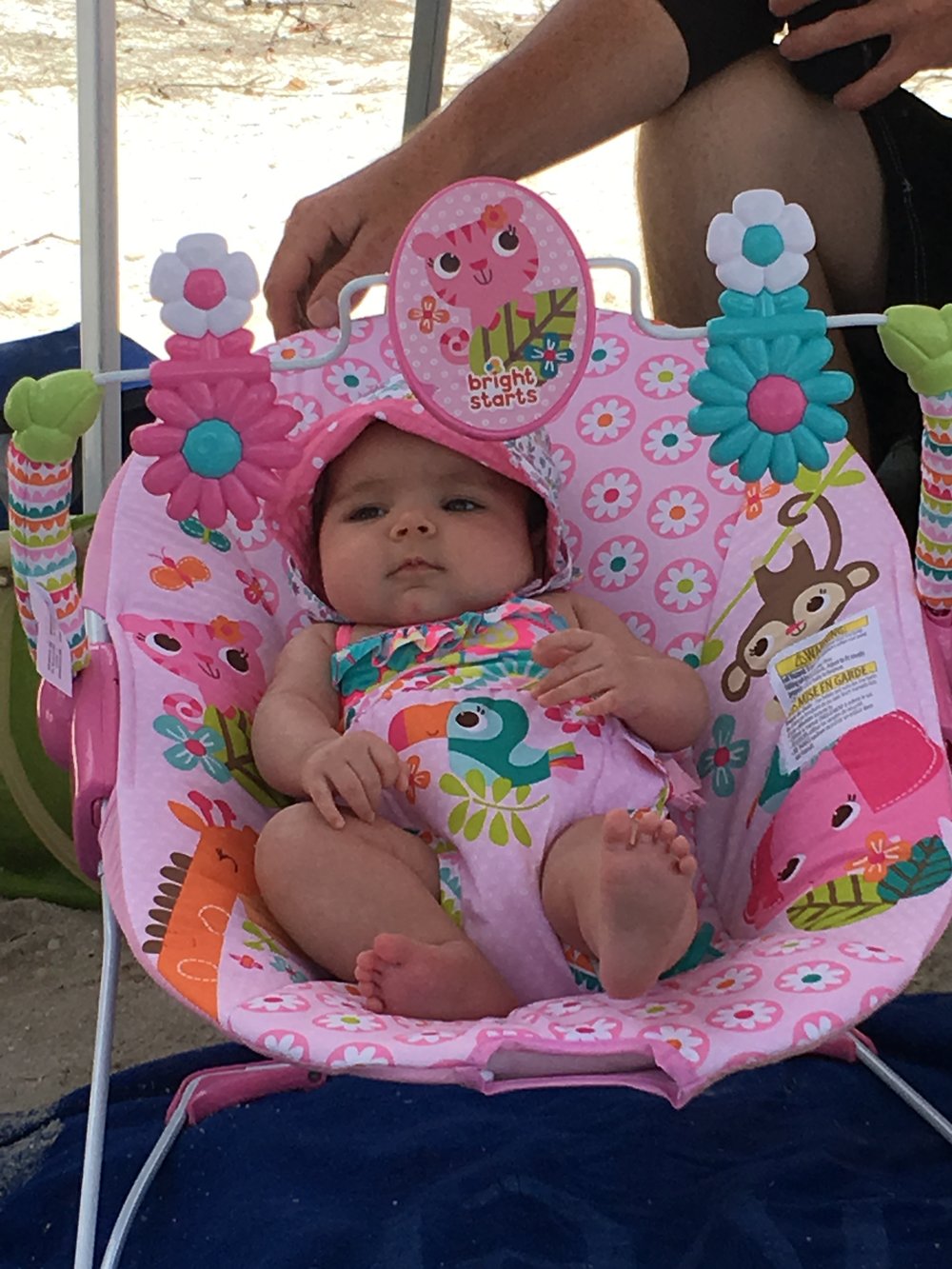
2. WEAR YOUR BABY ON THE BOAT
I love this bit of advice. Baby wearing is basically the best, for so many different reasons and this is one of the atypical reasons! When getting on, and off of the boat – wear. your. baby. It is so important that during this transition from the land to water and vice versa that they are almost literally glued to you! NEVER pass your baby from person A to person B to get onto the boat! For mom it is SO much more comforting knowing that are right on you and basically can’t move without you. Accidents can happen in a split second, so always be extra cautious even with baby wearing them onto the boat. Make sure there is somebody on the boat guiding you down, and somebody on land behind you kind of hovering you! Safety is obviously key here, so you can never have too much help! Continue to wear your baby until you get from point A to point B! NEVER pass them around during the time that the boat is in movement. You can read more about my love for baby carriers (and get a little free surprise) by clicking here!

3. FIND YOUR SAFE SPOT ON THE BOAT
If you’re like us, and have grown up on a boat/the water you probably have never really thought about sitting in the “safest” spot because to us they are all safe! Which is true! But it’s very important that you sit in a sturdy seat. Mostly for the comfort of the baby aspect, but it does also make you feel much safer and more secure! Usually, depending on the type of boat you are on, there is a seat, kind of like a captains chair, just not behind the steering wheel! Usually this seat gets splashed by water the least, and is a little higher up so you don’t feel the boat hitting the waves as hard! If you sit in those lower seats, your little babe is going to be constantly bouncing up and down, and constantly shaken, which obviously is not good for their fragile bodies/heads!
4. KEEP YOUR BABY COOL ON THE BOAT
The Florida heat is no joke, and I’m sure wherever you are located 80+ degrees, is 80+ degrees! HOT HOT HOT! A risk factor of SIDS can be overheating, so it is so important that you keep your babe as cool as possible! Depending on the degree of the water, we will put a reusable swim diaper on her, and dip her in! Make sure you change them almost immediately after a dip in the water to protect against infections caused by sitting water, such as UTI’s (yes – boys can get them too)! Most boats have some type of Bimini or covering that you can set your babe under in their seat. If the boat you are on only has a T-Top or nothing at all I highly suggest bringing an umbrella. Shade is crucial in keeping them protected from the sun (as well as sunscreen)! and in turn keeping them cool! We also bring a handy dandy 02 Cool fan with us. It is battery operated, so it’s great to face towards her when we feel like that she is getting too hot!
5. HAVE FUN WHILE BOATING WITH BABIES!
I know, such an obvious one! But really y’all! Have a blast! I know sometimes being a parent in these situations is nerve-wracking, because again, accidents happen in a split second! But enjoy these moments with your babe while they are still little! They grow up so fast, and these memories are ones you don’t want to miss! Take lots of pictures, as always! As long as you are being as safe as humanly possible, you should be just fine, and completely able to enjoy yourself!
All of these tips are based on boating with experienced boaters and passengers. If this is your first time on a boat, or your operators first time operating a boat, then leave that babe at home until you get comfortable and familiarized!

Consider This Before Buying a Sun Tent
I think this “consider this before buying…” theme is going to be one of my favorites to write on the blog. I love helping other parents get the items that will work best for them. I try to do this by sharing my experiences using different baby, child, or family products and informing you of…
Consider This Before Buying a Sun Tent Read More
STEP into Adventure
We venture through the diverse opportunities of water-related activities, from exhilarating adventures to serene escapes and everything in between. Whether it’s the thrill that comes from jumping the waves on jet skis and wakeboards, or the tranquility of paddleboarding and kayaking, we will explore the full spectrum of experiences that can be done on the water. If you prefer the shoreline, let’s share the paths that might be unknown, celebrate the joy of discovery, and joy the profound sense of peace by just being near the water.
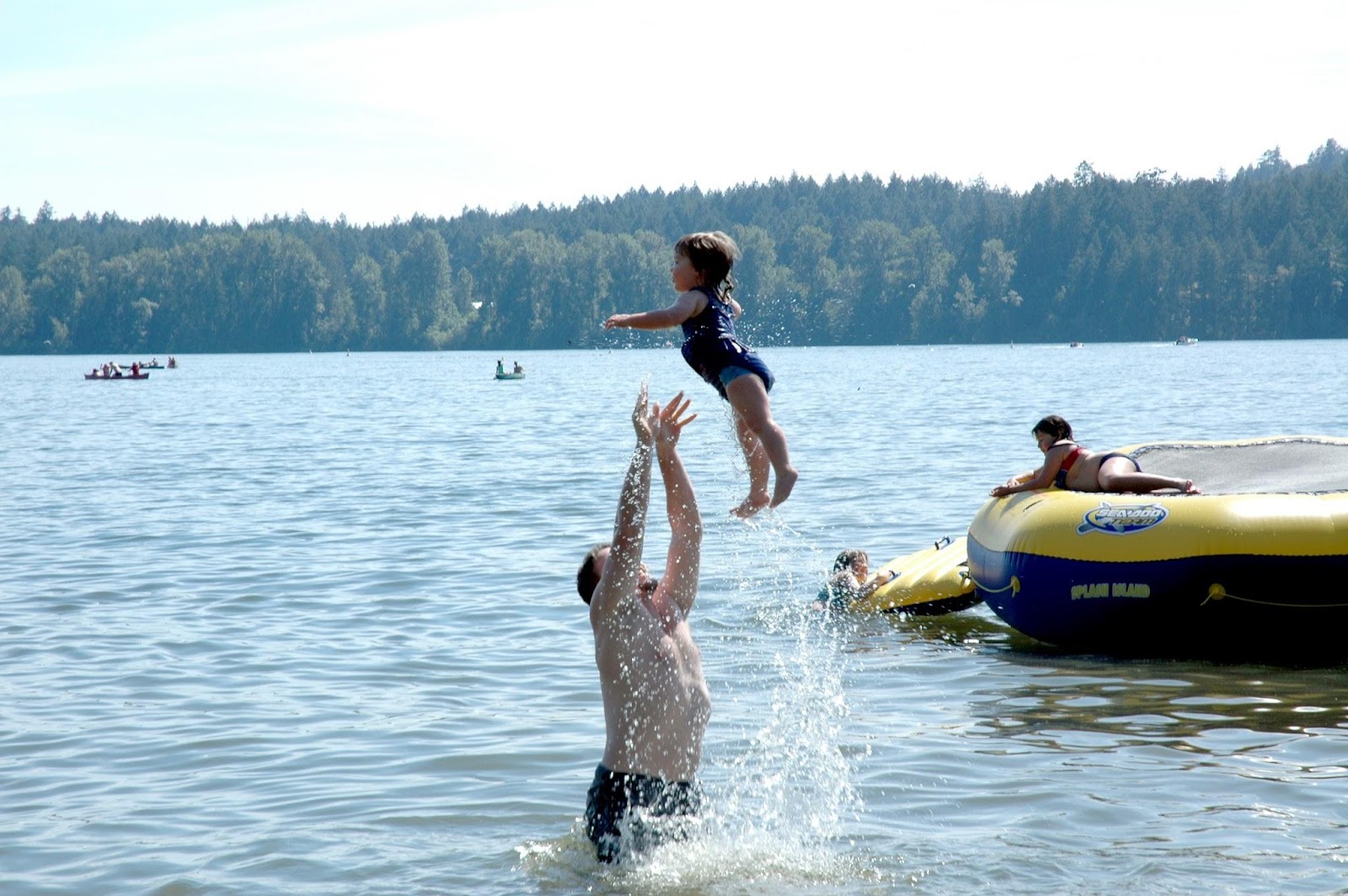
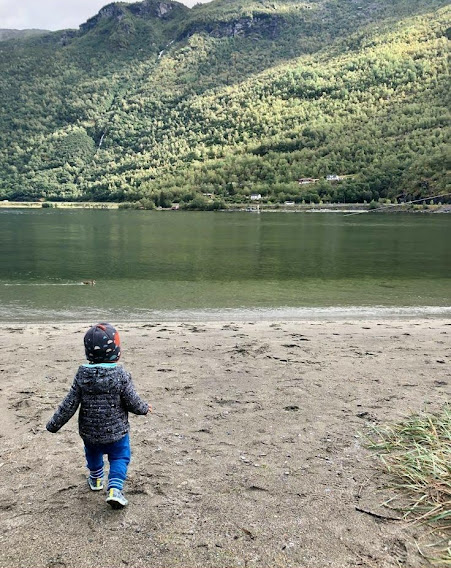
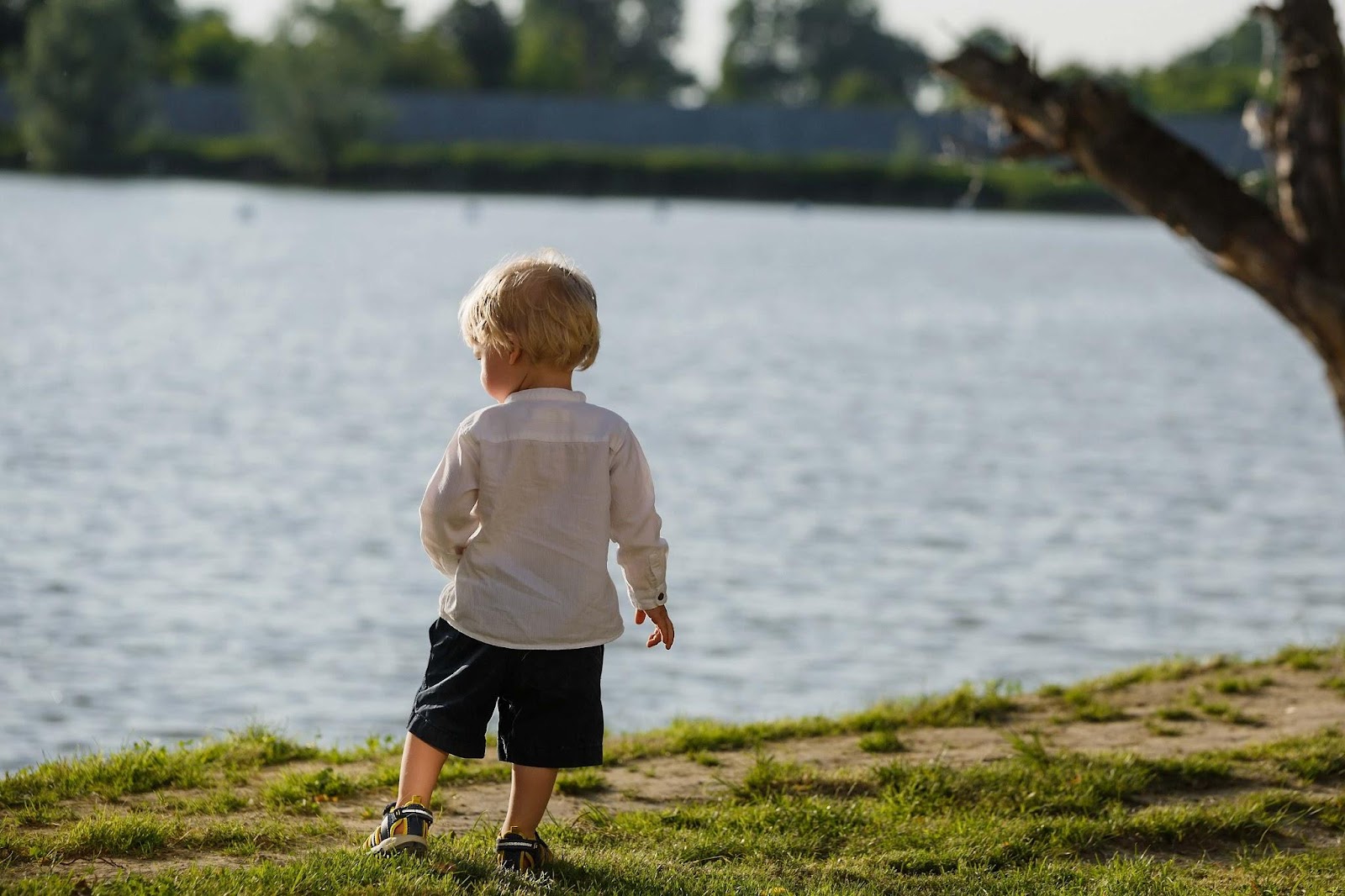
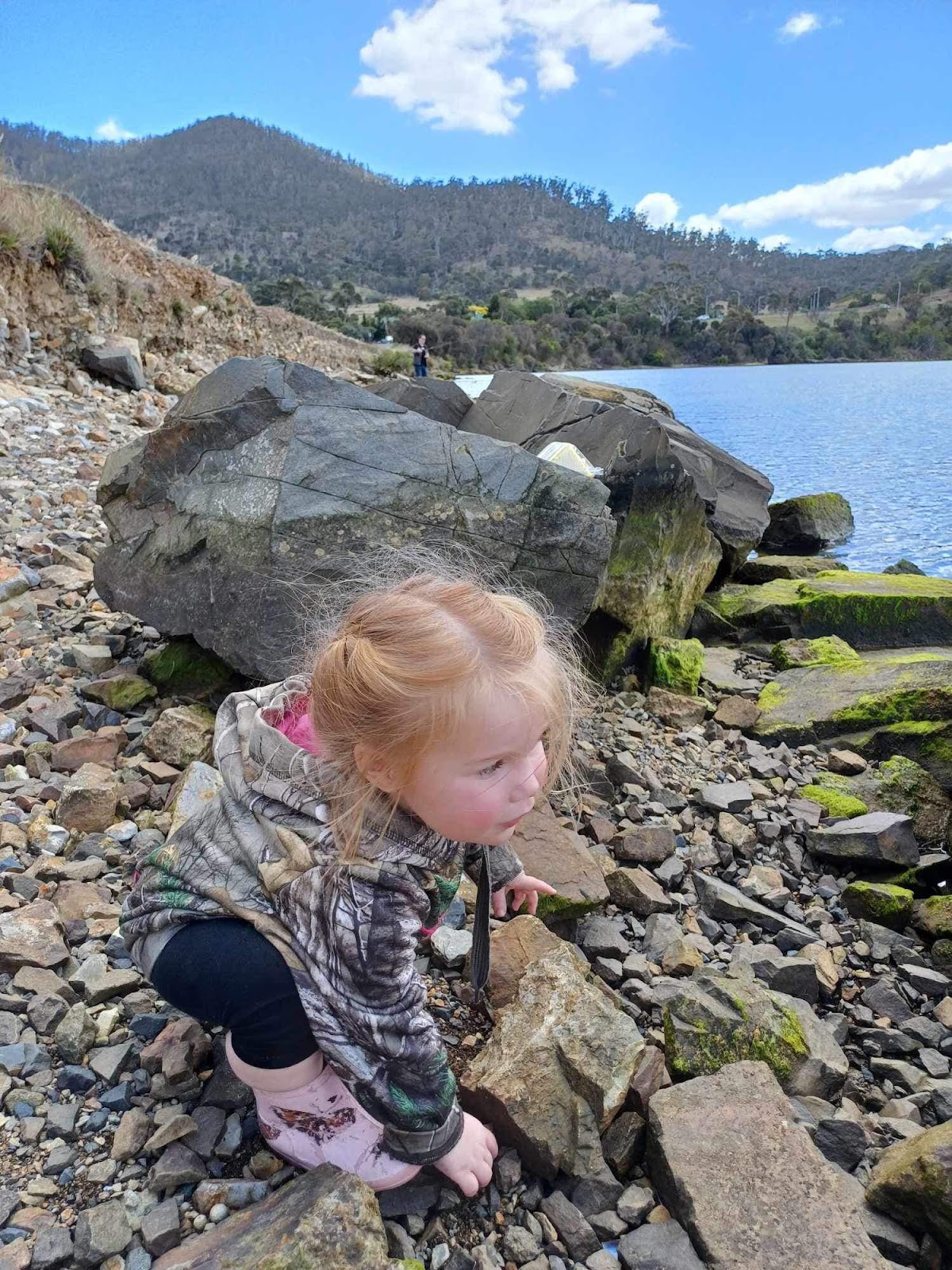
4 ways to stay cool on the lake
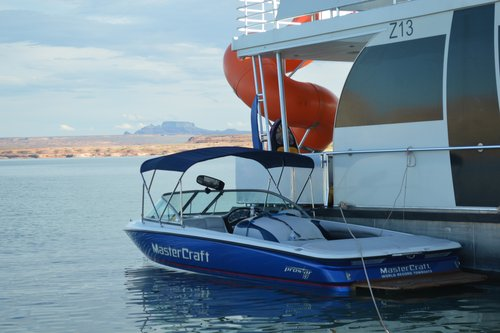
4 Ways to make lake life affordable
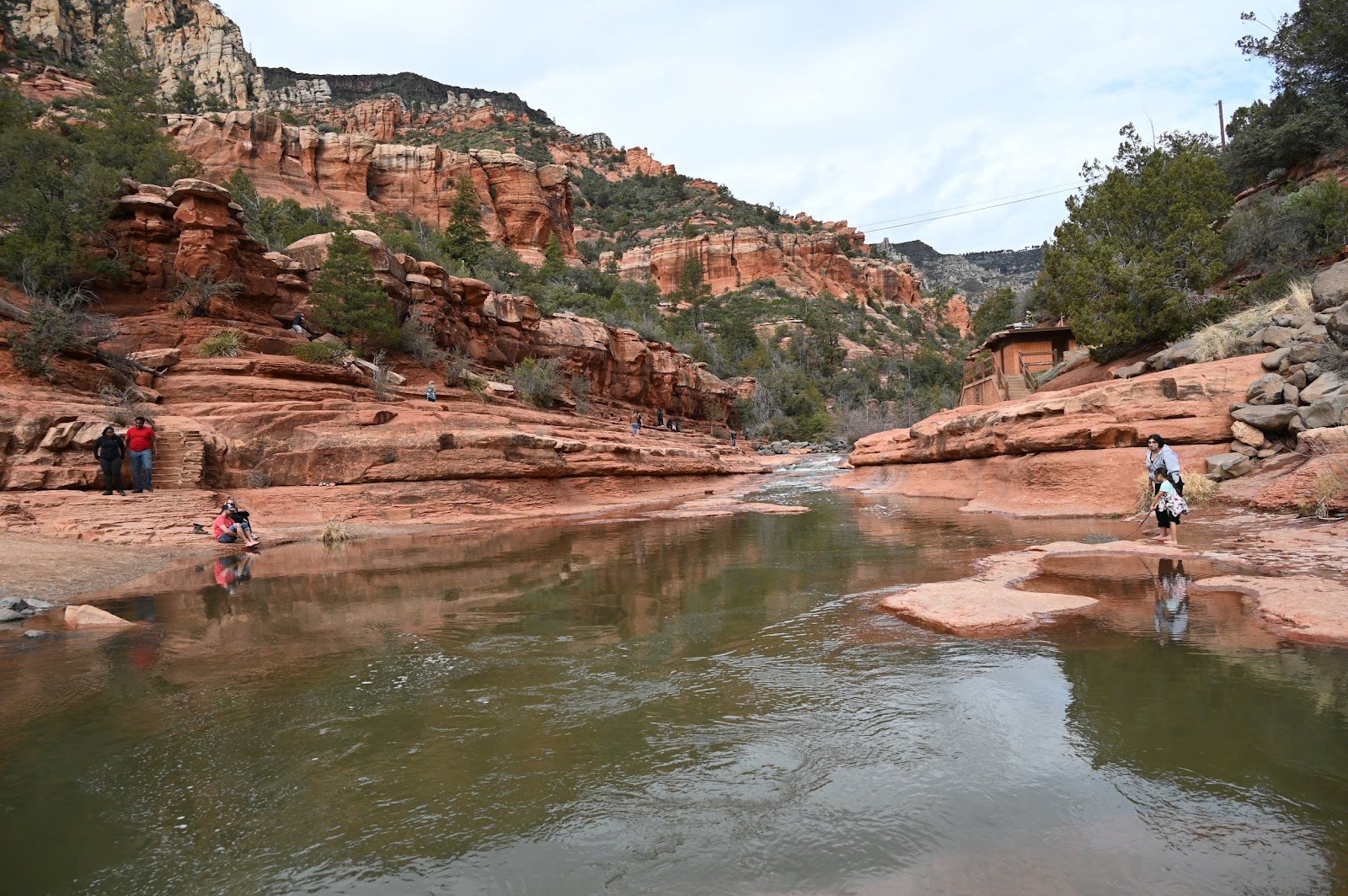
5 must-visit water spots in Arizona
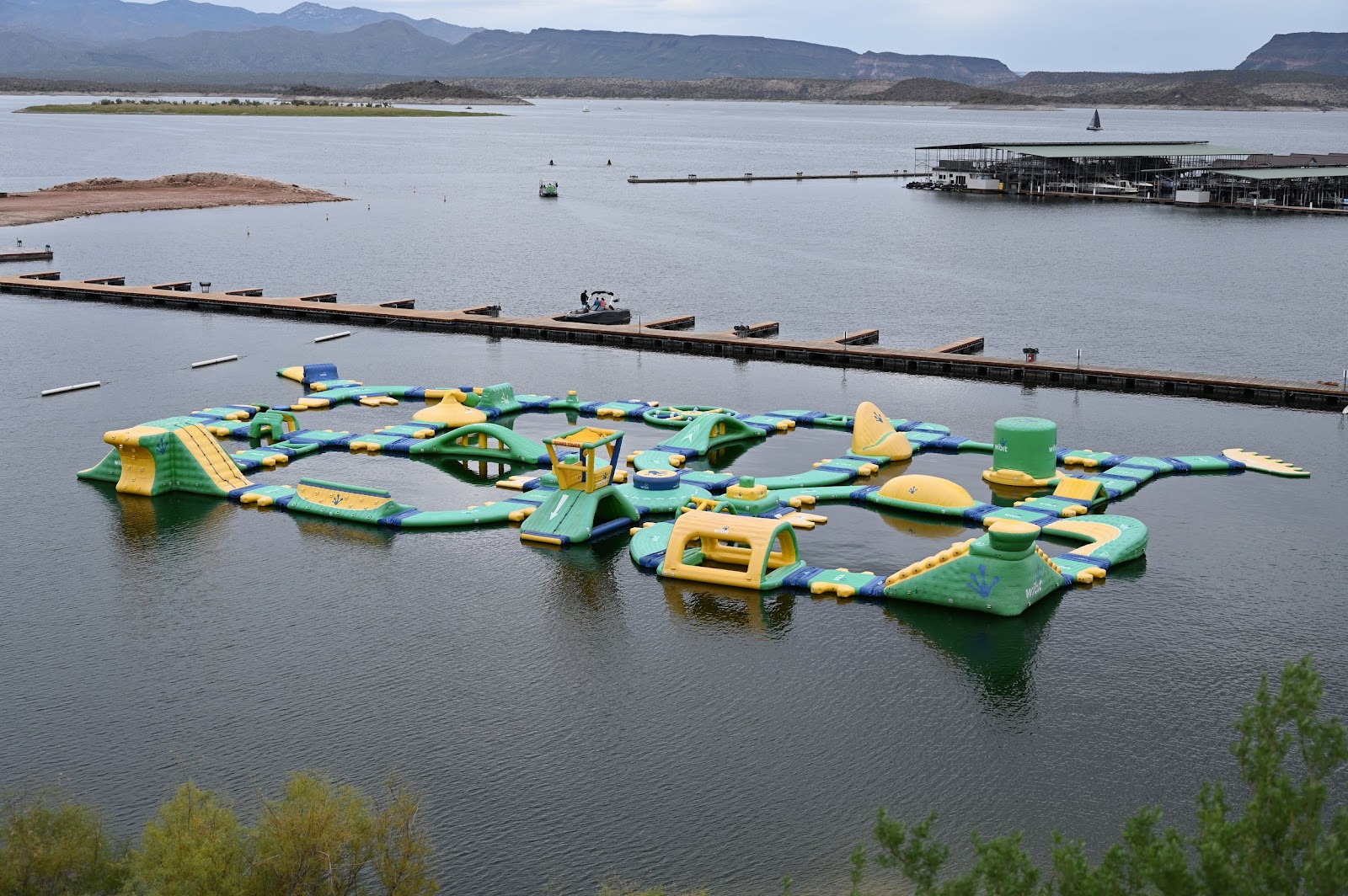
7 Activities your kids will enjoy at the lake!

A note on lake & water safety
Before we get started, I’d like to mention some safety guidelines. Any time water is involved, we have to be extra conscious of our children’s safety. Water is such a fun thing that few children understand its danger. And unlike swimming beaches, lakes often have slippery mud or grassy banks that can drop abruptly into deep water. Teaching children to swim is the number-one prevention to drowning accidents, but even that isn’t a guarantee of safety. Never leave children unattended near any water, especially a deep body of water like a lake.
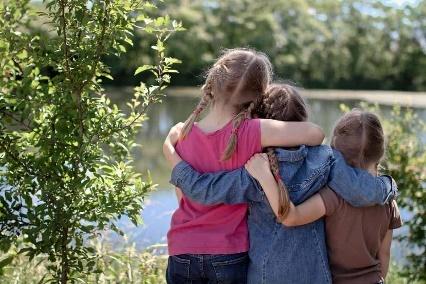
Be safe together!
If you are comfortable allowing your children to wade in the water, make sure you have carefully checked out the wading area yourself for dangers like slippery mud and sharp drop-offs. And even if you have instructed your children to stay out of the lake, we should be aware that accidents happen and a child can slip and fall into the water in an instant. Stay close and focused on your children, adventuring and playing together. Exploring lakes with kids should be fun and safe.
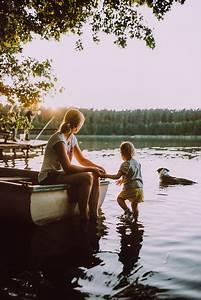
Teaching nature skills
To start off exploring a lake with kids, simply walk around the lake or the area that you will be in. Talk before you start about how everyone needs to use their “nature skills” to explore the lake area. These skills include walking quietly, speaking quietly, and trying not to disturb the wildlife around you. We always have to work on sharing our discoveries quietly—the first child to yell they saw a goose will probably scare off the whole flock! This is also a good time to teach children how to study nature without disturbing it, to observe but not take, and to show respect for the natural environment surrounding them by being careful where they step and what they touch.
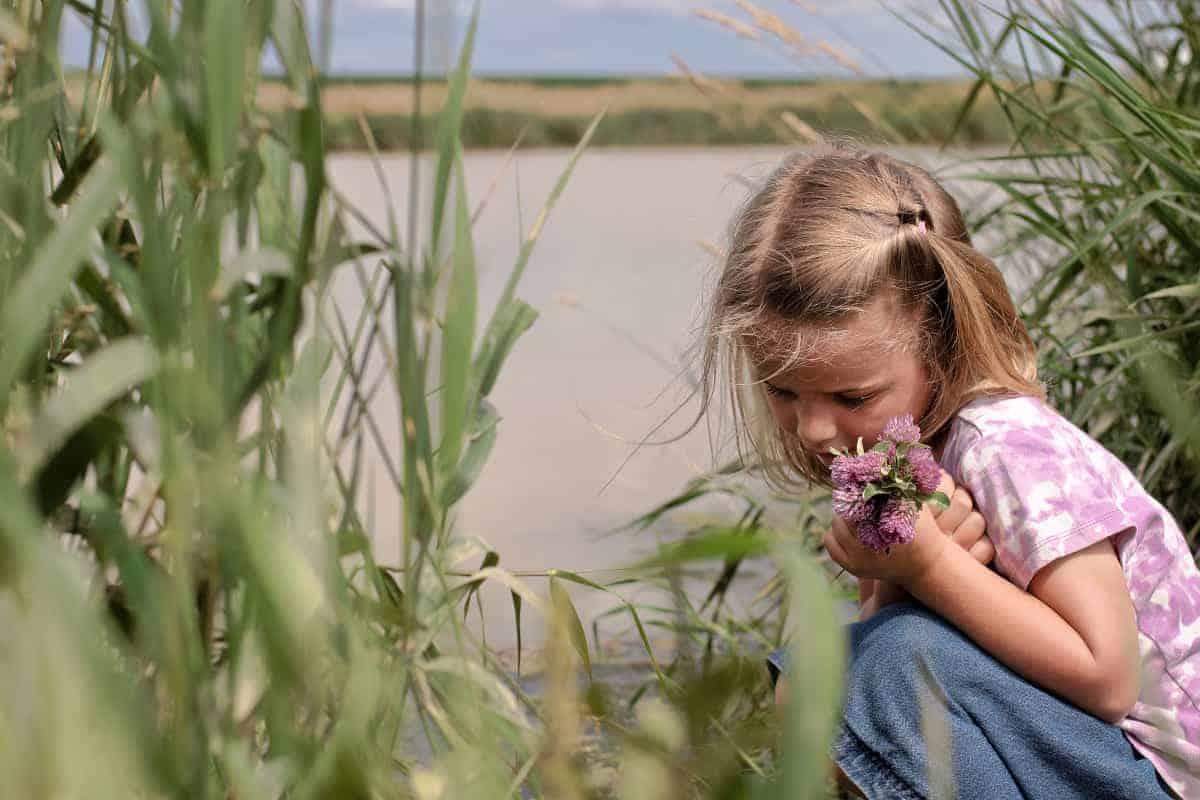
Sensory exploration
Exploring a lake with kids provides a great sensory experience. It’s easy to get started by asking questions involving the senses. What do you see? It’s like an amazing game of “I Spy.” Do you see those wildflowers on the far bank? Can you spot that turtle out sunning on a log? How many frogs can you count? Oh, no, one just ducked underwater!
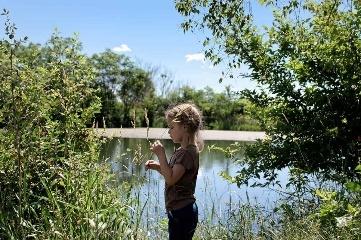

Hearing and Smelling
Observing the natural atmosphere of the lake moves quickly to hearing. Do you hear the birds singing? The bullfrogs calling? The wind whispering through the tall grass? The buzzing of the insects? And then there is always smelling—and if the lake you are visiting has the smell of stagnant water, your children are sure to notice it! But you can also smell wildflowers and a fresh breeze. Honeysuckle and freshly cut grass. I love how much my children will get into talking about all the details they notice.
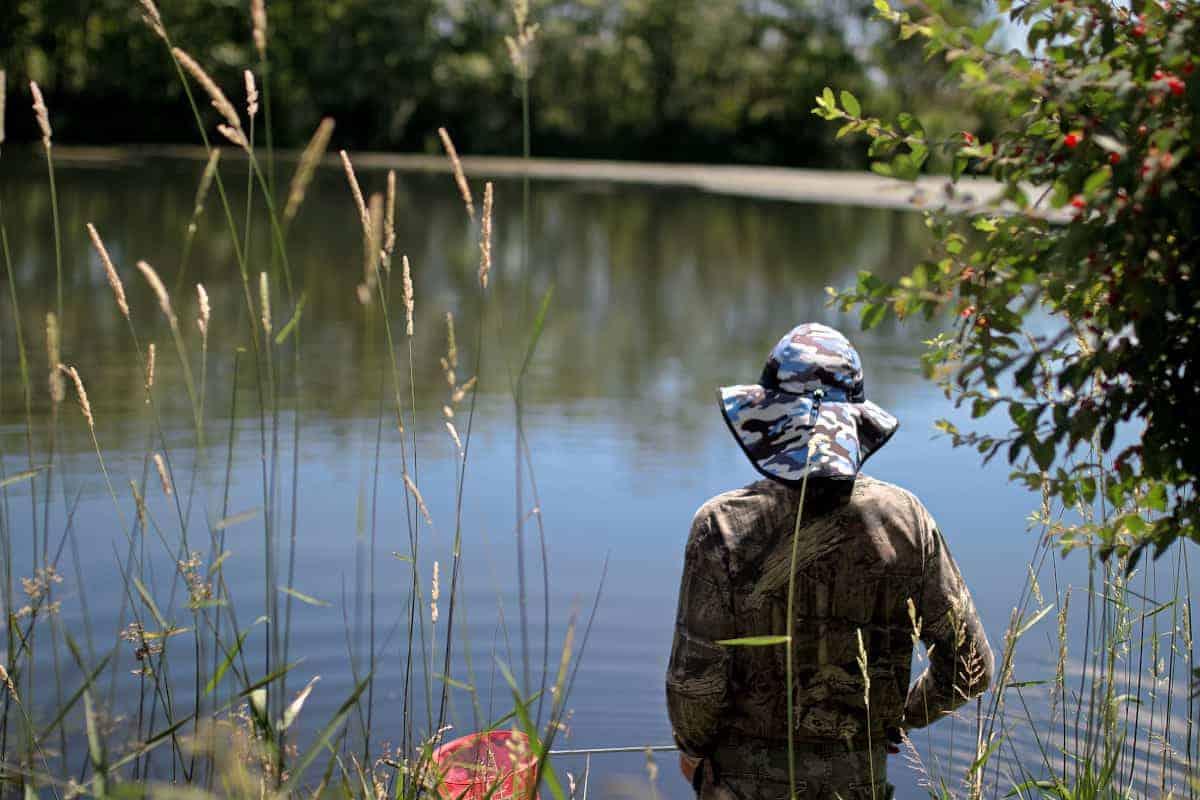
Unforgettable sensory experiences
When exploring lakes with kids, there are countless ways to experience the natural world. How many things can you find to touch? From the smooth leaves and raspy blossom of the cattails, to the silky water and slippery plants in the lake, to the slimy skin of a frog and the soft whisper of a dropped bird feather, there are a multitude of things to feel around a lake. (Of course, unless you have the owner’s permission to pick things, make sure you give careful instruction about not picking any plants or disturbing the environment. Leave it unspoiled for everyone to enjoy!) Touching lake creatures might stretch the sensory comfort zones of some kids, but if you have the opportunity to let your children touch a frog or a fish, it will be a sensory experience they won’t forget!
Resources
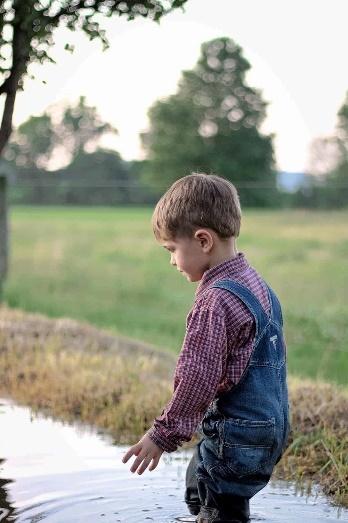
We have found that nature guides and handbooks are valuable resources for learning about aqua life. Teaching older kids to look up different plants and wildlife that they see helps them learn on a deeper level. Once they have looked up a bird or a flower in their guide book, they are much less likely to forget its name or characteristics! Plus, we can learn together all the things I don’t know (which are many!). We use some of the classic field guides, like Kauffman Field Guide to Birds of North America.
There are also some great resources available for less than $10, like these illustrated nature guides. The entire Take-Along Guides series is geared toward helping children learn about nature in an easy-to-find, graspable format. I can’t recommend them enough if you are serious about helping your children learn about wildlife and plants for themselves.
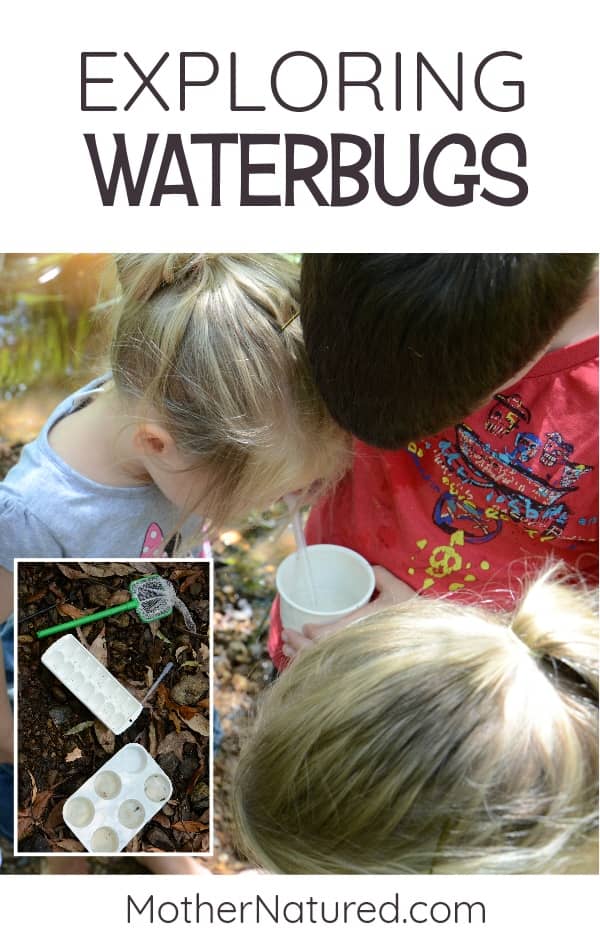
Macroinvertebrates for kids, oh where do I start with this wonderful activity.
It’s been so dry and hot lately that the little trickling creek out the back of our house has gone silent and I can’t even remember the last time I heard the chorus for Great Barred frogs from my bedroom window. Although I miss those sounds tremendously, the lack of them did make me wonder if the creek had little puddles of water that were perfect for exploring waterbugs.
Waterbugs are aquatic macroinvertebrates. They are small animals that live in the water and are just big enough to see with the naked eye. Many water bugs are insects but they can also include worms, mollusks and crustaceans. I took a quick look down at the creek and saw some pockets of water that I knew held a lot of little creatures under submerged rocks and leaves. I couldn’t wait to show the girls and I invited our neighbours along too.
Here’s how to explore the freshwater creeks and ponds for macroinvertebrates.
What to take waterbug hunting:
fish nets
tweezers
white ice cube try and paint tray
magnifying glass
identification book
pipette and spoon
paint brush
White container
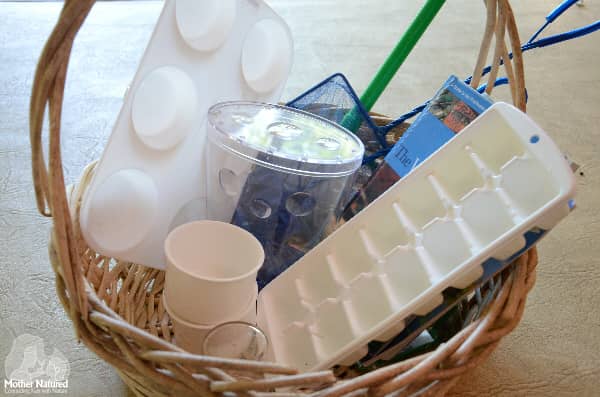
Macroinvertebrates for kids
How to find Waterbugs
There are a few ways you can catch waterbugs but first you’ll need to fill your containers with water from the pond. Try to collect it before your children start to dip their toes in the creek and muddy up the water.
Pick up stones
Pick up a stone or rock that’s submerged under the water, turn it over and use a paintbrush to gently brush the bugs into the containers of water.
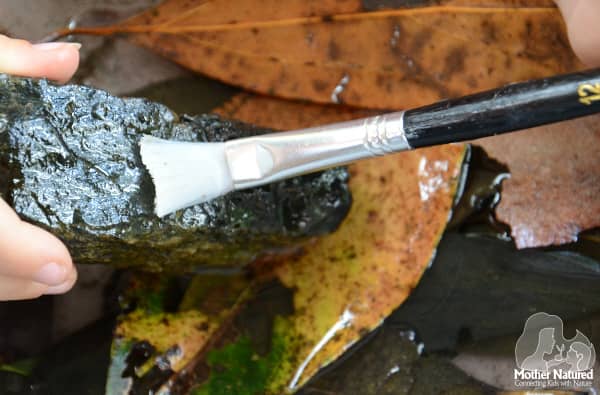

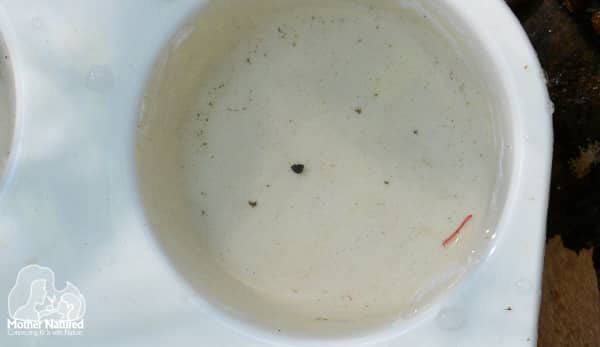
We found snails, a small leech and a few species of aquatic worms this way.
Skim with nets
Use a fish net to catch water bugs by gently scraping through the water as close to the bottom of the creek as you can without collecting too much debris. Tip the contents of the fish net into a large white container and sift through the debris to find the macroinvertebrates. If you brush the leaf as you take them out, you’ll start to see lots of movement on the bottom of the container.
If the waterbugs are small and you want a closer inspection, you can use the pipette or spoon to pick them up and place them in their own section of the ice cube or paint tray. Take a closer look with a magnifying glass.
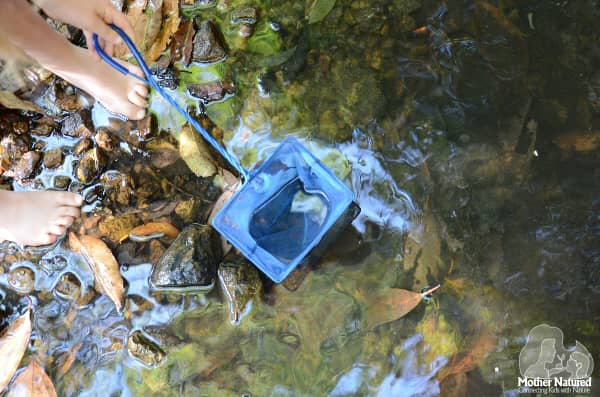
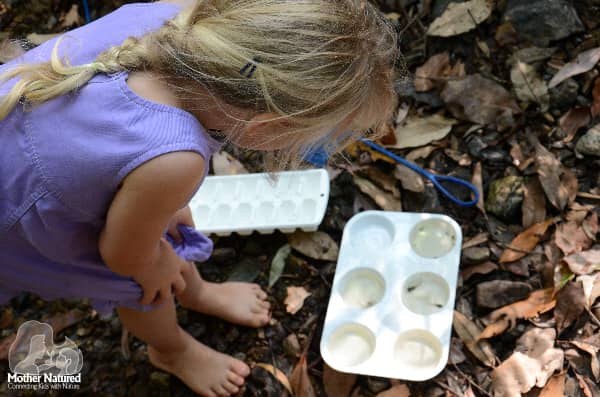
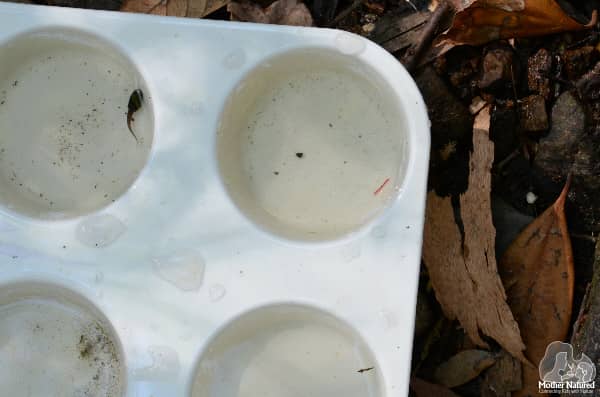
By sifting through the debris we found snails, worms, mosquito larvae and back-swimmers. We also found tadpoles too. This may not be a macroinvertebrate but the children were very excited to find some.
Explore the surrounding area
Water bugs can be found around and on the water too. We found water striders, dragonflies, a fishing spider and unfortunately quite a few mosquitoes!
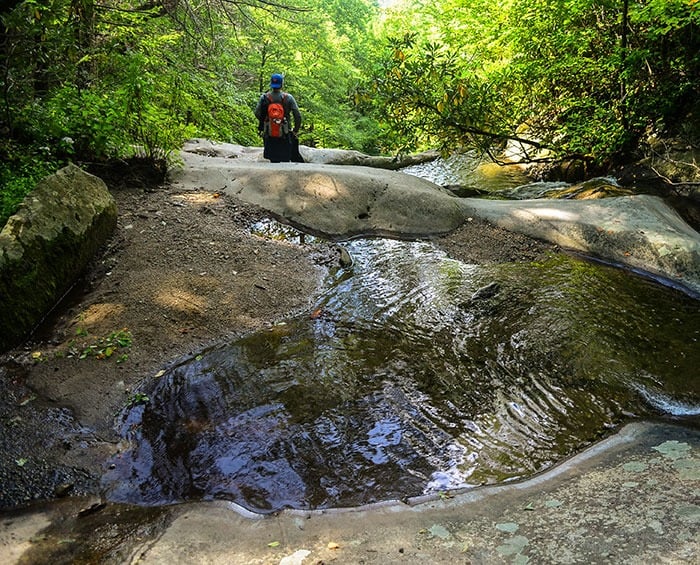
My girls are quite young so my only objective was to build on their knowledge and interest of the world around them. We had a brief look at a book that we borrowed from the library that identifies local waterbugs, The Waterbug Book (affiliate link) by John Gooderham and Edward Tsyrlin. The girls weren’t that keen to know the species of the macroinvertebrates just yet. Nevertheless, I enjoyed looking through it’s pages. It’s a fantastic guide book.
In future I’d love to take some home in a mini aquarium so that we can learn more about the little creatures we found. It would be a great opportunity to understand how they play an important role in the biodiversity and health of the creek. I’d also use that opportunity to introduce life cycles and food webs.
Right now, while their young, I’m just happy to get their little toes in the creek exploring nature in our wonderful world. Macroinvertebrates for kids, or Waterbugs, are easy to find, fun to study and your kids will love learning about them!
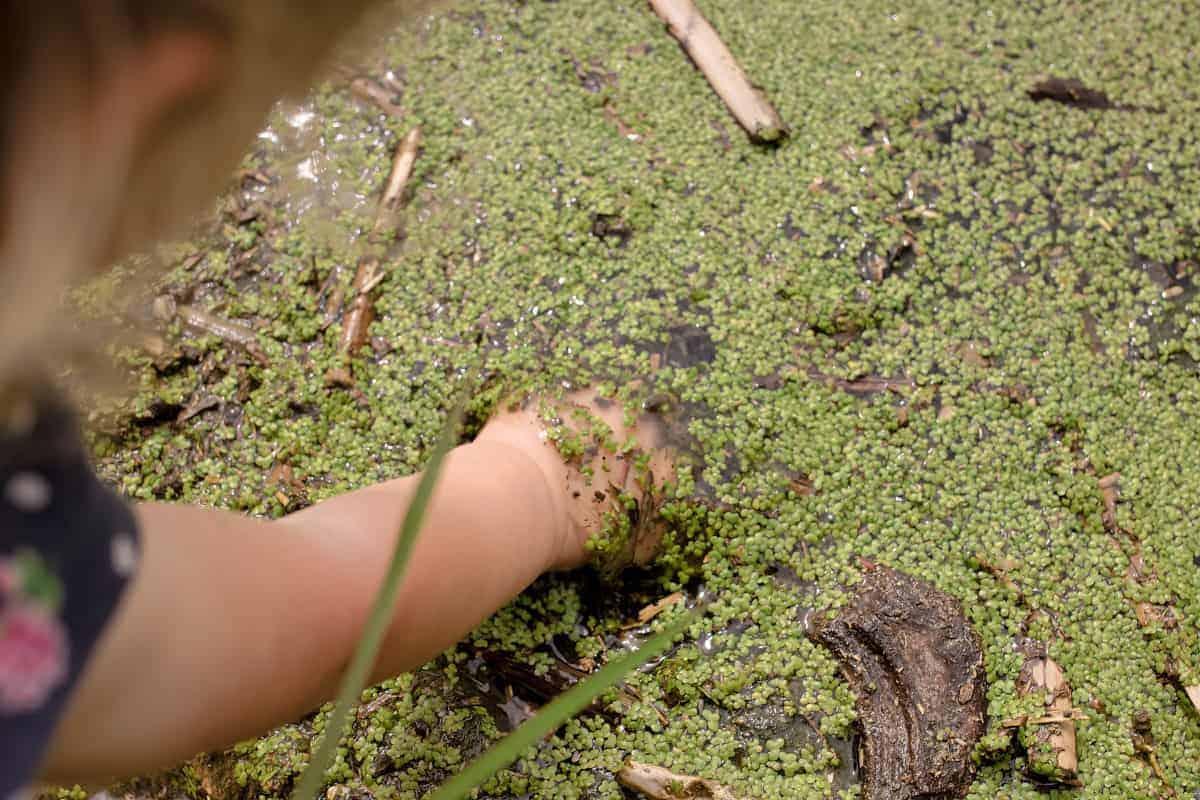
Playing At The Pond
ADVENTURES WITH LITTLE EXPLORERS
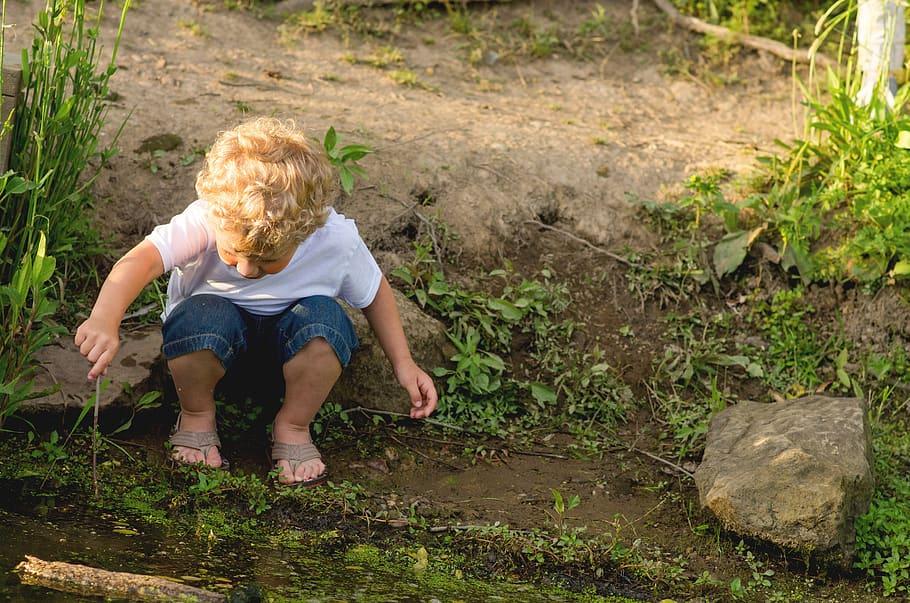
Ah, pond life. The simple life. But what looks like a quiet, still— even stagnant— place on the surface is actually a busy ecosystem brimming with life and so much nature to take in.
Ponds are sensory discovery zones. A child can wade in the waters of a pond, explore the mud between their fingers, listen to the calls of frogs, see dragonflies exhibit a multitude of behaviors and feel the sunshine on their face.
Ponds are great for teaching children about wildlife and the different stages of the life-cycle of small creatures such as frogs as they unfold in natural surroundings. True reality entertainment.
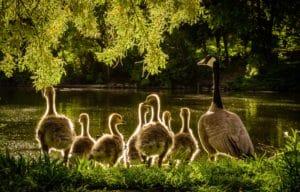
Let's start with what defines a pond. Ponds are quiet bodies of water so shallow that rooted plants grow completely across it. A pond's bottom is usually covered with mud and its water temperature is fairly uniform from top to bottom and there is very little wave action. Sounds like a good place to explore!
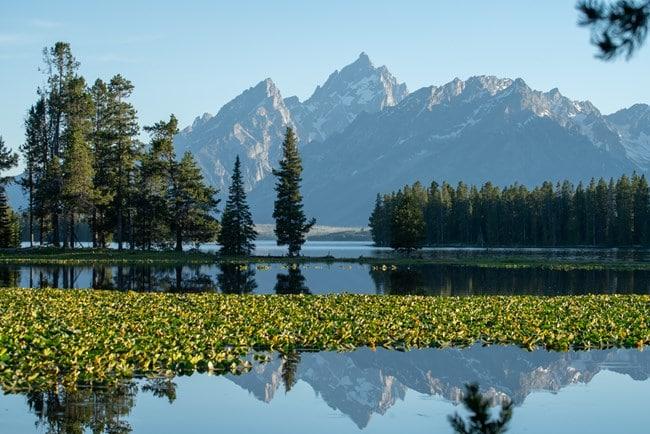
Just remember that not all ponds are created equal. Some ponds are created by streams— mountain-stream ponds. Others are created intentionally such as farm ponds There are also mountain ponds, formed by glaciers, cypress ponds and bog ponds. You can learn a ton about your local pond together with your child.
First, make sure you head out prepared.Bring a bucket for sampling, a water scope, a net for catching swimming or flying critters. Whether your child prefers to head in with their bare feet for a truly sensory experience or wear water shoes, warn them that ponds can be slippery places! Rocks, mud, algae, and grass combine to create quite the slippery formula. And a child can drown in just a few inches of water so be vigilant. Always keep an eye on your child when exploring ponds. Be sure to check the wading area for slippery or sharp rocks and drop-offs.
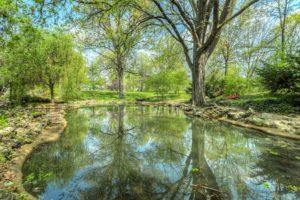
When you first get to the pond, walk around it and take it in together. Once you’ve done a walkaround, ask your child to find their own observation spot and have them spend a few minutes just watching. It can be anywhere they choose. Make sure they are within your eyesight. Don’t give them species to focus on or behaviors to look for. Just have them take in the big picture. Ask them to practice silent observation by keeping their movements small and their voices quiet.
After a few minutes of big picture observation, start zooming in on activity or critter that caught their eye. Ask your child to focus on one thing they noticed and tune into it. What is it? How is it using the pond? Who is it interacting with? What does it do in the pond? What does it eat or where does it shelter?
It’s amazing that the world right outside your home is full of opportunities for your baby to learn. All throughout the year, nature—even in a busy city—offers new colors, textures, scents, and shapes for your baby to experience. Take a stroll around the neighborhood or explore at a local pond with your baby, enjoy the fresh air, and collect some natural souvenirs for an outdoor treasure box.
Here are simple tips for your nature walk:

Allow your baby to get close to the ground and examine natural details—different types of grass, bark, moss, leaves, stones, pinecones, and soil may catch their attention. Collect one of each item into a container or basket.
Hunt around for some bugs! Talk about which insects crawl and which one’s fly.Look up at the sky and tell your baby about the weather and how it makes you feel (physically and emotionally).
Trees are full of lessons—help your baby feel the texture of the trunk by placing your hand over theirs and run them along the bark and count the other trees around you together.
Practice sniffing scents of flowers, grass, fruits, or berries in a garden if you have one.
If your child likes you to take photographs or create art outside, this is a great time to have them capture some of their observations for their Adventure Journal of the critters or other pond features such as plant life or the ripples on the water’s surface.

If you have an adventurous child, encourage them to engage more of their senses by experiencing the water, mud or get closer to the sounds of the pond. Ask them what they would like to touch: the fuzziness of a cattail, the gooeyness of mud, the sliminess of an algae-covered rock. Be sure to help them understand how to touch the parts of the pond they are interested in without disturbing the environment or hurting any creatures.
If your child really wants a full-on sensory experience, let them wade into the pond. This is a great way for them to experience how the water temperature, while fairly consistent, does range from bottom to top with the colder, denser water settling at the bottom while the warmer water is at the top. Ask them if they can feel this on their own?
Another fun experience is to feel the bottom of the pond on their feet. As most ponds have a muddy bottom, this should feel good. But there are likely to be plants, some rocks and even some critters like snails and sponges down there. If they are intrepid, have them reach in and pick up some mud from the bottom.
Bear in mind that some ponds can have jagged rocks on their bottom and some might have leeches in them. Leeches are found in shallow protected waters and are most active on hot summer days and at night. This nuisance critters are drawn to disturbances in the water near docks and swim beaches. To avoid leeches, swim in deeper waters off docks and floats. Leeches are mostly found in organic sediments or debris, so try to avoid these areas if leeches are known to be in the pond.
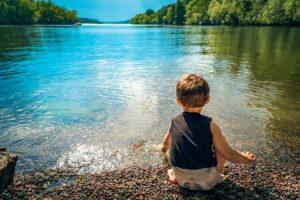
Pond water is a world onto itself! Have your child use their bucket to take a sample of the pond water and peer inside to see what they caught. It could be small fish, plants tadpoles, insects, or a whole lot of murky water. A butterfly or fishing net is also a great way to catch critters in the water or the air around a pond. Butterflies, dragonflies, and water insects love to refresh, eat, and drink on the water of a pond. Chasing these critters on the shore of the pond is a fun challenge for kids and one that not enough kids get to experience. Be sure they learn to be gentle when catching their critter. Once they take a gentle look, noticing the parts of the insect as well as its colors and patterns up close, help your child release the critter safely.
Let your and your child's imagination run wild as you explore this fascinating ecosystem together. Here are some more ideas for having fun exploring nature at a pond! Exploring ponds with kids isn’t limited to the water. A butterfly net can help you capture amazing creatures such as dragonflies, butterflies, and other flying insects, as well as water insects. Chasing a flying insect is a great hand-eye coordination activity—plus, it’s just fun! And when my children do manage to catch a butterfly or damselfly, they love to examine their vibrant colors and fragile wings. Every creature is so unique and beautiful.
Fun Things to do or with your baby
Find as many pond critters as you can with a Pond Scavenger Hunt.
Our free downloadable printable is here to help!
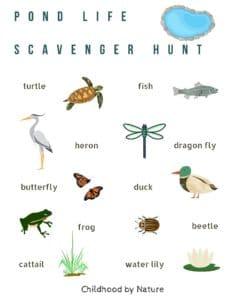
Observe dragonflies. Dragonflies are also called Mosquito Hawks or Devil’s Darning Needles. If you think there is just one species of dragonfly, think again! There are around 400 species of dragonflies in North America alone.
Scouting turtles. Turtles are pond lovers. They bask on rocks and logs to fill their body with warming energy. They scavenge dead animal and plant material and remove diseased or weakened fish, contributing to improved water quality and fish population health. In the spring, baby turtles (just tiny, mini versions of the big guys) are an absolute delight to find. Some aquatic turtles can absorb oxygen through the skin on their neck allowing them to remain submerged underwater for extended periods of time and enabling them to hibernate underwater. Look for turtle heads popping out the surface of the pond’s water. The soft-shelled turtle uses its long tip nose and nostrils like a snorkel to breathe underwater.
Look for and listen to frogs.
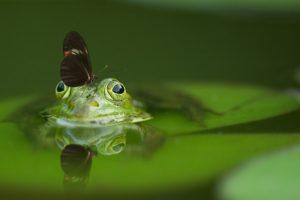
Explore Water Lilies. Why do they float? What lies beneath the surface? How do animals use them? Learn more at home. Then, go Monet & create a masterpiece of your own.
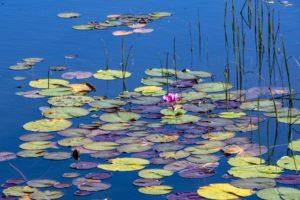
Go fishing. Aim for an early morning or evening casting time, when the fish are most active. You also need to make sure you're courting them with what they want. Pond fish are attracted to sink worms, jigs, and shallow crankbaits. If you know your pond is full of catfish remember to add catfish-specific bait to your tackle box! When pond fishing with beginners or kids, it's best to bring along live baits. Night crawlers, minnows, crickets, and waxworms will attract several fish species in a pond. These live baits can be rigged on hooks in sizes from 8 to 4 depending on the size of the fish species you are targeting.

Hope was taught to fish almost as soon as she could hold the fishing pole. By age three she was baiting her own hooks and pulling in her own fish. She loved it. The photo above is her reeling in her first trout in Colorado Springs.
My family lives in the Finger Lake area so my grandfather taught all his grandchildren and great grandchildren how to hunt and fish. Those lessons included some of his own wonderful and wild fish tales. LOL They were fascinating.
😊 More information on Pond fishing
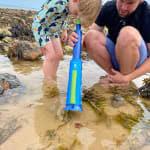
Bring along a water scope, or underwater viewer. Ponds are home to many animals, plants and organisms, such as frogs, different types of fish, algae and amoeba. In fact, most plants and animals can’t survive without freshwater biomes. Water scopes allow us to have the opportunity to discover the world below the surface of ponds. We bought the Educational Insights one. probably when Hope was two. She still has the smaller piece at age 24. You can buy one or make one using these instructions here.Make one of these handy tools by sealing a piece of glass in a bottomless bucket or water-proofed box.
Feed fish.Pond fish eat algae and other beneficial bacteria off the rocks and gravel in your pond. Wild koi (also known as the common carp, the domesticated koi carp’s ancestor) will readily eat aquatic insects, flies, algae, smaller fish, plants like water lily and water lettuce, snails, and frogs. Other pond fish are opportunistic feeders and will happily eat all sorts of plants and animals if they’re small enough to swallow!Although it’s not necessary, it can be fun to give your fish a summer snack from time to time. Pond fish will enjoy a little watermelon, orange slices, peas, and even Honey Nut Cheerios.
Make a magic wand out of cattails.
Feed waterbirds. The age-old debate is whether it’s safe to give birds a snack to birds or not. In fact, bread is not the best food to give waterfowl as it fills them up without giving them the nutrients they need.
Bird experts recommend small amounts of grain such as wheat, corn or bird seed, plus fresh chopped greens like cabbage or spinach, as these will supplement the birds’ natural diet and help provide the birds with the necessary nutrients to keep them healthy.

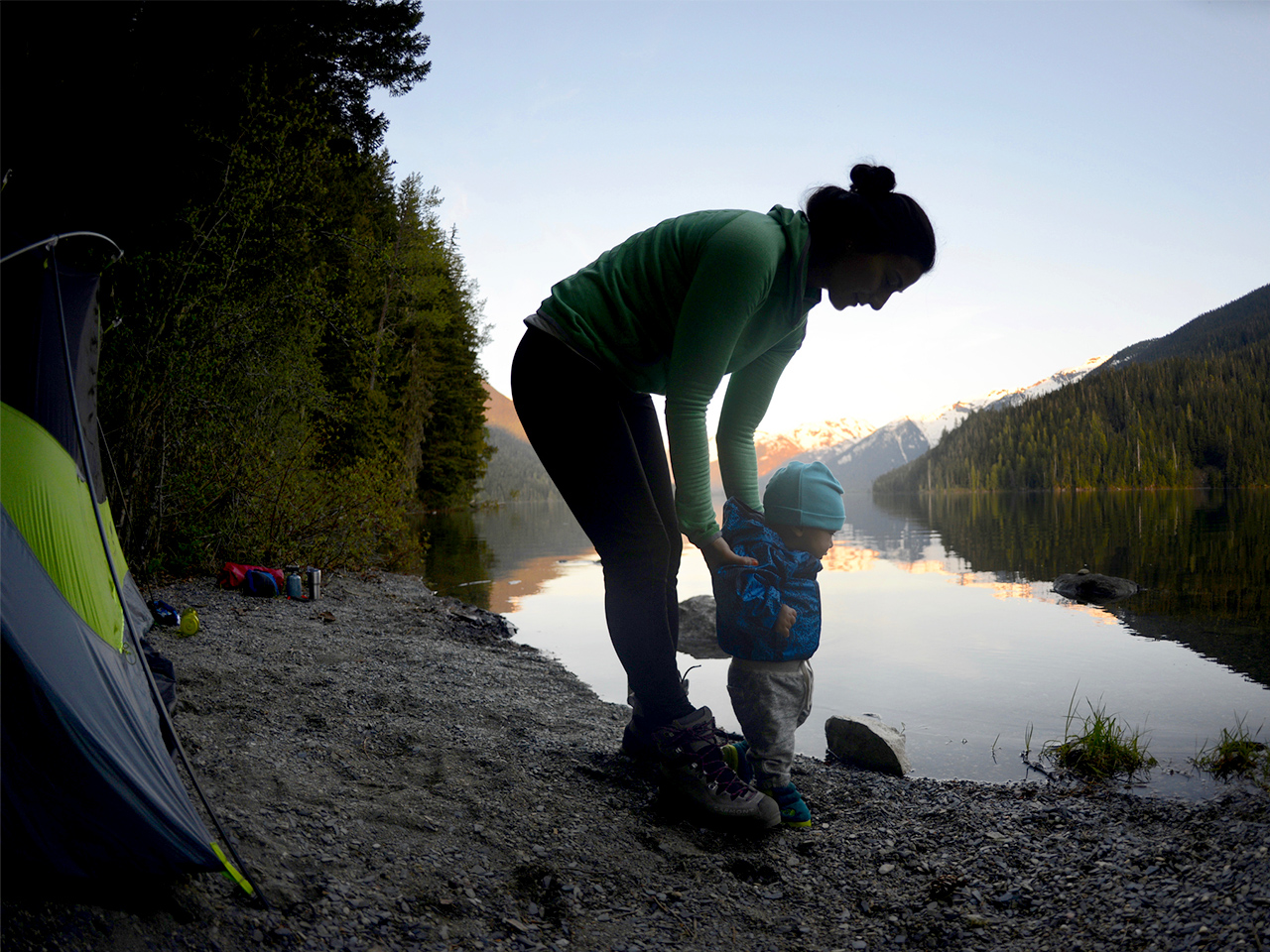
Watch the clouds or the shadow of the sunlight in the trees. Let toddlers chase their own shadow and compare their shadow with yours.
Being Fascinated with Lakes
Being Fascinated with Lakes
My kids are fascinated with nature because I am fascinated with nature. Even things that may seem mundane to me at this point in my life might be new and exciting for kids. That is why I practice child-centered exploration and make sure to get excited about whatever they discover. When I get really into the activity, it acts as the match to spark curiosity and adventure in my kids. So, get pumped! Yes, even if you don’t feel it. If you want your kids to have this connection to nature you must demonstrate it yourself.
That being said, I need to give parents a tip. Playing in the lake, kids will get wet and most likely dirty. Be prepared with towels and either wear waterproof clothes or bring a change. Water shoes are also recommended if you don’t know the lake.
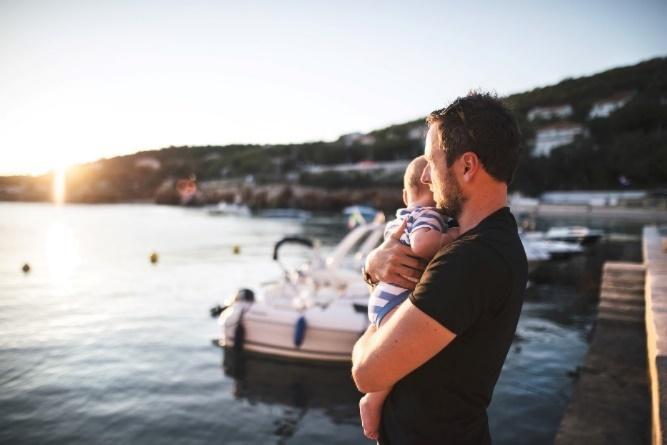
Taking Baby to the Lake Tips
There are few things better than going to the lake on a nice sunny day. In most cases, you don’t have to deal with the traffic at the beach and there’s usually a lot more shade provided by trees planted in the grass. The lake is a great place to make memories that will last a lifetime and you don’t have to wait until your baby is older. As long as you take the necessary precautions, taking baby to the lake is something you can do throughout the year. However, depending on where you live in the world, you’ll probably want to wait until the summer months. The lake is a lot more enjoyable when the sun is shining.
Whether you have found a lake while on vacation or there’s one in your city, you might as well take time to enjoy the beauty of nature. Below are tips for taking baby to the lake that will make the experience fun and safe.
1. Avoid Peak Sun Exposure
Going to the lake is obviously something that you’ll want to do during daylight hours. As with many other outdoor activities, it’s best to engage in them when the sun is shining and the birds are singing. When taking your baby to the lake, you’ll want to avoid peak sun exposure, which is during the timeframe of 10 a.m. and 4 p.m. This is when the UV rays of the sun is at it’s peak. If you don’t want to go before 10 a.m., you can certainly have a great time after 4 p.m., especially during daylight savings time when the sun sets later in the day. It also happens to be a great time of day to take family pictures.
2. Find a Location with Shade
When taking baby to the lake, one of the first things you’ll want to do when you arrive is to find a location where there is plenty of shade. Since it’s a lake, there are likely to be a number of trees in the area. The shade of a tree is a great way to combat exposure to UV rays. While you can certainly take other precautions, this is an added bonus. Shade can also keep everyone a lot cooler. There’s no doubt about the fact that sometimes it’s just too hot outside to feel comfortable. When you find shade, your outdoor experience will be a lot more enjoyable.
3. Be Sure to Cover Up
A priority when taking baby to the lake is being sure to cover up. A baby’s skin must be protected from the sun and one of the best ways to do this is by choosing articles of clothing that are lightweight, yet still protect the skin. While there are some days when it’s too hot to wear a lot of clothing, it’s still a good idea to wear lightweight clothes for sun protection. The good news is that there are a lot of fashion choices for babies that can help with covering up. In addition to lightweight clothes, you can use little bonnets and hats to protect your babies face. You’ll be able to take adorable pictures because babies look so cute in hats.
4. Bring Baby Sunglasses
Studies have shown that a baby’s eyes do not have the ability to block UV rays to the degree that adult eyes can. Fortunately, there are baby sunglasses on the market that you can buy for your trip to the lake. Most people use baby sunglasses because they look so cute. While they are likely to be a topic of conversation, baby sunglasses are also functional and a great form of protection when taking baby to the lake.
5. Provide Plenty of Water
If you’re like most people, you probably drink plenty of water throughout the day. If so, it’s not just a habit, it’s a necessity. The same applies when taking baby to the lake. Just like you need to drink water to ensure you’re hydrated, your baby needs water too. When you’re at the lake, it’s a good idea to ensure everyone there drinks water to stay hydrated. If you’re still breastfeeding, that can help to keep your baby hydrated, but that doesn’t mean there isn’t still a need for water. To make it easy to stay hydrated, try drinking water every hour. In addition to preventing dehydration, you’ll feel better, especially if you bring cold water and keep it in the cooler during your trip to the lake.
6. Choose a Lightweight Baby Carrier
There are all kinds of baby carriers on the market. Some are bulky and sturdy, while others are more lightweight, but still effective. When taking baby to the lake, you’ll need a lightweight carrier that’s breathable and circulates air effectively. This is for the comfort of you and the baby, especially during the summer months. If you decide to take your baby to the lake during the spring or when it’s not as hot outdoors, you can use a standard carrier. Don’t forget to choose one that’s also ergonomic.
7. Don’t Forget the Sunscreen
Without a doubt, one of the most important things you’ll need to remember when taking baby to the lake is the sunscreen. Sometimes it’s easy to think that only adults need sunscreen, but that is definitely not the case. It’s generally recommended that you choose an SPF that’s a minimum of 30 to protect your baby’s skin. Adults often spend time in the sun because they want to get a good suntan. Your baby obviously doesn’t need a suntan, so you’ll want to take every precaution to keep your baby’s skin protected.
8. Be Flexible
When planning time for taking baby to the lake, you’ll want to schedule the trip, but maintain flexibility. This is because anything can happen with the weather, even during warm months. While it might seem like a good day, bad weather can make a trip to the lake a disaster. You might as well avoid as many difficulties as possible by monitoring the weather to ensure it’s the best time to go. If there’s a chance of rain, you should plan your trip for another day. You’ll also need to be flexible about the activities at the lake because you don’t want to do anything that could put your baby in harm’s way. Time at the lake should be an enjoyable and relaxing experience with your baby and other family members.
9. Pack a Blanket
While taking baby to the lake can be a lot of fun, you have to be prepared to make your time there comfortable. By packing a blanket, you can create a comfortable space where you can lay your baby down for a few minutes or let your baby crawl around without getting on the grass. While there’s nothing wrong with your baby spending time on the grass, the blanket is better because you won’t’ have to worry about as many pests, like ants. A blanket is also great because you can have a picnic on it. Just don’t forget to fill the picnic basket with all of your favorite summer fruit.
10. Prepare For An Emergency
An emergency can occur when taking baby to the lake, so make sure you’re prepared. Just like anywhere else you decide to go, it’s a good idea to pack supplies for emergencies. This might include ice, bandages, disinfectant wipes, and anything else that you would typically find in a first aid kit for children. You might also want to include medication if you plan to be away for a long period of time. It’s possible to spend hours at the lake if you take plenty of food with you.
11. Bring a Few Toys
Since your time at the lake is probably for the purpose of having a good time, one thing you’ll want to bring is a few toys. Most babies will enjoy playing with a toy regardless of the location. You can choose to bring the toys that you know your baby will enjoy. In fact, you can also bring books so that you can spend time reading to your baby at the lake.
12. Choose Swim Diapers
Although taking baby to the lake might not involve going into the water, there’s a chance that you might decide to do so. If that happens, you should make sure your baby is wearing swim diapers. The last thing you’ll want to do is use regular diapers because your baby can end up being uncomfortable. If you know for sure that you can’t go into the lake water due to issues with possible contamination, there’s another option. You can bring a baby pool instead. A baby pool can be great because it doesn’t require a lot of water and your baby can enjoy time outdoors in water on a beautiful day. You can fill up the pool at the lake or bring water since a true baby pool is very small.
These are all ways that you can maximize the enjoyment of your time at the lake with your baby.

Lakes are a fascinating place, an ecosystem in their own right. They sustain entire life cycles of plants and animals in their own space. In the summer they hum with life, providing a vibrant atmosphere to explore. From the birds and insects filling the air with song to the fish flashing by in the water and the bullfrogs calling just out of reach, they are a child’s paradise of discoveries.
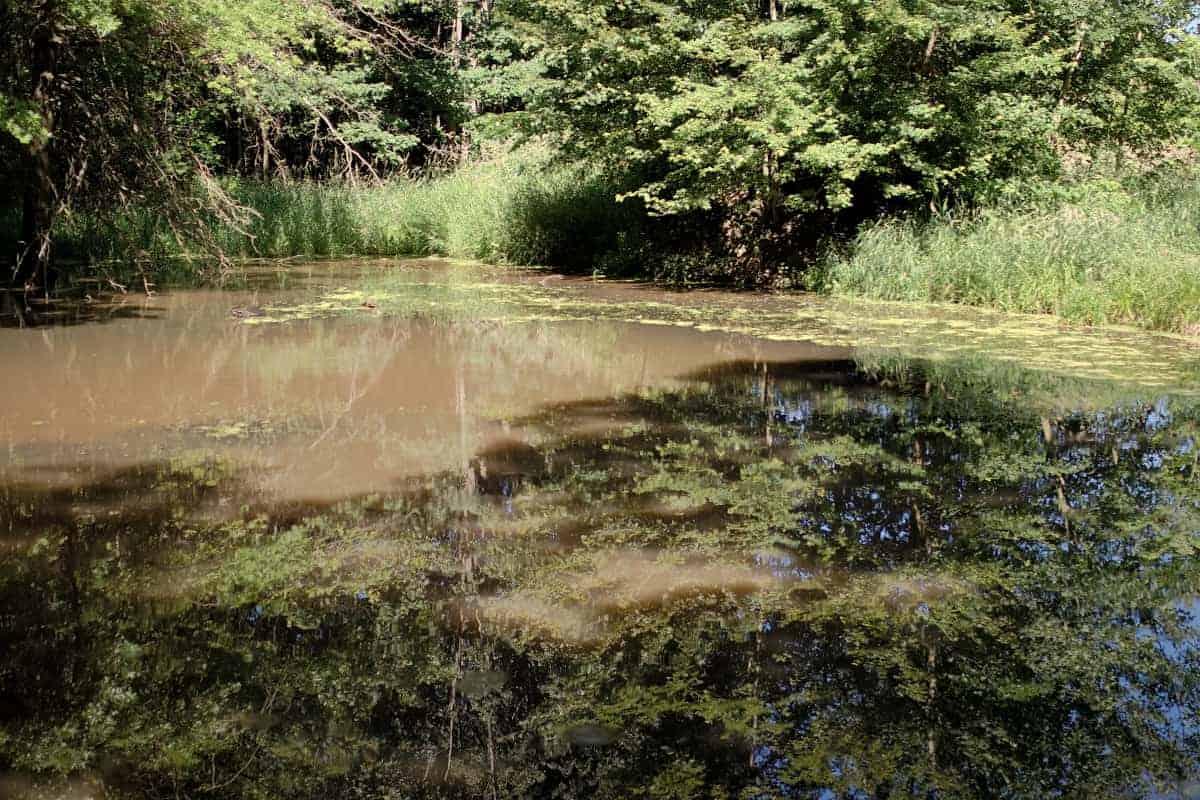
Exploring lakes or any freshwater with kids is also timelessly interesting, entertaining, and relaxing. Most children can find an endless number of interesting occupations at a lake. I can never believe how long my kids will spend just tossing rocks or sticks into the water. And I’m amazed at how beneficial that simple activity is: building strength and developing motor skills, making them aware of cause and effect, and introducing them to basic physics (gravity and displacement, for instance). Today, we will look at just a few ways you can experience a lake with your children, weaving education and development together with delightful play.
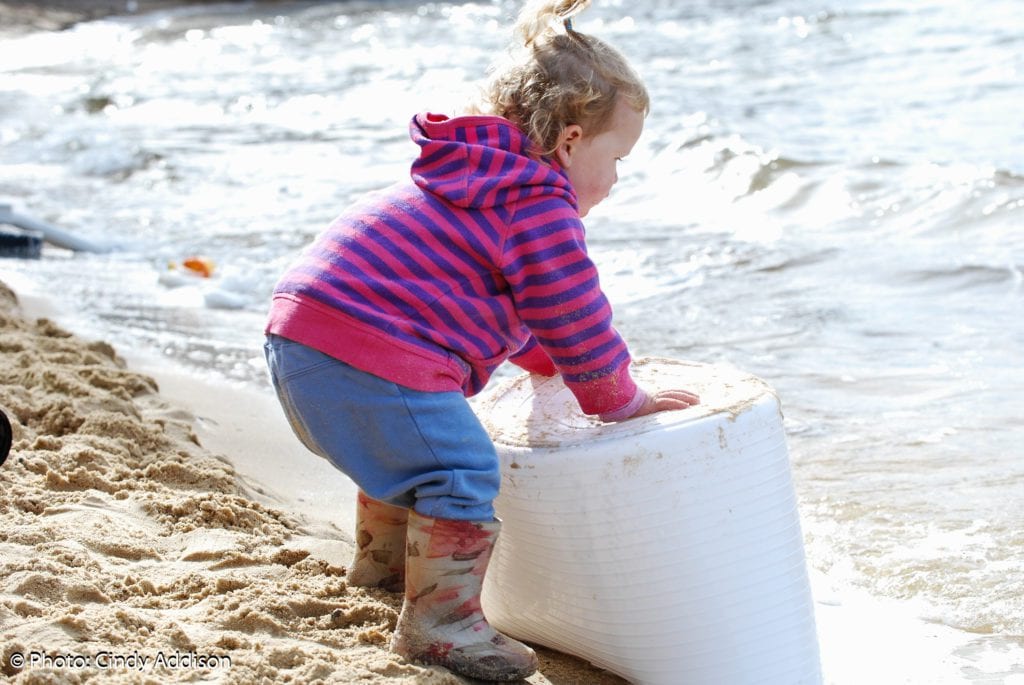
How To Have A Safe Lake Trip With Your Baby
Safeguard against dehydration
Purchase an infant PFD (personal floatation device)
Avoid Peak Sun Exposure
Find a location with shade
Protect their skin when in the sun
Protect their eyes
A popular lake day activity is boating. While babies are able to board, they too must follow the state laws. Most states require that everyone on board have a PFD. The Stingray Infant PFD is a great choice because it is US coast guard approved and uses bright colors so your baby is easily visible. In addition to these necessary features, this life jacket is made from a durable and quick-drying Nylon fabric with quick-release buckles.
Even if you don’t have plans to boat, it’s best for a baby to wear a PFD anytime they are in the water.
Lifejackets- Babies under 35 pounds are not big enough for a baby lifejacket. They can die from suffocation when they slip inside the lifepreserver without you knowing.
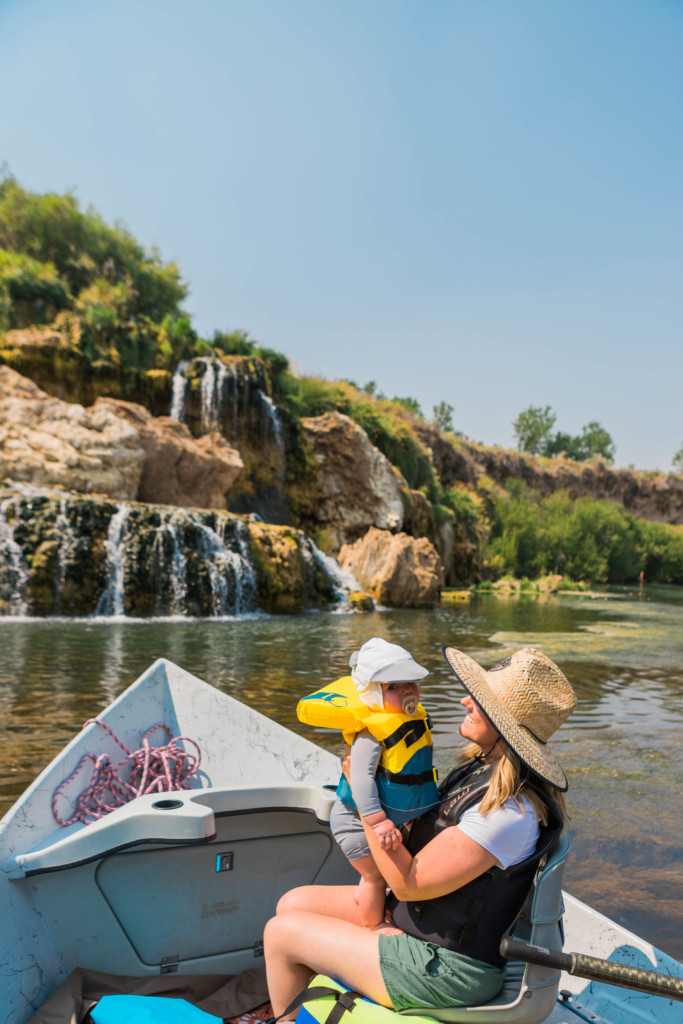
Safeguard against dehydration
During a hot day, it’s easy for adults to dehydrate quickly. This is even more true with infants. Come prepared with extra bottles or plan to nurse more frequently if currently breastfeeding. If your baby has reached the age where they can start eating solids, consider bringing a couple of servings of food that are travel-friendly. A great example of this is fruit/veggie pouches.

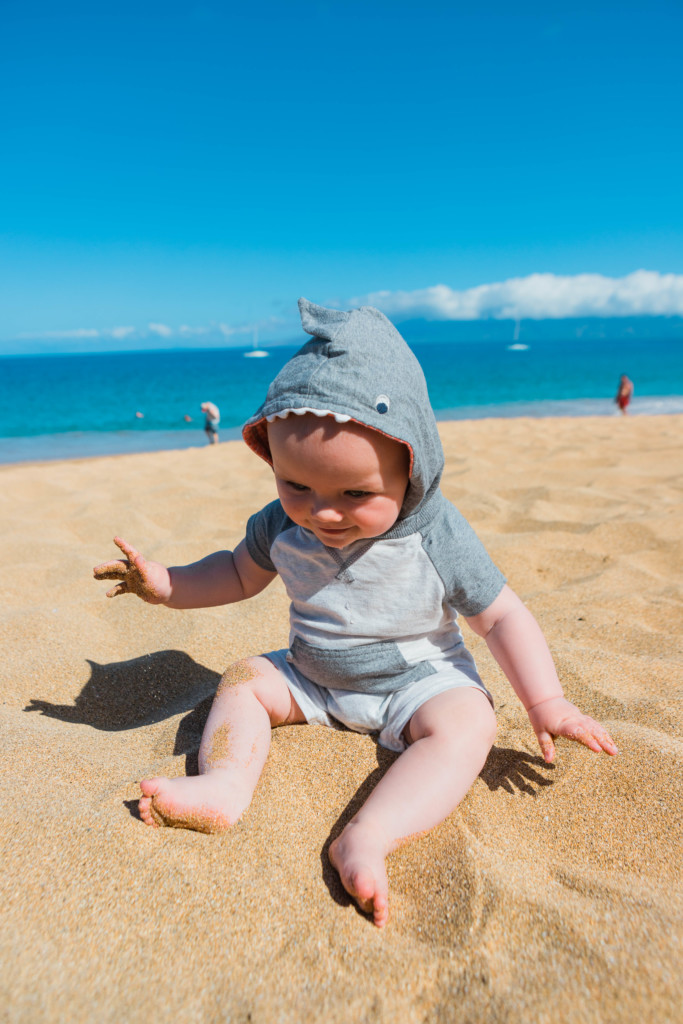
Read more- How To Successfully Vacation In Ft. Lauderdale, Florida With A Baby
Avoid Peak Sun Exposure
A lake day might look a little different with an infant because of the fact that you’ll want to avoid peak sun exposure. These hours generally fall between 11 a.m. and 4 p.m. Getting an early or late start to the day might also be a great way to beat the crowds! If you can’t avoid these harsh, daylight hours, read below for some additional tips.
Find a location with shade (or take shade tents)
One of the first things you’ll want to do when getting to the lake is finding a great spot with plenty of shade. No sunbathing for the baby! In addition to finding natural shade given by trees, feel free to bring a sun canopy or umbrella that has UPF protection. Trust us, keeping cool not only protects their delicate skin, but it will help with their mood!
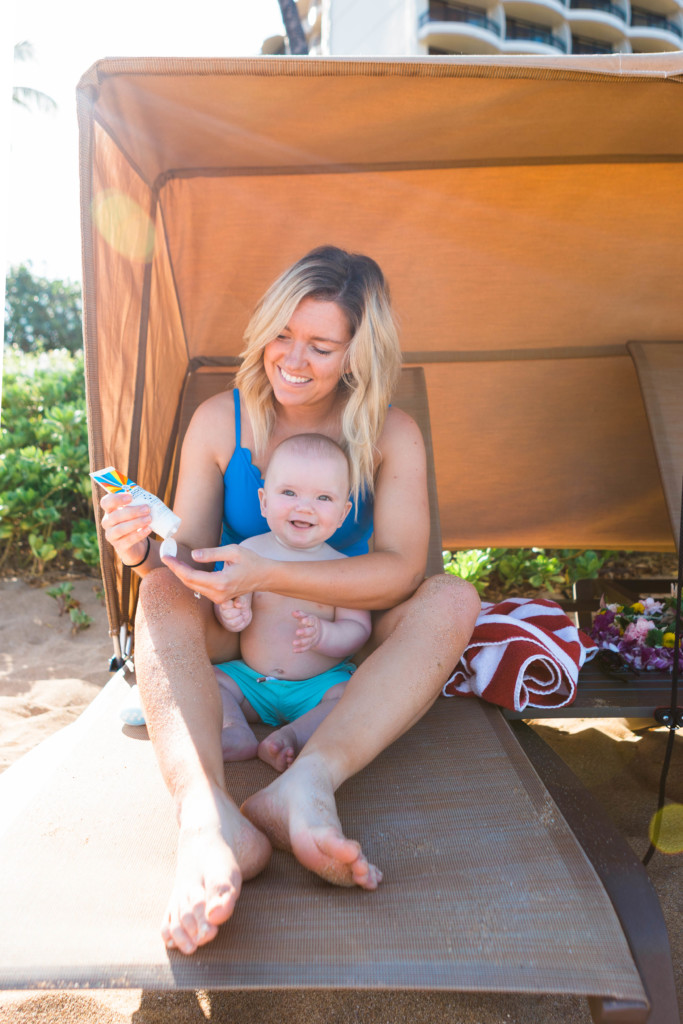
Protect their skin when in the sun
You probably don’t want to hide out in the shade all day at the lake. This is when you need to be especially careful about sun exposure. The US FDA recommends avoiding sunscreen for infants that are under the age of 6 months. Choose UPF clothing that covers them as much as possible. In addition, always keep a sun hat on your baby that protects not only the tops of their heads but the back of the neck and ears.
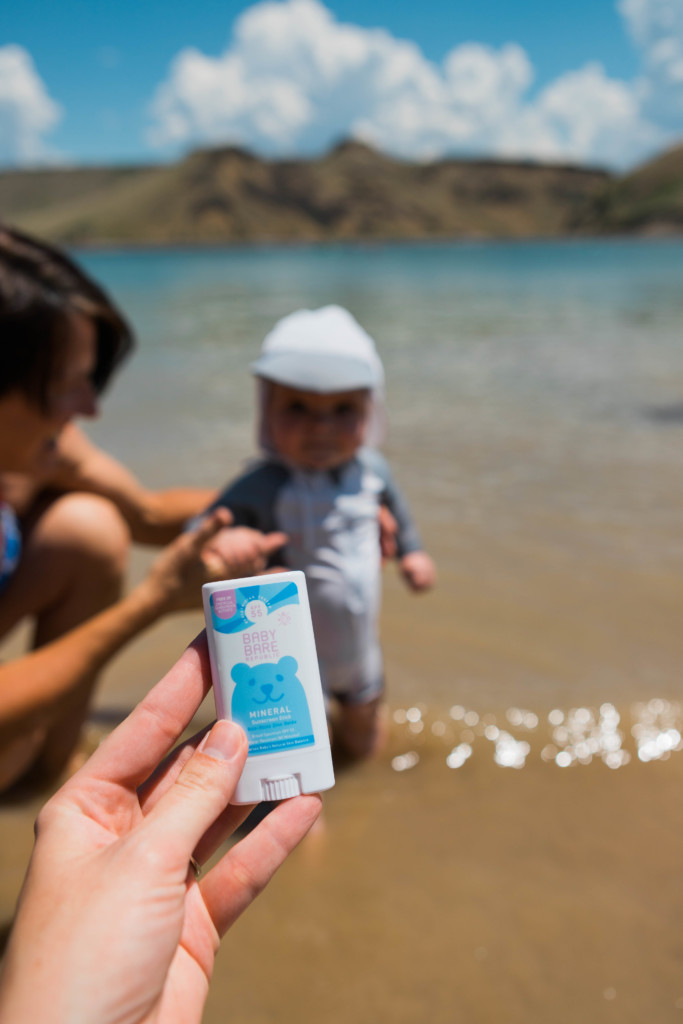
Read more- Baby Travel Essentials For 0-12 Month-Old Babies That Will Save Your Vacation
Protect their eyes
While baby sunglasses don’t seem to be the most practical item to bring to the lake, they can be very helpful! Recent reports have suggested that babies’ eyes lack the ability to block UV rays to the same degree that grown adults can. These may be foreign for a baby to wear so practice several days before getting your baby used to feeling them on.
earance, components and value
Exploring The Creeks & Streams

PLAYING DOWN AT THE CREEK
Some of my fondest memories as a child are of playing in creeks with my sisters and brother and other neighbors. We could spend hours playing, exploring, learning, and cooling down on a hot day. We were late for dinner all the time – sorry mom. Our creek was a treat to play in and take a picnic lunch for a longer visit. It was down at the bottom of a treacherous hill on a dirt road. So we were much older when we were allowed to go by ourselves.
There’s something special about the water, moss, rocks, small creatures, and plant life that you find in and near creeks. Something magical that is different from any other shore. There is so much to find, explore and do that the hours will fly by like minutes.
Find places to snuggle or just connect with your kids outside. Every inch that we explore with babies is all new to them. Warm like a blanket, your hugs envelope your baby in the safety and security of your arms where they feel the love you can't tell them yet, but they can feel brimming from your heart. This is the beginning of them knowing they can rely on you, to trust that you will be there for them. An added bonus is when you spot a hummingbird, a butterfly, or a cute rabbit while you’re there.
Make special hideouts for your littles. For some little ones being in a great big space may feel overwhelming. Creating little hide outs, forts, or playhouses is a great way to keep baby feeling snug and secure in the natural environment.When my oldest was young, she and her cousin had “the digging yard,” which was a patch of dirt under the branches of an ancient forsythia bush where they took digging trucks and basically just dug things. Endless hours of fun! Building special places for your kids
Get Outside & Connect Activity
– Play in a Creek.
I always loved it when my kids asked to play in a creek. If you don’t know of a creek near you call you local parks and recreation department. They will be able to point you in the right direction.
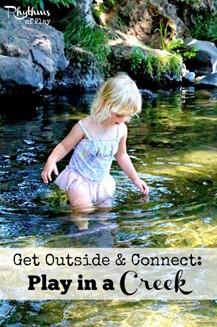
There is so much to explore and do around creeks. From learning about the plants and creatures that live there, to engaging in pretend play you can always find something to do.
We watched some boys play pirate ship, another family building a dam, some other kids having a water soaker war, and another group chasing after fish and tadpoles. My daughter has an endless fascination with rocks. As you can see below, she was in heaven at this particular creek.
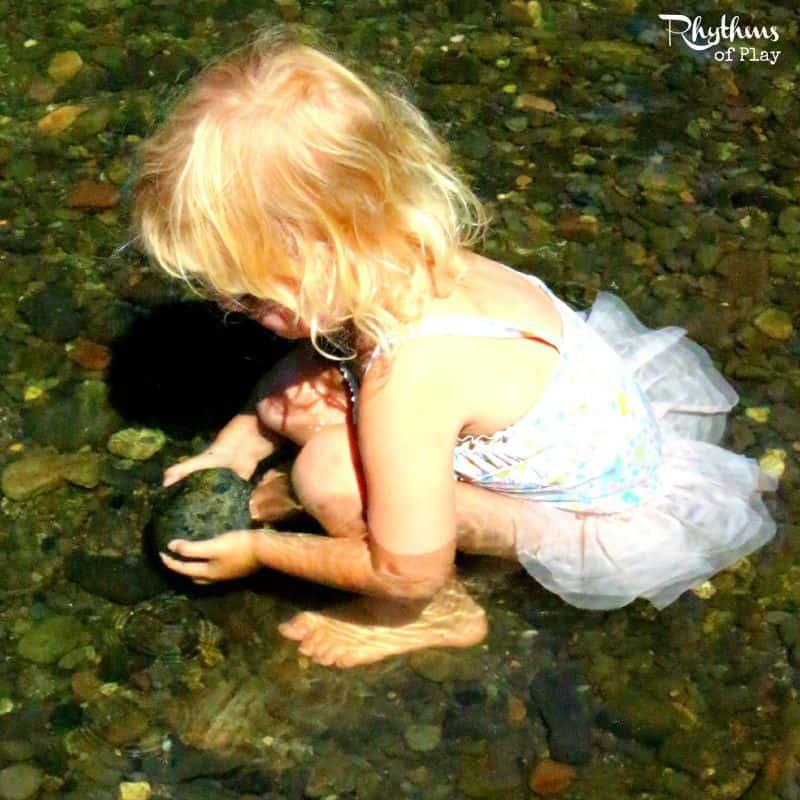
Playing in a creek is a perfect activity on a hot day. On the day these pictures were taken the temperature was 108 outside, but you would never know it down by the creek. As I walked around with my feet in the water in the direct sunlight it felt like it was only about 80 degrees – and I was still completely dry except for my feet!
I was so comfortable in the coolness of the creek I forgot how hot it actually was. Below you can see me happily chasing after one of the little peg doll boats I made with my daughter.
My daughter was not as happy about them floating away. I think she missed the point – haha! She was so attached to our creations she had to put them all away.
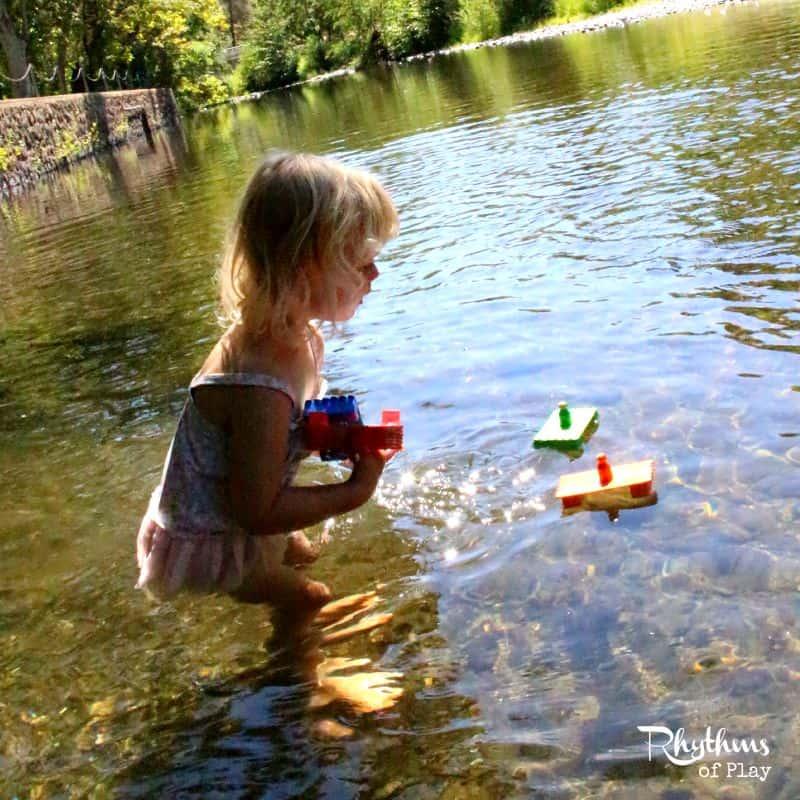
But that was okay because we quickly found something else to do. There were huge tadpoles everywhere. They were so big they were about to be frogs. Can you find it in the photo below?

There were also lots of shells to collect, and a fallen tree that created a tunnel cave that my daughter stood at the mouth of for quite a while. I could tell she wanted to go in… but she didn’t dare.
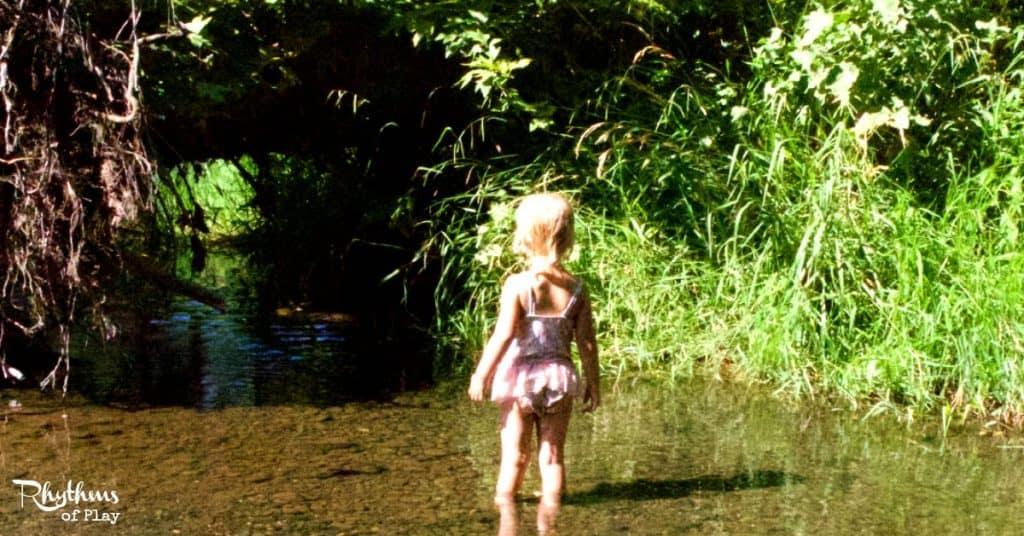
It wasn’t long before we were completely immersed enjoying the water on this very hot day. There was one point where I actually started to feel cold. I had goosebumps and I wasn’t even in the water anymore. Did I tell you it was 108 out?
It was a wonderful afternoon that passed too fast. My daughter wailed when we had to leave, but what kid wouldn’t? I never made it home in time for dinner either remember?
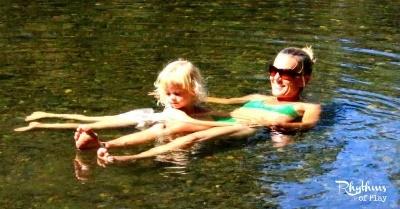
Get outside and play in a creek this week. I promise you will love every minute of it. Be prepared to go eat on the way home or have a crock pot going like we did or you won’t be home in time for dinner either. 😉
Our Family Creek Expeditions:
To start off exploring the area with kids, simply walk around the area. Talk before you start about how everyone needs to use their “nature skills” to explore the area. These skills include walking quietly, speaking quietly, and trying not to disturb the wildlife around you. We always have to work on sharing our discoveries quietly—the first child to yell they saw a goose will probably scare off the whole flock! This is also a good time to teach children how to study nature without disturbing it, to observe but not take, and to show respect for the natural environment surrounding them by being careful where they step and what they touch.
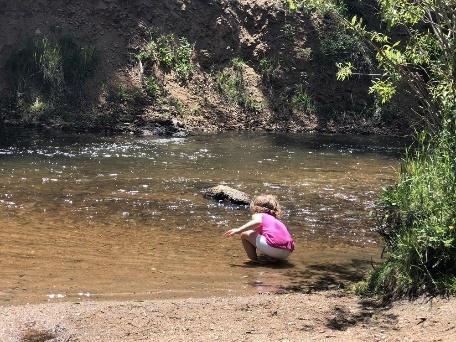
I realized recently how fortunate we were to have live close to Kittridge Park in Colorado. It’s just as pretty as any state park–but without the entrance fee! Hiking, playground, and swimming are especially great there during the summer when the water is warmer. But it slows down in the summer making it fun for little ones. They have a great play area in the front as well. The girls and I frequently decided to take advantage of the fact that the creek was pretty warm in the afternoons so our little expedition down to the water would last longer. What I loved about this park was that there were different sections that were used by different age groups, so the little ones had their own section to explore.
We found it was just easier to check a park out for that very feature prior to taking a toddler there. Plus, then you will also know what gear and equipment you will need to add some pizazz to our adventure.
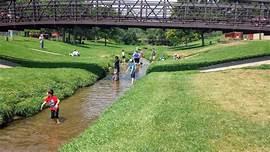

My favorite park creek is in a suburb of Denver called Englewood.“There's a beautiful wadding stream that runs through, lots of shade to pull up a small tent and relax.”I always enjoyed the splish splashing of the creek and the giggles of my 2 favorite girls and my sense of time temporarily deserted me every time that we went there. There is nothing quite like it, on this side of heaven…It is definitely my happy place. However, parts of Englewood’s Belleview Park’s creek can get crowded with older kids, but we found many quiet, shallow areas towards the back of the park just right for littles to do their splashing and exploring.
The petting zoo or playground in the park were a good distraction if we decided to wait until older crowds cleared out.
Obviously, we learned that the best times to take babies or toddlers to city parks are school hours, rather than weekends.
There are very few things my kids loved more in life than playing in the water. They get super excited about rainstorms because they know they can jump in the puddles. That’s why going “creeking” with the kids is one of our favorite family activities – it combines the kids’ love of water with our love of exploring the outdoors.
There are so many incredible benefits to taking kids creeking. Not only do they get plenty of fresh air and sunshine while creeking, but they get to wade through the cool water, catch minnows, tadpoles and crawdads, hunt for fossils, climb over/around obstacles, skip rocks, build dams, observe wildlife, and connect with nature in a very personal way. When kids go creeking, they become a part of nature – they’re surrounded by it, immersed in it, touching it, and exploring it in ways that they can’t by standing on the sidelines.
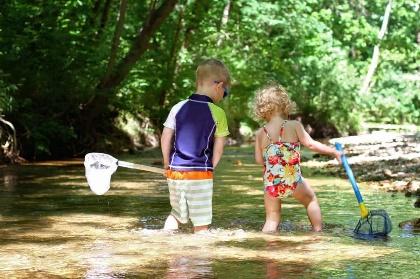
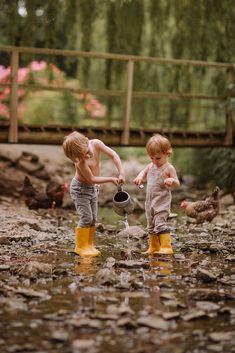
Benefits of creeking
I don’t have any hard scientific data to back me up here (although I’m sure I could find it if I looked), but I’ve seen amazing things happen when kids that have never experienced creeks get to play in one for the first time. We love taking our friends and their kids to creeks in our area (we’re familiar with a lot because we love them so much). I’ve noticed that getting kids in the water in a little creek does something for them that’s hard to explain – it gives them a sense of adventure and independence and freedom. When parents give their kids permission to get wet, dirty and explore on their own, it promotes self-confidence and encourages curiosity and exploration. Shy kids become bolder. Clingy kids become more independent. Kids that don’t like bugs or worms suddenly become more interested in them.
Creeking also helps kids in a multitude of other areas – walking through a creek helps with balancing and stability (rocky creeks are unstable terrain), encourages problem-solving (how to get from one side to the other), teaches about life stages of nature (from tadpole eggs to live bugs to dead fish) and prompts kids to ask questions about nature and the environment that they might not otherwise think of. My 4 year-old asks some of the most amazing questions while we’re creeking, like: Is this a dinosaur tooth? Is this the same kind of water that’s in the river? Do fish eat rocks? Why is the water cold? What kind of fossil is this? Where do frogs go at night? Why does that tree look like that? Is that a crocodile? Where can we find a snake? If so, can we take it home with us?

Necessary gear
Exploring creeks with kids is a wonderful activity to do in the summer when everything’s lush and green and thriving. Wading through cold creek water is the perfect way for kids to cool off without having to spend the day at a packed public swimming pool or running up your water bill and flooding your lawn with the sprinkler. Creeking seems to be a thing of the past and not a lot of people are out there exploring them with kids – you’re likely to have an entire stretch of any given creek to yourself. It’s also completely free and can be done with very minimal gear.
Other than sunscreen bug spray and swimsuits, I recommend nets and water shoes for the kids – something to give them some stability and grip but keep the rocks and sand out (post coming soon on great summer shoes for kids). Polarized sunglasses are helpful for letting kids see underwater, although not necessary. If you want to keep something you find, bring a bucket or a small fish tank. And make sure to bring a change of clothes for the ride home – that way it’s totally ok for the kids to get as wet and dirty as they want.
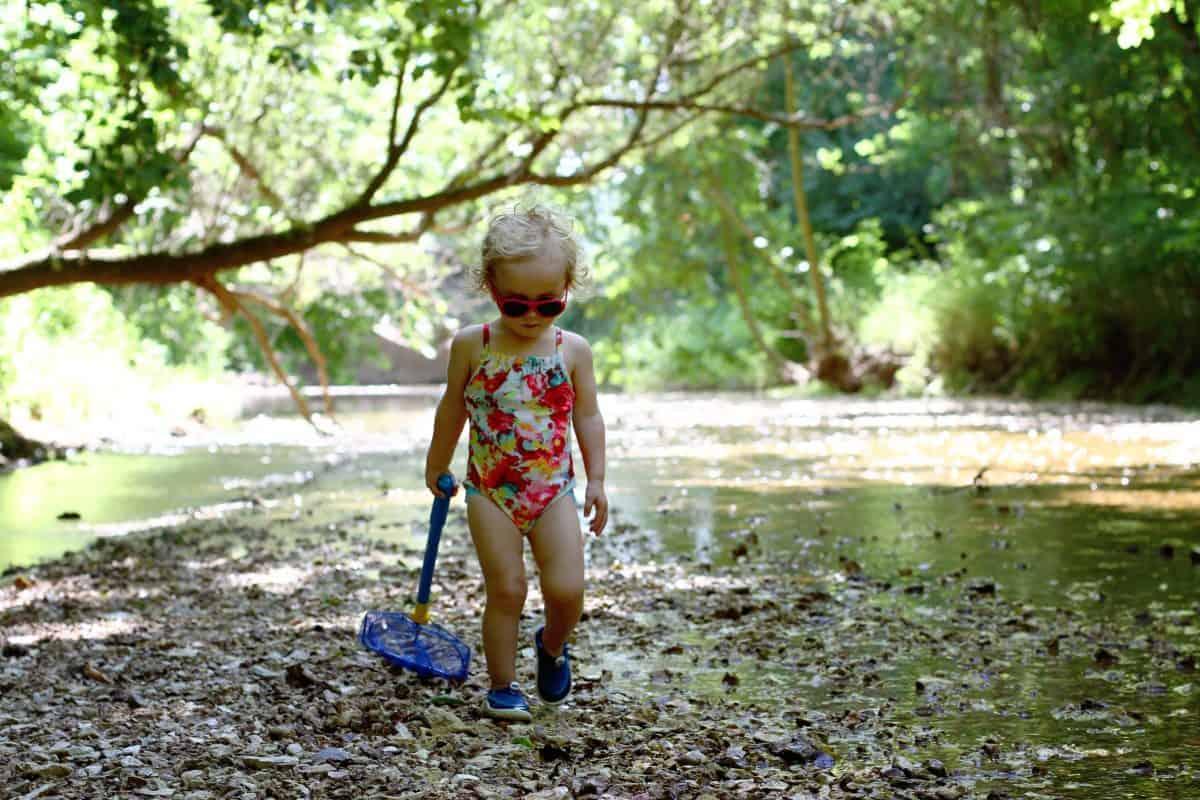
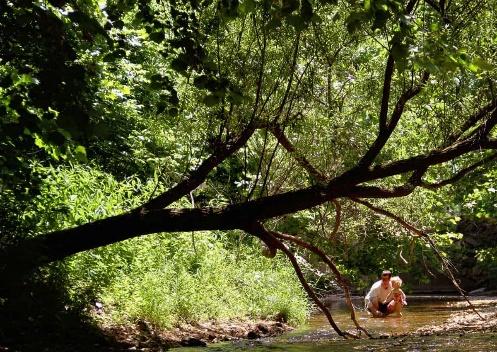
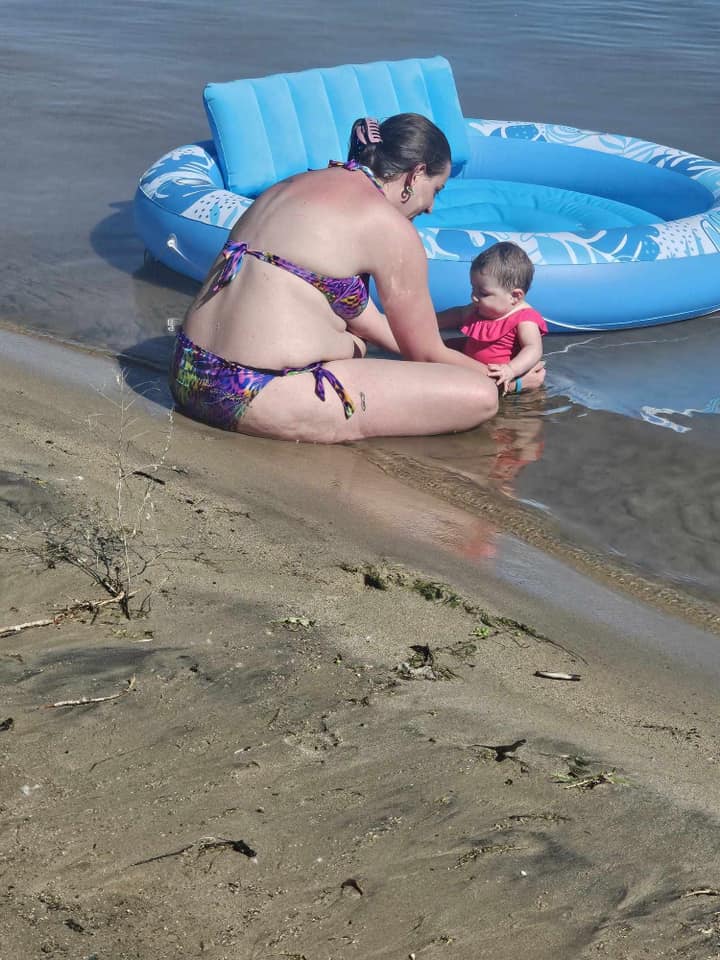
Locating a creek
Creeking is a great activity for kids of nearly any age (my kids started before they were 2) and can be done almost anywhere in the country…so long as you know where to look. Knowing the location of a good creek is probably the hardest part about creeking and is possibly what prevents most parents from taking their kids. Once you have checked out a park yourself, you will know what nooks and crannies that will delight your little one. Remember to shop for or make proper sized exploring gear for them if they are older.
River Trip with Baby
Learning About Waterfalls and Rivers
How to Take Your Baby on a River Trip
Taking a tiny human floating seems intimidating, but it doesn’t have to be
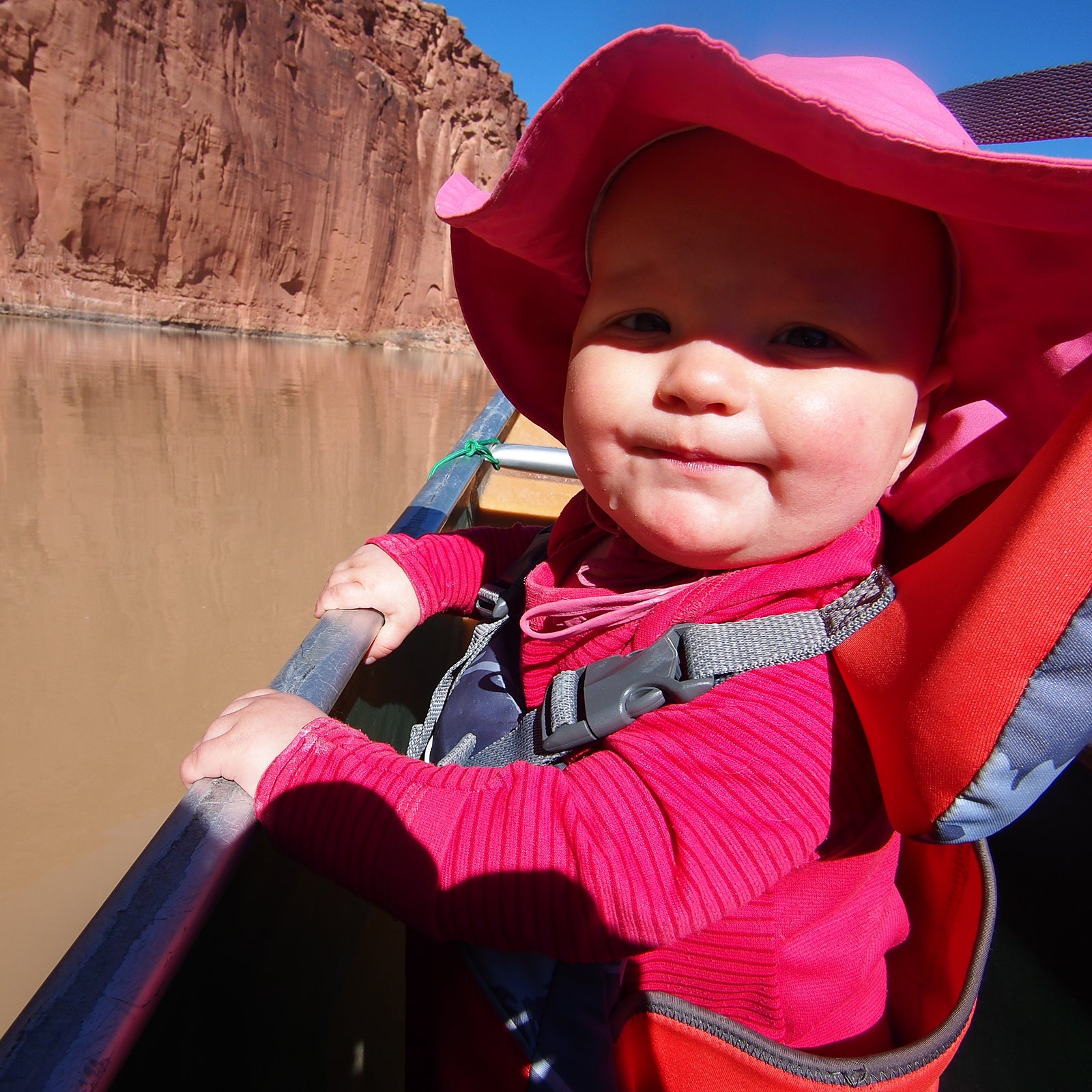
High Five
Every March, when we’re sick of winter but too impatient to wait for spring, my husband and I drive to the desert to go paddling. The rivers of the Colorado Plateau run muddy with snowmelt, and the sun feels like heaven. Weather on these trips is variable—we’ve been snowed, rained, and hailed on—but the quiet canyons and starry nights are worth the gamble.
This year, though, there was an even bigger variable: our daughter Josephine, who was 11 months old and had never been in a boat of any kind. How would she react to spending hours each day in a canoe or raft? Would she sleep when nighttime temperatures dropped into the thirties? And was it foolhardy to take her so deep into the wilderness that you couldn’t easily hike out?
Still, as the snow continued to fly at our home in Colorado, I couldn’t stop daydreaming of a 45-mile stretch of calm water that flows through Utah’s Labyrinth Canyon. I’d been reading Alan Kesselheim’s book Let Them Paddle, about canoeing with his children, and the fact that he’d taken an eight-month-old on a month-long expedition down the Yellowstone River made my idea seem tame. For additional inspiration, I reread a few chapters from Mardy Murie’s classic memoir Two in the Far North, in which she takes her six-month-old on a four-month Arctic river trip in the 1920s, long before GoreTex and disposable diapers. Clearly, I rationalized, humans have been taking babies down rivers for millennia.
Despite those two books, there’s relatively little information about how to pull off a multi-day river trip with a little one. Apart from a few tips I gleaned from Murie and Kesselheim, we were mostly winging it. As I made lists and packed meals and stuffed clothes into drybags, I was slightly terrified that the minute we were stuck in the bottom of a canyon with a wailing baby, we’d regret leaving the house.
There were indeed a few times when we were stuck in the bottom of a canyon with a wailing baby. But I never once regretted it. Here’s how we pulled it off.
Buy a Good PFD
One of the smartest things I did when pregnant was to use my baby shower to convince friends and family to buy me fancy outdoor baby gear, including this bomber PFD from Level Six. This one is comfortable, doesn’t ride up, and will fit for several years. I also made my daughter wear it around the house for a couple weeks so that she was used to it before we got on the water.
Choose Your Destination and Boat Wisely
First, your destination: You want water with easyrapids (Class I) or none at all, in an environment where you’re already comfortable with backcountry travel. Then, choose your craft. Kayaks are not practical with a baby. Rafts can haul lots of gear and people but are slow, heavy, and often have standing water on the floor, which means no dry place for an infant to hang out other than in your arms. Canoes, on the other hand, are practically made for babies. The gunwales are the perfect height for a standing baby to hold onto, the hull stays mostly dry and offers a solid surface for playing or napping on, and they’re easy enough for one person to paddle if the other needs to hold or feed the kiddo.
Learn A Paddle Sport
Any sport that requires two people to operate a single machine—like tandem bicycling or canoeing—is a fight waiting to happen if you don’t know what you’re doing. Before you push off with a baby on board, get on a local lake or river and practice paddling with your partner. Master the J-stroke, reverse stroke, and pry and draw, or consider taking an introductory course from an organization like the American Canoe Association. Once you get into the backcountry, there will be plenty of things to stress over; your J-stroke doesn’t have to be one of them.
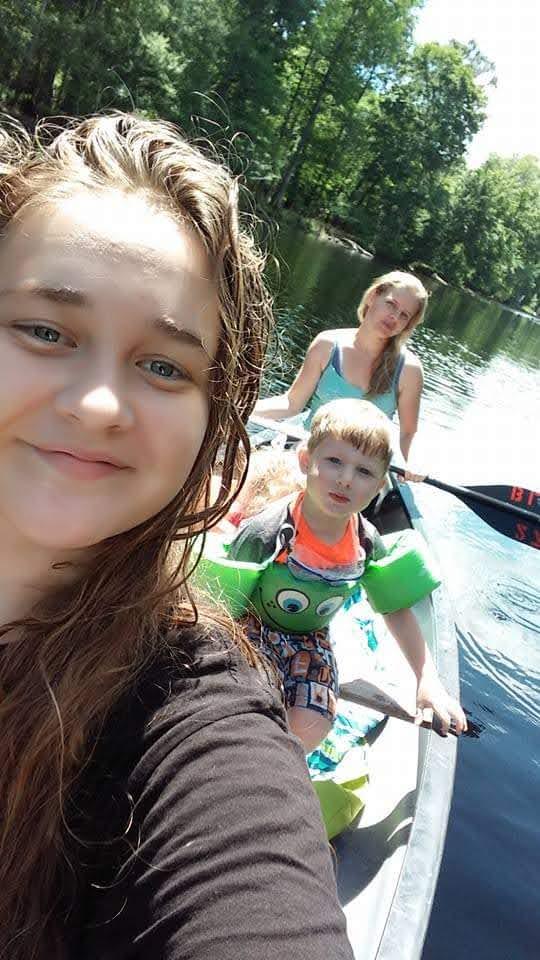
Kayaking with a Baby: Tips for Safe and Joyful Water Bonding
Aug 17, 2023 — The rulebook doesn't set an age limit. But, here's the deal: bringing a newborn or infant (0-12 months) on a kayak ride isn't advised.
Canoeing with Babies – The Basics
May 2, 2018 — Keeping snacks, treats, and water readily at hand is vital for the success of any canoe trip with toddlers along. I love my Stohlquist life ...
Give Stand up Paddleboard a Try
PRO TIP: Introducing your baby to SUP - Pau Hana Surf Supply
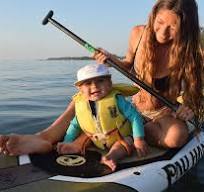
More Shore Ideas
What’s in Our Day Pack For Hikes With Babies and Toddlers?
We are often asked the question of, “What do you pack in your day pack when out hiking with your son?” This is a complex question since, as your child ages and develops the contents change. So, here’s a break down of what lies within our daypacks when out on wilderness excursions with our kiddos along from birth to toddlerhood! Download our printable day hike checklist Our 12 Essentials for Hiking Regardless of Age Water – Hydration Bladders or water bottles, just be sure to have plenty for everybody regardless of age. If you’re on a trail which has access to…
Our Top Ten Favorite Adventure Books for Babies and Toddlers
When we became parents we realized that we had many things to teach and instill in the tiny human beings that we had created together. A love for the outdoors and adventuring was clearly one thing we wanted to encourage in them from the start. Another, was a love for reading. We knew that these two passions could be combined together, and work together, to help our children grow up with senses of adventure, curiosity, and a desire to explore and learn. It has become a family tradition to get a book at every National Park/Monument/Forest that we visit as…
Give Yourself Extra Time
We spent five days covering just 45 miles (it's a two- or three-night trip for adults). That allowed for a layover day if the weather turned and gave us shorter days on the water, spread out over more time. It was tempting to try to do the trip in as few nights as possible to simplify the logistics, but I’m glad we didn’t. It took a few days to get into the groove of loading the boat each morning, paddling all day with the baby, and setting up camp in the evening, and we wouldn’t have wanted to be getting off the river just as we were hitting our stride.
Pack a Day Bag
When you push off from shore, most of your gear will be hard to access, crammed into drybags and tied to the boat. Make sure you have the essentials in one easy-to-access spot. For us, this meant a 30-liter SealLine Baja drybag that I stashed under my seat, packed with a warm hat and jacket, sunscreen, snacks, diapers, wipes, and a blanket.
Ditch the Cotton Onesies
Sometimes when I dress my infant in her synthetic Patagonia base layers I feel ultra snooty, even though I got them used from the company’s Worn Wear site. On this trip, though, they proved ten thousand times better than cotton onesies: breathable but warm, quick drying, and so durable that Josephine wore them every day on sand and mud and abrasive rocks with no discernible effect.
Take a Rescue Beacon
Emergency beacons—like a SPOT Satellite Messenger or Garmin InReach—let you to call for help from remote areas with no cell coverage. They’re also not cheap. The Garmin costs $400, and the SPOT is $150 plus an annual or monthly subscriptions. But if I was ever in a sticky backcountry situation with an infant, I’d kick myself if I hadn’t invested in technology to activate a rescue with the push of a button.
Bring an Old Sleeping Pad or Car Seat
I had no faith whatsoever that Jo would nap in the canoe; she’s a fussy sleeper who struggles to drift off. But something about the quiet and the rocking motion lulled her right to sleep. I laid her on an old half-inflated Thermarest in the bow, draped a lightweight blanket over the gunwales for sun protection, and paddled in total bliss while she dozed.
For younger babies, we heard of parents who brought a car seat, put an umbrella over it, and let the baby snooze or hang out there while the parents paddled. If you go this route, make sure not to strap your child into the car seat. That way, if you accidentally flip the boat, your baby isn’t buckled to a heavy object that will sink.
Rock the Boat
The best advice we got was to bring a plastic bucket and fill it with rocks every morning. Apparently every baby on earth gets a kick out of throwing stones into the water from a canoe, keeping them distracted so you can paddle. On shore, too, they made the best play things. I brought a couple toys just in case, but Jo was way more interested in the local geology.
Without hesitation, I can say that our springtime journey through Labyrinth Canyon was the best river trip of my life. Not because of the water or the scenery, which were both plenty nice, but because I got to watch Jo discover the joy of traveling by canoe, tossing rocks overboard and watching the world go by.
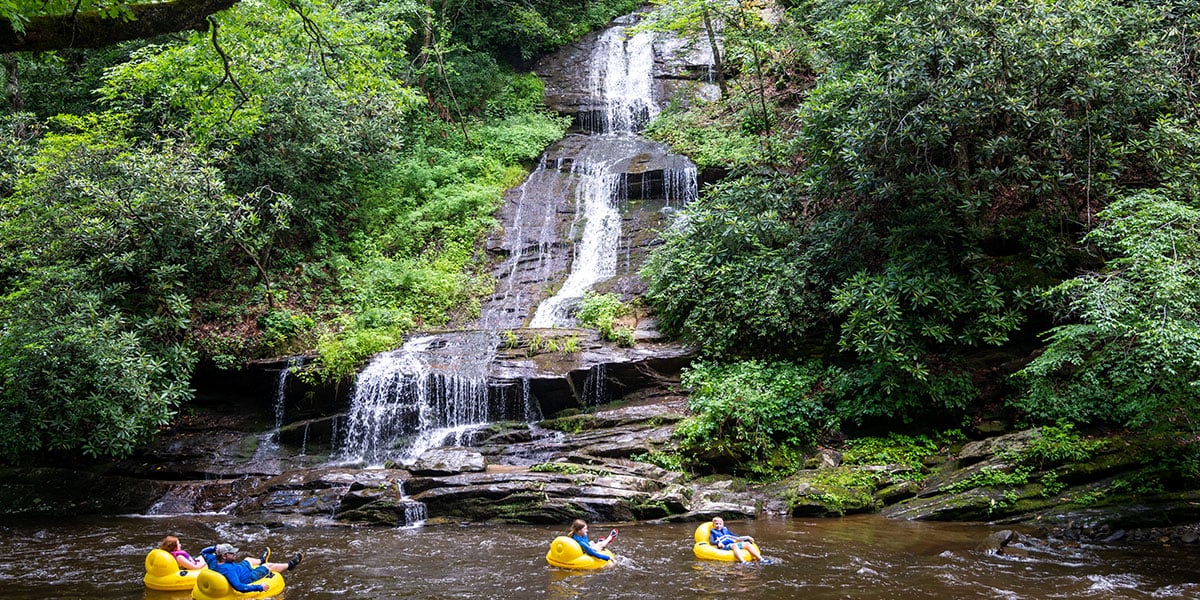
When observing a rivers waterfall, help young children to notice its height, the volume of water flowing, the shape of the fall (cascading, plunging, or tiered), the surrounding rock formations, the mist created, any rainbows formed by the spray, the sound of the water, the vegetation growing nearby, and the plunge pool at the base; all of these elements contribute to the unique character and beauty of a waterfall.
Key aspects to consider:
Water flow: Is the water flow forceful and powerful, or gentle and cascading?
Rock formations: What type of rock is the waterfall falling over, and how does its shape influence the water's movement?
Plunge pool: Observe the size and shape of the pool at the base of the waterfall
Mist and spray: Notice how the falling water creates a mist, and if it forms rainbows in the sunlight
Sound: Listen to the roar or gentle rumble of the waterfall
Vegetation: What plants are growing around the waterfall, including any unique adaptations to the wet environment
Tiered falls: If the waterfall has multiple drops, observe how the water flows between each tier
New York Waterfall Location Map
Over 2,000 waterfalls in over 600 locations across New York State, the map plots public, private, and unknown properties to help you find the falls you want to learn more about.
Another fantastic activity that we did this week was the making of waterfalls and river. There are so many waterfalls among the creeks, rivers near my home in the Finger Lakes. They have carved beautiful canyons or gorges that have been made into New York State Parks.
Outdoor Waterfall Painting
Another fantastic activity that we did this week was the making of waterfalls and river. There are so many waterfalls among the creeks, rivers near my home in the Finger Lakes. They have carved beautiful canyons or gorges that have been made into New York State Parks.

So easy to prepare! Some pipettes, watercolor (mix of tempera and water), and a tray! I was just starting to prepare the materials and the boys couldn’t settle because they’re so excited of the activity. The site of watercolor and pipettes excites them
By the way, for the watercolor, I prepared three colors for some effect: green, blue and purple. The mixture turned out so beautiful!
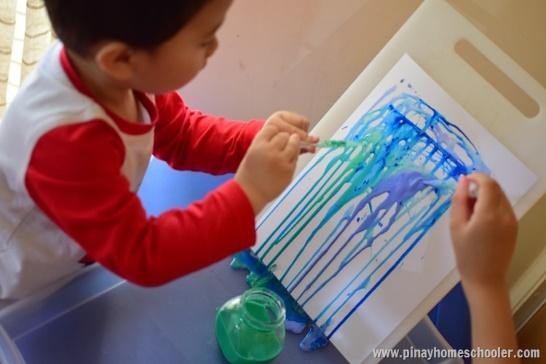
So there, they squirt liquid into the paper. A little advice, if you’re doing this indoor, try to cover your wall for some accidental splatters.
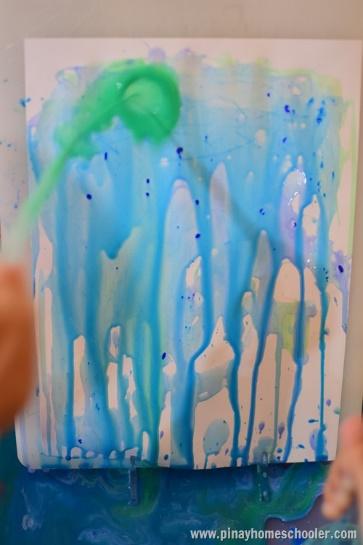
A few minutes of squirting water, river was forming! The water was flowing down from the board and forming into this river form in the tray, the kids were fascinated!

We could have done this in our backyard, but it’s been raining for days. Irish summer is terrible, or should I say there’s no such thing as summer in Ireland. I doubt we’ll be having sunlight in the coming days. The forecast says it’s going to be cloudy and rainy till mid July!
The kids highly enjoyed this activity. Just make sure to protect your walls and use a large tray when doing this indoors.
Related Posts
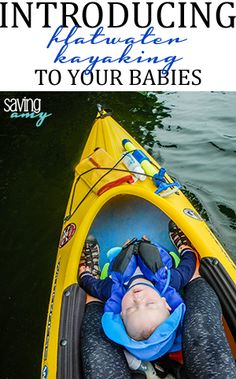
Camping- Bonfire, Wilderness skills, & Evening fun
How I Got My Kids Out Flatwater Kayaking As Babies
River Exploration and Frog Catching
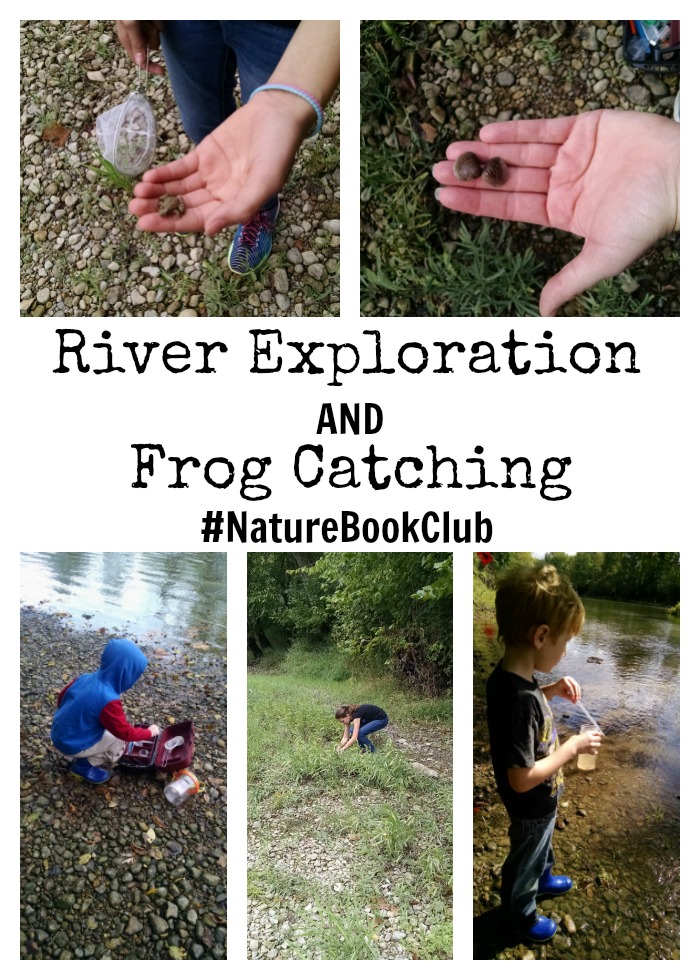
August is now in full force and many families have had children head back to school but for us we are grasping onto the last few weeks of Summer! This month’s theme for theNature Book Club is Ponds, Rivers, and Streams! We choose books about rivers and ponds to read and are particularly fond ofBy Pond and Riverby Arabella Buckley. You can listen to the audiobook via Librivox for free! The first chapter is all about frogs and then it goes onto share about other creatures who live in or near the pond or river. We have shared a tons of free pond resourcesand ways to learn about frog lifecycle in previous posts but today I am sharing an actual trip to the river!
We love exploring our county park locations since there’s over 20 places that we can walk, hike, explore and play. One of our family’s favorite is a paved bike path that goes along the river just a 5 minute drive from our house. We park in the parking lot and walk a very short distance to access the trail that leads down to the river.
Sometimes we bring the dog’s and other times we bring our nature toolbox, nets, and water boots so we can explore at the river’s edge. I tend to look at the ground to see if the mud is soft enough for animal tracks. I usually do not find much besides a deer or raccoon print. One time there was leaves, boot prints and a spider.
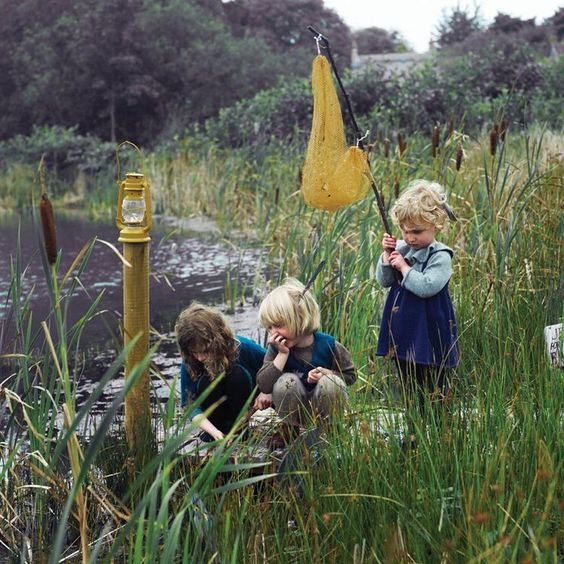
We check the water level of the river to see if it is safe enough to explore past the edge and possibly make it out to the island in the middle. My kids love going to the island to explore and feel all independent. Princess took Bayley over to the island and they both loved exploring. Bayley sniffed all around and Princess got to exercise her dog.
Big Red and Lil’ Red enjoy seeing what is in the water. Sometimes they explore using nets and other times they use simple water droppers and magnifying boxes.
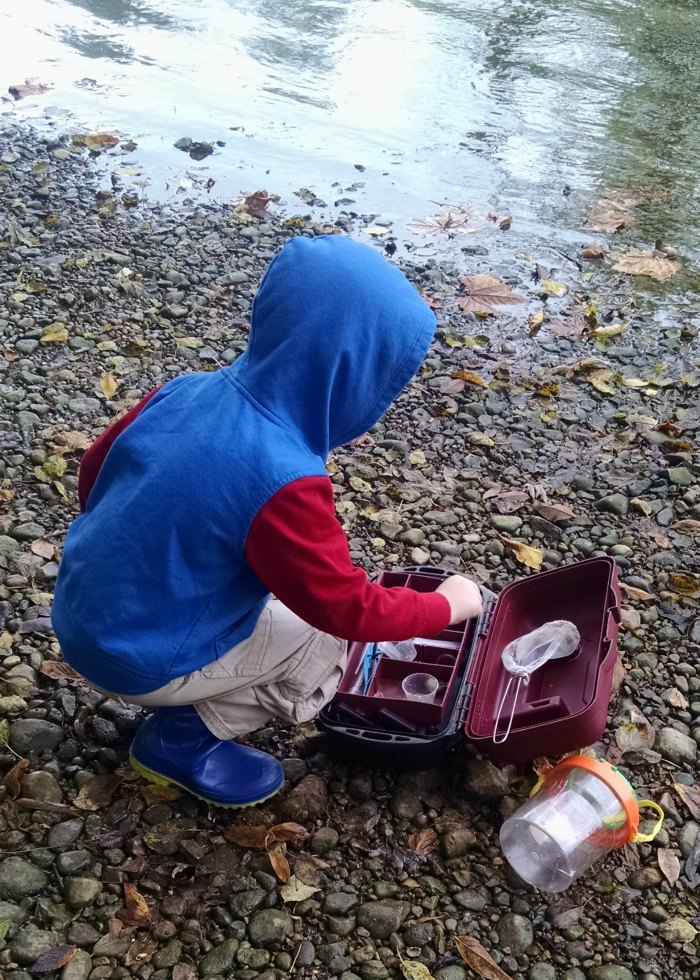
One time we realized the “pebbles” on the ground were moving! We took a closer look and found tiny frogs were hopping all around. Of course the kids just had to catch them! Princess took one of our netsand off she set to catch one.
She got one of those little cuties and brought it over to show us! These little guys are just about full grown for their species.

Since we are long overdue to get back to the river we will prepare by listening to the audiobook in the morning and heading to the river after lunch!
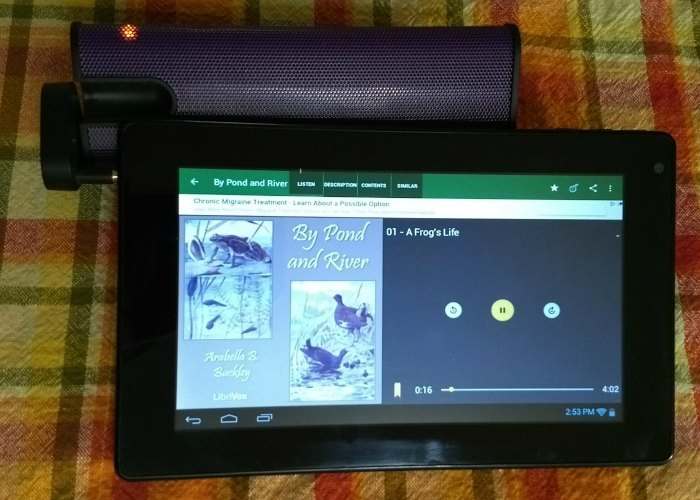
Be sure to check out the other Co-hosts as they share some Pond, River, and Stream crafts and projects!
Sensory Bin and Observation Notebooking Page from Jenny at Faith & Good Works
Pond Life Printable Pack from Emily at Table Life Blog
Aquatic Science Studies: 10 Activities for Teens from Eva at Eva Varga
Above and Below a Pond Unit Study and Lapbookfrom Tina at Tina’s Dynamic Homeschool Plus
Online Book Study about Water Cycle from Dachelle at Hide the Chocolate
STEAM Challenge – Does Water Ever Flow Up?from Erika at The Playful Scholar
Who Was?® What Was?® Where Is?® Book Series: Where is the Mississippi River?from Sharla at Minnesota Country Girl
Superscript
Beach Bums
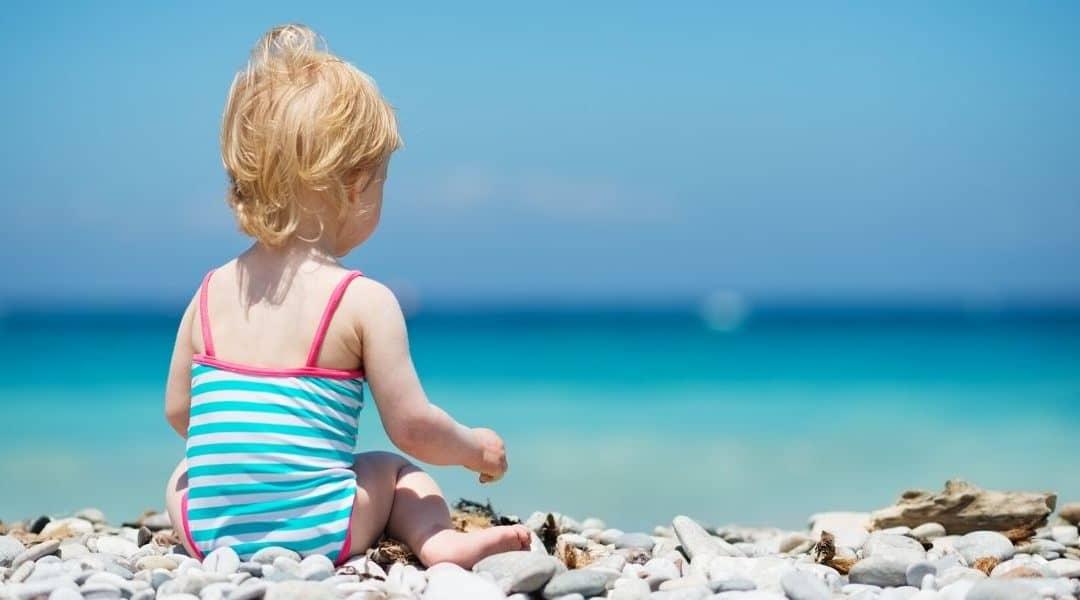
Exploring on The Beach
and Wild Waters
Blue water, sun, and sand are but a few of the interesting elements this theme will make sharing with babies and toddlers possible. A beach is a magical place, especially to kids. The glorious sound of waves washing up and whooshing back, the feeling of sand squishing between toes, and sun-kissed skin after spending a day outside exploring are the simple yet beautiful things that can make for the sweetest childhood memories. That’s why I try to get my kids as young as babies to fall as madly in love with the beach as I am.
Before you even leave your house, it is wise to prepare for safety and fun. The more comfortable you and your child are, the more fun you’ll be able to have. If you have a sensory sensitive child, build a mini beach for them to get used to the elements. Then be sure to pack plenty of drinking water, snacks, and sunscreen as well as beach toys, towels, sunglasses, aloe, beach blankets, wide-brimmed hats, and tons of toys. Did we mention the toys? Buckets, shovels, sifters, and even blowing bubbles.
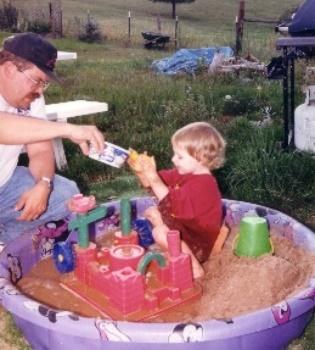
SENSORY PLAY
Babies absolutely love to touch everything – that’s how they experience the world. Be sure to point out all the amazing sensory opportunities for your little one – like digging in the sand, dipping toes in the water, collecting shells and cool rocks and smelling the salty air.
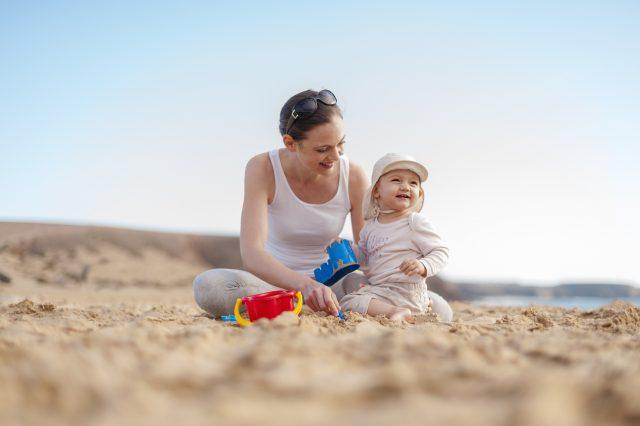
TEACH
The best part about all of that sensory play is the golden opportunity to take advantage your child’s natural curiosity and to teach them things like how the water moves, the nature of the tide and all about ocean life and the cool creatures you’ll find there. Without the distractions of screens and the daily grind to get in the way of your focus, you and your baby will enjoy this special bonding time.
MOVE AT YOUR KID’S PACE
Kids have a natural pace and to really allow them to fall in the love with the beach it is wise to let them lead you through the hours of the day as much as a parent is able to. If your little one just wants to grab the sticky beach sand and watch it fall on his lap then by all means, do that. Treat your child’s focus on nature as the most important thing about that day.
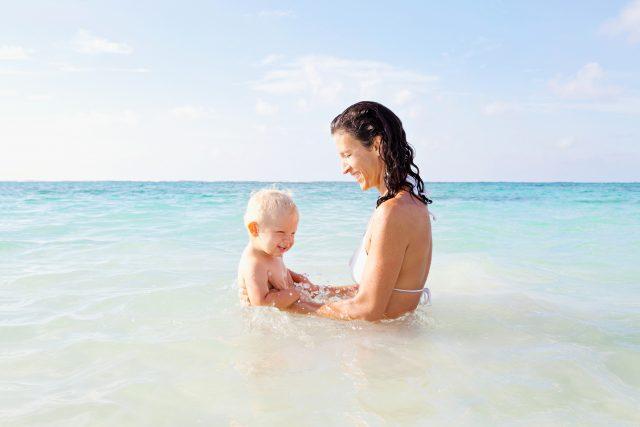
MOVE YOUR BODY
Find ways to move your body and stretch, walk, crawl, swim, float, do whatever you can to make your beach day a physical day too. There is wisdom in getting your blood pumping and your lungs working hard and teaching your child to enjoy the beach as a way to get some movement in is especially wonderful.
MAKE IT SPECIAL
Take pictures, laugh a lot, be slow and playful, do whatever it takes to make you and your baby super happy during beach time. It won’t take much for your little one to fall in love with the truly remarkable beauty of spending a day with family at the beach.
Follow your child's fascination in exploring the lay of the land, and by being open to their natural curiosity, you can definitely help your child to develop a healthy love of not just the beach but of the great outdoors. For more information on water and beach safety, check out these safety tips from The American Red Cross.Be sure to visit your state tourism board website to find the best family friendly beaches near you.
More Beach Fun:
12 Family Beach Games to Have Fun in the Sun
Take Great Photos of Your Kids at the Beach
BABIES & SENSORY ENRICHMENT AT THE BEACH
Babies and children with sensory processing challenges can be overwhelmed given all of the sights, sounds, scents, and textures that the beach provides. Try these accommodations for addressing sensory needs in beach play:
Play in a baby pool to enjoy water without the waves
Use a large beach blanket and weight down edges
Be cognizant of hot sand
Provide calming snacks
Wear long sleeved sun clothing
Wear water shoes instead of sandals or bear feet
Proprioceptive input such as firm touch to the shoulders
Bucket of water to rinse hands if child is sensitive to sand
Sheltered area such as a wind tent or low umbrella if child is sensitive to wind blowing on skin
Wear a lightweight wind jacket
Use baby powder to remove sand
Hat with brim to reduce bright light or intense light in eyes or on face
Wear sunglasses
Wear headphones to reduce background noise
Be aware of certain sunscreens which as a strong scent
Bring extra dry towels
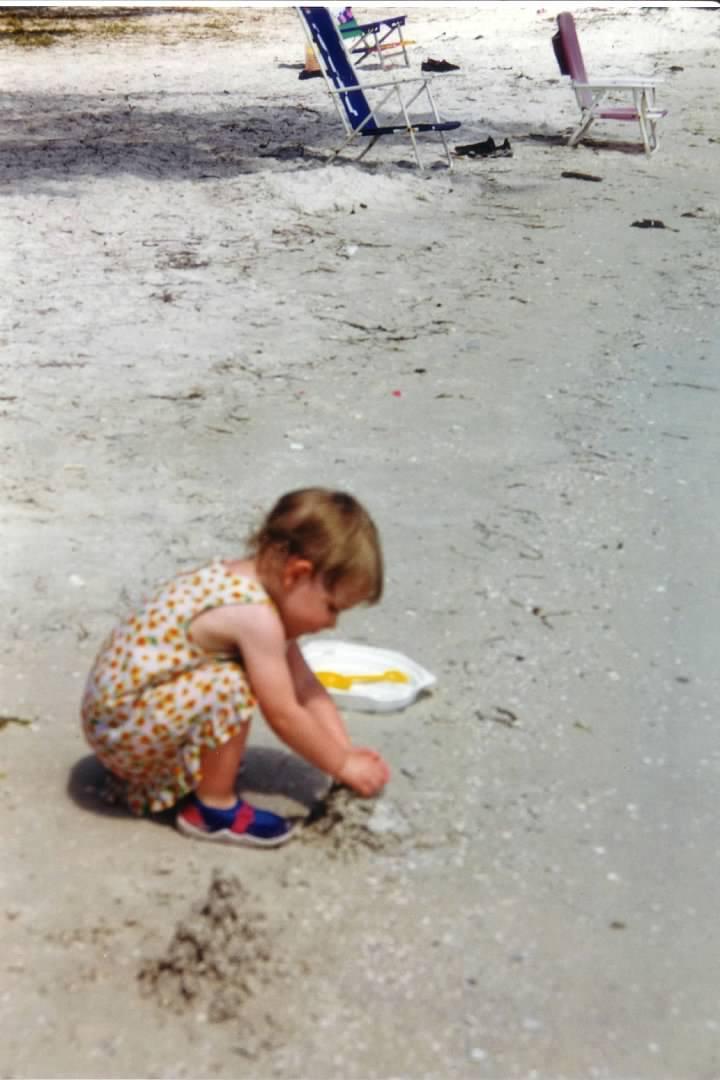
Making Sandcastles
Keep first experiences, simple and open to free play. The goal is to show them how to do it, and then let them build one in their own way. If they don’t make one, don’t force it. Just try again another day.
Older child(ren) may want to learn how to make a more complex castle. Below I have provided some links to some amazing tutorials on how to build sandcastles if you want to make things a bit more interesting.
How to make Sand Drizzle Castle By Still Playing School
How to Build a Sandcastle from Martha Stewart
Build the Best Sandcastle with Tips from the Pro’s by Robin Lehr on Redbook
Secrets of Super Sandcastles by SheKnows
How to Build a Sandcastle by Teresa Coppens on Hubpages
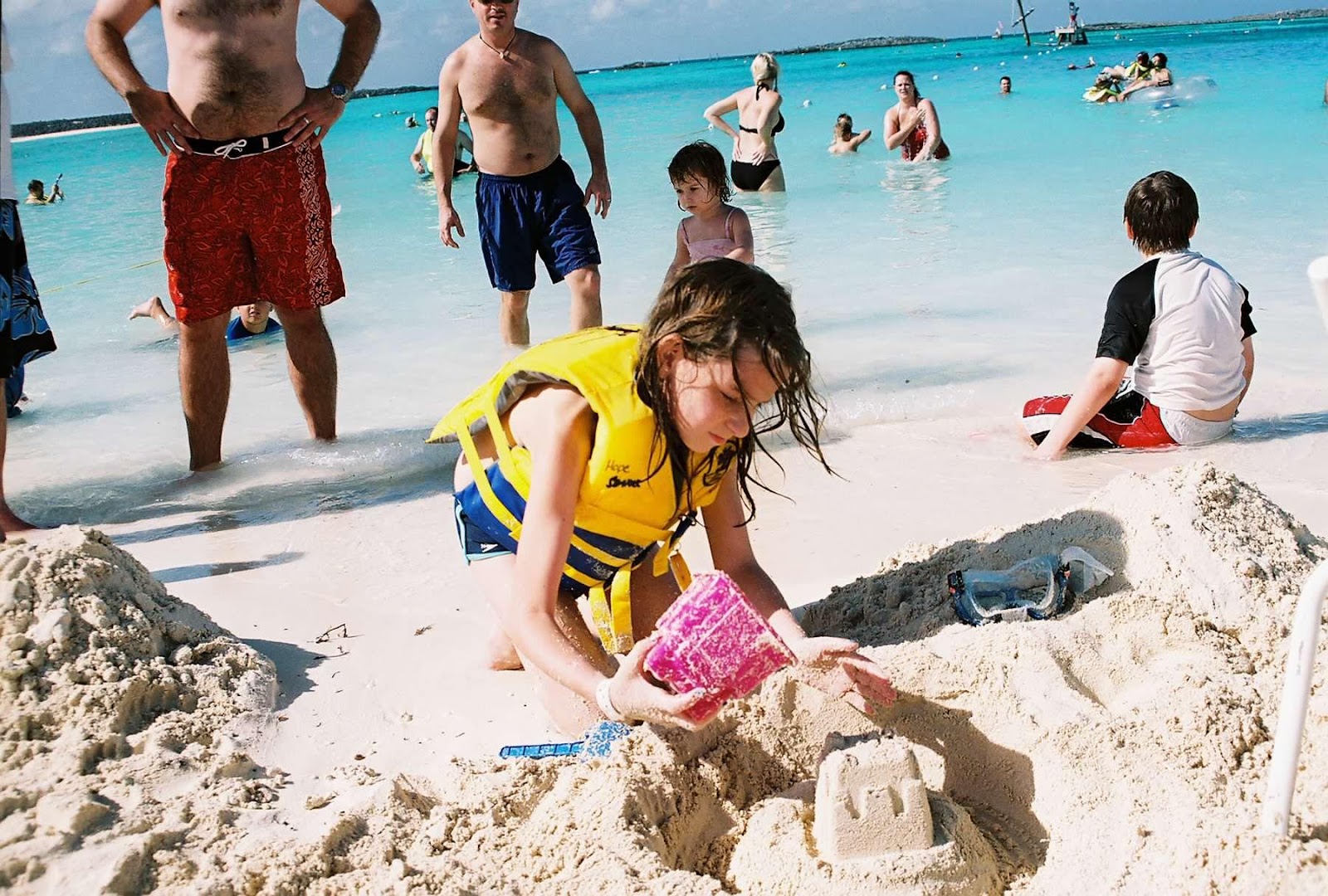
Building sandcastles is a wonderful activity for kids. It provides a valuable sensory experience, and the opportunity to get creative.
Explore a little science at the beach with these fun activities!
A day at the beach is what summer dreams are made of when you're a kid -- sandcastles, seashells and splashing in the waves.
But there's also quite a bit of learning that can be woven into your beach visit too.
So grab a blanket & some sunscreen and join us as we explore a little science at the seashore.
Hanging around in the forest
Forest Activities for Babies
& why they’re so beneficial
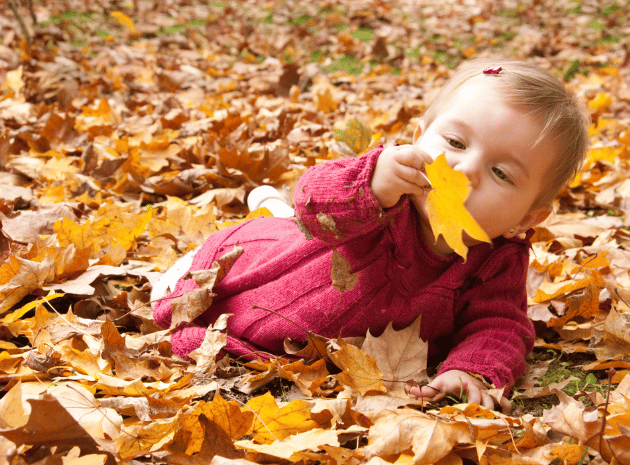
Join us as we explore how forest activities for babies can ignite their natural curiosity and foster essential early development…
Babies are sensory-motor learners. When newly born, they have a well-developed sense of touch overall, but limited finger pad sensitivity.
Due to nature’s programmed survival instinct the majority of their senses are concentrated around certain areas on their bodies, for example, their lips.
To aid babies’ development, we need to provide a sensory-rich environment with many textures, temperatures, colors, smells and sounds. Consequently, the great outdoors is an ideal learning environment for even tiny infants because it engages all of their senses.
They advance their physical development to new levels in response to the many different sources of stimuli. For example. varied environmental effects motivate them to move their bodies in many different ways, encouraging them to:
pull themselves up
reach
grasp
sit
crawl
walk
Being outside and taking part in forest school activities also supports babies to begin to use their hands. Natural physical support (e.g. sitting between logs) helps them to concentrate on other activities, rather than the sitting itself.
The outdoor environment has a great impact on the development of vision, hearing and touchof babies, too.
In the open air, their brains, motivated by the abundance of stimuli, build new neural pathways – the ‘wiring’ of the brain – in order to cope with the vast amount of new information they are processing.
This increased brain activity supports all areas of development. While receiving and learning to decode the new information, the developing brain also has to store, use and link it. It concentrates its activity not only on survival, but learning.
Sensory-motor learning
In order to take advantage of the body’s ability to improve through sensory-motor learning, we need to give the brain ample opportunity to recognise and understand productive and counterproductive information, based on basic movements.
Neurophysiologists have observed that conventional exercises, with their focus on muscular effort, force and speed, inhibit the brain’s ability to function properly on the body’s behalf. It becomes impossible for the brain to make the clear sensory distinctions needed to improve the body’s organization.
However, when movements are slow and easy, they activate the brain’s movement centers and generate a flow of valuable information between the brain cells.
During forest school activities we can give time and space to allow babies to make slow and concentrated movements. This leaves the brain free to make important sensory distinctions.
Stimulating the senses
Unlike all the activities you usually need to carefully plan and organize indoors in order to offer a rich, nurturing and appropriately challenging environment for very young children, the magic of forest school activities for babies is that they occur mostly naturally.
Here are some of the ways in which the natural environment can engage infants’ senses:
Hearing
Sound moves in a different way outside due to the lack of physical limits and the effects of natural forces. For example, it may change naturally with the wind or variations in air pressure.
In the very early stages of their development, up until the age of six months, babies are able to differentiate sounds much more effectively than adults.
Therefore, they’re significantly more receptive to air movement and animal sounds. Young babies are also naturally programmed to be curious and alert, and as a result they love being outdoors.
Forest school environments, as opposed to conventional early years outdoor settings, offer a large variety of unusual sounds.
Vision
Light is more varied in natural environments. It sometimes changes very rapidly with the weather – even over the course of 15 minutes.
It is filtered by trees and bushes and appears differently in different parts of a site. Natural puddles of light act as a great source of fascination for young babies.
The changes in illumination stimulate their eyes to adapt, which in turn stimulates their brains.
Smell
Young children’s sense of smell is greatly stimulated outdoors, particularly in the diverse surroundings common to forest school.
Scents (like grass, earth, flowers, rain, mud, tree bark, etc.) that babies are unlikely to encounter in a conventional outdoor setting encourage them to pull themselves up to standing and investigate the source of the smell.
These sources occur naturally at different levels, so babies need to work out how to access them, for example, how to smell the grass without falling forwards.
Touch
At birth, babies move rapidly from the warm, soft, protective environment of the womb to a different world with many different sensations.
All of a sudden they are able to feel the air, surfaces and clothes on their skin. These feelings take time to get used to and babies are learning about life with each touch. Touch is the key sense when it comes to them exploring the world.
Outdoors, they can lie on or sit in the grass; they can feel textural differences tickling their skin.
Babies’ mouths and tongues are their most touch-sensitive areas, and once they are able to intentionally grasp objects – usually by three months of age – they will begin to mouth them.
Whilst mouthing objects can cause particular health and safety issues during forest school activities, careful supervision of babies can open up an environment that offers a sensory wonderland like no other.
Spatial awareness
Children appreciate liveliness and colors but not necessarily the stereotypical choices. Warmer, natural tones are more nurturing in general, whereas harsher colors can be emotionally frigid for a growing infant.
Softer tones, rather than brash, bold colors, can help babies develop a sense of refined appreciation, and they may be able to spot splashes of brighter tones in nature.
Children are very sensitive to energy flow and the communication of external objects, which helps the growing brain to understand placement and integration in a larger sense. This is something forest school activities for babies can naturally provide.
Children like natural places as they are creative, active, reflective, emotional and social.

Planning forest school activities for babies
The main principle of the forest school ethos does not change for babies. The learning that takes place should be based on play and exploration, and built upon week-on-week.
However, as babies perceive the world around them differently we need to adapt forest school activities to suit their needs.
While a typical forest school session will run for one-and-a-half hours, for babies a mere 20 minutes can be very valuable, although you can extend this.
Start your sessions with the same routine: getting ready to go outside – dressing in appropriate clothing, wellies (or shoe covers) and waterproofs.
Next, gather at a seating circle of logs to catch up with what happened at the last session. Show babies objects and draw their attention by pointing and talking to them. You can also discuss the weather.
You can offer a wide range of forest school activities for babies, including bug hunting, mud painting, collecting and touching.
Make sure to follow any child-initiated activities. Introduce the basics of building and tool use via the use of natural objects as building blocks and handling sticks. At the end of the session, repeat the gathering.
Health & safety
One of the main worries that comes when planning forest school activities for babies is the issue of mouthing small objects.
However, with appropriate ratios and adult attention you can minimize this risk. You will of course need to do a risk assessment and carefully assess the weather (especially sun, wind and frost) prior to and during sessions. Don’t forget to offer drinks regularly too.
Going for a walk is easy, but what else can you do to help your baby safely explore the outdoors, even amidst Take a look at these seven ideas.
Observe the natural world.
Wherever you happen to be — your yard, a park, or another outdoor location — you’re sure to be surrounded by many different plants, animals, insects, and more. As you walk around (or sit and observe), hold your baby or place him or her in a carrier in a way that makes it easy to look around. Go out in different types of weather, too (dressed appropriately, of course). This will help your baby experience changes in the environment — sometimes it’s sunny and warm, other times it’s cloudy and cool.
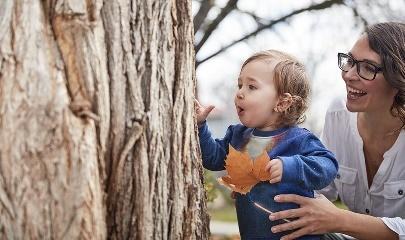
Talk about what you see.
Point out everything you see, and call things by name. When you see a flower, point to it and say, “flower!” Your baby probably isn’t old enough to say the words you’re saying, but he or she will begin to associate objects with their names. Spark their interest using three of the senses as you draw their attention towards the world about them.
Explore different textures.
When you’re outside, there are so many different things to touch, from smooth rocks and flower petals to coarse gravel and rough sand. Help your baby (safely) explore these textures to get a feel for the properties of different objects.
Change the scenery on your walks.
If you go on a daily — or weekly — walk, consider stepping out of your comfort zone. If you normally walk around your own neighborhood, branch out to a local park, garden, or zoo. Your baby will have a whole new set of things to look at — a variety of plants, interesting animals, and more. Just make sure to bring your own mask along, and maintain a safe distance from other people at all times.
Discover your own backyard.
Take a blanket outside and lie in the grass with your baby, or set your baby up to watch you plant a garden. If you already have a garden, walk around with your baby, smell the flowers, look at the different plants, and observe the insects that might be around them (take care, though, to stay away from bees, wasps, and the like).
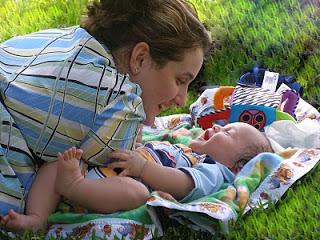
Have an outdoor picnic.
You can do this in your own backyard, too, or you can venture out to a park, the beach, or anywhere else you can comfortably lay a blanket down outside while also keeping your distance from other people. Sit together and look around at everything around you as you eat.
Exploring in the mountains
Our Mountain Vacation
With a Infant
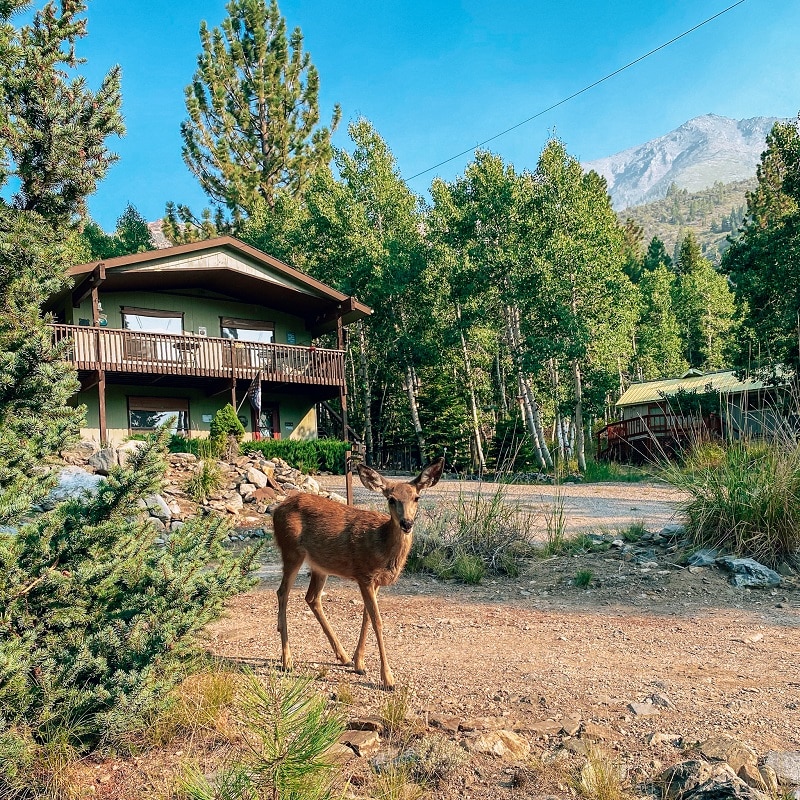

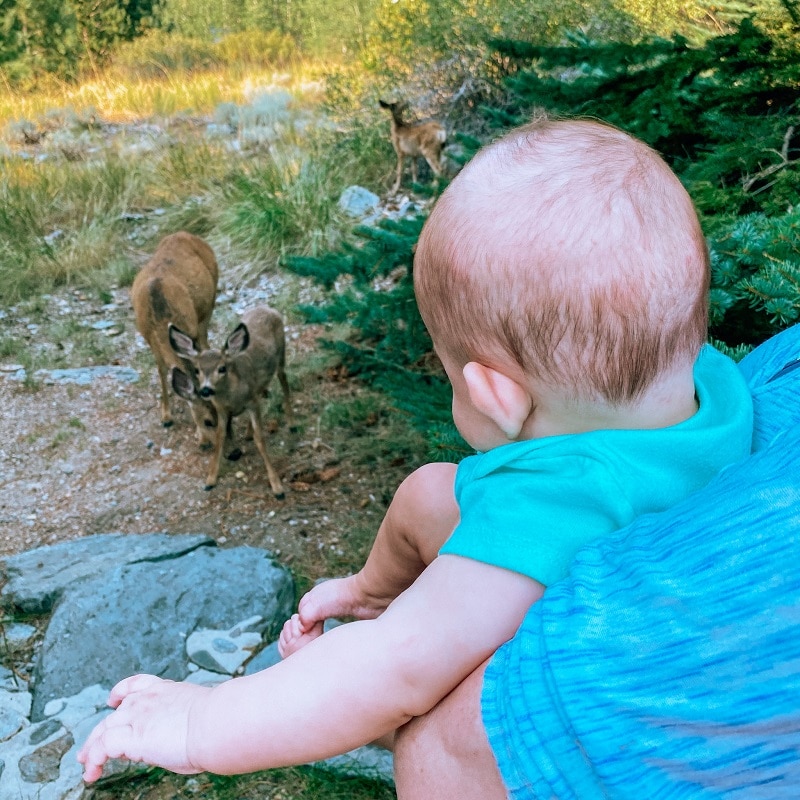
How to Have a Fun Trip to the Mountains with Baby
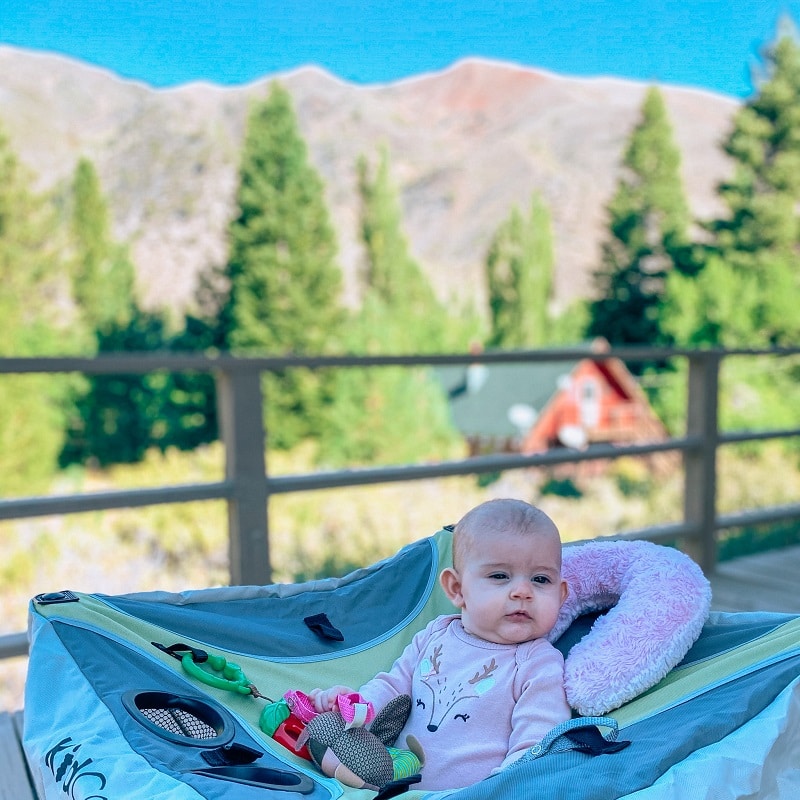
How to Have a Fun Trip
to the Mountains with Baby
So, you are going to the mountains with your baby and are wondering how it will be possible to have a fun family vacation with such a young child especially if you are exclusively breastfeeding.
Well, I am here to tell you that it is possible and remember, just because you are a parent, does not mean you are not allowed to be adventurous and have fun in the mountains with your family.
My boyfriend and I just came back from our first family vacation to the Eastern Sierras with our 4-month-old daughter and I am here to give you some encouragement and tips from our experience.
Hiking with your Baby

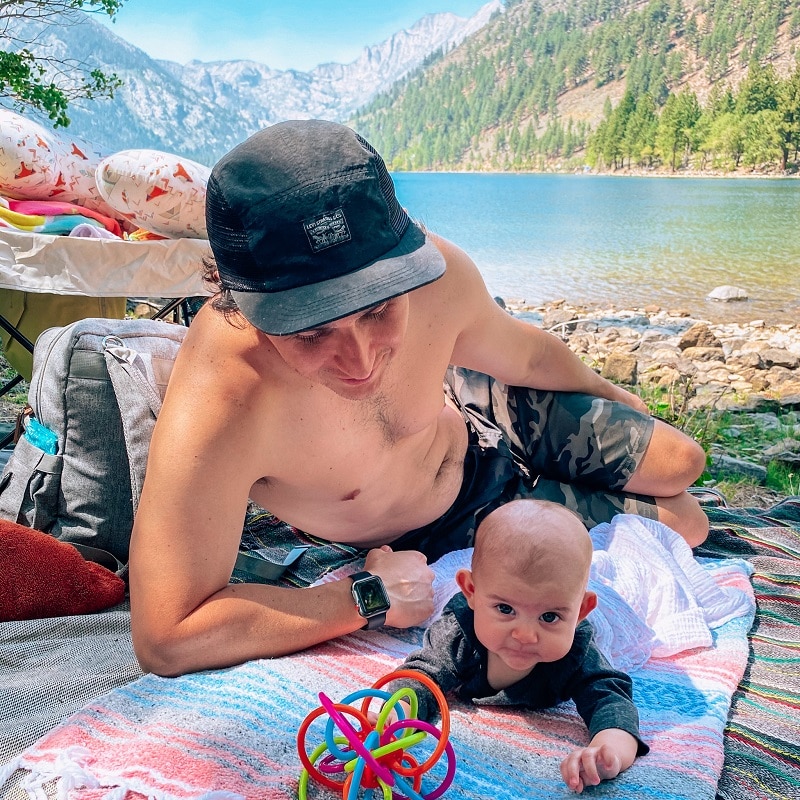
First, let us talk about hiking in the mountains with your baby; yes, I did it and so can you.
All you need is a diaper bag, baby carrier, baby sunglasses, baby hat, your baby in a long-sleeved onesie to protect their skin, and confidence.
In your diaper bag, be sure to bring all your baby essentials: changing pad, diapers, wipes, Aquaphor, muslin swaddle, burp cloths, and extra clothes for you and baby just in case of spit-up or a blowout.
You will need more items if you are bottle-feeding your baby.
There are many baby carriers out there that make hiking both possible and fun with your baby, but at our daughter’s young age and small size, we found the Boba Wrap to be the best carrier for her to feel comfortable in as well as be protected from the sun.
We were able to complete a 2-mile hike to the waterfalls at Twin Lakes and our daughter was even able to take multiple naps in the Boba Wrap on the way up and down from the falls!
Fishing, Picnic, Eye Spy, Stargazing, & Board Games with your Baby
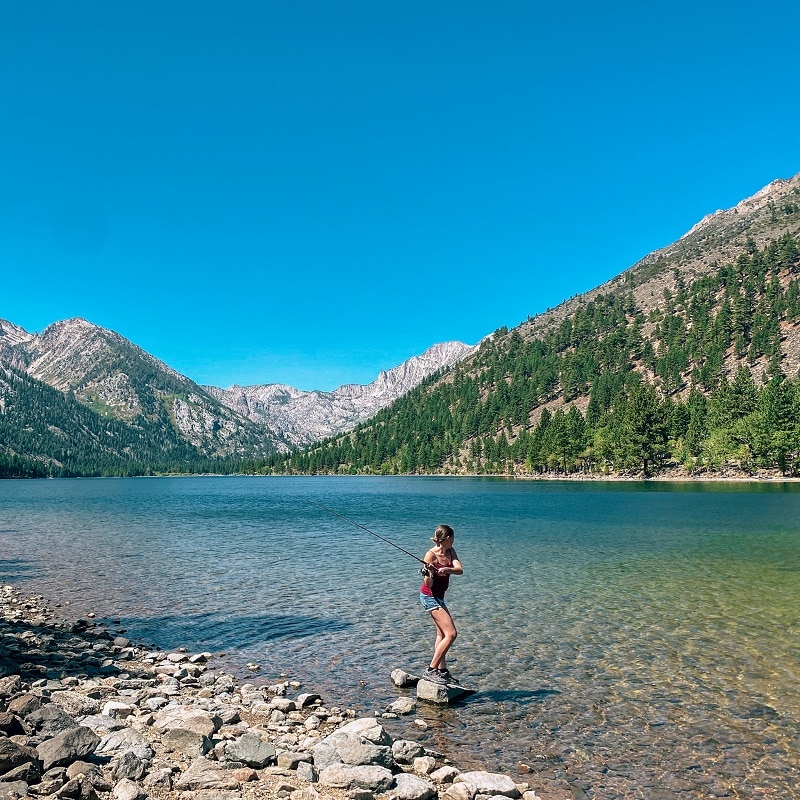

Other then hiking, there are plenty of other fun experiences to share with your baby in the mountains even if they are too little to participate in them with you just yet.
Bring your baby along when you go fishing and show them what fish you catch.
Have a picnic and enjoy some tummy time on the side of the lake or stream together while you both enjoy the beautiful scenery around you.
Talk to your baby and let them know what you are doing and point out any animals you see in the forest.
I was able to interact with some deer and ducks with my daughter and she seemed to enjoy it.
Take your baby outside with you to stargaze at night together.
Do not forget a trip to the mountains in a cabin is not a trip without playing some good old-fashioned family games.
Talk to your baby while you play your favorite board game with your loved ones, so they feel included.
Water Sports with Your Baby
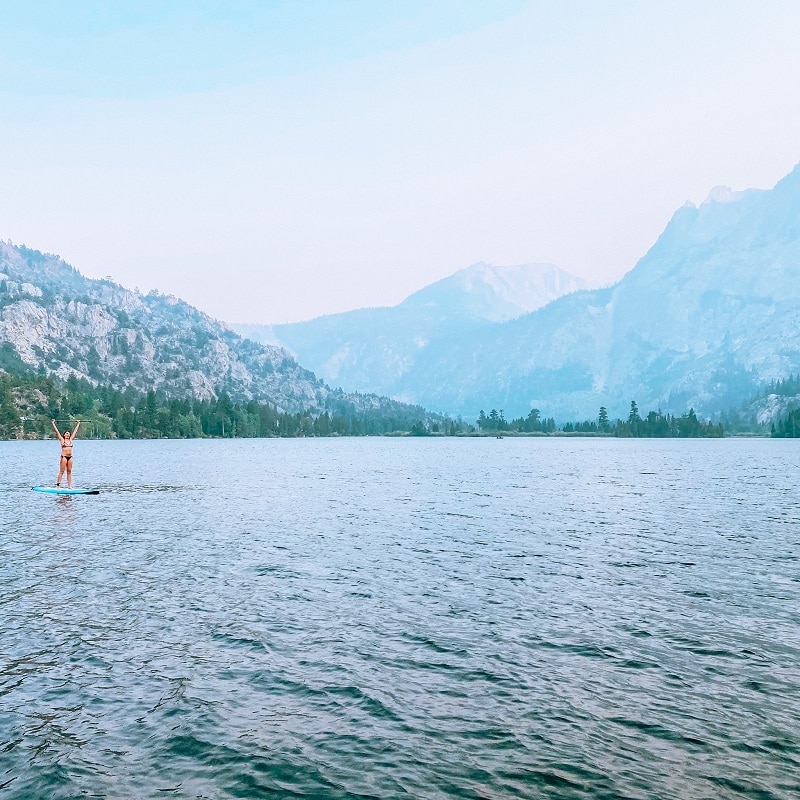
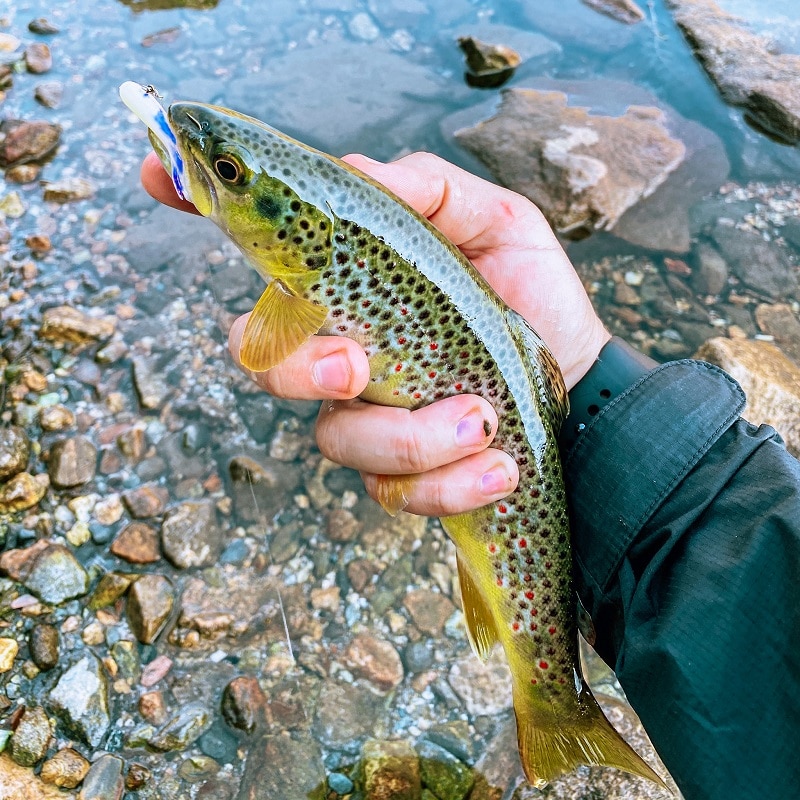
Do not forget about all the water sports you can do while in the mountains.
No, your baby will not be able to go on that paddleboard, kayak, or boat with you just yet, but that does not mean you cannot still enjoy these activities yourself.
According to the U.S. Coast Guard’s Office of Boating Safety, babies should weigh at least 18 lbs. and be able to comfortably wear a Personal Flotation Device (PFD) to be on a boat.
I would recommend having your partner, parents, and/or siblings come along with you to help take care of baby, that way you can switch off and take turns doing these activities.
When I went paddleboarding at the lake, I changed my baby girl’s diaper, made sure she was comfortable weather wise (see if she needed pants or a jacket when it was colder), and breastfed her.
That way, once I was done feeding her, I would have at least a good hour to be out on the water knowing that she was a comfortable happy baby while my boyfriend and sister watched over her.
#1 Travel Must-Have for Baby

One item that made our experience even more enjoyable was bringing our KidCo GoPod.
This is such a neat portable activity seat for your baby to use while traveling. It sets up and folds up just as quickly and easily as a camping chair.
You can attach a variety of toys to the loops on the seat for your baby’s entertainment and learning development.
We love that our daughter can sit up in it making it easier for us to interact and play with her at a different level without having to worry about her falling over.
Our baby girl is on the smaller size and at 4 months old she is unable to reach the floor so we put a pillow or baby blanket underneath her so she can practice using her legs and push from her feet.
We loved being able to use this to help entertain our daughter while in the BIG OUTDOORS because it gave her a different perspective and experience.
Just make sure not to keep your baby in the KidCo GoPod for longer than 15-minute intervals because it can be harmful to their hips and joints if overused over time.
Conclusion
As you can see, you can still enjoy many adventurous activities in the mountains even when traveling with your baby.
For more baby travel gear recommendations, see my posts on best travel stroller and best baby carrier for travel.
If you would like to read more tips on traveling with Baby, make sure to check out my post “How to Survive a Road Trip with your Baby” and “Ultimate Baby Packing List for a Family Vacation to the Mountains.”
There are so many wonderful opportunities to be outside and explore nature with children of all ages. Nature walks and explorations are an ideal way to spend fun quality time together as a family and to help your children develop an appreciation for the earth, birds, mini-beasts, plants and everything else in the natural world.
A Trip to the "Zoo" in Your Backyard
DO YOU HAVE A ZOO
IN YOUR BACKYARD?
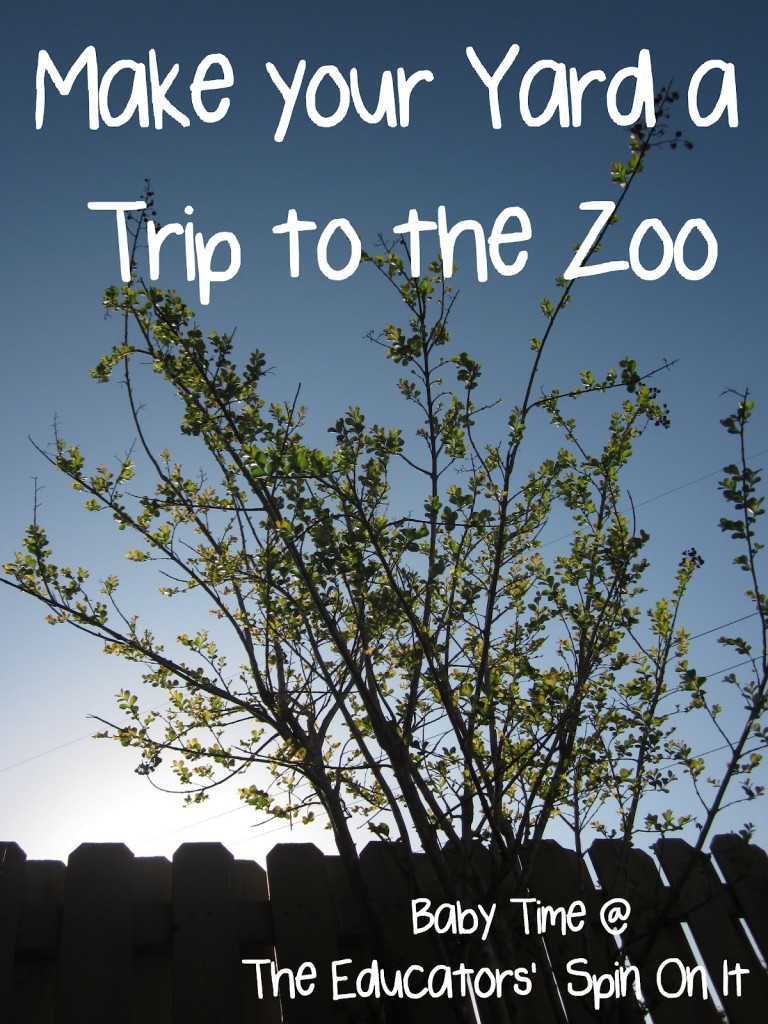
Babies and Toddlers are naturally interested in animals. Many times your family pet ends up being one of your babies first words. Then they begin to discover animal toys, our toy animals currently get lined up one by one when she’s playing with them and carried all around the room.
Her next thing she loves is the animal books. My little one loves talking to the kittens and touching the fur in it. Although these are all important to her development, it’s just not the real thing. It is my hope that your baby starts to discover the animals that live all around us first and gets excited to go outside.
We’re working on the sign “Outside” at our house, here’s how you sign for “Outside” from Signing Time using sign language.
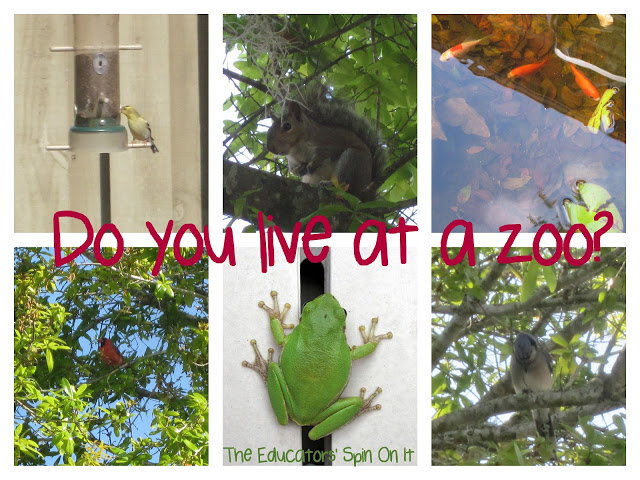
EXPLORING YOUR BACKYARD ZOO WITH YOUR BABY OR TODDLERS
Take your children outside on adventures. We spend our mornings in the yard and discovered we live at the zoo! Well, not really , but to my daughter it feels like it.
We were searching and discovering animals on a daily basis. I love how she carefully watches and observes everything that surround her in this environment. She is starting to get very excited with her little dancing feet when she sees something new moving.
Did you know at this age you can teach your baby and toddlers about SCIENCE?
What animals can you discover with your baby in your yard?
MAMMALS
My baby discovered that many squirrels live in our yard.
They like to run and climb up trees and dig in the ground
They also eat those brown acorns on the ground that she loves to pick up at try to eat herself.
She also discovered that the cat has a tail just like a squirrel.
BIRDS
My baby discovered that the birds fly back and forth from the trees and talk to each other.
She discovered that they even come to the bird feeder to eat.
She discovered that they can be different colors and different sizes.
They also come to the birdbath for water (still waiting for her to see how they take baths)
Here are some Bird Activities for your baby & toddler
AMPHIBIANS
My baby discovered that a frog likes to live on our chair on the back porch.
She discovered that it likes to jump when you try to touch it. (can’t wait for tadpoles to arrive)
Here is Rainy Day Mum family’s experience with Frog Hunting & Frog Books
FISH
My baby discovered that fish swim very fast when you approach.
She also discovered they come back when you throw food into the water.
We are very lucky that we have our own little pond in our yard, but you could always have a goldfish bowl or aquarium in your house.
REPTILES
My baby discovered that a lizard climbs up on pot on the front porch.
(Thank goodness we did not discover a snake yet, although pretend ones keep us busy)
INSECTS (bugs)
My baby discovered a grasshopper sitting on our peas can jump as she tried to touch it!
She also discovered a ladybug that flew away when she tried to touch it.
She found out that the bright yellow butterflies fly away very quickly.
WHAT IS MY BABY LEARNING OUTDOORS?
My baby is learning all about the world around here.
She learned that there are all types of animals.
She learned that animals can move in different ways.
She also learned that they can make different noises.
All skills of observation and knowledge in science. Learning starts from the very beginning!
The skills she is learning outside with me are far better than any skills she’ll learn watching a TV. Although I know it most certainly takes more effort, it’s our jobs as a child’s first teacher to give them these opportunities every day throughout the day to engage in nature and to explore their surroundings inside and outside.
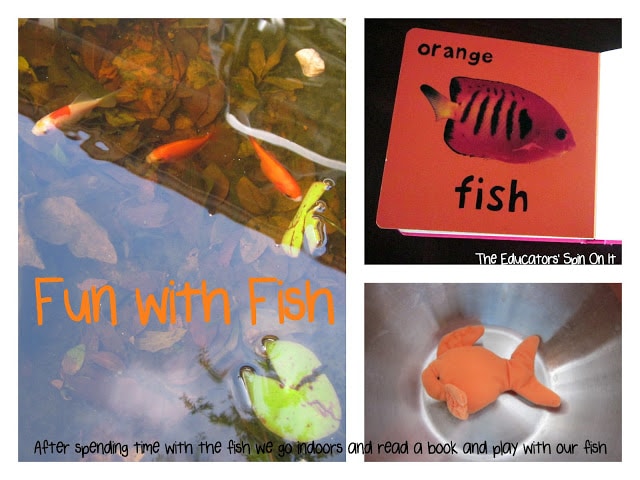
HOW DO WE CONNECT WITH ANIMALS AT PLAYTIME?
Outdoor time is so important! It’s also important to let your child find ways to explore those concepts in play. Connecting the outdoors is very easy. Just find a few toys that represent what you’re finding outdoors. Connecting through books & toys is just what they need to begin to develop their imagination.
We have found fish, squirrels, birds, frogs, ladybugs, and so those are the toys we are exploring and playing with right now. Don’t feel like you have to own all of these things… sometimes playgroups are a great way to exchange a concept. I’m waiting for a friend’s zoo animals to arrive at my house any day! Can’t wait!
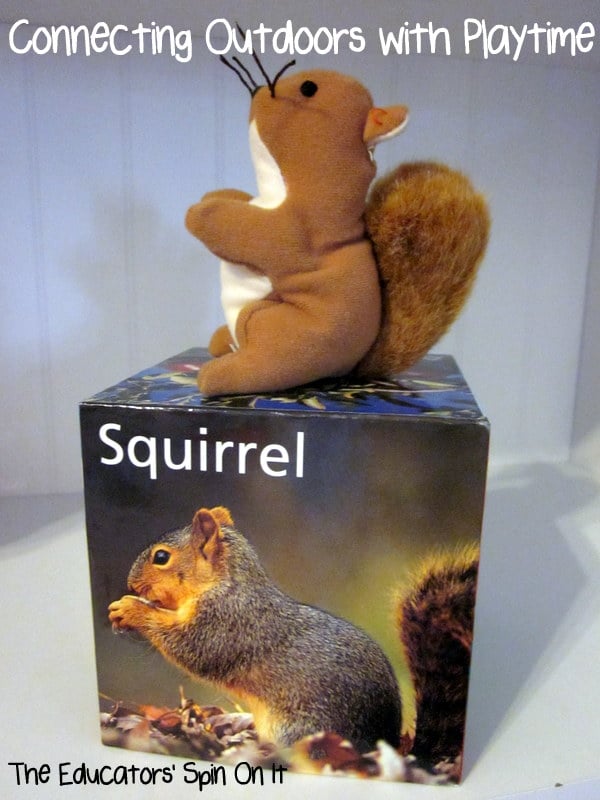
Creative Nature Play -Crafts with Nature
Nature Crafts That Help Nurture Their Interest
From a very young age, every child must get the right message about nature. If this is done correctly, then your kids will learn to love the nature. Nowadays, it is very important to love our environment and nature. So let them explore the things that they are intrigued with, at their pace. There are many ways by which you can teach your kids about nature, but one of the best ways is to teach your kid with some natural crafts which also help to sharpen their brain.
I often get asked when we can start process art with nature's treasures. I always respond that if they can feed themselves with a fork and spoon, they can start creating art. Process art includes making collages and painting. However, the ability to draw does not come in until later. Collages can be done on clear contact paper, so glue isn’t required. Shaped sponges, stamps and stencils can be used in paintings to give them form, texture and shape.
Young kids are very watchful in nature, and they will want to know about a lot of new things at once. Make sure you set the pace, so they do not get overstimulated. Especially if you are in the process of looking for certain art and craft supplies. Just about any young child will follow your lead and will also find it very interesting. So first, you will have to teach about how we find these items. So, this is the time where you can teach them how our forest grows and supplies these treasures, as well as the fact that we are to only take what is on the forest floor. We do not take anything from the forest that it needs to survive. Then finally, you will have to teach your children about the craft ideas. So children will be more attached and protective of art made from natural items that they found and chose from nature.
Encourage them to go outside to explore with you as well as gathering the supplies you need. You will get to see firsthand how excited they get about doing it. You will quickly determine that kids naturally love to be outdoors and that they will be eager to learn what they will need to do for that particular nature craft project.
They will really enjoy getting to explore the world around them. They can learn about various new things on the go. This is the process of teaching the kids about crafting with nature. It will also help them to learn about different kinds of things that grow and intensify their love for nature, art and crafts.
We would just head out on a walk on a whim, and talk about or just enjoy whatever we see. But sometimes we have a special theme to our nature walks, to focus on a particular aspect of what we might find. Even the roadsides are constantly changing in the Rocky Mountains. And they weren't always the same as our wildflower garden. It was truly just whatever the wind blew all over our neighborhood.
One thing I did that Hope really enjoyed was to carry a ribbon toy with us on our walks and bike rides. I made a small version of the second one on a key ring and attached it to her carrier and her zipper on jackets. Then she could watch the wind. I will give you links to make a few of her favorite ribbon toys. Just click on the pictures for a link. The wind always startled her. She couldn’t see it and it took her breath away. So the ribbons and wind chimes let her know when the wind was whirling about her. HINT-Oh-another very simple way to demonstrate wind is to blow bubbles and let the wind take them away.
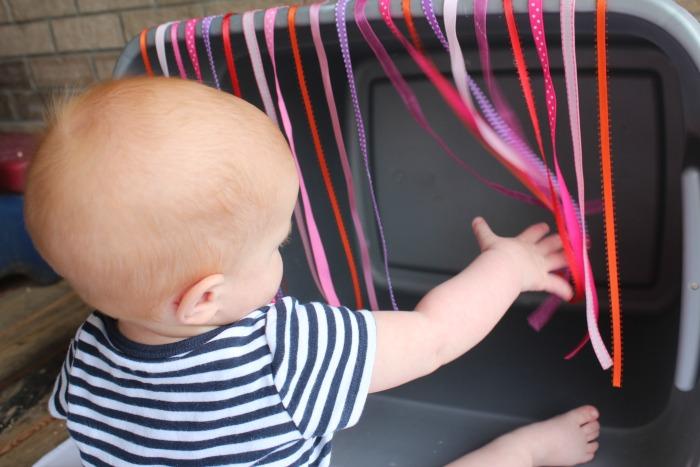
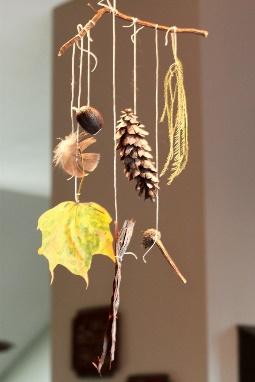

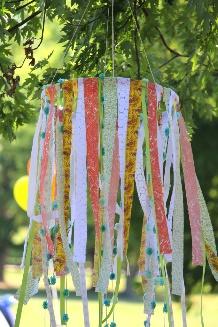


Hope was very determined that her artwork was to be hers from a very young age. She was very into her freedom in creative expression; even when using nature in her artwork. It was lucky that I was versed in open-ended process art. When working with babies and toddlers artistically, the adult needs to be careful to let them create joyfully in their way.
BTW She was not given markers or crayons until she could hold a fork and feed herself.
On to creating art that uses whatever you collect
from nature walks…
Most Hope’s first painting supplies came from our kitchen or outside. Anything liquid or creamy became paint, small utensils became tools to apply the paint with and the floor, her highchair table and Bumbo chair with tray became surfaces to paint on. Anything doughy became playdough and my margarine became her snack. (UGH) None of my friends had babies so they loved that she could create a party of her own in the kitchen. Lower cabinets and drawers were sorted, so they were baby safe. She knocked on what doors she needed opened. She lived and breathed art…. oh, and daddy.
So, when she started doing art outside, everything in her environment becoming an art supply or tool came natural to her. HER CREATIVITY WENT WILD.
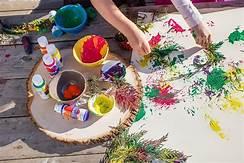
Preserved leaf wreath from Craftulate
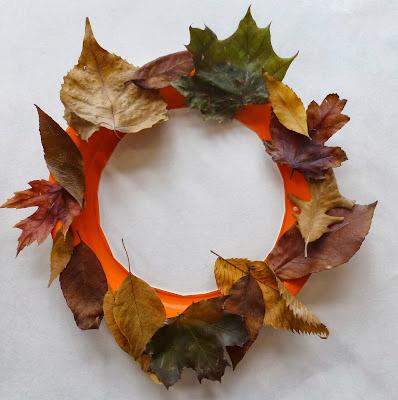
Painting Leaves
Whether you collect some Autumn leaves from the ground or pick some fresh Spring leaves from a tree painting on them can be a fun experience. Why not turn your painted leaves into monsters or creatures. You can use brushes to paint the leaves but using your fingers is far more fun! Read more...

Butterflies and spring also go together. Check out this beautiful springflower butterfly craft from Fun and Fantastic Learning.
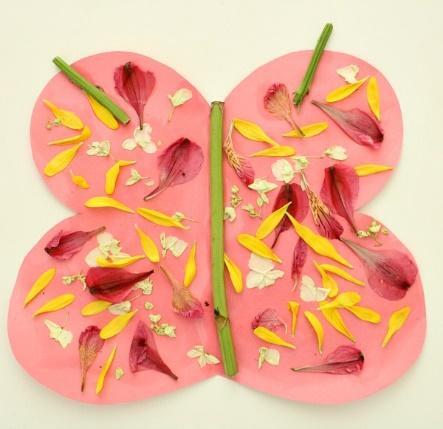
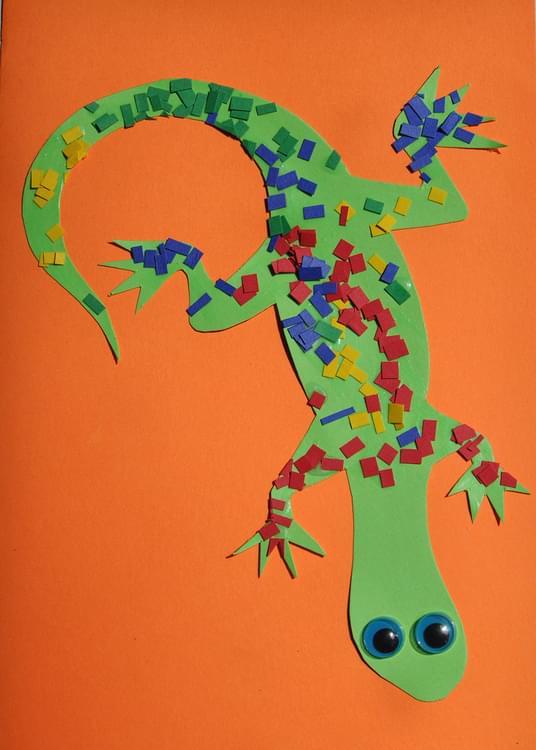
Nature prints clay craft
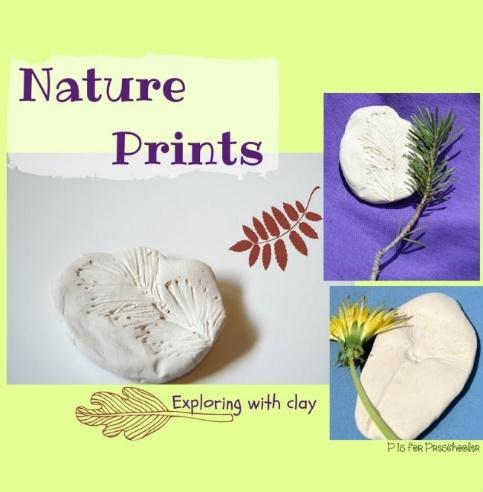
Make colored sand creations like Play at Home Mom
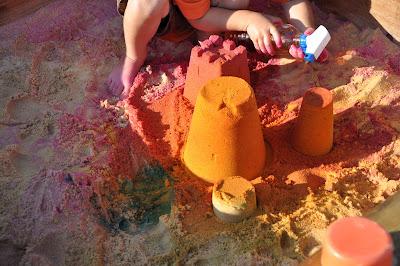
This nature press is easy to make and is perfect to take along on nature walks! Use this flower press to press your favorite nature finds and use them to make a few of these crafts.
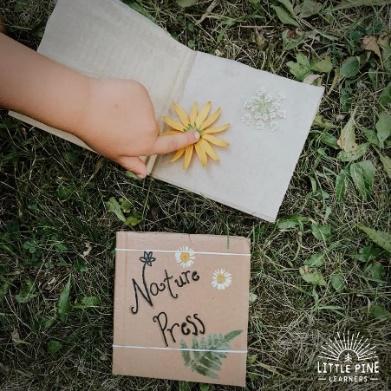
Ok we took more than one. We had about six in a baggie in our fanny pack for our outside adventures. It’s funny when I find things, I thought up for my kiddos online. I always get all puffy and wonder...who hacked my computer when Hope was little. LOL
Here’s some projects that use those pressed treasures from your walks
A Beautiful Nature Frame
How to Make a Flower Hiking Stick
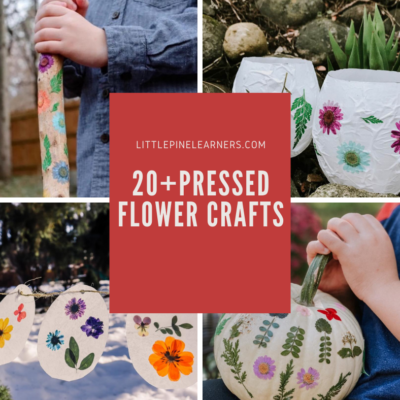
20+ Beautiful Pressed Flower Crafts
Learn easy ways to press flowers and see over 20 crafts to try with these beautiful pieces of …
[READ MORE...]
Best types of flowers to press flat
Over the years, I’ve learned some flowers were born to be pressed, and some weren’t. I might have scorched a flower or two in my ambitious attempts to press them. Whoops!
The best flowers for pressing include ones with a single layer of petals and flat faces. I’ve used everything from flowering shrubs like plumbago to roses, vincas, pansies, Esperanza, zinnias, and delphinium.
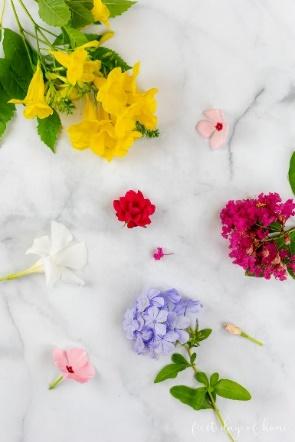
For larger bulbs or spherical flowers like peonies or ranunculus, you may have better luck preserving the whole flower. You can do this through various drying methods or by separating the individual petals from the stems. For thicker flowers (like roses), you can also split the flower in half before pressing.
Note: Avoid using flowers with fleshy, water-rich petals (e.g., begonias, portulaca).
They may be prone to mold or scorch when pressed.
How to press flowers in a book
Pressing flowers in a book is one of the oldest, tried-and-true methods. I’m quite fond of the technique if you have the time and patience to wait. (If you don’t, I’ve got a solution for you below.)
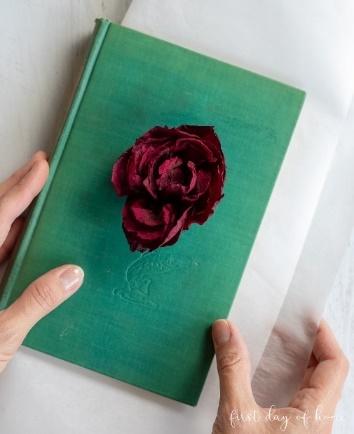
Supplies:
Sturdy book (e.g., phone book)
Paper to absorb moisture (parchment, thin cardboard, newspaper, coffee filters or blotting paper)
Heavy weight
Note: For best results, avoid using paper towels. Any paper with texture or embossing may leave an imprint on the flowers.
Step 1: Prepare flowers
Before you begin, separate any petals if needed. Then, arrange your flowers on one sheet of paper with at least 3/4-inch of space in between. Try to press flowers of similar varieties or thickness together.
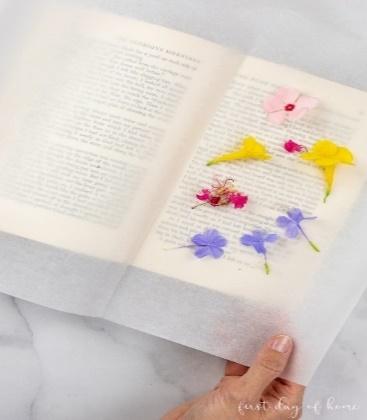
Step 2: Cover flowers and close the book
Place the second piece of parchment paper on top of the arranged flowers. Take care to flatten the flower face in the shape you’d like to achieve when pressed. I find it easiest to fold my sheet of parchment paper in half. Then, I can sandwich my flowers inside like a book rather than cutting two sheets of paper.
Next, close the book and set a weight on top. You can also pile on more heavy books or a brick, but you’ll want something heavy enough to create even pressure.
Step 3: Wait 2-4 weeks for flowers to dry
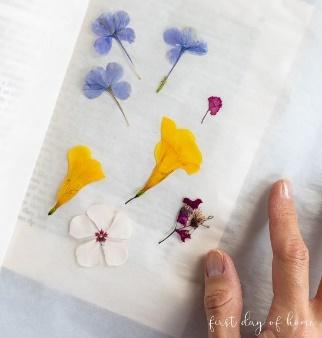
Pressed flowers in a book after 2.5 weeks
The drying time will depend on the thickness of the petals. I waited only 2.5 weeks for my flowers to dry in the photo above. They came out paper-thin and had great color retention! For thicker flowers, you may choose to wait closer to four weeks.
Some people suggest replacing the absorbent paper every three days or so. However, I didn’t find that necessary with parchment paper.
Once you’re done, I recommend using these nylon tweezers to handle your dried flowers. Book-pressed flowers can have very delicate structures, and you don’t want to tear your pretty specimen!
Using a homemade wooden press
Much like the book-press method, a homemade or store-bought wooden press can give you fabulous results. (Plus, you can decorate a wooden press or customize it to match your style-BONUS!)
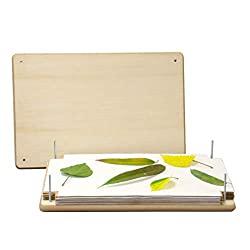
Supplies:
Two 12 x 12-inch pieces of plywood or MDF
Cardboard
Two pieces of paper (blotting or parchment paper)
Four bolts and wingnuts
Step 1: Drill holes in boards
Drill a hole in each corner of the boards, about 1 inch from the edge. Make sure you match the size of your bolts and line up the holes on both boards.
Step 2: Arrange flowers in between cardboard and paper
Cut the cardboard to fit inside the plywood or MDF, working around the four holes where you will insert the bolts. Lay a piece of blotting paper on top of the cardboard and arrange the flowers on top as desired.
Again, you will place the flower between two pieces of blotting paper. Then place a piece of cardboard on either side, followed by the wood or MDF.
Step 3: Screw in the bolts, and wait 2-4 weeks for flowers to dry
Insert the bolts and tighten the wingnuts until secure. Drying times will again depend on the thickness of the flowers used.
Compared to book pressing, the pressure is more evenly distributed with a wooden press. Plus, you don’t risk damaging any books.
Pressing flowers with a microwave
Perhaps my favorite method of pressing flowers for framing is using a microwave. When you’re short on time, this is the ideal option for you!
I wrote extensively about how to use one of these in my post on DIY pressed flower art. Go visit that post to receive a special 10% off promotion to purchase a Microfleur flower press.

Arranging flowers in Microwave flower press
Supplies:
Tweezers (optional)
Step 1: Place flowers on inner lining
You’ll want to arrange your flowers on the fabric liner in the shape you want to achieve in the end. Always try to group similar flowers together.
Step 2: Microwave flowers for an initial burst
With most microwave presses, you’ll want to heat the flowers for one long initial “burst.” I typically start with 25 seconds.

Plumbago flowers after pressing in microwave
Step 3: Continue microwaving in short bursts
Continue to microwave your specimen in 10-second bursts until the flowers feel paper-thin. Always air out the plates in between bursts to prevent browning or scorching. If scorching occurs, you can always reorder refill packs. (Ask me how I know.)
Note: Using succulents or flowers with fleshy petals may cause scorching when microwaving.
Take care when you remove flowers, since petals may stick to the inner liner. It helps to stretch the fabric liner in opposite directions or use nylon tweezers to help release the flower.
You can also use a book in the microwave instead of a press. Just please make sure there are no metal accents on the cover that might create a fireworks show!
Pressing flowers with an iron
You can also apply heat to dry flowers using a household iron. I must admit, this is my least preferred method because I just don’t think the quality compares to the other methods. However, it’s a good one to have if you need pressed flowers ASAP and don’t have another microwave option.

Supplies:
Iron
Parchment paper or other absorbent paper
Step 1: Arrange flowers between paper
I used parchment paper to sandwich the flowers and position them into place before ironing. A good hard surface with a thin towel underneath also helps.
Tip: For a fun kid’s craft, you can use wax paper to create a “suncatcher” with the flowers preserved in between. The wax paper will seal itself around the flowers, and you can
staple thick cardstock as a frame for display.
Step 2: Iron on low heat
Turn off any steam settings, and iron the flowers for about 15-30 seconds at a time on low heat. Let the flowers cool briefly before attempting to press again.
Once the petals have partially dried out, you can choose to finish drying using the book or wooden press method above.
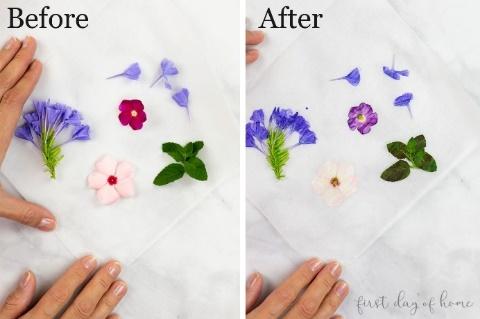
Results of pressing flowers with an iron
As you can see, the results of ironing don’t measure up to the other methods, in my opinion. The parchment paper tends to wrinkle, which causes ripples in the petals of the flowers as well.

Plumeria blossom before and after pressing with iron
What is the best way to press flowers?
I decided to create a little chart for an easy comparison across the methods (nerd alert!).
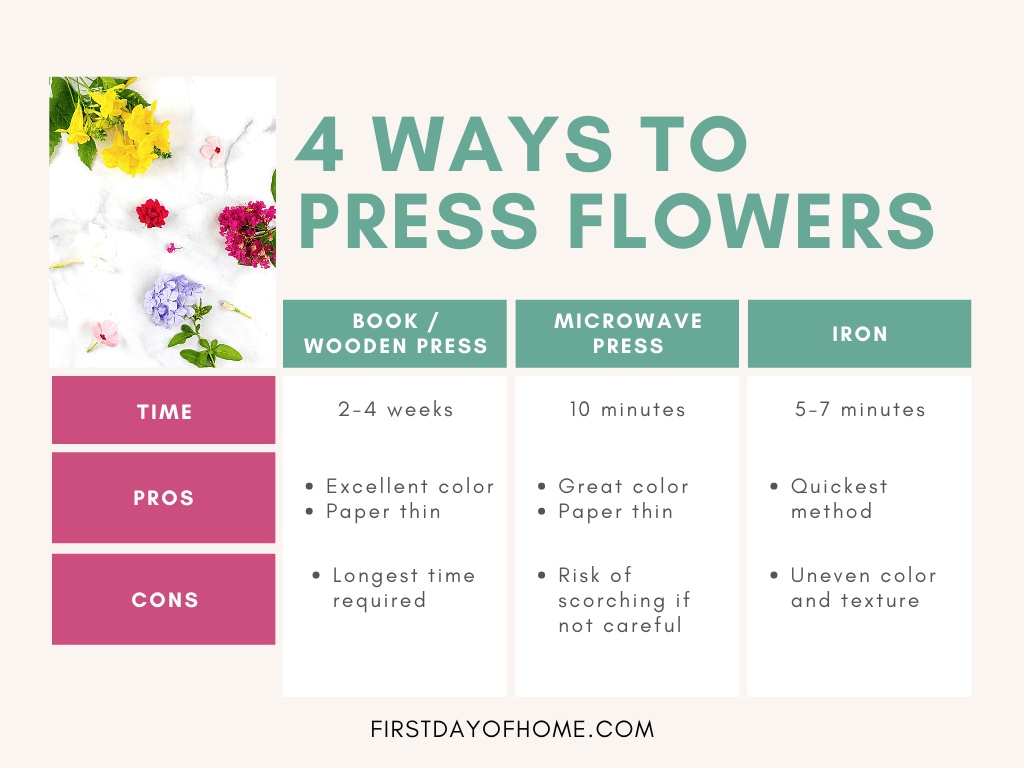
The best technique to press flowers and keep the color and texture was the book method. The microwave flower press is a close second and definitely wins in terms of convenience. I would not suggest ironing unless you’re in a pinch or need some quick flowers for a kid’s craft.
Nature Collages
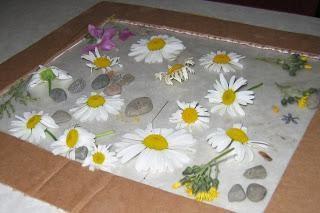
Even the smallest child can make something of great beauty with this collage technique. Cut a picture frame out of cardboard ahead of time, sizing it so your child can comfortably carry it.
Turn it plain side down and measure out enough clear contact paper to stick all around the frame. (Some people call it shelf paper instead -- you can find it in the housewares section of a big store.)
Peel off the backing, stick down the contact paper, turn it over, and voila! You have a sticky canvas for your child to decorate.
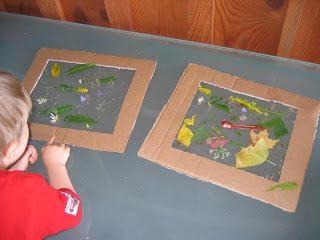
You could use this technique for any sort of collage, of course -- it needn't have a nature theme. But I love the experience of accompanying my kids as they take their little picture frames along on meadow walks or strolls in the woods. I find it helps them slow down and really look at the natural world around them.
Nature Squishy Bags
Fall is such a beautiful season. Whenever I think of it, I imagine color change, cooler temperatures and the smell of sweet potato pie. Recently, I asked my nieces what their favorite part of the season was, and they both immediately answered: “Playing with leaves!” With this enthusiastic response, I decided to make a Fall-themed sensory activity.
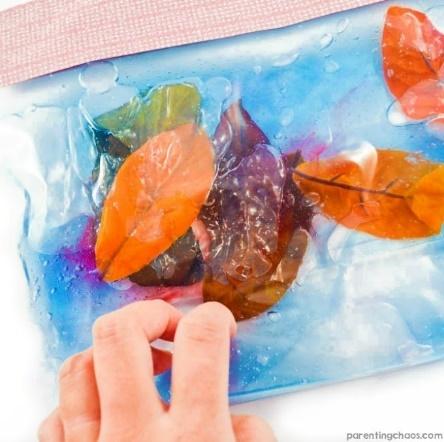
Recently, my nieces and their friends have been extremely interested in anything remotely “squishy.” They search toy aisles for kid-friendly stress-balls, get excited to make slime, etc. They just love the feeling of being able to squeeze their hands into something oozy. I put together my oh-so-easy Fall Squishy Bags to offer them something new to play with. Today, I’ll show you how to make them for your very own!
HOW TO MAKE A FALL-THEMED SQUISHY BAG
The wonderful thing about squishy bags is that you can get extremely creative with its inner contents. For my Fall-themed one, I decided to focus on leaves since my nieces expressed such a liking to them.
Items Needed:
Artificial or natural leaves, preferably in autumn shades
Scissors
Large freezer bag
A bottle of hair gel or Aloe vera gel
Medium-sized bowl (optional)
Colorful duct tape (optional)
Colored Glitter or confetti...if desired.
Directions:
1. If necessary, cut artificial leaves off from their stem. For one large freezer bag, you’ll need about 4 to 6 leaves.
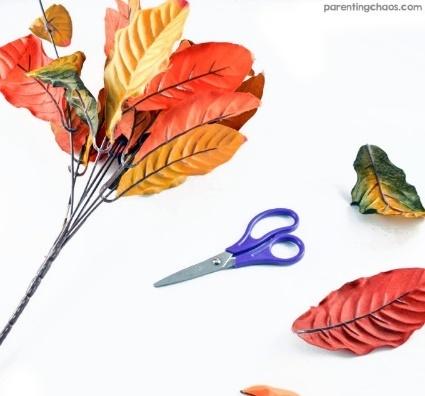
2. If you don’t have anyone helping you to keep the freezer bag open, I suggest opening it up and placing it in a bowl. This will keep it standing upwards and will allow you to fill it up with easy. First, add your leaves then, add your entire bottle of aloe or hair gel.

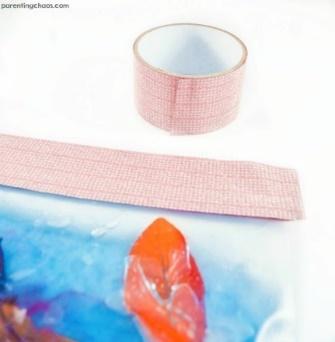

3. Squeeze out the air from the bag and zip shut. I always like to seal the top of my squishy bags with decorative duct tape for extra protection.
If you have a biter, tape around the edges too.
4. Squish away and have fun!
My nieces had a great time playing with their squishy bags. I was happy to provide them with an activity that they found so satisfying to squish their hands into. We’re just getting into the fall season in my area, so this sensory play was just what we needed to welcome the beautiful season!
Easy Nature Wall Hanging

Using a full sheet of semi transparent waxed sandwich paper, gluing leaves and color tissue paper folding in the middle and adding a stick and ribbon or string for hanging

Painted PineCone Flowers from Emma Owl –
This cheerful “bouquet” won’t wilt after a week, and I’m sure the children will have such fun creating it. HINT: we used sticks from the forest floor instead of dowels.
Dip Pinecones in Paint
Place a small amount of paint on the paper plate and dip pinecone to add color to the petal's edges. Rotate pinecone as you dip it so each tip is covered with paint. Repeat will all pinecones and set aside to allow the paint to dry completely. My idea of fun was the single color. Hope’s was several dabs of bright colored paint on the plate. In fact she ditched the plate and put paint in her hands then wrapped her little hands around the pinecones. Then I grabbed glitter glue. Or you can use good ole Mod-podge to roll them in then sprinkle glitter on them.
Need more Pinecone crafts for you while they are napping?
CLICK HERE
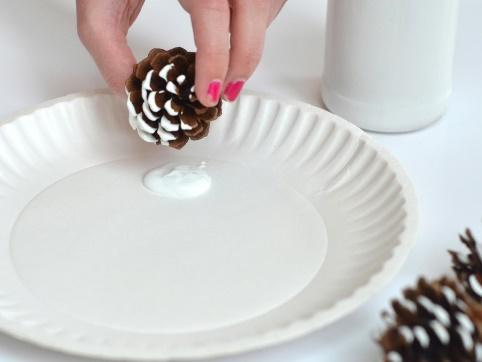
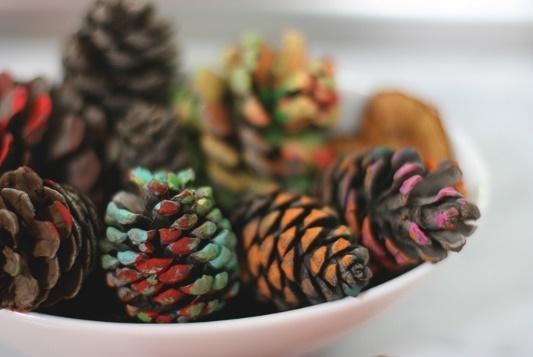
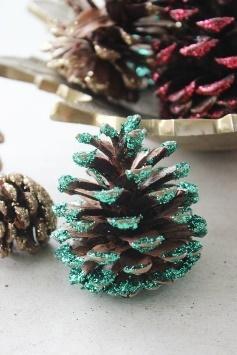
Need more easy craft ideas?! Check out these beautiful ideas:
How to Preserve Flowers for Kids Activities
A Beautiful Nature Frame
Icy Flower Sensory Play-

Air Drying Wildflowers & Herbs

Drying is even better than pressing for preserving wild flowers. It keeps their shape as well as their color, and in some cases dried flowers are hard to tell from fresh ones.
Members of the daisy family, like daisies, thistles, and dandelions all dry well. Thistles, Field Scabious, and roses are good too. Always pick the flowers just before they are in full bloom.
Don't pick any flowers that are beginning to fade or wither, unless of course you wait until they go to seed. Poppies, Teasel, and many other seed heads look very attractive dried. So do grasses.
Continue to see how to air dry your own flowers!
Air-Drying Wildflowers
The easiest way to dry flowers is simply to tie them up in a bunch, hang them upside-down, and dry them for a few weeks.
What you will need to get started
Rubber bands
Dry airy place to hang the flowers
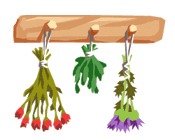
Steps
Tie the flowers into a bunch with a rubber band. Don't put more than 8-10 stems into each bunch.
Hang them upside-down in a dry, airy place for a few weeks. A linen cupboard is ideal because you can hang them easily. An attic, spare room, or garage is also fine, but you will need to fix up a pole or line to hang them from.
Continue to learn another way dry more delicate flowers.
Drying More Delicate Flowers
Some flowers lose some of their shape and color if they are just air-dried. It's better to dry roses, lilies, and anemones using a mixture of cornmeal and borax, which you can buy from a supermarket or grocery store. This way preserves leaves better too.
What you will need to get started
Shoe box
Borax
Cornmeal
Flowers
Paintbrush

Step 1
Find a box, like a shoe box, which is large enough to hold the flowers easily.
Step 2
Mix equal parts of borax and cornmeal together, enough to half fill the box.
Pour some of the mixture into the box to make a layer 1 inch deep.
Step 3
Cut the flower stems so they fit into the box, and carefully arrange the flowers on top of the mixture without overlapping each other.
Gently sprinkle some more of the mixture over the flowers until they are covered by a layer about 1-inch deep.
Step 4
After a week, gently take the flowers from the box and dust off the drying mixture with an artist's paintbrush.
How to Make Homemade Potpourri
When your sweet bouquet of flowers isn't as fresh as it used to be, instead of relinquishing to the trash, give those flowers new life as pretty potpourri. Making this DIY is easier than you think and can be personalized with any scents that you love. Toss in herbs or sliced citrus for filler, and the potpourri can be refreshed repeatedly with a spritz of your favorite scent.
Exploring the flower beds or herb gardens with babies and children to it is an activity in itself!!! So much fun.
Read on for the easy directions.
What You'll Need:
Flowers
Citrus fruits (optional)
Fresh herbs (optional)
Whole spices (optional)
Sheet pan
Parchment paper
Scissors
Scent-Essential oils in a spray bottle or bath salts
Directions:
Gather your flowers, herbs and fruit to use for making the potpourri. Any kind of flower will work, especially ones that already have strong scents, such as roses. Flowers with small, individual petals work great, or whole heads can be used too. Preheat your oven to 200˚F.
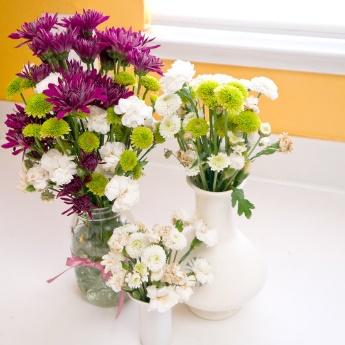
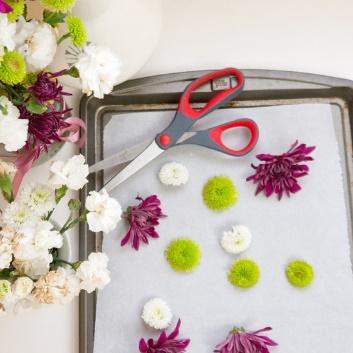
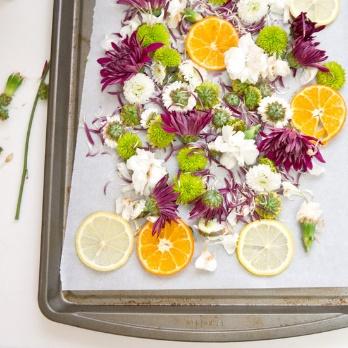
Cover a sheet tray with parchment paper. Cut the flowers from the stems right below the heads and place them on the tray or remove individual petals and place in a single layer on the parchment paper.
To add scent to your potpourri, cut and add thin slices of citrus fruits, or tuck in springs of rosemary, lavender, or thyme to the mix. You can also add whole spices, such as cinnamon sticks, cloves, or allspice, which are both pretty and wonderfully scented.
Add 10 to 15 drops of your favorite essential oil to one tablespoon of water in a small spray bottle and spritz the potpourri ingredients. Then pop the potpourri into your oven.
Dry in the oven for at least two hours, or until the flowers are brittle but not burnt. When the potpourri is ready, remove from oven and give another spritz of essential oil.
Drying Fruit slices
Slice fruit crosswise into thin slices about 1/4" or 1/8" thick (approx. 5 mm)
Press slices between paper towels or kitchen towels to blot away excess juice
Place slices on racks in oven and dry for 3 hours at 140°C (280°F), or 120°C (250°F) if fan forced. Check on them regularly to make sure they don't burn!
Also, you can place the orange slices on top of your radiators for a few hours after baking to get the last drops of moisture out with no fear of burning the slices.
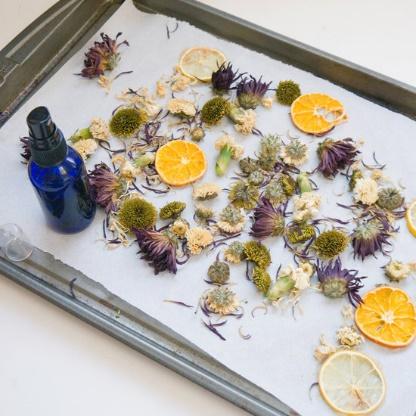

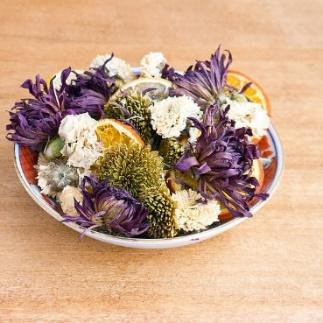
Once it's room temperature, gently mix the potpourri and place it in a bowl or small satchel. To refresh the scent, simply spritz with the oil mixture. ( I used bath salts mixed in for fragrance)
NATURE PAINTING TEXTURE COLLAGE FOR KIDS
The kids always collect nature treasures when we step outside the house so we decided to use their finds and some natural craft supplies to paint some nature collages. Little Tiger came up with this art activity after I presented her with the supplies. She loved exploring textures, colors, and brushstrokes during this Painting Activity.
Supplies:
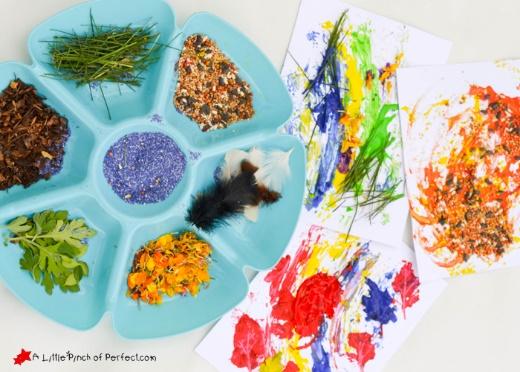
Craft paint
Craft paper
Paint brush (optional)
Nature treasures (leaves, sand, dirt, flowers…)
Glue
Directions:
Mix some glue into the paint, spread paint on the paper using paint brush or fingers, and then sprinkle, drag, or smash nature treasure into the paint. You can also dip the nature treasures in the paint and throw, swirl, or drop them on the paper.
FUN WITH PINECONES
We’ve been practicing a lot more aware of nature and all the fun we can have in the forest.
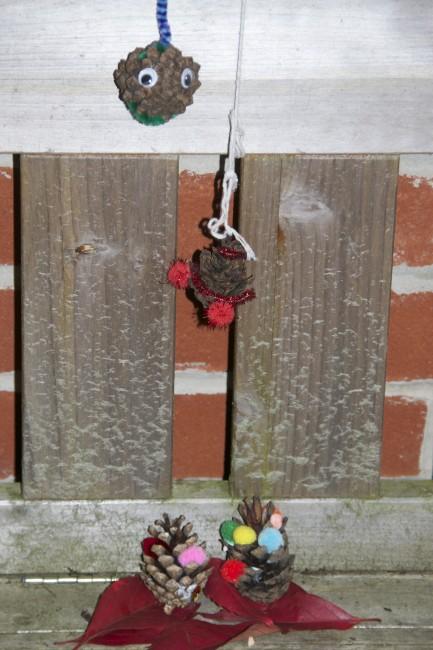
This week H and I took a stroll through the woods and collected sticks, acorns and pinecones. I really wanted conkers, but someone had beaten us to it and they were all broken on the floor.
S decided the acorns were her friends and wouldn’t make anything with them, which left us with pinecones.
I gave the girls some crafty bits and left them to it.
What do you think?
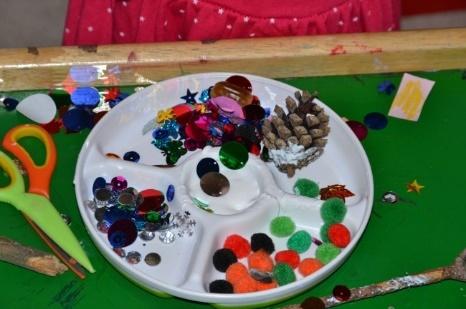

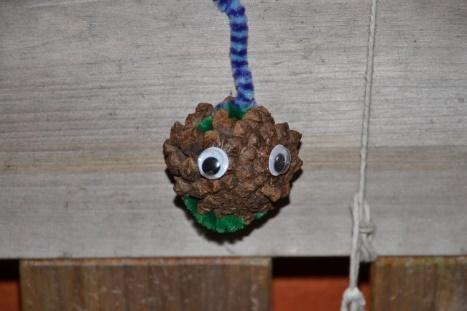
Our collecting of bits from the forest, has led the kids to ask lots of questions about trees, which I don’t have the knowledge to answer, I will have to take this forest guide out with me next time.
More Pinecone crafts
Checkout these easy bird feeders to make with kids by Run Wild My Child. These are perfect for toddlers to help make and great for attracting birds to your backyard (which can provide many benefits for you, the birds, and the ecosystem as a whole).
This versatile craft can be created using many items found in your home, including apples, orange peels, or a bundt pan. These DIY bird feeders help inspire creativity and make a great hands-on way for toddlers to learn about the different species of birds, what birds eat, and how they eat.
Photo provided by Simple Moments Stick
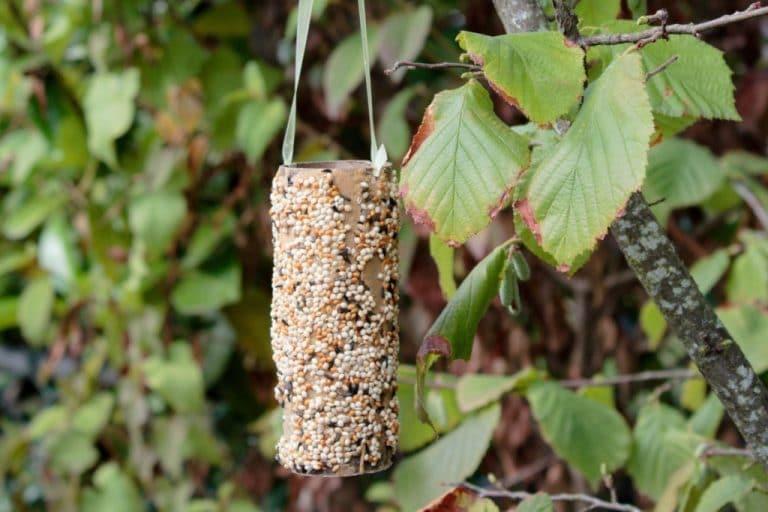
You could even attract birds with something as simple as a toilet paper roll bird feeder. I know I’m always looking for ways to repurpose those never-ending toilet paper rolls.
My toddler had a blast making this feeder by Simple Moments Stick. Such a perfect little craft for little animal lovers.
Photo provided by Love Peace Beauty
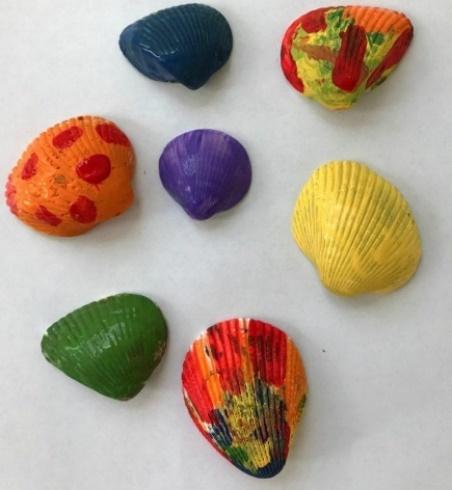
This painting seashells craft is a great one to add to your bucket list if you live near the beach. It’s also a great way to add in some art while you’re on vacation with the little ones.
I’m so glad I found this simple craft over at Love Peace Beauty,because I confess, I’ve got quite the collection of seashells just lying around in storage getting dusty. This will be such a fun nature craft that my toddler can do independently. And I won’t feel so bad about my seashell hoarding!
Spring Flower Keyring
Photo provided by Thimble & Twig
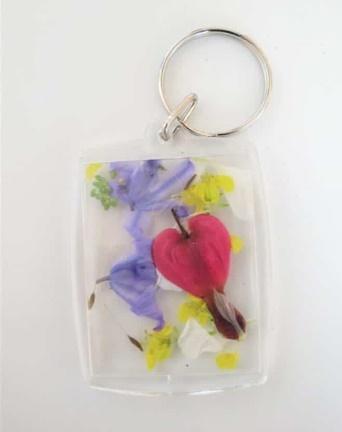
Your toddler will have a blast making these little nature trinkets by Thimble & Twig.These spring flower keyrings turn out gorgeous and are super simple to make.
Your toddler will get to get outside, pick some pretty flowers (be sure to leave the protected plants be), and make their very own keyring that they can proudly display on their backpack.
Tree Placemat Photo provided by Penlights to Pacifiers

This tree placemat craft by Penlights to Pacifiers is a great way to display falling leaves in autumn or blooming, colorful tress in the spring. Bonus points, it doesn’t involve any glue and hardly any mess. It’s even easy prep for non-crafty moms.
This nature craft makes an excellent opportunity to teach your toddler about the changing seasons and different parts of the tree. It even makes mealtime more enticing!
Nature Suncatcher
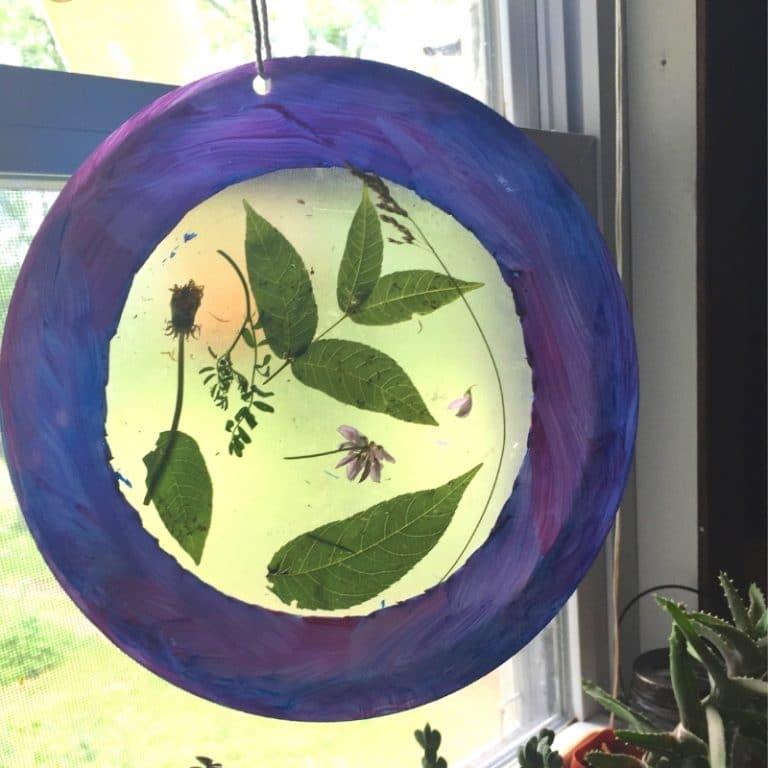
This stunning nature craft is another one inspired by The Artful Parent. Nature suncatchers are such a perfect way to explore nature and create some art out of it.
We love making these suncatchers out of findings from our nature hikes or scavenger hunts in our backyard. My toddlers spend a good amount of time decorating their plates and fine-tuning their nature arrangements.
These make such a beautiful display in the window.
Flower Printing
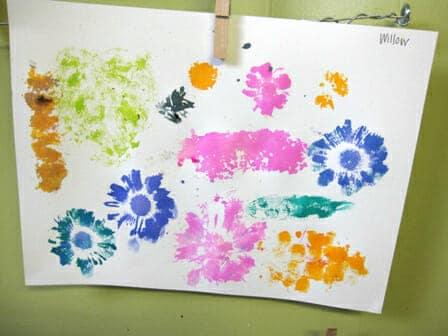
Photo provided by The Artful Parent
These flower prints by The Artful Parent are so beautiful. Plus, they’re easy enough for even a 1 year old to do.
This craft uses liquid watercolors, stamp pads, sturdy paper, and of course, flowers. Leaves are also great to print with, as their veins make awesome detail.
Your toddler will have a blast collecting their flowers and pressing them onto the paper to create their new piece of art.
Nature walks with Hope have always been one of our favorite activities together. She calls it “exploring.” It’s amazing how a little exercise and fresh air lifts both of our moods. Granted I don’t get much of a workout at the pace she keeps, but the memories are so much more important! We discuss creation, the science behind the leaves turning, how animals and bugs use camouflage, what makes rain, and anything else she thinks of to ask. I encourage her to use all five senses (except maybe taste…yuck) to experience nature. She creates characters for us to be and stories for us to play out.
Most of all we collect treasures. I never leave a walk without at least one thing in my pocket! Acorns and flowers are a favorite of Hope’s, I like to grab pretty or interesting leaves and rocks, and pine cones are beginning fall.
Here are some ideas for a nature craft to make with all those collected treasures.
Nature Treasure Collage and Suncatcher
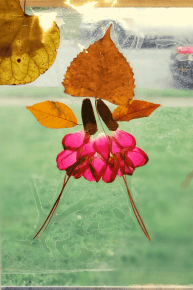
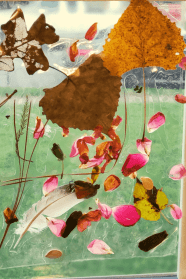
Supplies:
Collected Nature Treasures (flat and light weight items work best)
Cut two pieces of contact paper. Place one sticky side up on a flat surface. Allow child to arrange their nature treasures on the paper. Place the second piece sticky side down over the artwork. Hang your nature craft in a window or other sunny place!
Leaf Faces
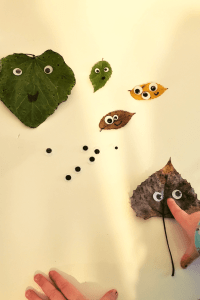
Supplies:
Googly eyes
Glue
Sharpie
Collected Leaves
This nature craft is so simple, glue eyes to the collected leaves and draw mouths and other facial features with the sharpie! Do not press too hard.
Leaf Impressions
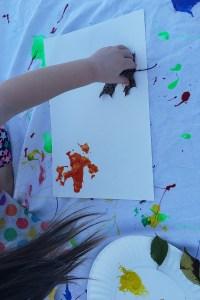
Supplies
Collected Leaves
Paint Pad Paper or Canvas
Pour a small amount of paint into a paper plate or other container. Have the child dip the leaves into the paint and then press them onto the canvas. Encourage them to lift gently to reveal the leaf’s impression.
Simple Flower Pressing
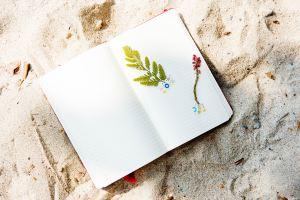
Photo by rawpixel on Unsplash
Supplies:
Collected Flowers
Tissue or White Paper Towel
Heavy Books
Place flower on the tissue or paper towel and either fold the paper around it or place a second tissue over the flower. Place the flower sandwich in the middle of a heavy book. Depending on the thickness of the flower, you may need to stack more heavy books on top of the first book. Leave for 2-4 weeks. The pressed flowers can be placed in a scrapbook to start a nature craft collection, or used in your nature treasure collage craft above!
Rock Painting

Supplies:
Collected Rocks (smooth and flat river rocks work best)
Acrylic Washable Paint and Paintbrushes
Glitter (optional)
Clean your collected rocks and make sure they are completely dry before beginning. Allow your child to paint the rocks. Sprinkle on glitter if desired while the paint is still wet. Once the paint is dry, coat the rock in modge podge to avoid chipping and flaking. You can paint with them and create some Story Stones like we did!
Dipped Pine Cones

Supplies:
Collected Pine Cones
Glitter (optional)
Pour paint into a small bowl. Have the child dip one side of the pine cone into the paint. Sprinkle on glitter while the paint is still wet. Allow to dry and use this nature craft to decorate your festive bowls!
Pine Cone Decorating
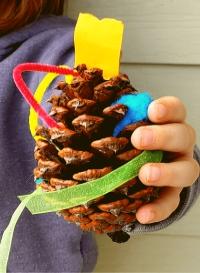
Supplies:
Collected Pine Cones
Pom poms
String, Ribbon, Yarn
School Glue
Sequins and Glitter
This nature craft is suitable for toddlers and preschoolers. It is super easy and requires almost no help from the grownups except assembling the supplies and cleaning up afterwards. Just let them go to work on their creation!
Autumn Suncatchers Using Leaves
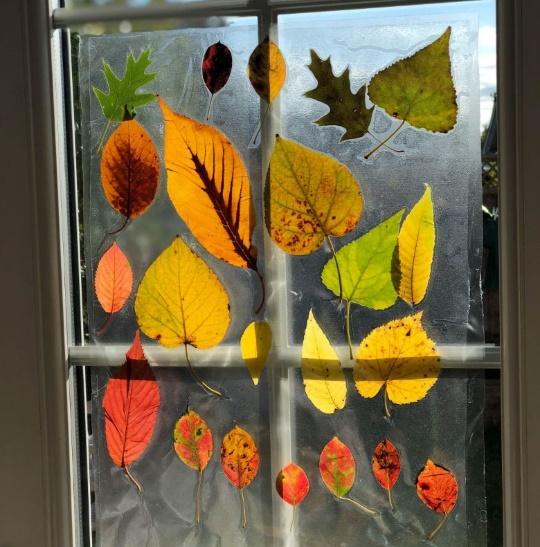
Save the best leaves from your leaf collection to make a stunning Autumnal Suncatcher by The Gingerbread House. It's such a lovely way to preserve some of your child's finds from your nature walk. The leaves will change a little over time, but it will make a nice window decoration through the autumn season.
Leaf Suncatcher

Collect some gorgeous fall leaves to make a nature-inspired Autumn Leaf Suncatcher. This craft is easy enough for toddlers and preschoolers and will make an excellent addition to your autumn decor this season. The leaves look beautiful, hanging in the window with the light streaming through.
Monster Leaf Puppets
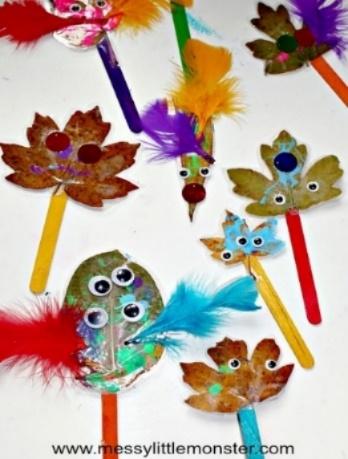
Speaking of leaf puppets, you'll also want to make these Monster Leaf Puppets as Halloween approaches. Go crazy with the eyes, paint, and feathers. Perhaps you can draw some teeth on them to make them look a little scarier. Experiment and have fun!
8 Simple Ways to Create with Natural Materials from Buggy and Buddy
Crafting a Walking Stick from Crafting Connections
Flower Petal Sensory Play from Fantastic Fun and Learning
Building Towers with Natural Materials from Nurture Store
Nature’s Stampers with Play dough from Dayna Banya
Fun Things to Make with Natural Materials from Twodaloo
Playing and Learning with Natural Materials from Fun-A-Day
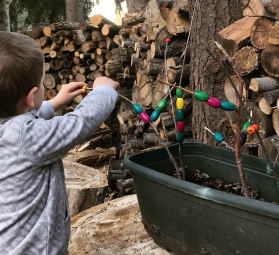
Work on fine motor skills, color recognition, and so much more with this fun outdoor pattern activity! (Use large beads for babies and watch them carefully) The set up…
READ MORE
Fall Leaf Suncatcher
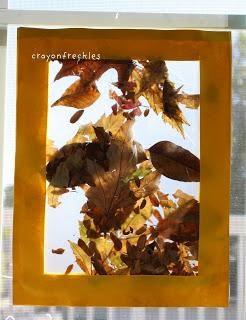
Be inspired by Crayon Freckles to
make your own gorgeous leaf suncatcher
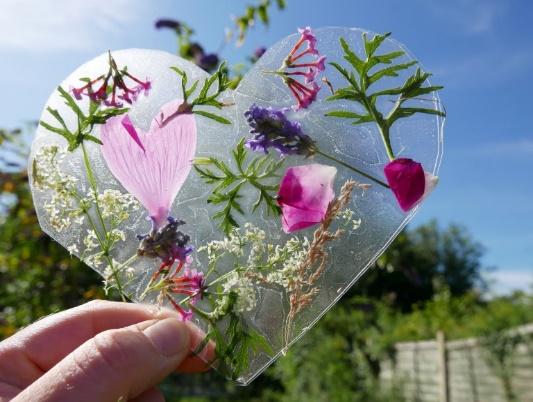
Simple Nature Walk Suncatcher
We just went around the yard finding pretty colors of flowers and interesting leaves. We tried to keep everything small in size but didn’t limit to just that. It can’t get much simpler and beautiful as this. Cut two identical shapes of clear contact paper--peel one & arrange nature-- peel and stick the other one on top of your creation. Press under a heavy book for 24 hours.
Natural Play Dough with Flower Confetti
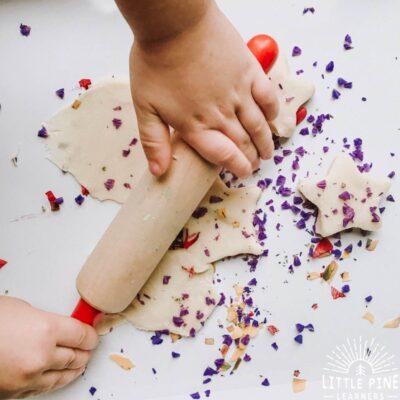
This natural play dough recipe will provide hours of fun and entertainment for kids! Just add some eco-friendly flower confetti… (It’s fun to use really fragrant flowers and just let the play with the dough. You don’t have to be able use tools.)
READ MORE
Oobleck and Stones
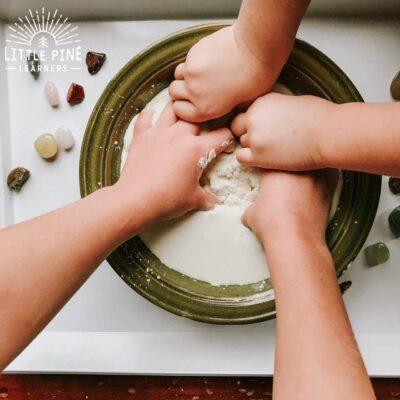
Try making oobleck today! This super simple oobleck recipe only requires two inexpensive ingredients and is very easy to make….
5 Things to do with Acorns and kids from Making Boys Men
Fall Leaf Printing from Mommyhood from the Heart
Conker Rolling Art from Playful Learners
Fall Nature Table from Buggy and Buddy
9 Things to do with Sticks and Leaves from Mummy, Mummy, Mum
7 Acorn Activities from Hey Mommy, Chocolate Milk
Outside Play: Leaves and Pumpkins from Home Learning Journey
Infants and toddlers benefit from being outside as much as older children or even adults. Babies and young children learn all the time. They don’t have words to describe what they encounter but they learn about their world by touching, tasting, smelling, seeing, and hearing. Babies are aware and mesmerized by sounds and movement and there’s a plethora of unique sounds, colors, lights, sensations and textures to take in and experience outdoors - the crunch of dry leaves underfoot, the rustle made by grass or leaves blowing in the breeze, the sensation of wind or grass on skin, the interest provided by flowers that can be smelled and picked, the texture and smell of the garden after a rain……
When these experiences are shared with a loving adult who can share a baby’s sense of newness, wonder and awe, the entire experience is enjoyable and memorable. It is also critical to babies’ brain function, overall development and to the early experiences of achieving a positive sense of self.
EXPLORE, CREATE & PLAY OUTDOORS
When the weather is nice, we like to spend as much time as possible outside. There’s just something about being outside in the sun that really wears a kid out and makes them nap extra good, which this mama is a fan of. Haha! Of course, we do the typical activities like going for a walk, going to the park, and swimming at the pool, but it’s also fun to get creative, explore, and learn with our activities.

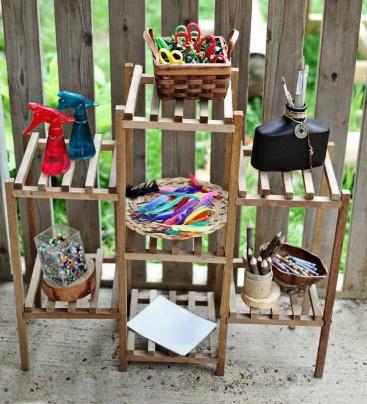
How to make the perfect backyard art space
My little artist loves going outside to paint her nature treasures among the birds!
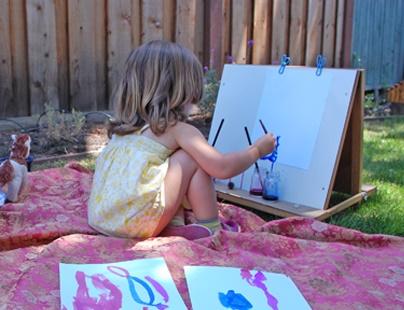
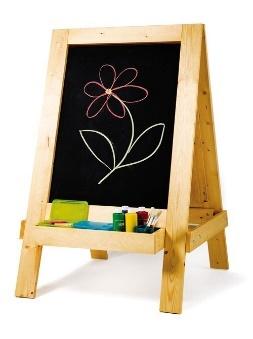
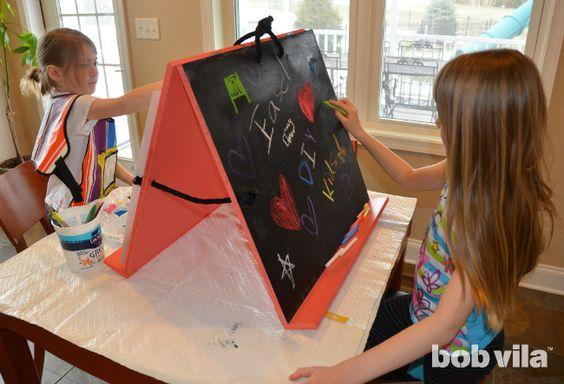
Portable Easel DIY Portable Tabletop Easel Creative Station
If you know that your little one is not going to cut or draw, put those ideas away until they can.
They need to get those fingers moving and develop their fine motor skills. But let them develop them with playdough or Create-a-Scene with felt boards and pieces, blocks, and magnetics.
Superscript
BABIES EXPLORING AND ENJOYING OUTDOOR PLAY
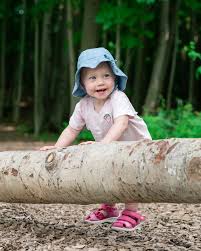
It’s important for your baby to experience different environments. And if you’re feeling cooped up indoors, it’s time to get outside!
Teddy Bear’s Picnic
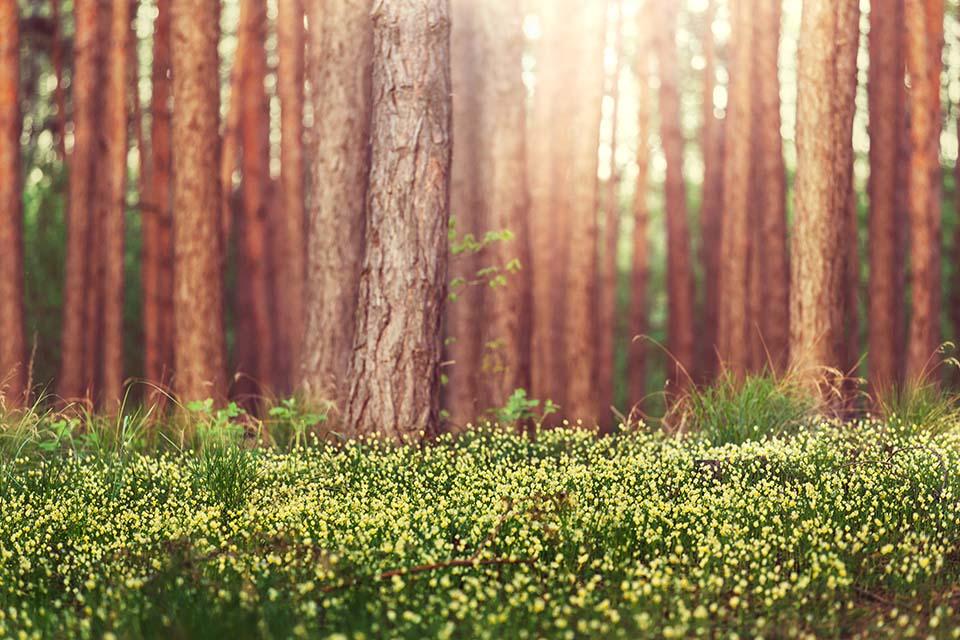
Get the kids to help pack up a picnic for them and their favorite teddy bear or toy. Involving them in the planning and preparation process is a great way of developing their sense of logistics.
Get them to think about food and drinks as well as any equipment like blankets. Ask: What will we be doing? What will we need to do that? Get those little brains working!
Letting them forget a non-essential item creates a great opportunity for improvising. “Oh no, we forgot to bring saucers! What else can we use?” You’ll be amazed at the solutions. Make sure each teddy or toy has their own plate and space on the blanket.
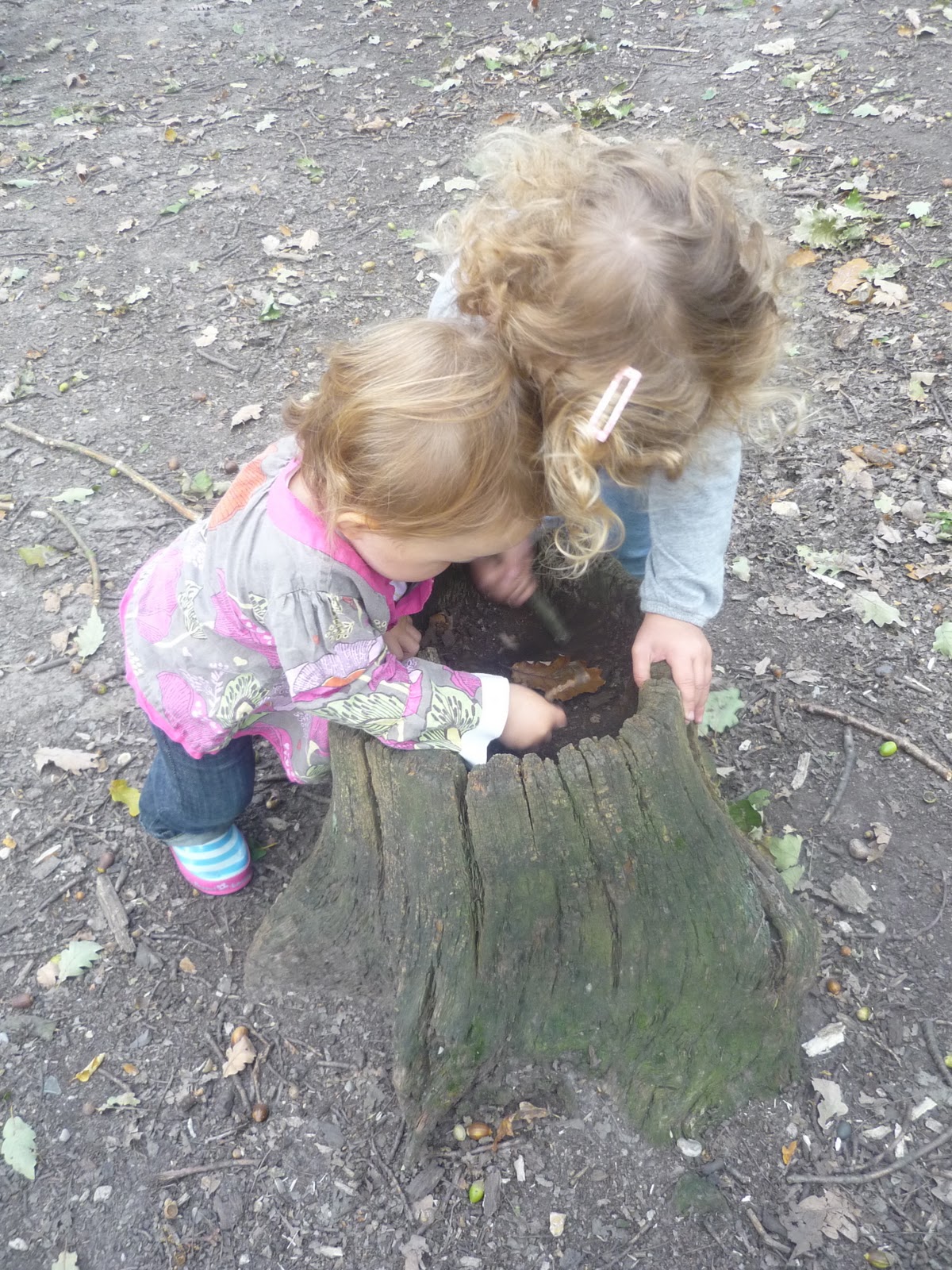
Treasure Hunt
Scavenging for woodland items is a fun and active way to get kids learning about nature whilst improving their attention to detail.
How to play
Make a list of objects/materials
found in the woods e.g. brown leaf, blackberry, twig, bark etc.
Send the kids out to collect every object on that list
Step the excitement up a level by offering prizes to the child who finds everything on the list, or the child who finds a particular item first.
Make a Rope Swing
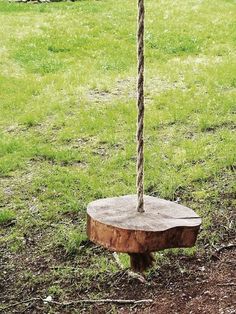
A rope swing can be quite a big job, and requires a bit of equipment and forward planning, but the end result will provide hours of fun!
There are a few good ways to make a rope swing:
The easiest kind of swing to make requires a sturdy tree branch and a piece of wood suitable for the swing. Tie a rope firmly to the tree branch and secure the other end to the middle of the piece of wood and hey presto!
If you feel like more of a challenge a slightly more complex swing can be made by drilling a hole in each end of a plank of wood. Two ropes can be secured at shoulder width to a strong branch then insert one through each hole and tie them in a large knot at the other side. Just make sure to watch out for any splinters!
If you have a spare or flat tyre handy, and the enthusiasm to carry it through the woods, then a tyre swing can be a great alternative to the traditional rope swing.
Campfire Fun
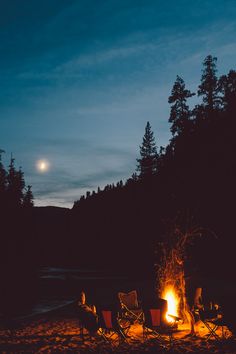
There is something special about making a campfire, providing it is done safely. The process of building a campfire requires lots of different steps that keeps the kids entertained – and it’s never quite as easy as Bear Grylls makes it look!
Get the kids to collect sticks of varying sizes and assemble them in a teepee shape
. They can then watch or get involved in the lighting process depending on their age.
Once the fire is a roaring success, gather everyone round and tell campfire stories – maybe even crack out the marshmallows.
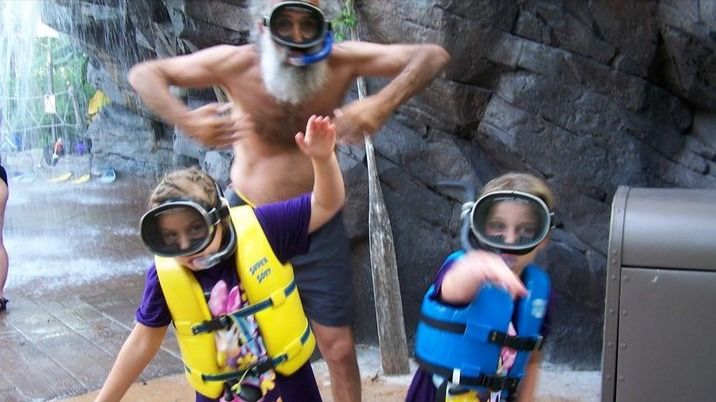
Shadow Tracing
There’s no way around it – this one requires a couple of super basic items. You will either need sidewalk chalk (in a pinch, you can a rock on the pavement!), or paper and some sort of drawing utensil.
Go outside on a sunny day and show your kids all about shadows! Have them stand while you trace their shadow on the driveway in sidewalk chalk. If you don’t have sidewalk chalk, lay down a piece of paper first and trace their shadow on it.
You can do this over and over with a variety of objects, or they can decorate their shadow tracing to make a self-portrait.
Rainbow Scavenger Hunt
Take your child around your yard or neighborhood and look for items that are the color of the rainbow. From a red stop sign to a yellow leaf to a purple flower, spotting items and learning color names can be a fun activity for you both. With younger babies, carry them to each item and let them explore its color and texture before moving on.
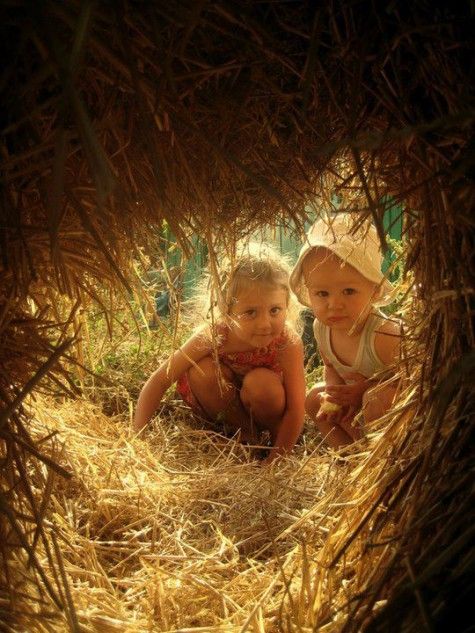
Treasure Hunt
Fill some bags, boxes or those plastic Easter eggs with kid-friendly treasures (like stickers or fuzzy pom poms) and then hide them in plain sight in your yard for your child to find. This also works great indoors. For crawlers, spread them out on a picnic blanket and let your child discover each one.
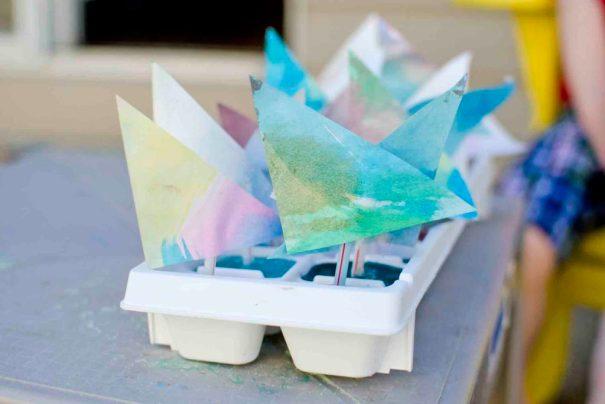
The Coolest Play Boats
Ice cubes are a great way to stay cool on a hot summer day. And the colorful ice boats at Busy Toddler use food coloring to keep kids delighted and spark their imagination. These boats require some parent prep ahead of time, which you can do with your little ones watching or helping. Then let loose the boots in an outdoor water table, bucket or inflatable backyard pool. Kids can move them across the water and watch the colored cubes melt.

Mess-Free Painting
Giving a baby a paintbrush can mean a big, old mess—unless you let them paint with water. On a sunny day, hand your child a paintbrush and a small cup of water and let them paint the steps, driveway or a fence. You'll be surprised at how much kids love this simple task.
Our steps had cement blocks, so it was fun to paint them together and make up patterns on how we painted them.
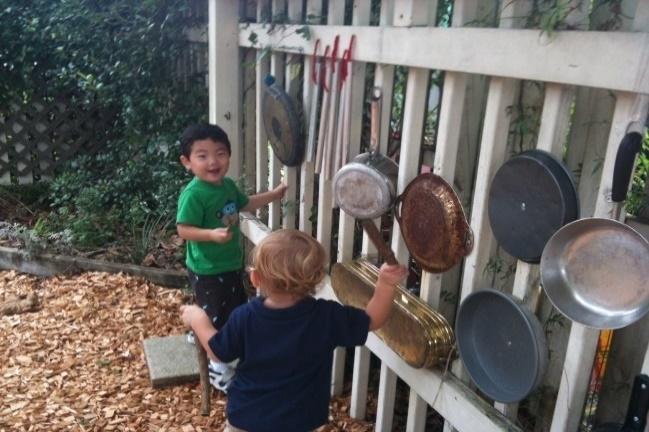
The Cutest Nature Jam
When little ones bang on pots and pans indoors, it can be headache-inducing. So take all that noise and energy outside. Donna Bozzo, author of What the Fun?! 427 Simple Ways To Have Fantastic Family Fun Play, suggests pulling loud kitchen tools and utensils outdoors and letting your baby make music. Attach the makeshift instruments to a fence, tree or other stationary object so they don't disappear. Or, lay them down in the grass for a different kind of sound.
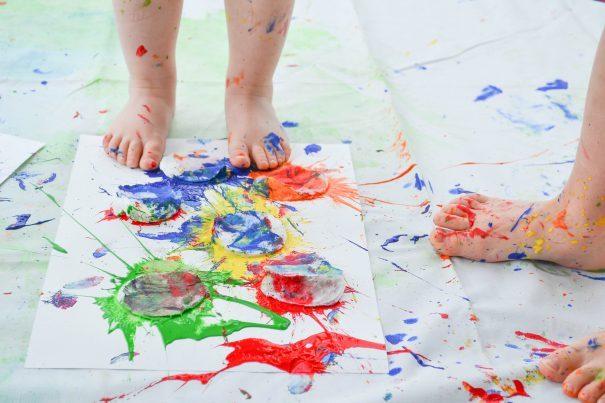
Guess Which Color
This splatter-paint art project from A Crafty Living is worth the mess it makes. Squirt some washable paint in large blobs on a big sheet of paper and then cover each with a cotton round (the paint blob should be slightly smaller than the cotton round). Strip your babe down to their diaper and help them smack each white round with their feet or a rubber mallet to discover which bold color will burst out. When you’re done, you’re left with a museum-worthy piece of modern art…and a happy baby in need of a bath.
10 of our favorite outdoor activities
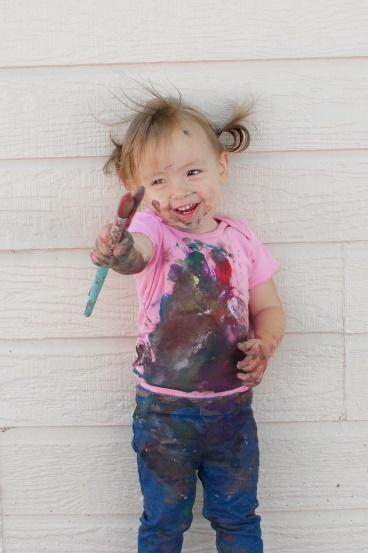
1. Object Painting:
Ditch the paint brushes and give your toddler unexpected items to paint. Some ideas of objects to paint with are:
Cotton balls
Q-tips
Marbles
Cars
Feet or hands
Scrub Brushes: give your child a variety of sizes and types and let them experiment with the designs they will create.
Straws: use a straw to blow the paint around in the paper. Toothbrushes: these can be used for splatter painting.
Bubble Wrap: tape bubble wrap to a table, paint bubble wrap, then place a piece of paper on top to make a print.
Eye Droppers + Coffee Filter: Have your child fill the eye droppers with watercolor and drop the colors onto a coffee filter. Watch the absorption in action and colors mix.
Nature: a flower, pine branch, stick etc.
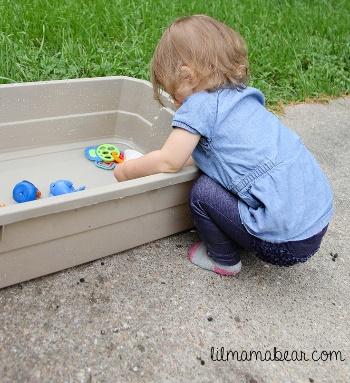
2. Water Table:
You don’t need a pool to have fun in the water. Get a water table and watch your child splash and play! But they cost a lot upwards of $100. Or…They can be simple like the one above. Hope’s was purple and she could snuggly sit in it by herself. She also had a small plastic wading pool that was like $10 at Walmart. Soget creative. They will have endless fun!
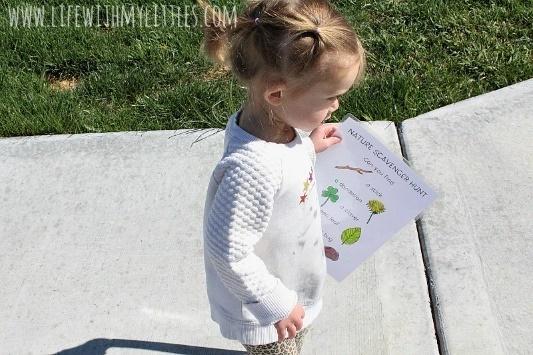
3. Scavenger Hunts:
Create a picture list (because toddlers can’t read) of items around your backyard or neighborhood (a pink flower, rocks, etc) and go on a hunt for them. It’s a fun way to get some extra energy out.
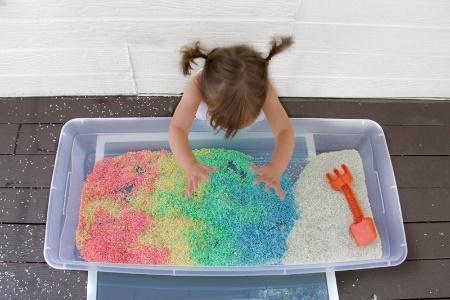
4. Sensory Tub:
Find a tub you have lying around the house and fill it with any of these 15 fun and easy sensory tub ideas.
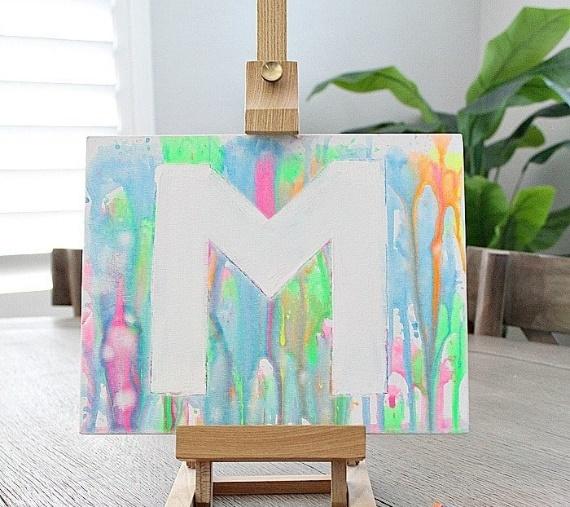
5. Squirt Bottle with Food Coloring:
Fill a squirt bottle with water and a few drops of food coloring. Let your child spray a piece of paper, themselves, the sidewalk, etc.
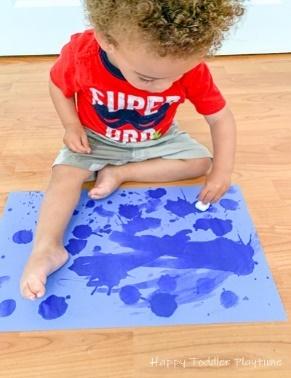
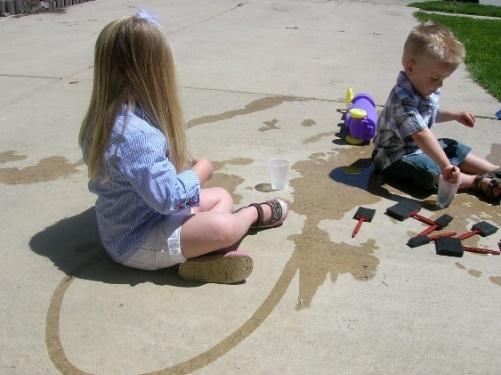
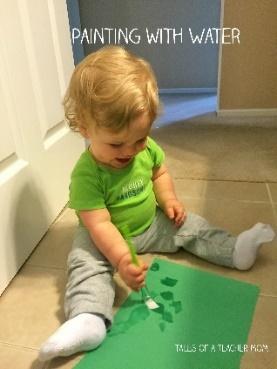
6. Painting with Water:
Give your toddler a paint brush and a pan filled with water and food coloring, and let them paint the sidewalk. A roller paint brush always gets them extra excited about this activity!
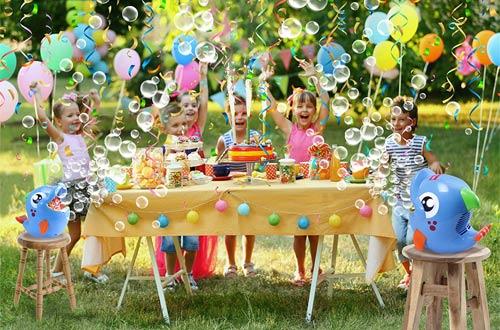
7. Bubble Machine: Set up a bubble machine, then sit back and relax while you watch your child run through the bubbles.Reviews of top ten
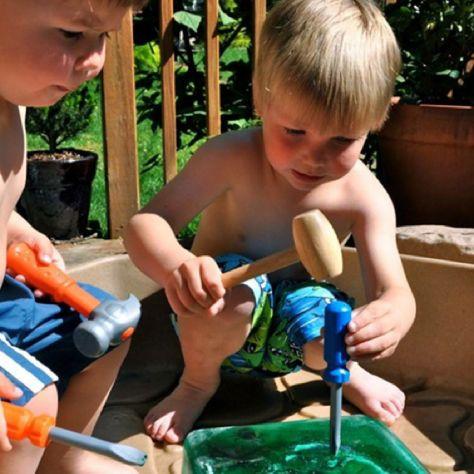
8. Ice Cube of Toys: Freeze some toys in a big ice cube, then bring it outside and hand them a toy hammer, screwdriver, or a kitchen spoon, and let them bang at the ice cube to get their toys out. Being outside in the sun will help the ice melt and make it easier for them to get their toys.

9. Throwing Sponges:
Buy some sponges at the dollar store, then fill a bucket (or use your water table) with water and the sponges. Your child will have fun throwing the sponges around outside and squeezing the water out of them.
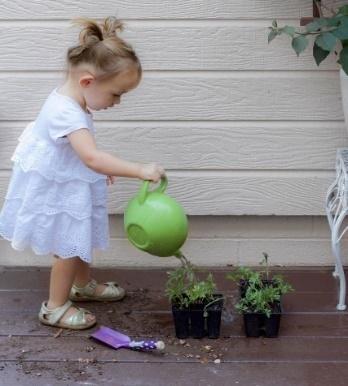
10. Gardening:
You can have them help pant and pull weeds in your real garden or they can create their own little garden by planting seeds in cups. Grass seed is a great option because it grows quickly. When grass grows, they can cut it with scissors.
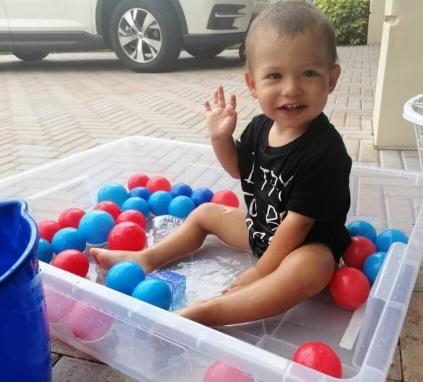
Set up water play. 12 Ideas for Baby Waterplay
Messier activities, like water play, can be fun to take outside. Grab some plastic cups, balls, utensils, sponges, and other fun, waterproof objects — making sure, of course, that nothing is a choking hazard. Fill a bowl, bin, pail, or kiddie pool with water, and help your baby play with the different objects…fill them up and empty them, see what floats and what sinks, and more. And be sure to supervise your little one at all times.
Whether you head to a local park or go out in your own backyard, it’s important to get outside with your baby. And the activities you do together can be simple!
BABIES EXPLORING AND ENJOYING OUTDOORS

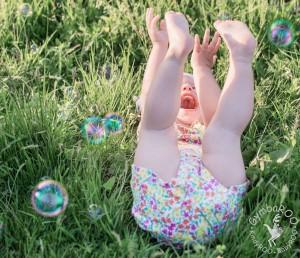
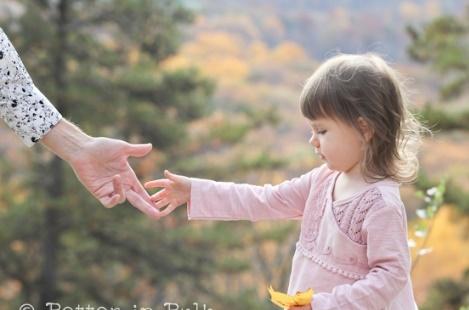
Outdoor Activities For Americas Grassy Land
Going outside for activity time during the warmer months is so much fun. Kids get a great deal of benefits from the sun on their skin and moving their bodies.
Hiking
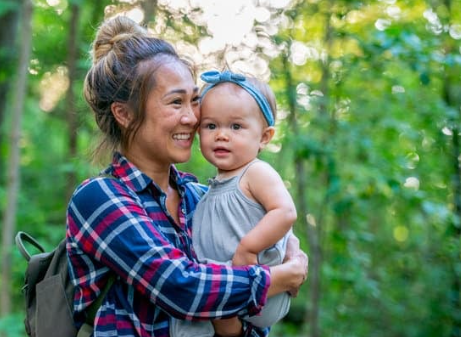
The easiest outdoor activity for your 13-month-old is going on a hike. It is such a great way for them to develop their leg muscles while also giving you a great sense of their personality by seeing what they find interesting in nature.
Nature Rubbing
Making nature rubbings can lead to some fantastic pieces of art! All you need is paper and crayons and random items in nature and you can discover what patterns they make. Leaves, bark, flowers, grass, or even hard-packed dirt make simple and interesting rub patterns.
Swinging
Visiting the park can provide such a great experience for your child. For example, giving them some time on a swing is great to help them build their spatial awareness.
Sidewalk Chalk
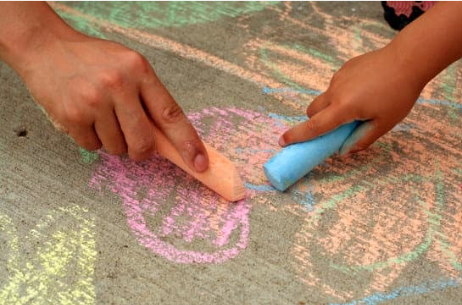
As long as you can keep it out of their mouth, sidewalk chalk can provide tons of entertainment. It also helps them develop their grip strength, fine motor skills, and color recognition.
You can just set out some chalk to play, but if you need a fun idea – try this sidewalk chalk shape game!
Play Chase
Every child loves playing chase! It is a fun game that is full of running and laughter while helping them work on their gross motor skills and situational awareness!
Collecting Nature
Letting your child collect pieces of nature allows them to show what they find interesting. It also helps build their gross motor skills, balance, and grip strength. Try this printable outdoor scavenger hunt!
Related Post: Outdoor Activities for toddlers
Sprinkler Play
While you’re watering your lawn, why not let your little ones loose to have fun in the water? It is a great time to allow your child to get used to moving water and build their gross motor skills!
Frequently Asked Questions About Activities For 13-Month-Olds
Sometimes it can feel a bit challenging to do activities with 13-month-olds. Here are some frequently asked questions about activities for 13-month-olds.
How often should I do activities with my 13-month-old?
You can do activities with your 13-month-old every day, and they don’t have to be a big ordeal every time! Doing an activity with them daily keeps their minds busy and learning.
How do I know which activities are best for my 13-month-old?
Pick the activities that you think will be fun or even a bit challenging for your little one. If something is too hard, it won’t be fun so try and keep it just a bit challenging.
Doing activities with 13-month-olds can be so much fun. There are lots of possibilities and fun things to do.
Remember, keep it at their level and if it doesn’t go as planned they probably won’t remember anyway (ha ha)
What are your favorite activities to do with 13-month-olds?
Related posts:
DIY Fake Snow For Sensory Play
Painting with Water: Toddler Sensory Activity
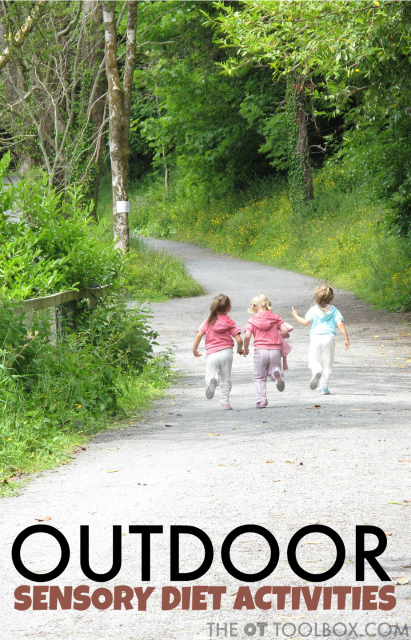
OUTDOOR SENSORY PLAY
There are so many outdoor activities that incorporate play naturally while meeting underlying needs in the great outdoors! The ideas you’ll find below are naturally occurring play ideas using items found in nature, natural environments. They are outdoor activities that kids can try without any additional equipment or specialty therapy items.
The point with these outdoor occupational therapy strategies is to support motor skill development, motor planning, visual motor skills, and overall development through the natural environment of the outdoors.
Ideas for outdoor sensory play:
Hike
Play in the woods
Roll down hills
Balance beam on logs
Climb trees
Collect nature
Play at the beach
Nature walk
Play in the backyard
Climb on stumps
Jump in puddles
Driveway or pavement play activities
Swing on tree vines
Sensory play on a porch or enclosed space
Collect sticks
Leaf hunt
Water table
Move and carry rocks of various sizes
Hide and seek
Create with nature
Outdoor water play
Collect fireflies
Pour rocks
Build with rocks, stumps, sticks, small logs
Mix and create nature soup (mud, sticks, flower petals, grass clippings)
Mud play
Use more of the ideas in our Outdoor Sensory Diet Cards
The outdoor world is full of sensory input that can meet individual needs of every child. The kids with sensory needs as well as those who present as neurotypical will benefit from a lifestyle of sensory play and experiences in the outdoors.

As always, these activities should be looked over and utilized along with assessment and intervention of an occupational therapist, as each child differs so very vastly.
Some of the ideas above are going to be described in more detail here on The OT Toolbox. Watch this space for more outdoor sensory play ideas based on the following outdoor play spaces:
Wooded Areas Sensory Activities (Perfect for a camping trip or playing in the woods at home or at a park!)
Beach Sensory Activities (Perfect for a family vacation to the beach or for those who live near a beach area!)
Incorporating a schedule of sensory input (sensory diet) into a lifestyle of naturally occurring and meaningful activities is so very valuable for the child with sensory needs.
